Allison Collection Photos
May, 1944
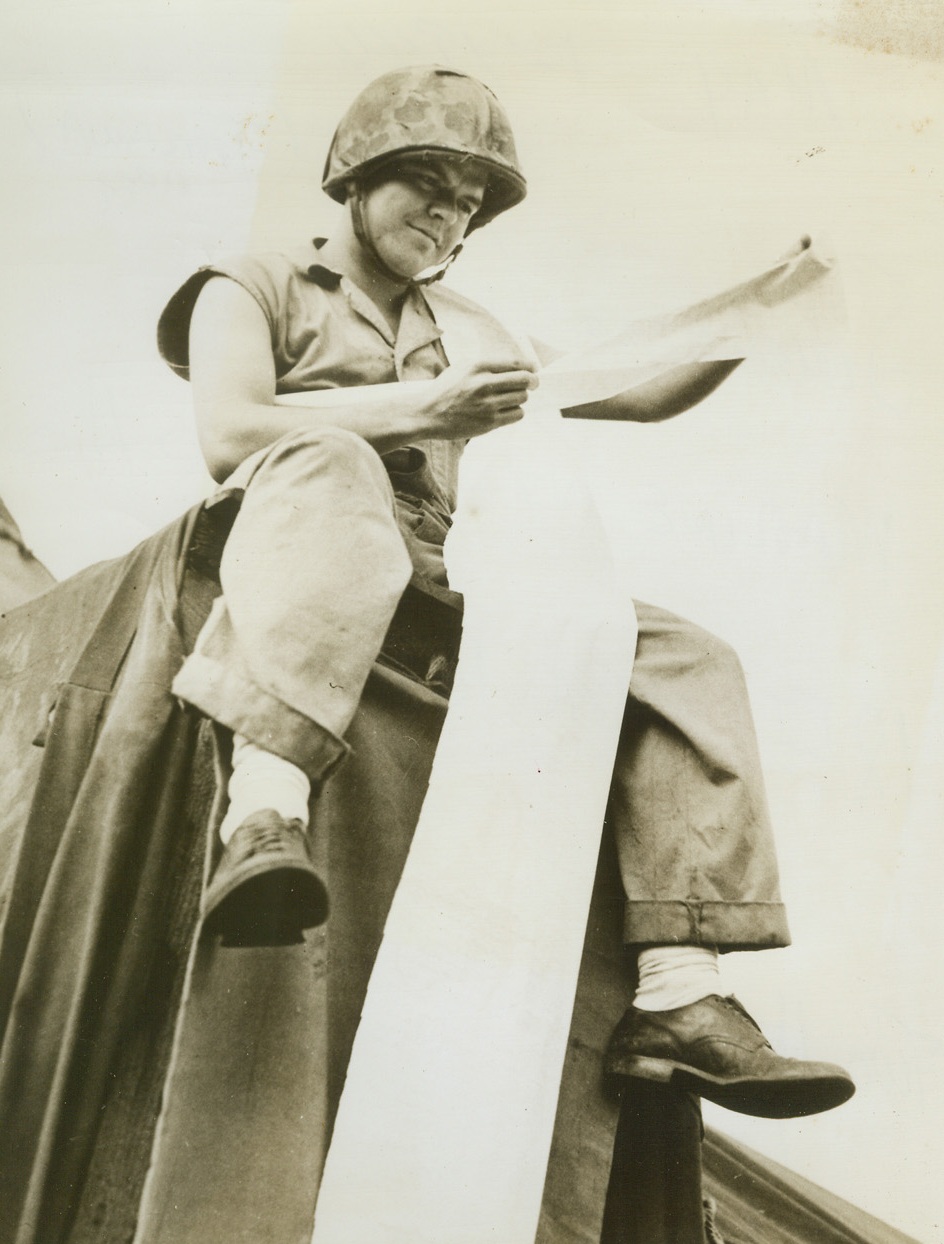
Two-Hour Long Letter, 5/1/1941. SOMEWHERE IN PACIFIC (Tarawa area) - Marine Pvt. Edgar R. Hurd, 18 foot letter received from home, Biddeford, Maine.;
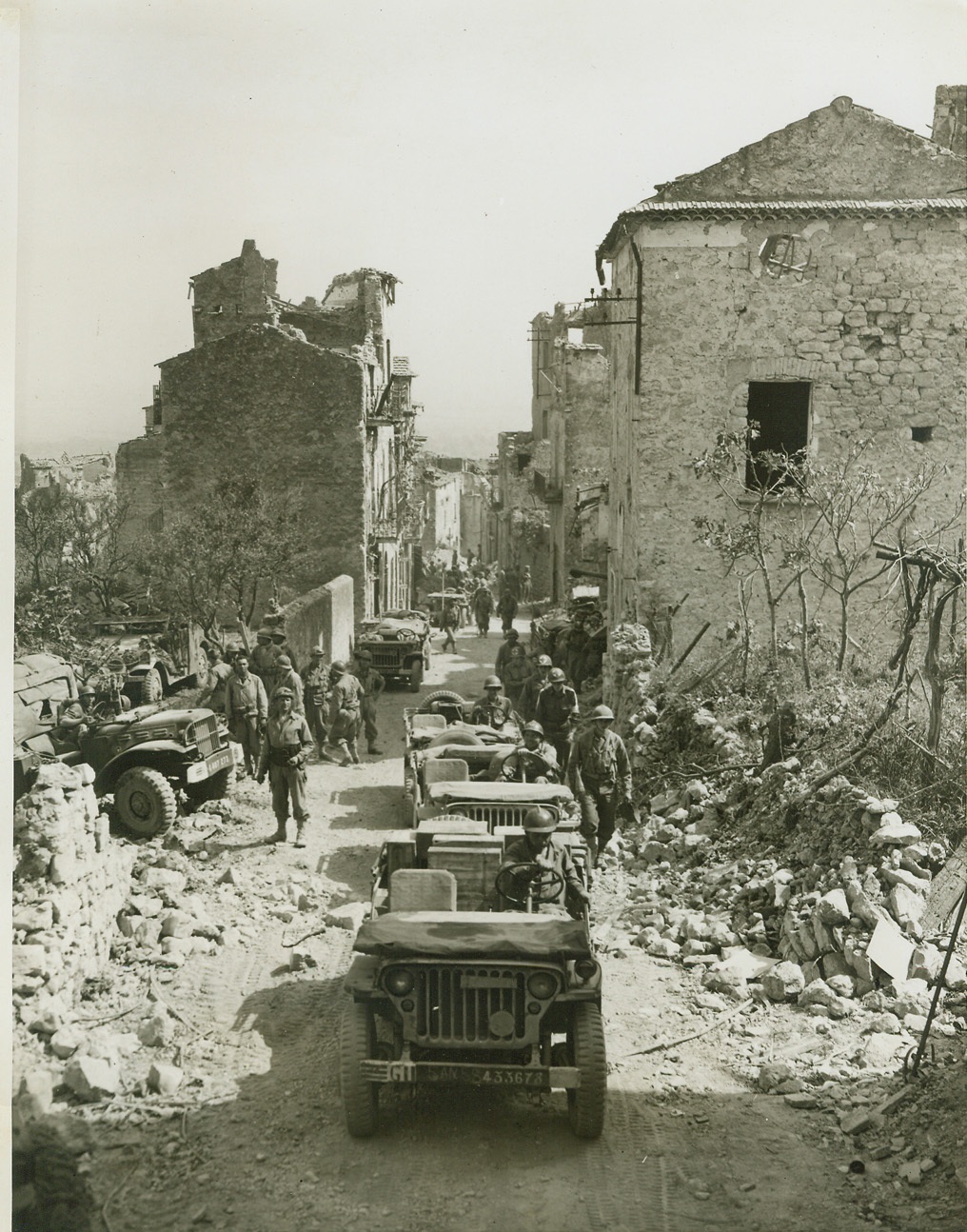
First Original Photos of Latest Italian Drive, 5/18/1944. This is one of the first original photos to be received from the Italian front since the start of the new Allied drive. The picture was made on May 13th and despite the various channels of censorship and transportation problems they were in Washington, D.C. by the afternoon of May 18th. It is believed that a new record for expediting of newspictures has thus been established by the Army. PHOTO SHOWS - French mechanized equipment as they moved into Castleforte after it fell to the combined forces of the Fifth Army during the second day of the spring offensive.;
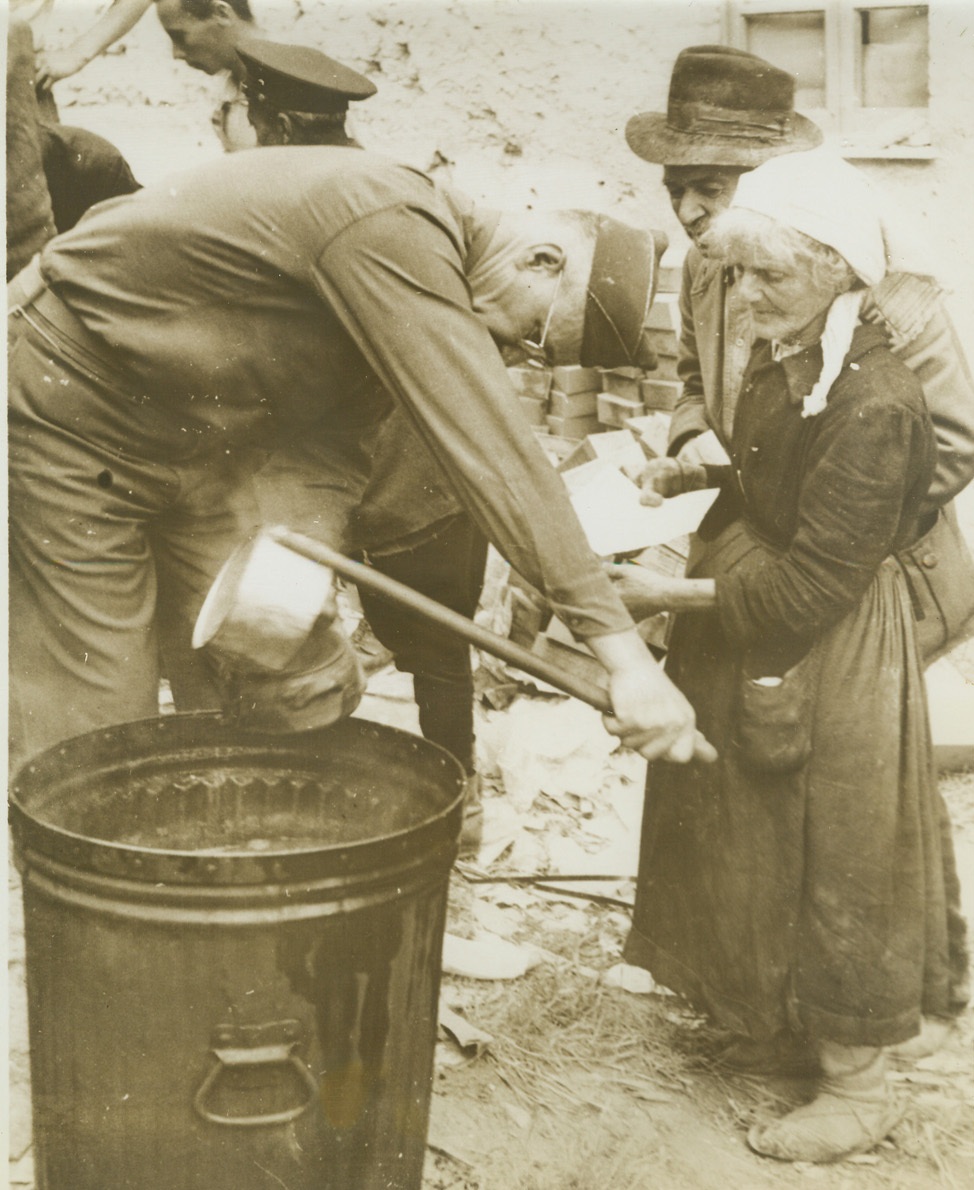
Italians Come Home, 5/31/1941. Italy – Italian civilian refugees have returned to Minturno after the Allied occupation of the town. Here an official of the Allied Military Government doles out soup for an old woman after examining her papers. Credit – WP – (ACME);
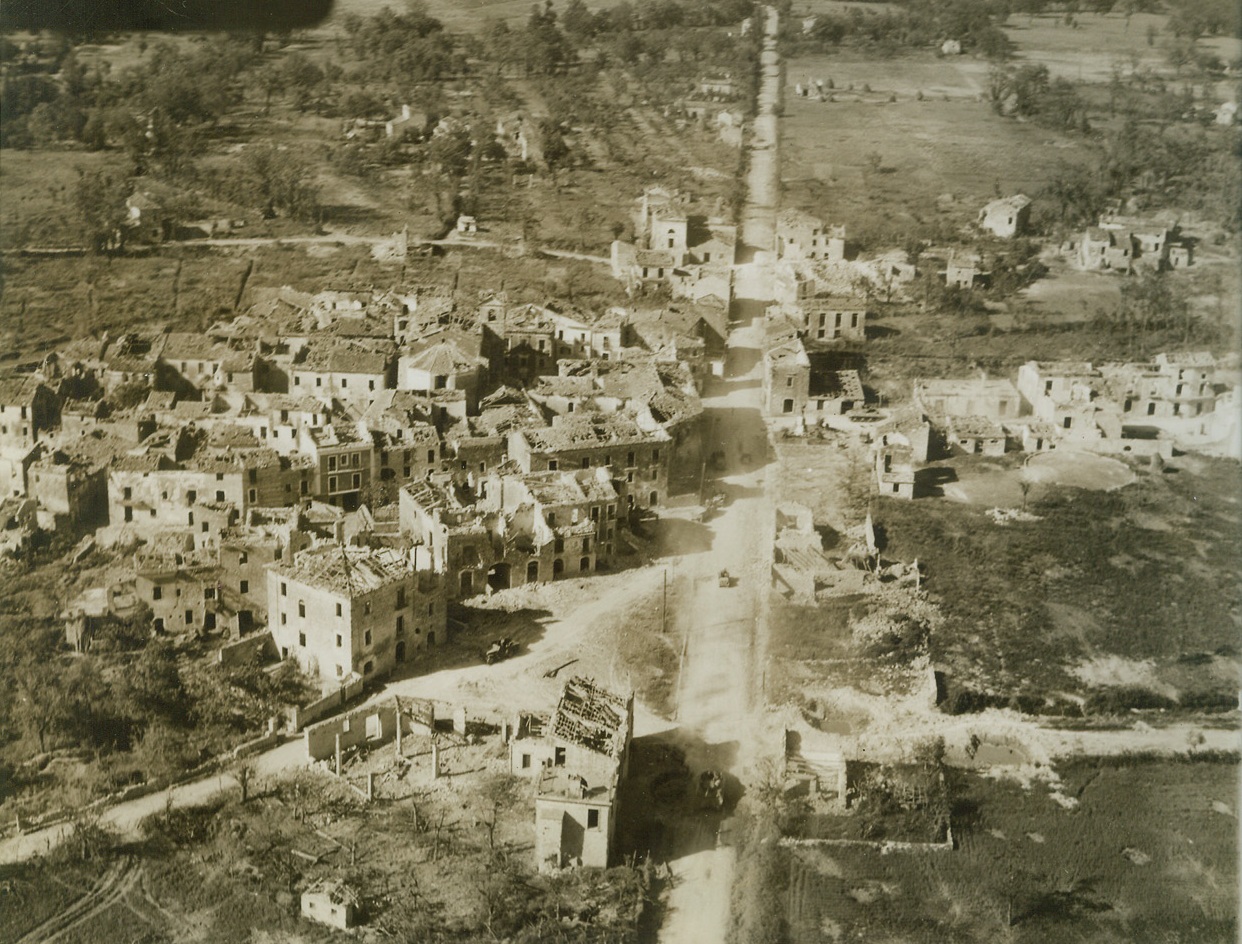
On the Road to Rome, 5/25/1944. Italy – Allied mechanized troops can be seen traveling this road through the Italian town of San Giorgio after its recent capture by Allied troops. The progress of the Fifth Army forces is marked by shellfire, smoked-in positions and shell-shattered and bomb wracked Italian towns. Credit: (ACME) (WP) (Photo by Charles Seawood, War Pool Correspondent);
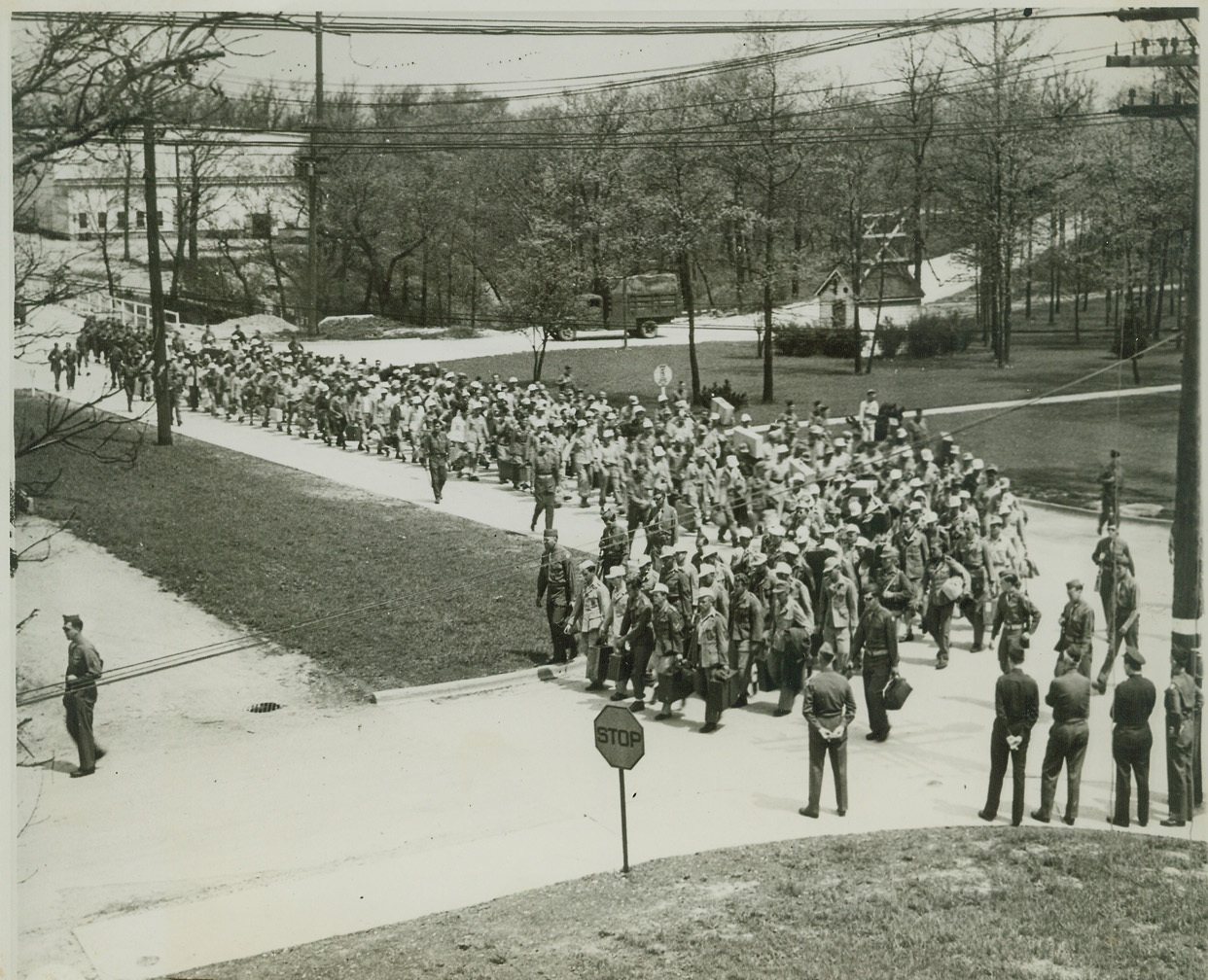
FORT SEES FIRST PRISONERS SINCE INDIANS, 5/20/1944. FORT SHERIDAN, ILL. – A new chapter in the history of Fort Sheridan, Ill., was written when German prisoners, many of them wearing uniforms in which they were captured, marched down the street on their way to the stockade where they will be confined. The Nazi ex-soldiers transferred from Camp Leonard Wood, Mo., are the first prisoners of war to arrive at Fort Sheridan since the internment of the last of the warring Indians. Credit: OWI Radiophoto from ACME;
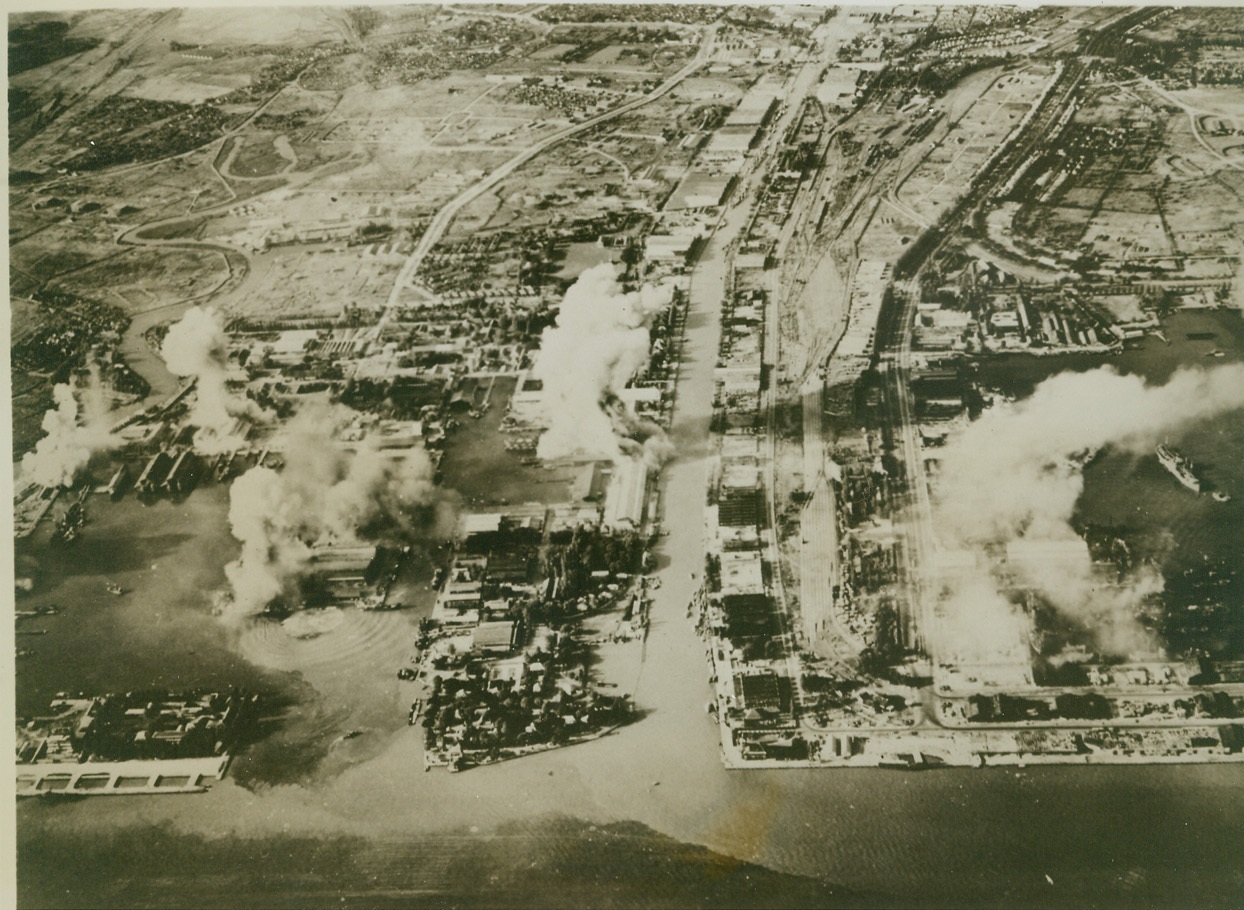
SOERABAYA DOCK AREA HIT, 5/30/1944. SOERABAYA, JAVA – Clouds of smoke billow up from docks and buildings as bombs crash down on the Jap-occupied town in Java. This scene was photographed during the recent large-scale Allied bombing raid on Soerabaya, when several important Japanese installations were hit, including machine shops, railroad yards, and power plant supplying the town with electricity. Credit: Official U.S. Navy photo from ACME;
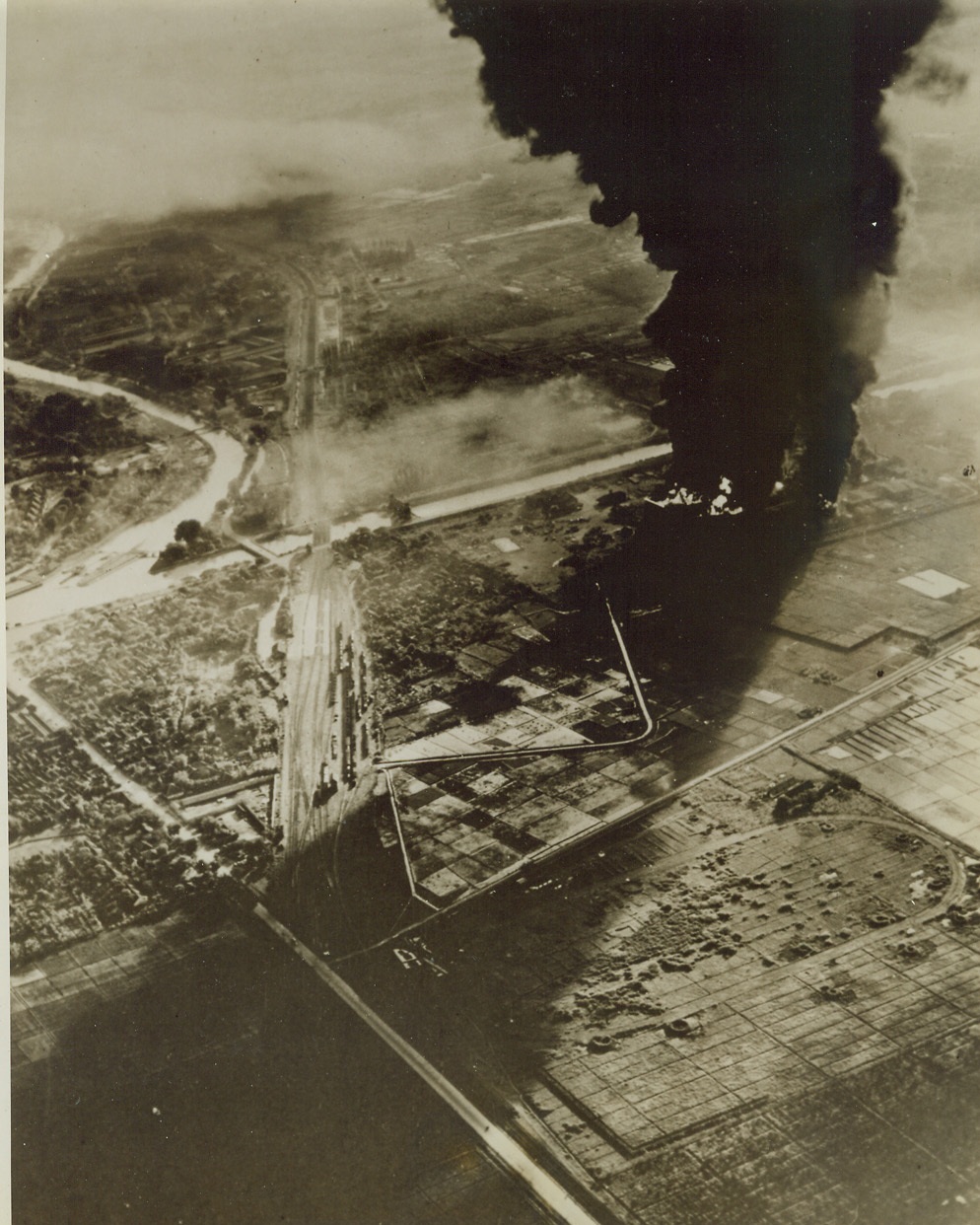
JAP FUEL BURNS AT SOERABAYA, 5/30/1944. SOERABAYA, JAVA – A huge shadow is cast across the country-side as jet black smoke rises from a fuel fire started by Allied raid and obscures the sun. This was part of the wide damage done to Jap installations at Soerabaya during recent large scale attack on that Jap-held city in Java, Netherlands Indies. Credit: Official U.S. Navy photo from ACME;
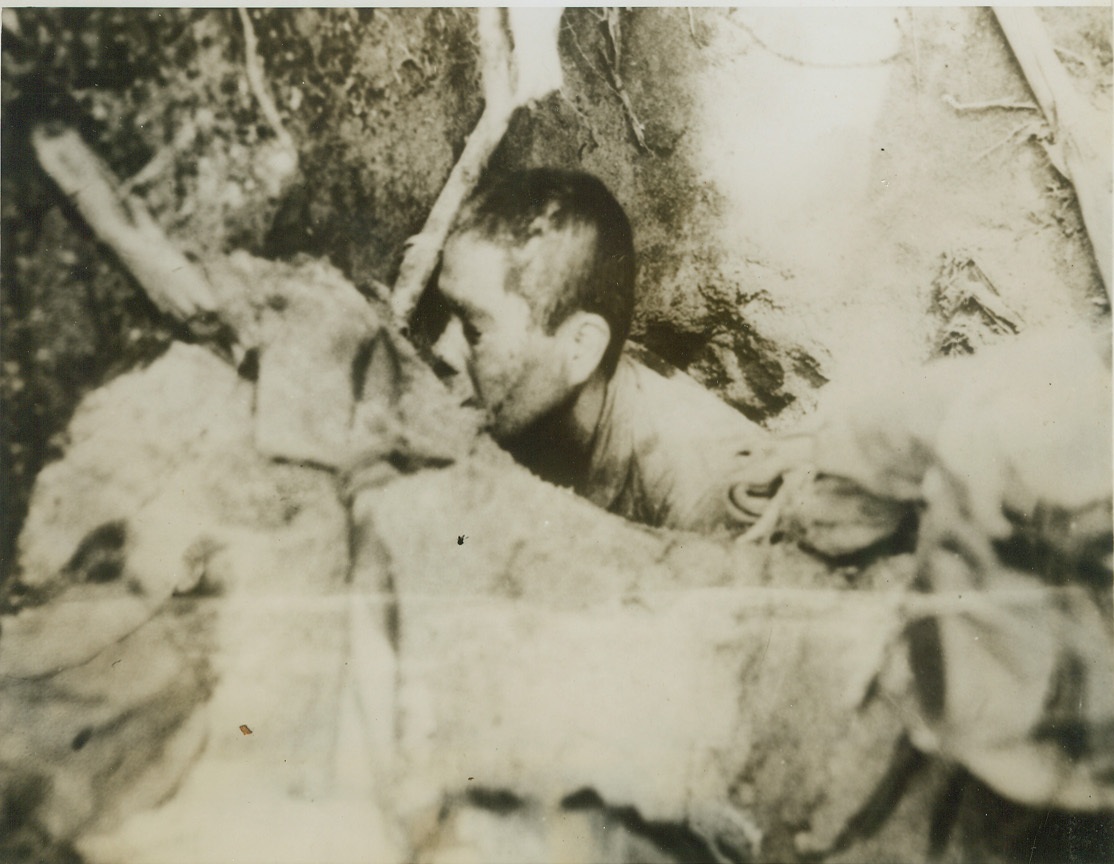
AN ENEMY IN OUR MIDST, 2/28/1944. Fear masks the face of this Jap sniper as he crouches in a foxhole to dodge the Yank bullets and grenades headed his way. The Nip hid himself in an American foxhole, and burrowed his way further in to escape detection. But our alert doughboys discovered him and a few minutes after this picture was taken, he died in a hail storm of lead. Credit: U.S. Treasury photo from ACME;
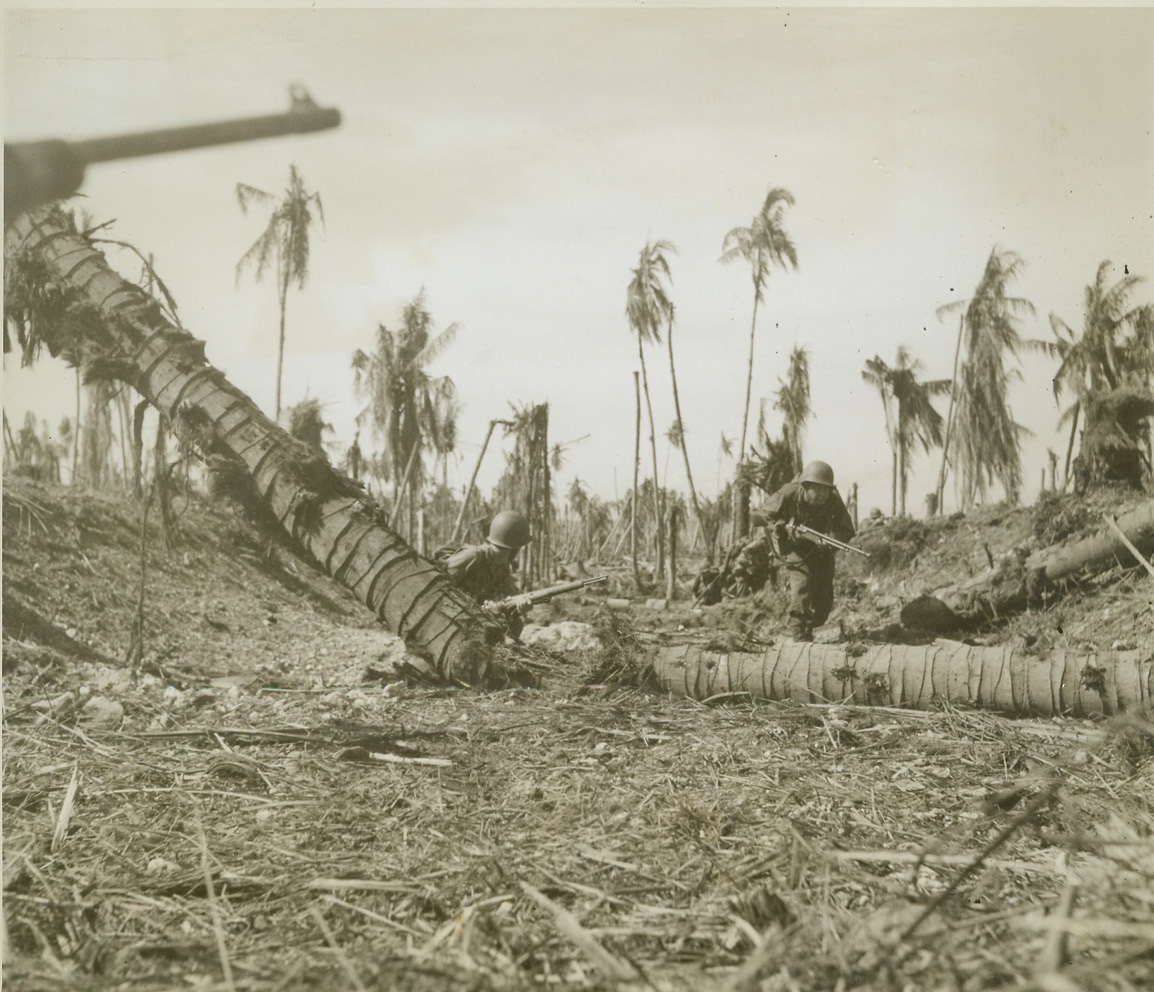
CAUTIOUS ADVANCE, 5/31/1944. WADKE ISLAND – With a medium tank providing cover for their advance, these American infantrymen, members of the U.S. invasion force that seized Jap-held Wadke Island, Dutch New Guinea, move cautiously forward as they search for Jap snipers. Gun of tank is visible at upper left. Credit: ACME photo by Frank Prist, War Pool correspondent;
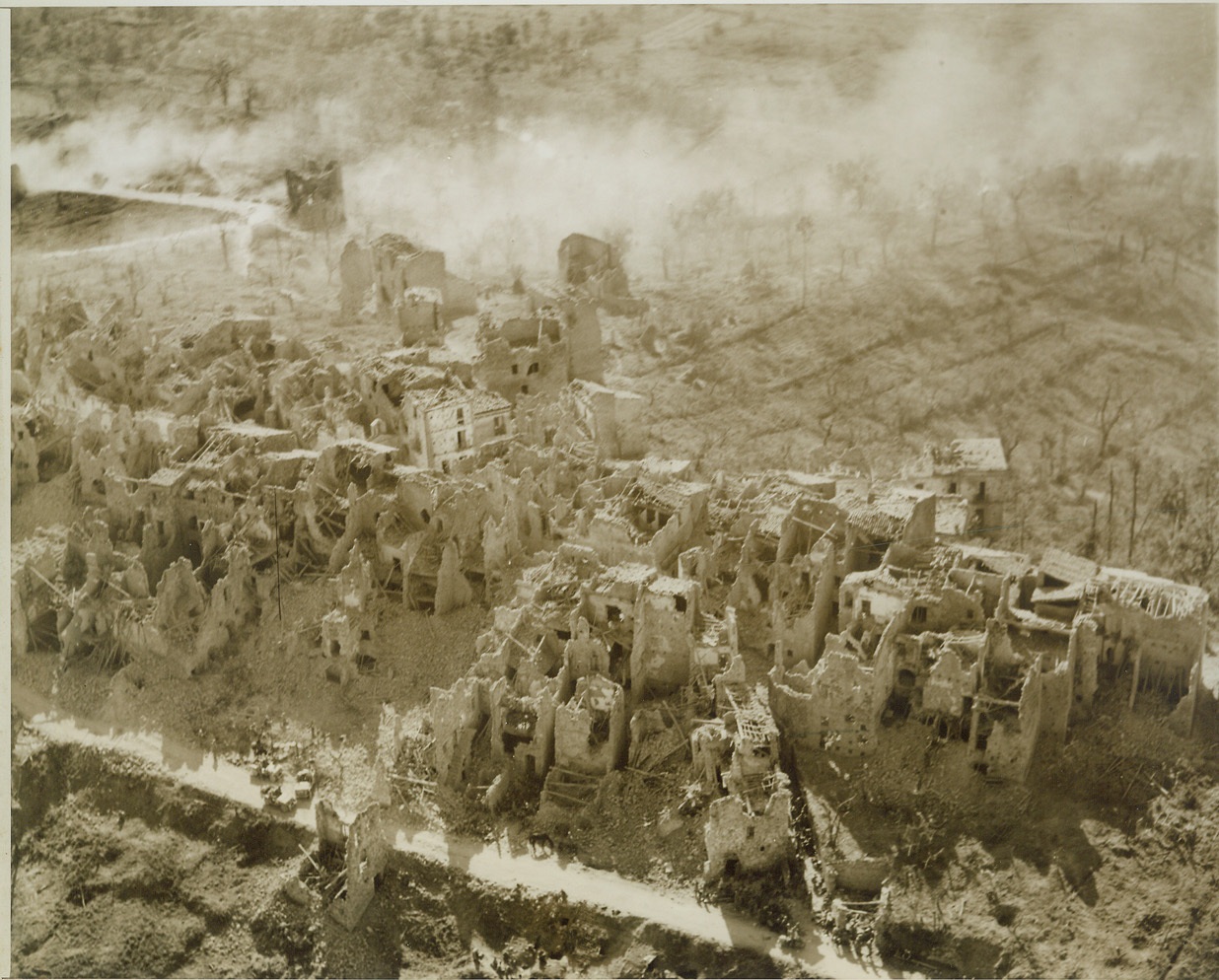
Scars of Battle, 5/25/1944. Italy – Home gutted by shellfire, the Italian town of Santa Maria Infante shows its battle scars – shell-shattered and bomb wracked. This was the first Italian town of any consequence taken by the American troops of the Fifth Army in the current offensive. Credit-WP-(ACME Photo by Charles Seawood, War Pool Correspondent);
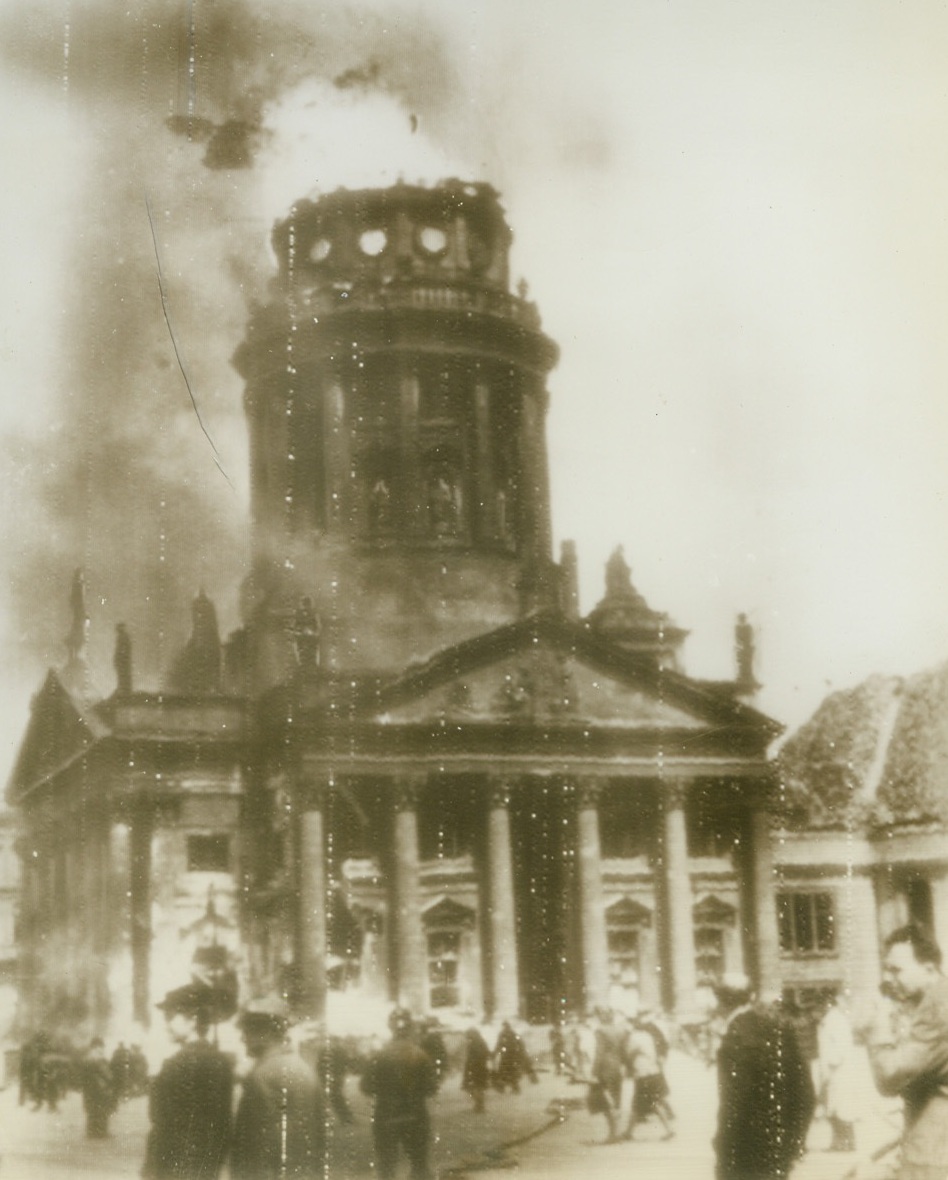
American Raid Hits French Cathedral, 5/30/1944. Berlin – According to the German caption on this photo radioed today from Stockholm, this is the Franzoesischer Dom (French Cathedral) on the Gendarmenmarkt, in Central Berlin, damaged and blazing after the American daylight raid on the German capitol on May 24th. Credit: (ACME Radiophoto);
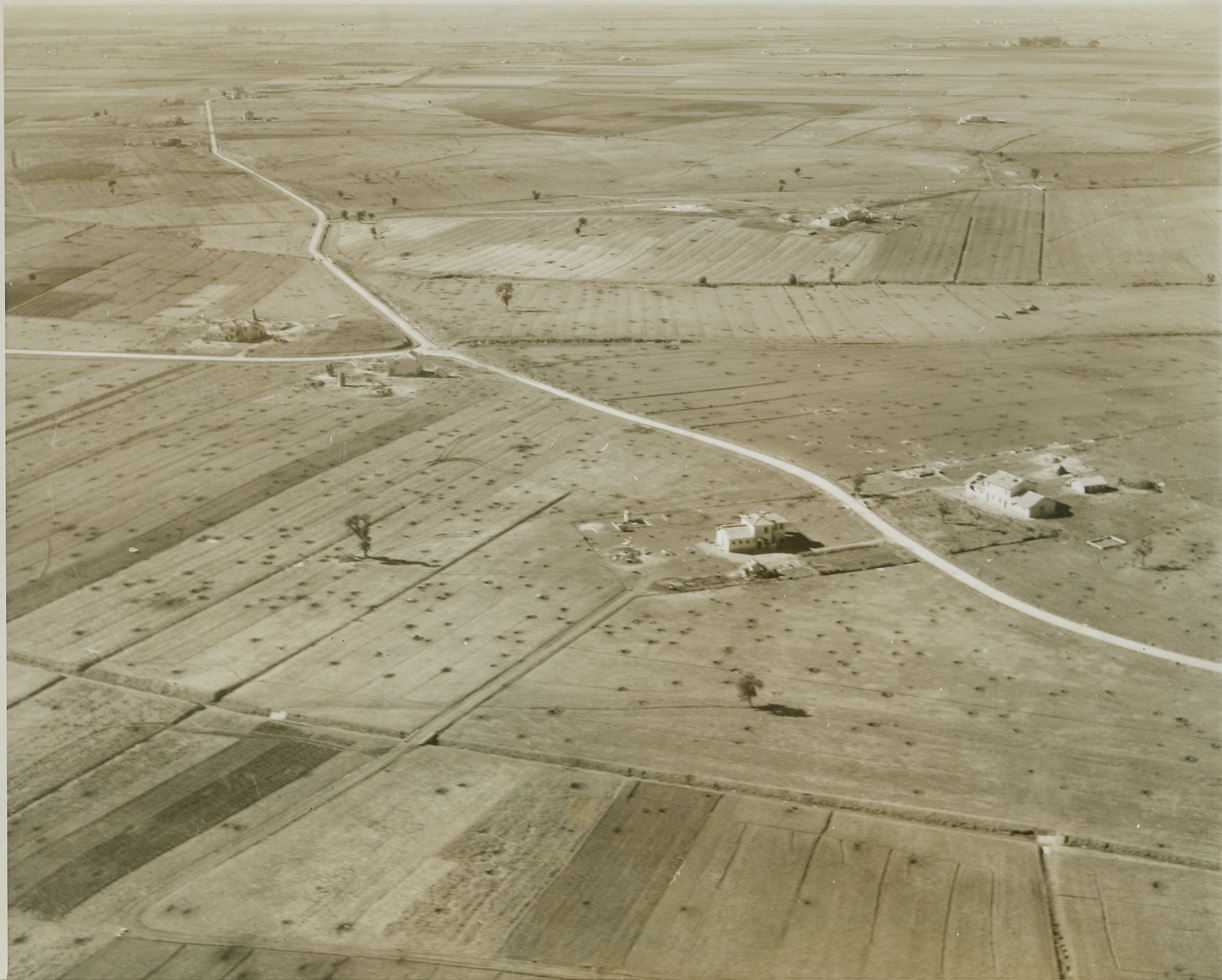
Germans Fire on Allied Positions, 5/22/1944. Cisterno Area, Italy – The flat terrain, scene of front line fighting between the Anzio beachhead forces and Nazi troops, is pockmarked with shell holes and bomb craters. The Allied beachhead forces are moving rapidly forward to join the 5th Army troops, which today (May 22) moved into Terracina, only 24 miles form the beachhead positions. Should this junction be effected, Nazi forces falling back toward Rome would be imperiled by the Allies advancing toward that key city. Credit (ACME Photo by Charles Seawood, War Pool Correspondent);
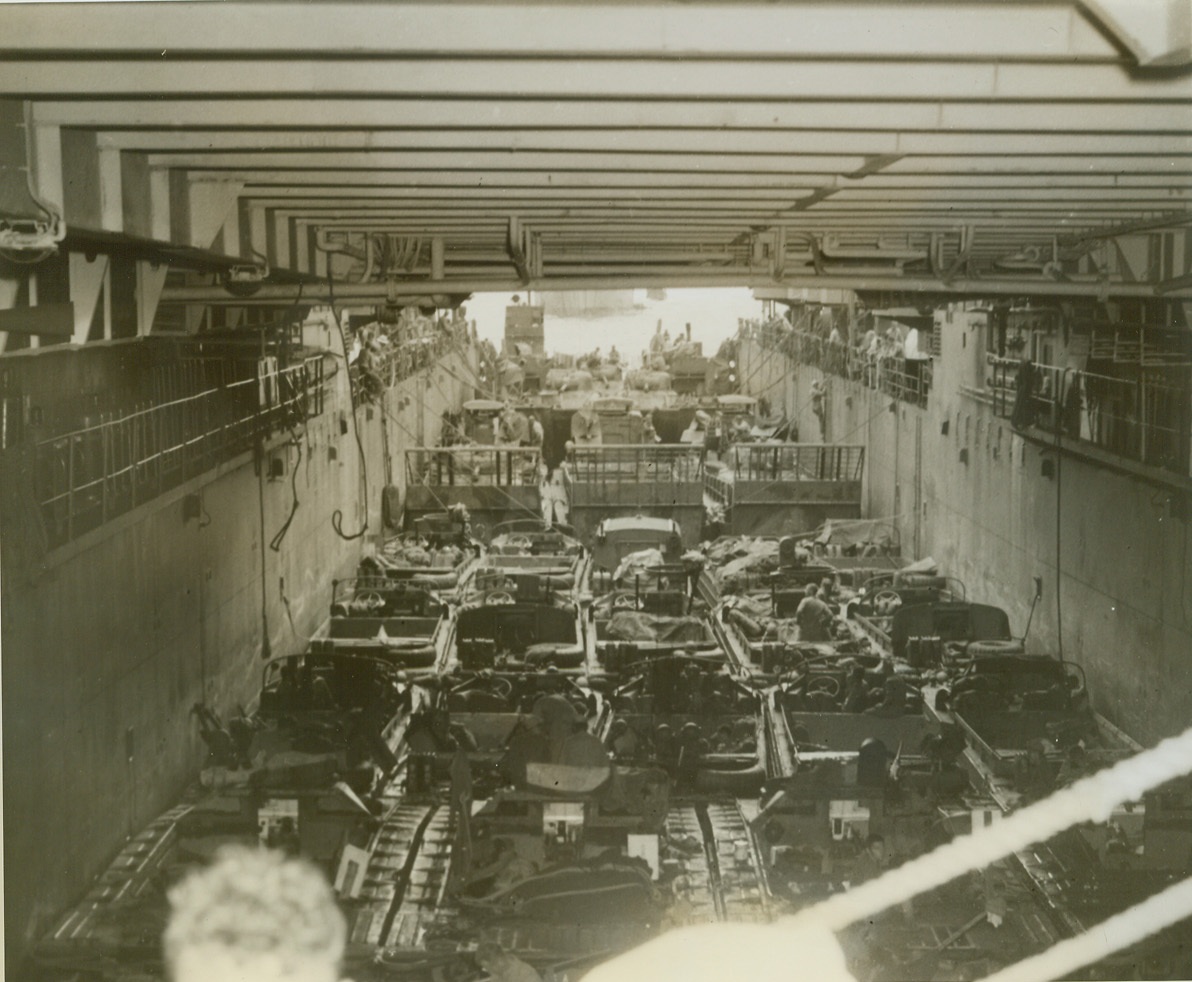
WELL LOADED, 5/8/1944. NEW GUINEA – The LSD (Landing Ship Dock) is shown somewhere in New Guinea, with its well deck loaded down with small craft. Included are LST (Landing Ship Tanks), Ducks, Buffaloes, and LSM (Landing Ship Mechanized). The smaller craft leave the mother vessel, water borne. In the recent invasion of Hollandia, Dutch New Guinea, there were Jap airplane engines, heavy guns, trucks, tractors, and other supplies, but few Japs. Our forces encountered minor opposition and are now at work wiping out the 60,000 Jap troops cut off from reinforcement and supply somewhere between Aitape and Hollandia. Credit: ACME photo by Tom Shafer, War Pool Correspondent;
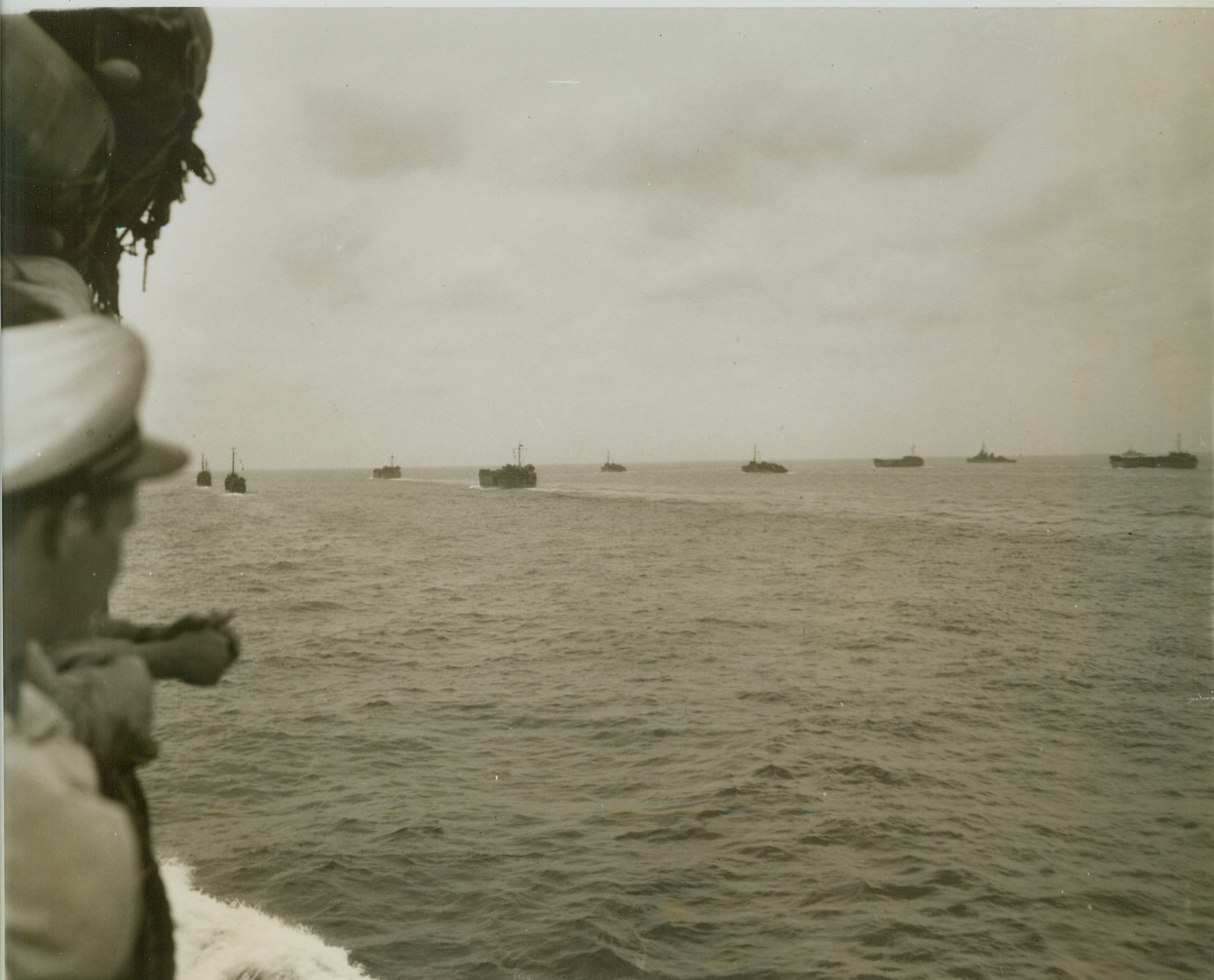
PART OF HOLLANDIA INVASION FLEET, 5/3/1944. DUTCH NEW GUINEA – Landing craft and small warships of the great Allied Task Force that invaded Hollandia, Aitape, and Tanamerah Bay, near the coast of Dutch New Guinea during the attack. (Passed by censors.) Credit: ACME photo by Thomas L. Shafer for the War Picture Pool;
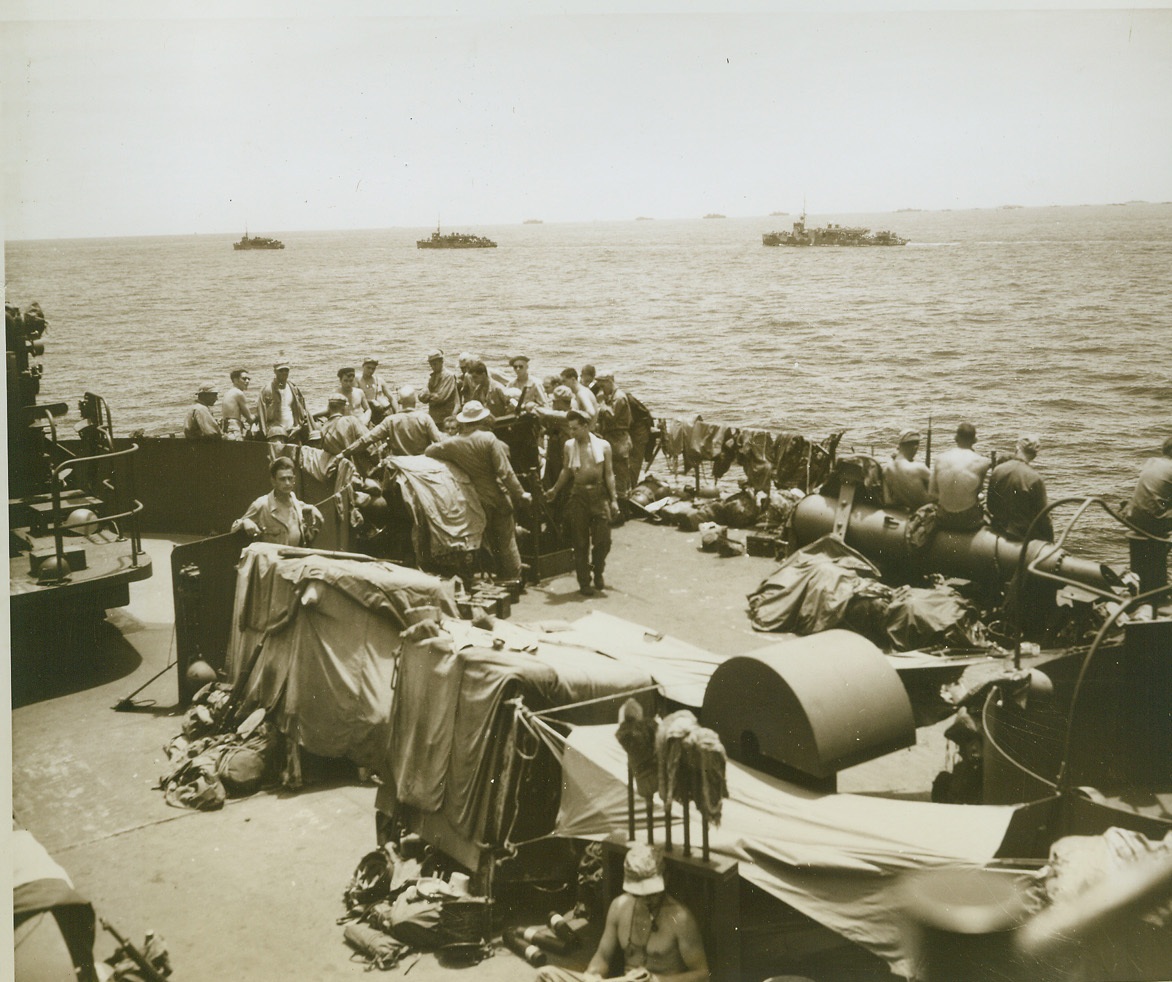
PART OF HOLLANDIA INVASION FLEET, 5/3/1944. DUTCH NEW GUINEA – As far as the eye can see, craft of the huge Allied invasion fleet which Hollandia, Aitape, and Tanamerah Bay, dot the surface of the sea as they head for the Dutch New Guinea coast. In the foreground, men aboard one of the ships relax in the warm sun, enjoying the last few moments before the attack. (Passed by censors.) Credit: ACME photo by Thomas L. Shafer for the War Picture Pool;
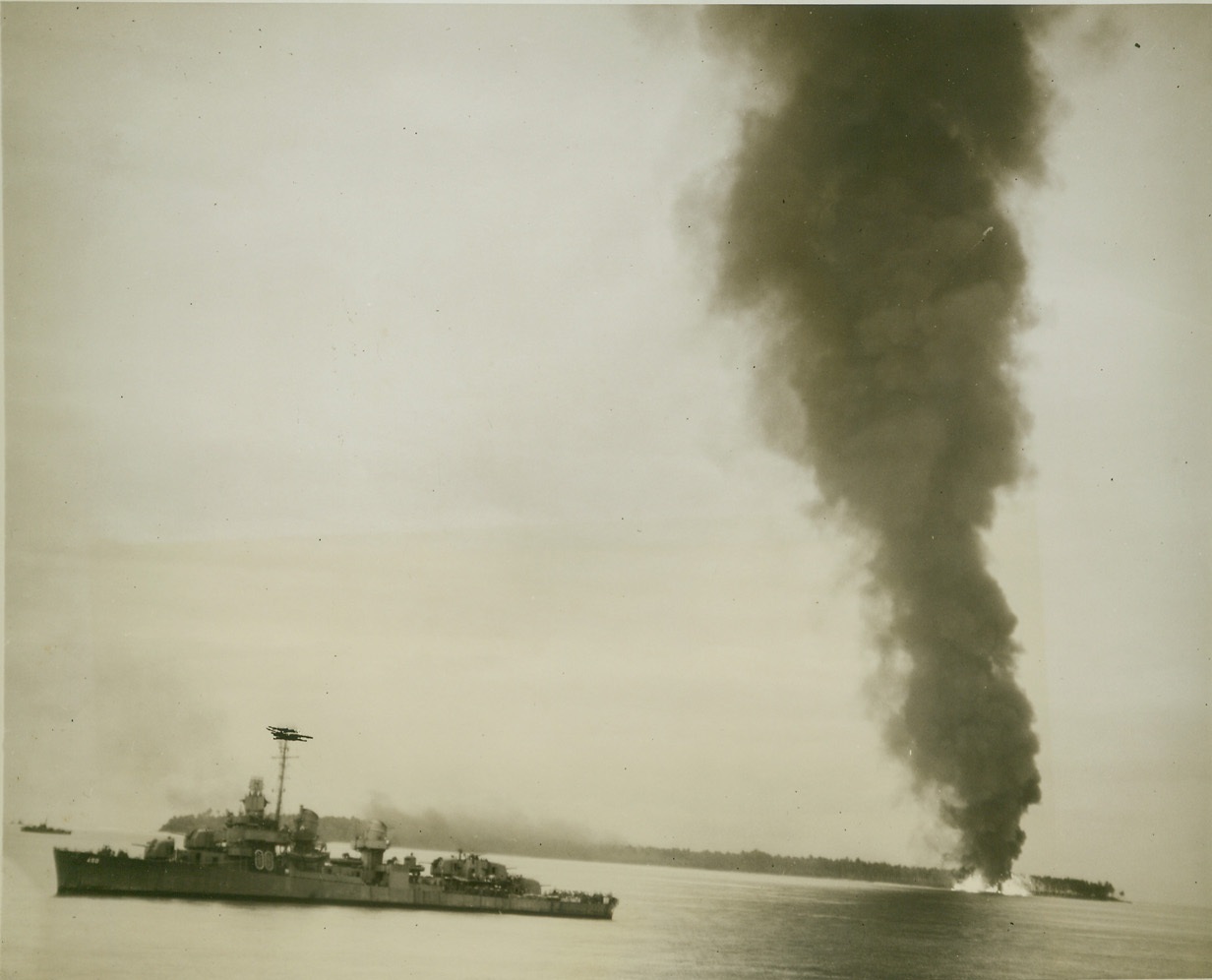
YANK DESTROYERS BLAST FUEL DUMP, 5/3/1944. DUTCH NEW GUINEA – A column of thick, black smoke towers from a blazing Jap fuel dump on Seleo Island, after a direct hit by U.S. destroyers, one of which is standing off the island at left. The island, one of three in Aitape Harbor, was attacked during the invasions of Dutch New Guinea. (Passed by censors.) Credit: ACME photo by Thomas L. Shafer for the War Picture Pool;
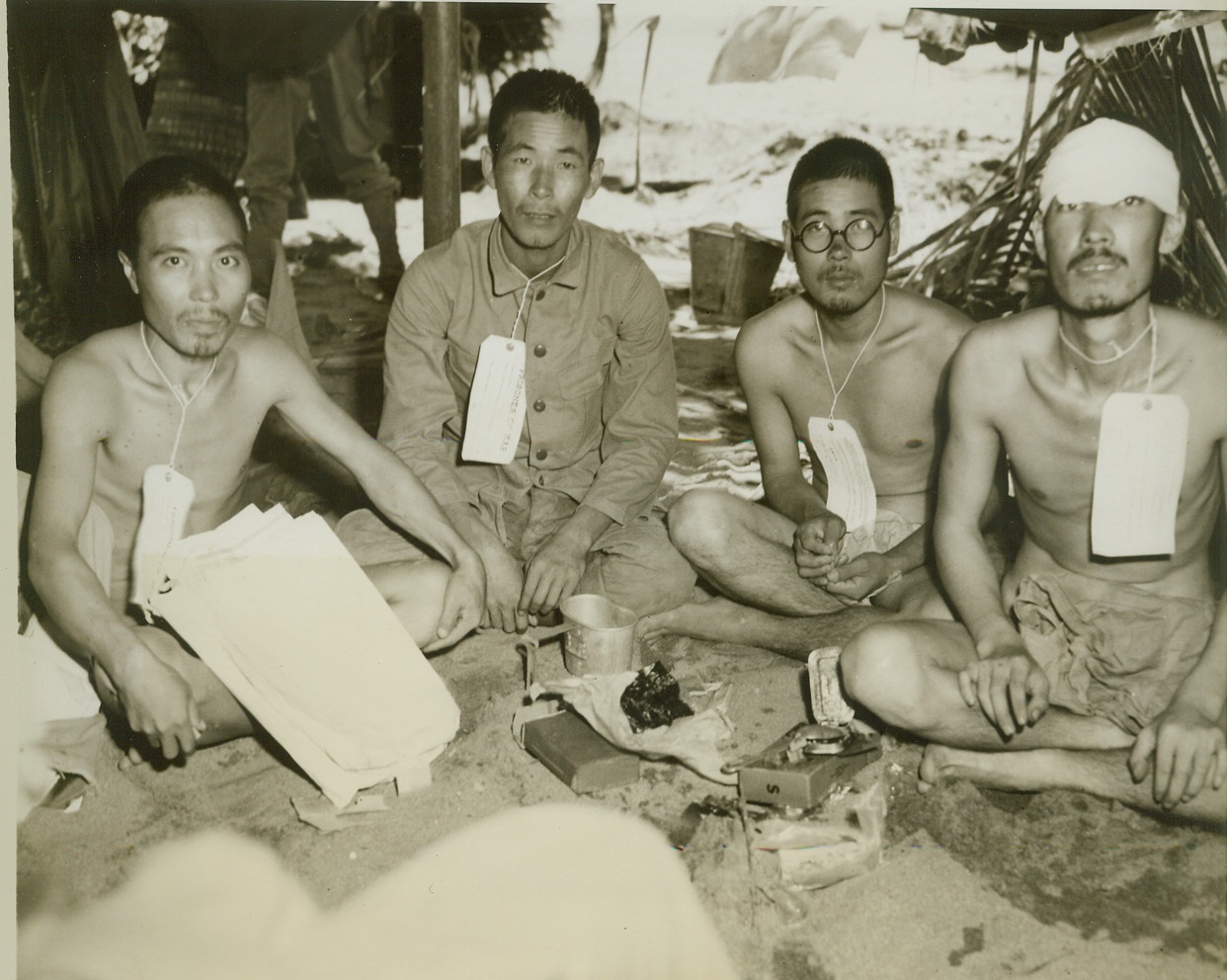
GLAD TO SAMPLE YANK RATIONS, 5/3/1944. DUTCH NEW GUINEA – Jap prisoners, captured during the Allied attack on Aitape, Dutch New Guinea, part of the Hollandia invasions, squat around U.S. field rations which they enjoy in spite of the fact that they wanted to be killed during the attack. (Passed by censors.) Credit: ACME photo by Thomas L. Shafer for the War Picture Pool;
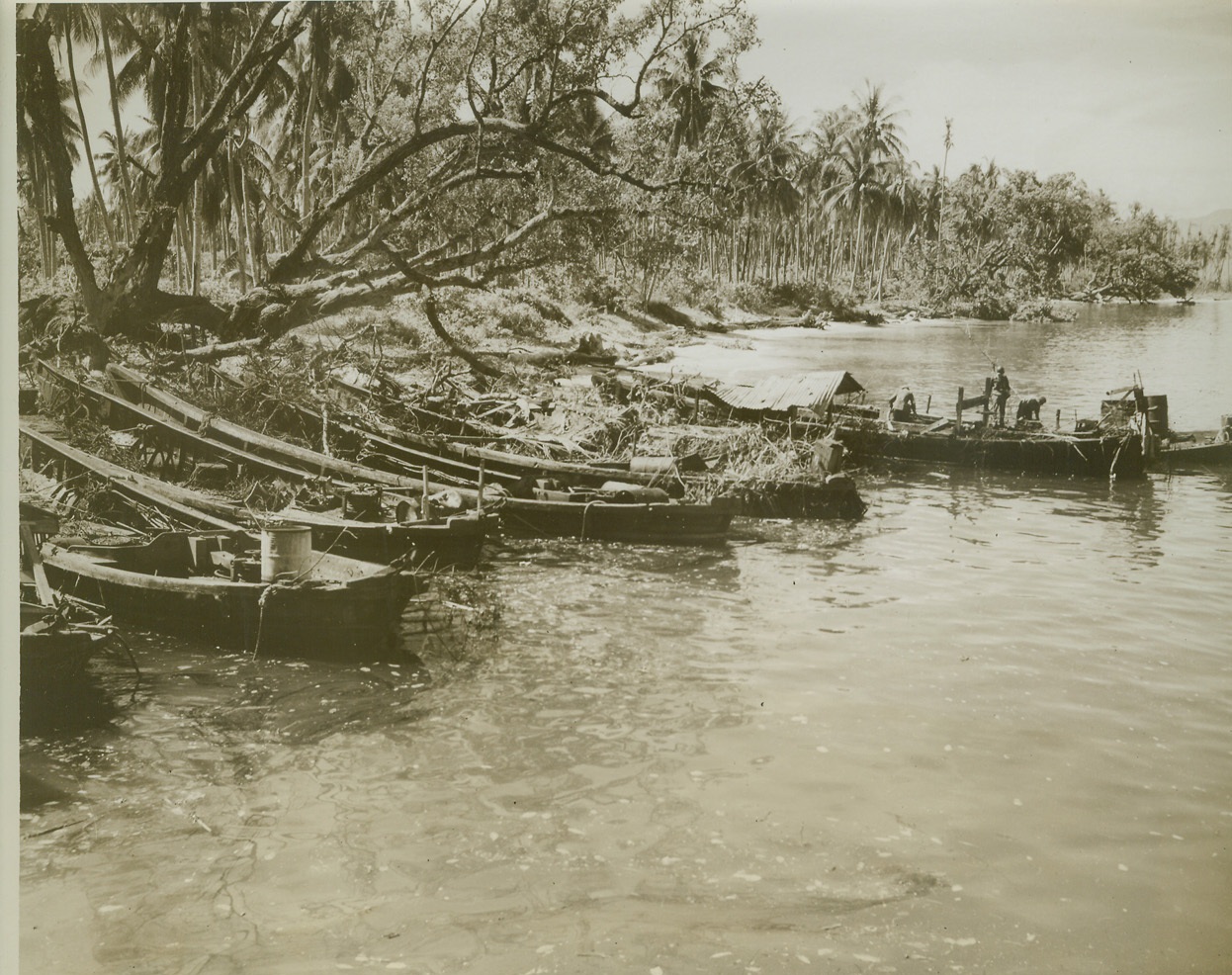
JAP BARGES BURNED OUT BY BOMBARDMENT, 5/3/1944. DUTCH NEW GUINEA – U.S. troops (right) look over Jap barges on Selso Island, burned out under shelling by Allied warships. The island is one of three in Aitape Harbor attacked during the invasions of Dutch New Guinea. (Passed by censors.) Credit: ACME photo by Thomas L. Shafer for the War Picture Pool;
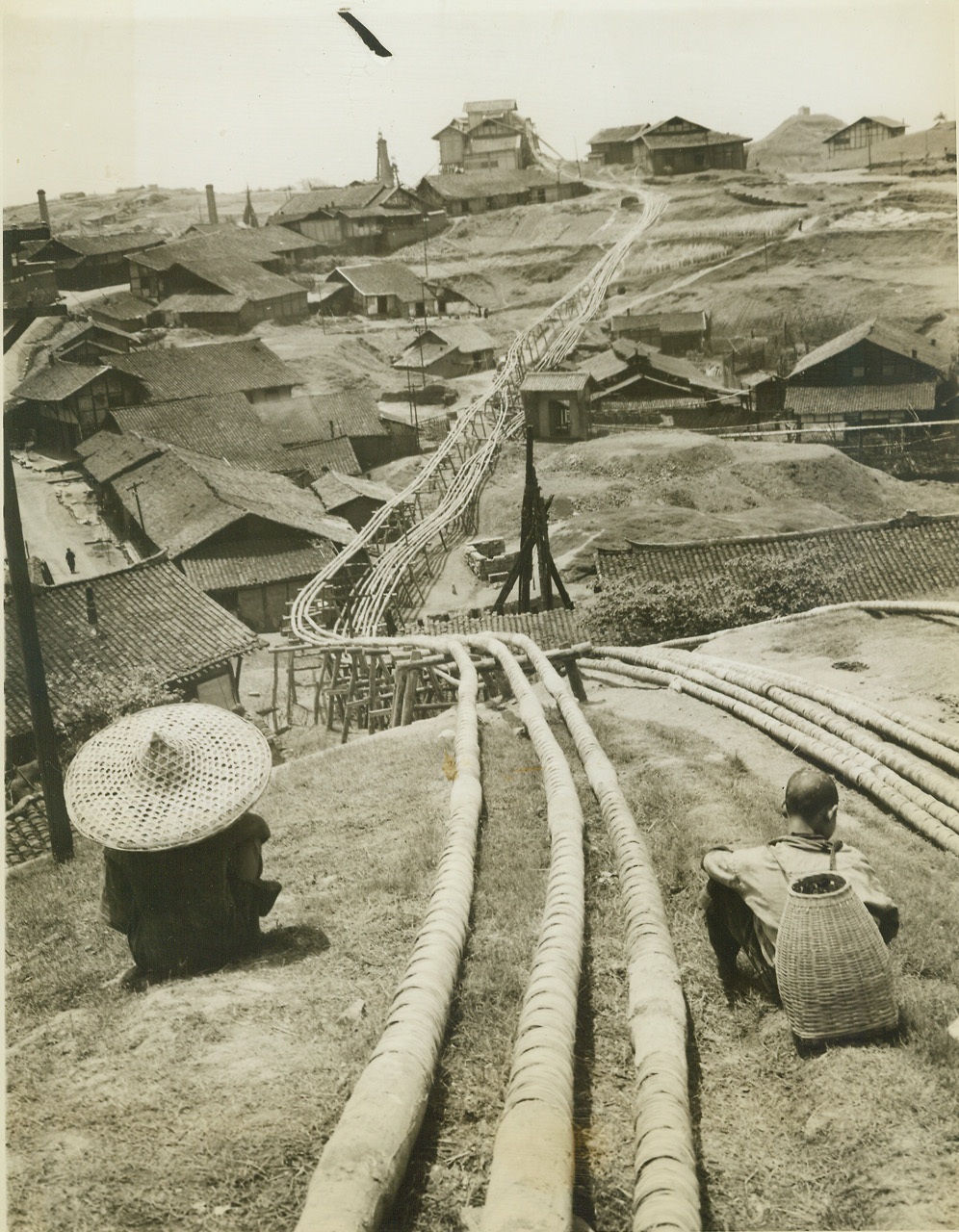
SALT FOR THE CELLARS OF CHINA, 5/23/1944. TSE LIU CHING, CHINA – One of the most thriving industries in this area of China is the salt mines located at Tse Liu Ching. These mines, 2,600 years old, are cultivated by rustic methods, but nevertheless produce 250,000 metric tons of salt a year, or one fourth of all the salt produced in free China. Three hundred thousand laborers work the mines, from which salt is shipped to all parts of the East. Picture shows bamboo pipelines running toward one of the refineries from the wells. Credit: ACME photo by Frank Cancellare, War Pool Correspondent;
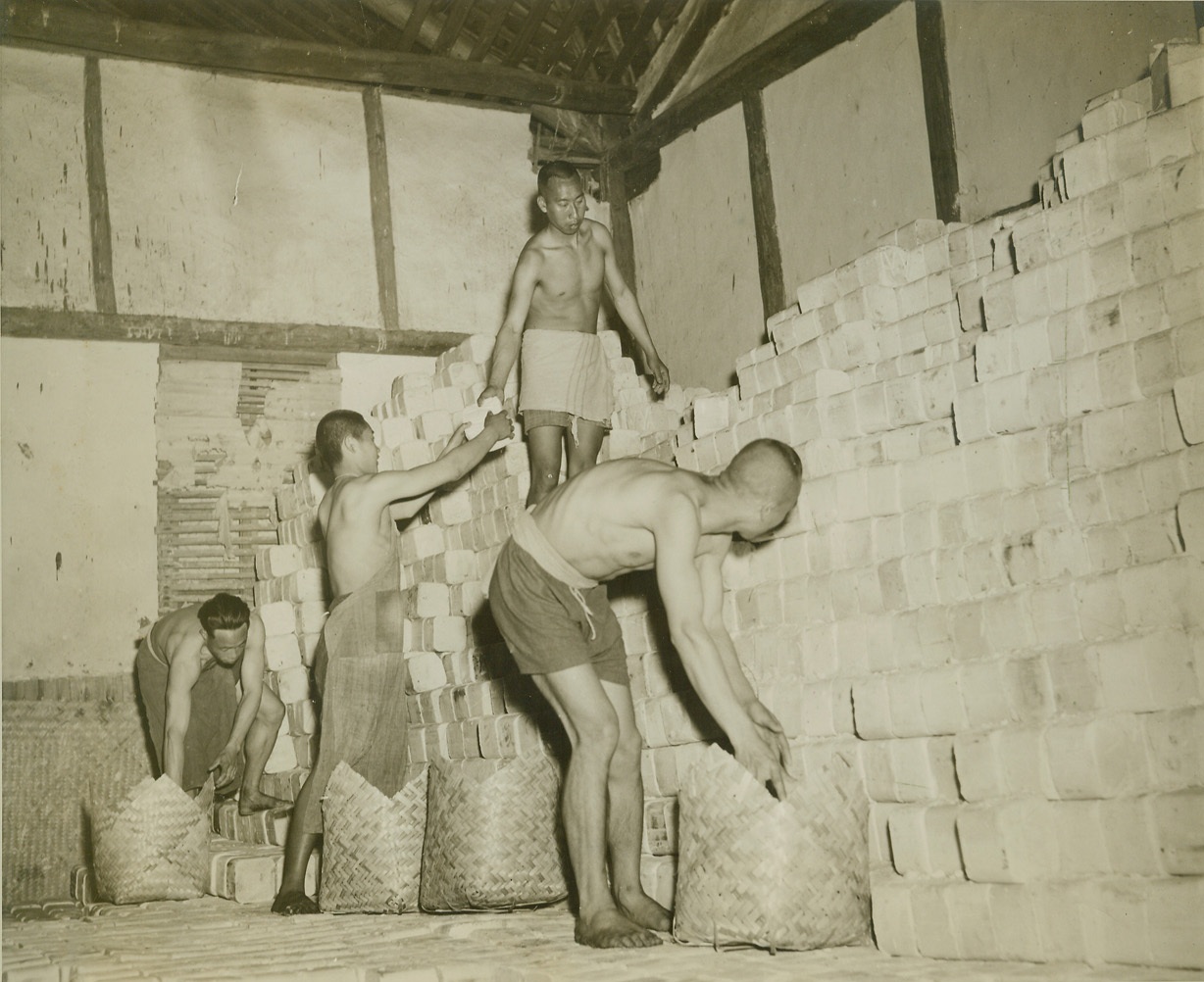
SALT FOR THE CELLARS OF CHINA, 5/23/1944. TSE LIU CHING, CHINA – One of the most thriving industries in this area of China is the salt mines located at Tse Liu Ching. These mines, 2,600 years old, are cultivated by rustic methods, but nevertheless produce 250,000 metric tons of salt a year, or one fourth of all the salt produced in free China. Three hundred thousand laborers work the mines, from which salt is shipped to all parts of the East. Picture shows: Laborers place the refined salt into cane baskets. The salt blocks are formed after the moisture is boiled from the brine at the refinery Credit: ACME photo by Frank Cancellare, War Pool Correspondent;
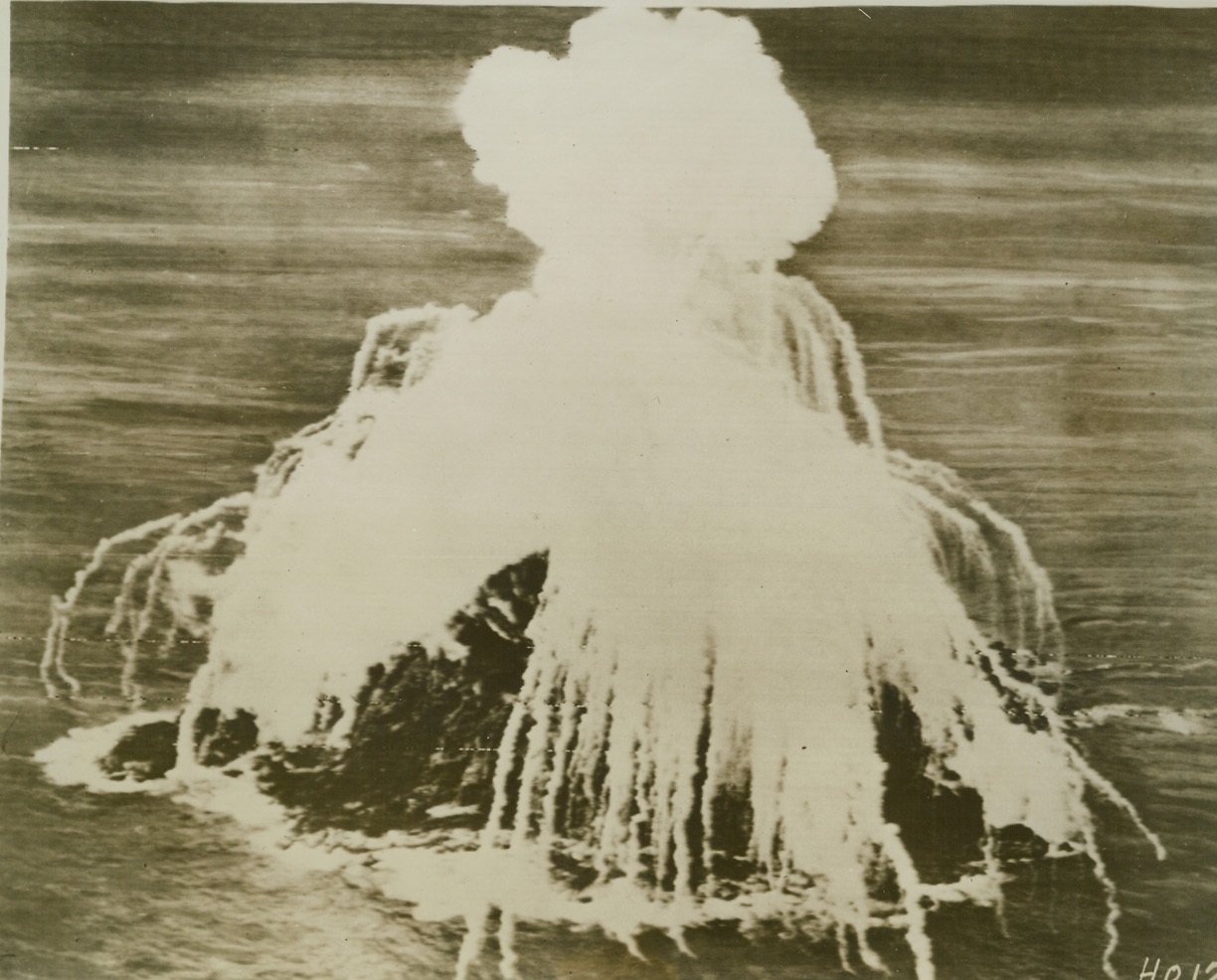
INCENDIARY “SHOWER” FOR JAPS, 5/2/1944. This photo, flashed from Hawaii to the U.S. by radiotelephoto, shows a white phosphorous bomb “shower” from planes of the U.S. Seventh Air Force completely enveloping a small unidentified Jap-occupied island in the central Pacific area. (Note background has been blanked out for security reasons.) Credit: Army radiotelephoto from ACME;
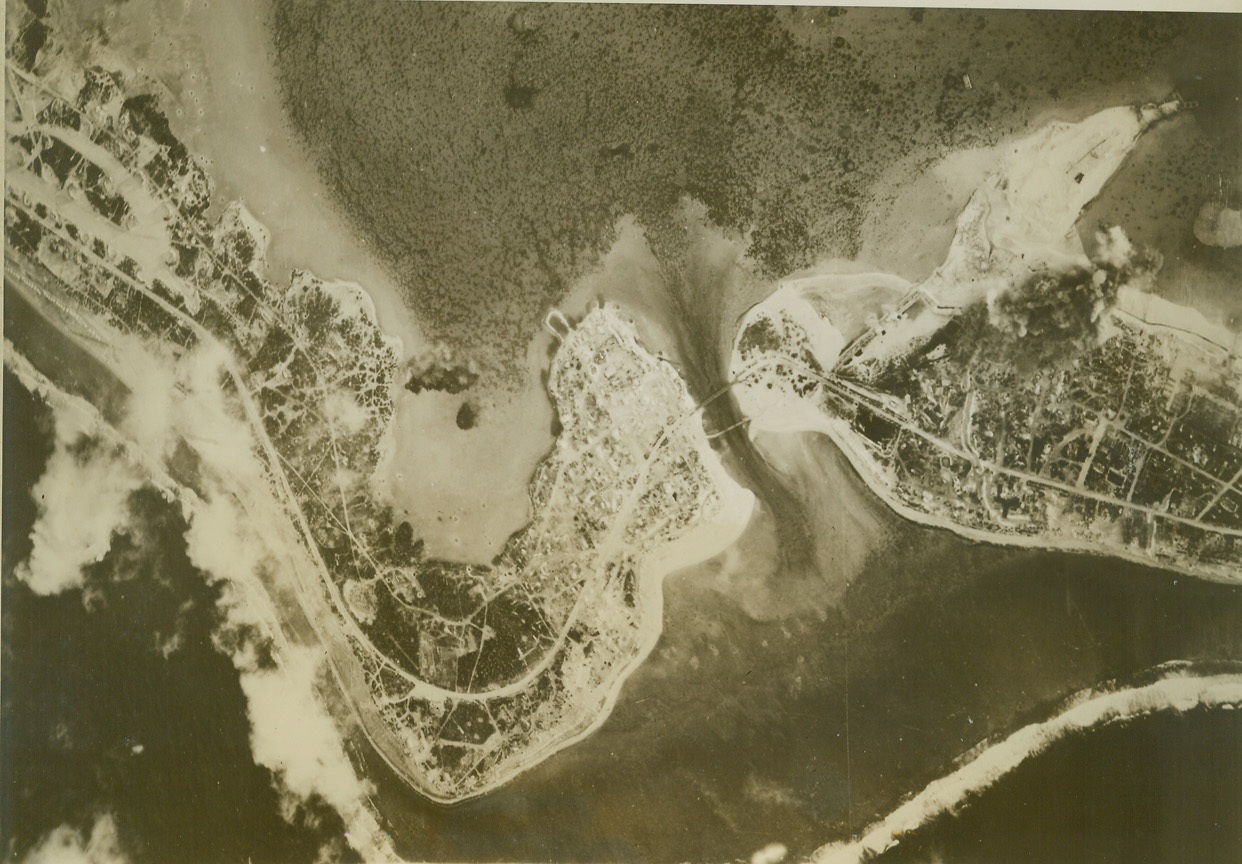
WAKE ISLAND BLASTED AGAIN, 5/2/1944. WAKE ISLAND – Huge clouds of smoke rise from Wake Island when 7th AAF bombs hit the area in which most of Jap construction is concentrated. This attack, made about a week ago, shows Jap efforts to strengthen the island. Numerous place revetments – all empty- are shown at the end of the main runway. Necklace of white dots on the beach are piles of sand made by Japs as anti-tank traps against constant threat of U.S. invasion. Credit: ACME;
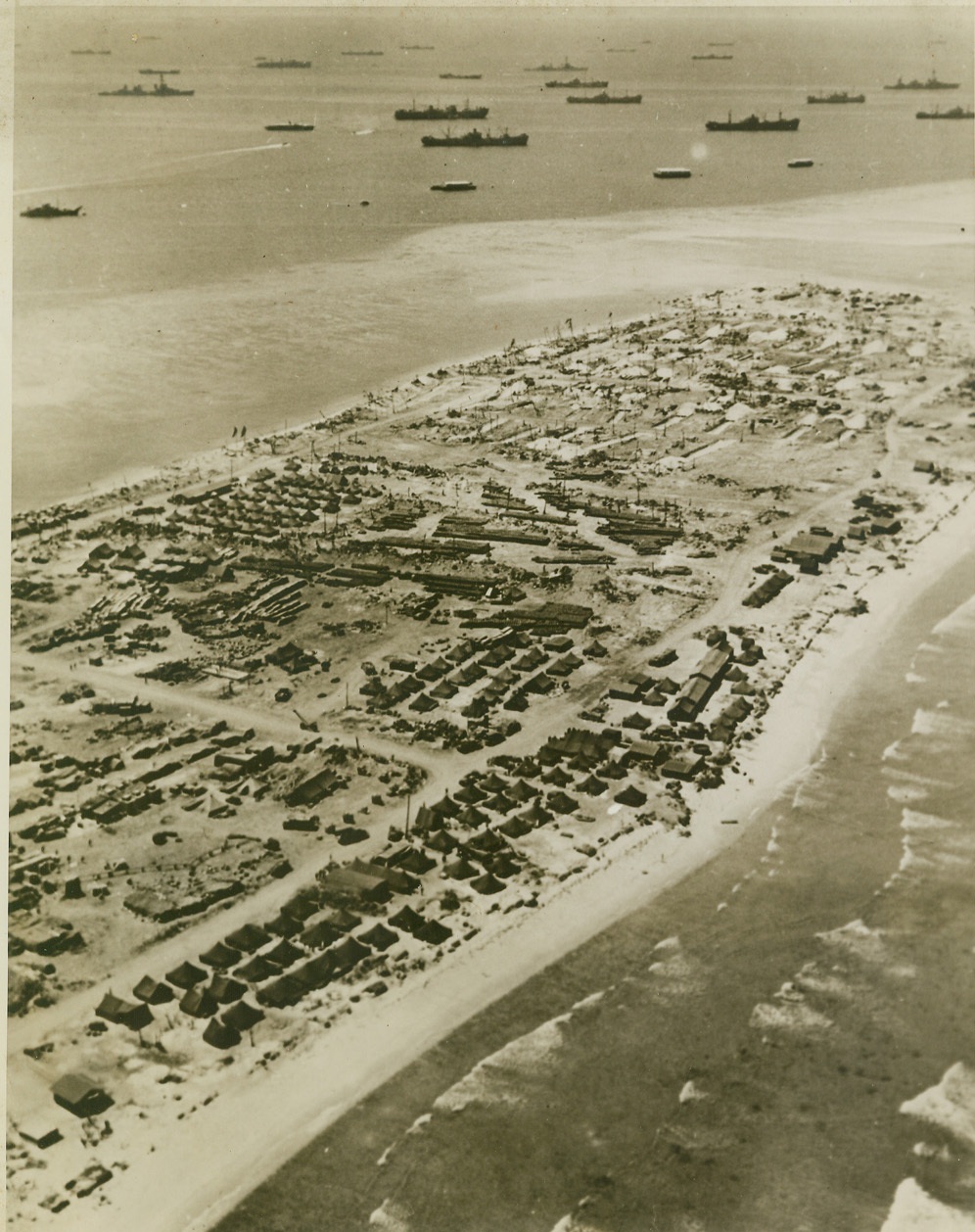
YANKS REBUILD KWAJALEIN, 5/2/1944. KWAJALEIN – This aerial view of newly-conquered Kwajalein Island in the heart of the Marshalls Group shows how the U.S. Navy Task Force is at work rebuilding the shell-shattered base. Rows of tents house Seabees, whose skillful efforts have already partly removed the pock-marks of war on the Atoll. Part of the Navy Task Force can be seen anchored offshore. Credit: U.S. Navy photo via OWI Radiophoto from ACME;
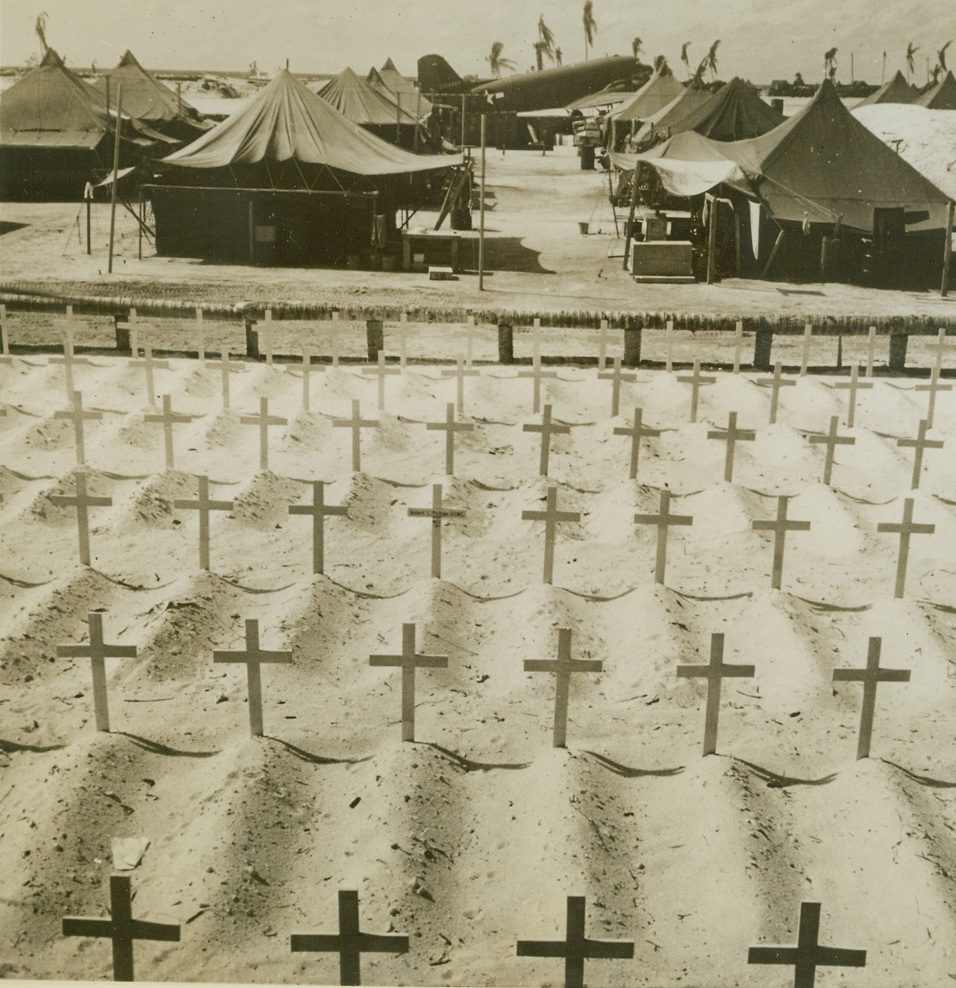
Tarawa Memorial, 5/2/1944. TARAWA--Rows of mounds with white crosses at their heads, mark the resting place for Americans who fell in the battle for Tarawa on November 20th 1943. Nearby their comrades, housed in tents, carry on the fight against the Japs from the Gilberts Base.Credit: US Navy Photo from ACME;
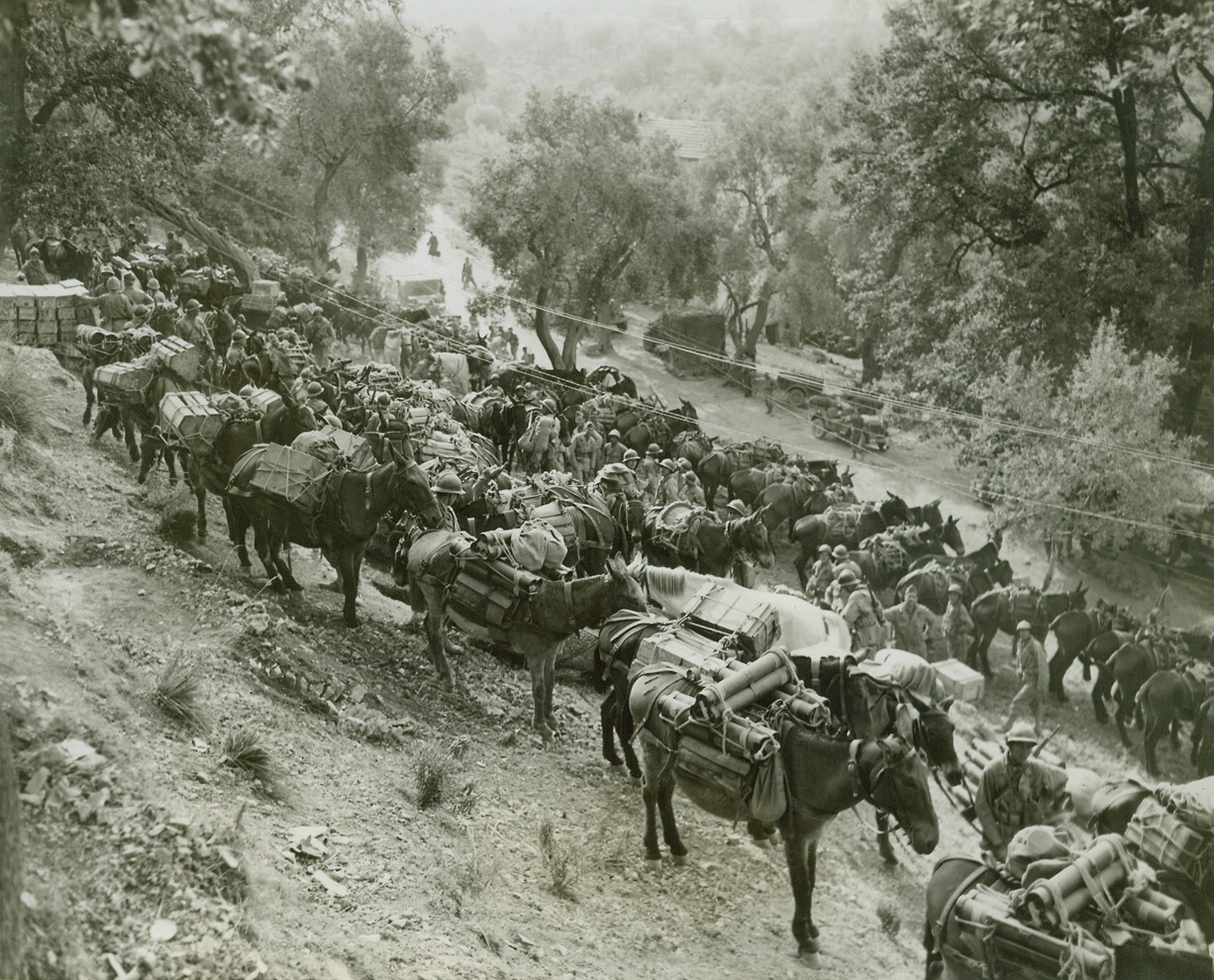
First Original Photos Of Latest Italian Drive, 5/18/1944. This is one of the first original photos to be received from the Italian Front since the start of the new allied drive. The Picture was made on May 13th and despite the various channels fo censorship and transportation problems they were in Washington, D.C. by the afternoon of May 18th. It is believed that a new record has thus been established for the expediting of news pictures by the army. PHOTO SHOWS—Hard in the wake of the French forces passing through Castleforte on the Fifth army front comes long lines of ammunition food and other supplies going forward to forward echelons and frontline infantrymen. The photo was made north of the Garigliano River, not far from the first important objective gained on the second day of the offensiveCredit: Acme Photo by Charles Seawood for the War Picture Pool;
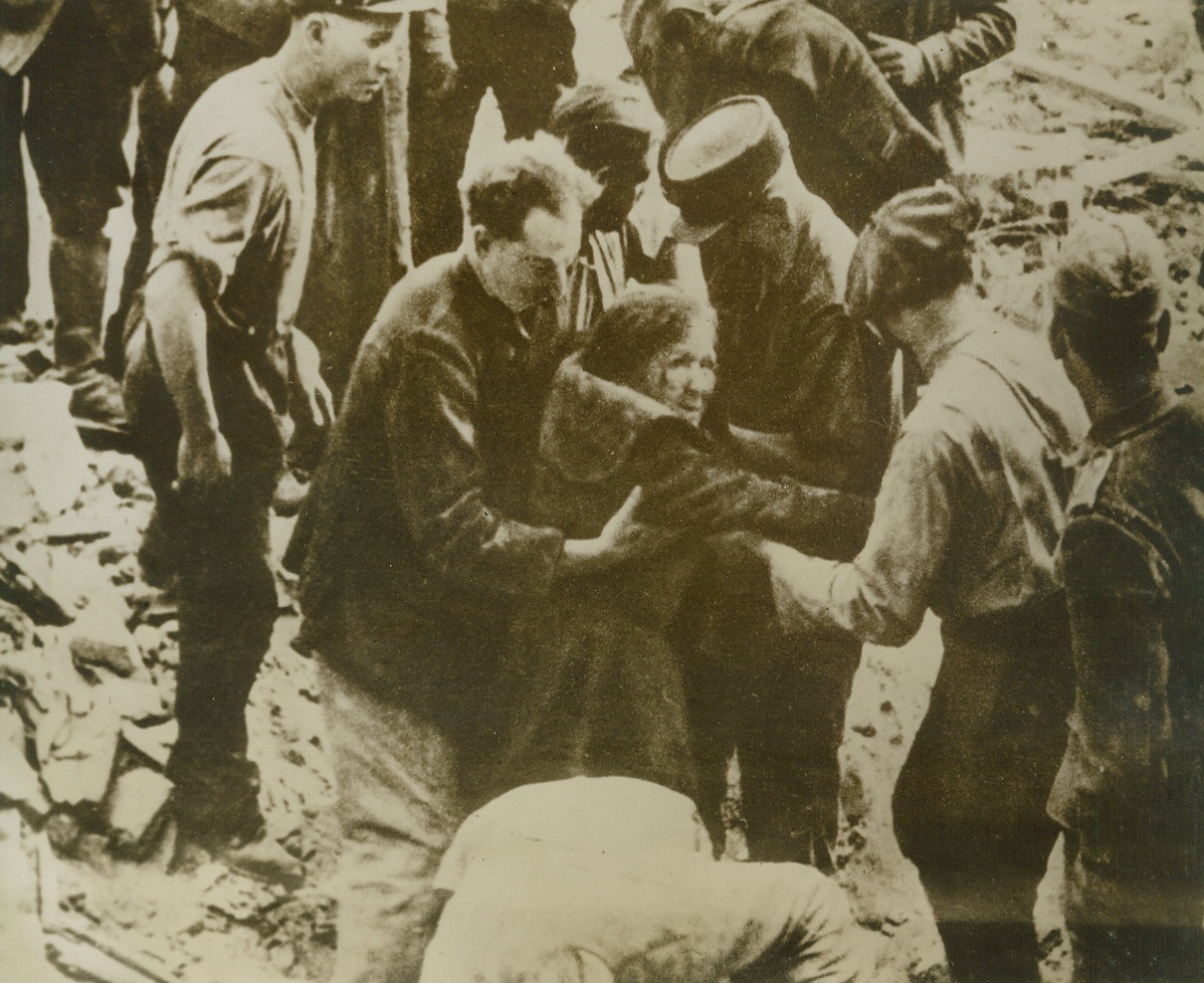
Invincible Berlin?, 5/19/1944. BERLIN GERMANY – When Goering boastfully proclaimed that the allies would never bomb Berlin, he reckoned without the forcefulness and persistence of the RAF and the USAAF. Recent raids by the two air forces have reduced the German Capital to shambles, and given to the Nazis a return engagement of the Blitz with which they so heartlessly pounded London. Here, an aged German woman struggles out from a shelter after an allied raid on Berlin, and is helped as she makes her way through the wreckage of what was once a Berlin thoroughfare.Credit: ACME;
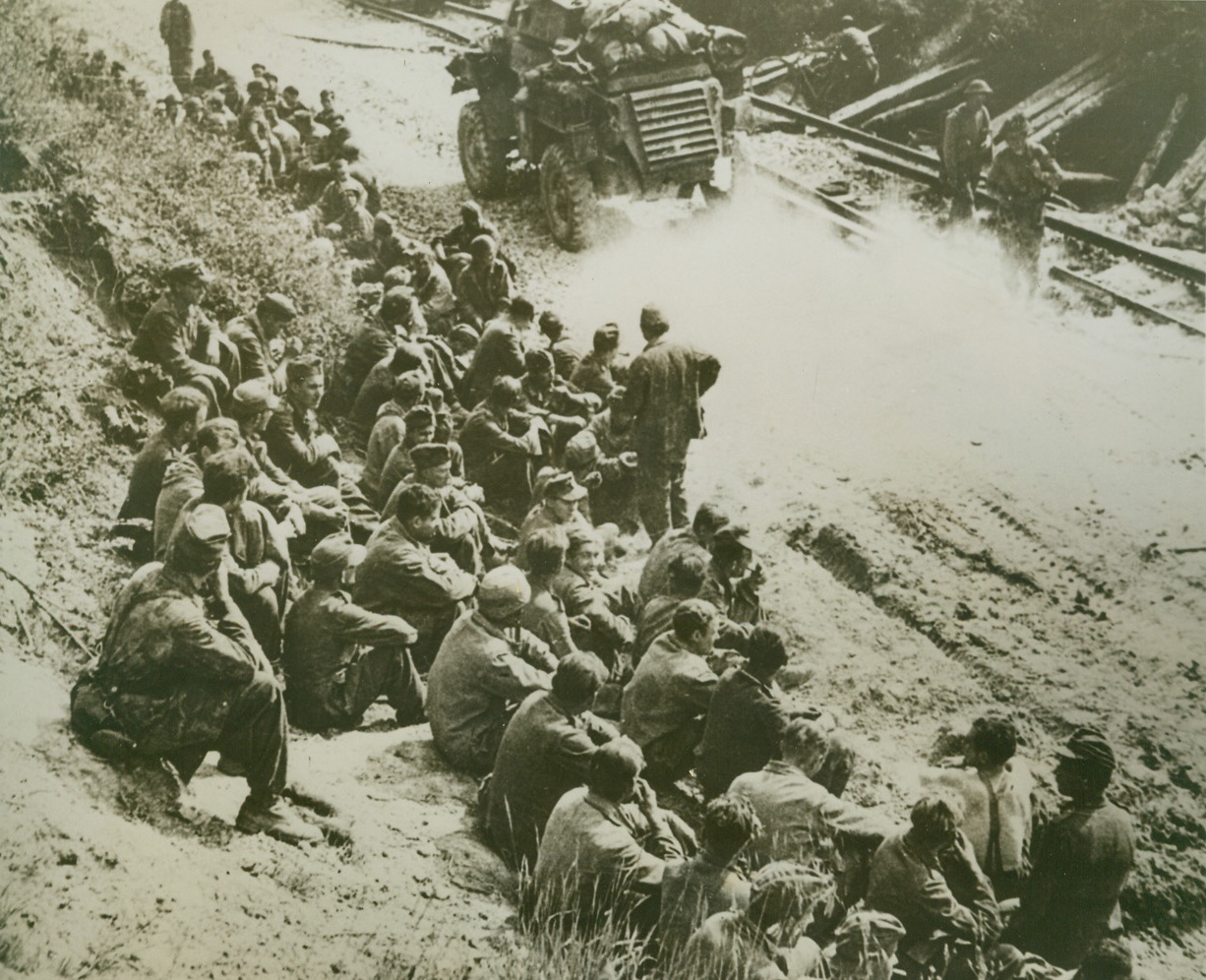
Nazis Get Time Out, 5/25/1944. ITALY – Unlike the infamous “March of Death” American soldiers captured in the Philippines were subjected to, these Nazi prisoners of war get a chance to rest along an Italian road as they are herded to the rear lines and PW compounds. Allied armored vehicles pass the Nazis on their way to reinforce the frontline troops. Thes prisoners are some of the huge haul taken in the early stages of the drive against the Gustav Line by the Allied Fifth and Eighth Armies.Credit-WP-(ACME);
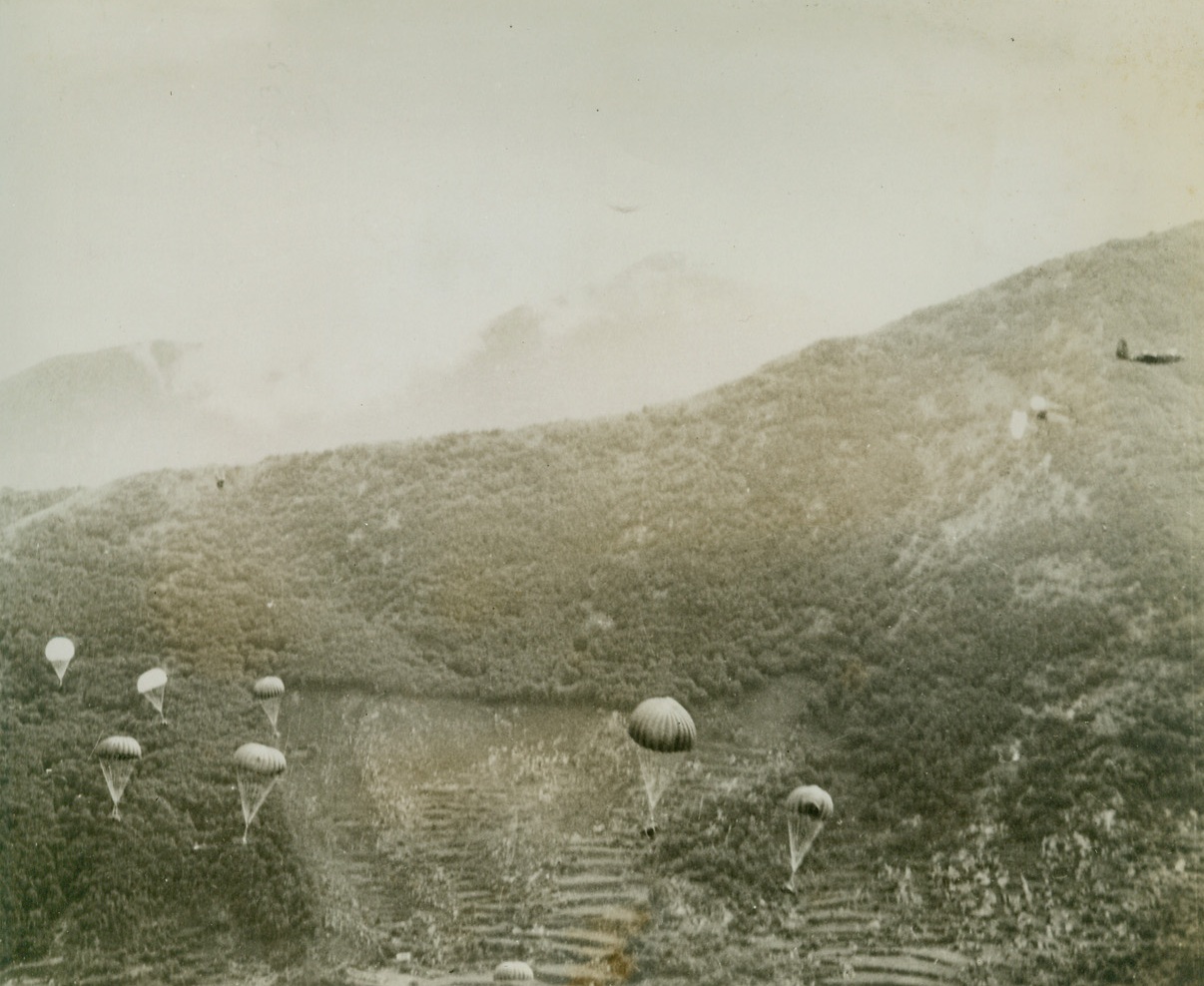
‘Chuting Supplies in Italy, 5/31/1944. ITALY – Allied troops fighting forward in the current push toward Rome, moved ahead in some parts of the Italian mountains so fast that mule trains with supplies and ammunition couldn’t keep pace with them. Here in a misty gorge, small parachutes are carrying down supplies brought to the fighting men by a-20’s of the USAAFCredit: USAAF PHOTO from ACME;
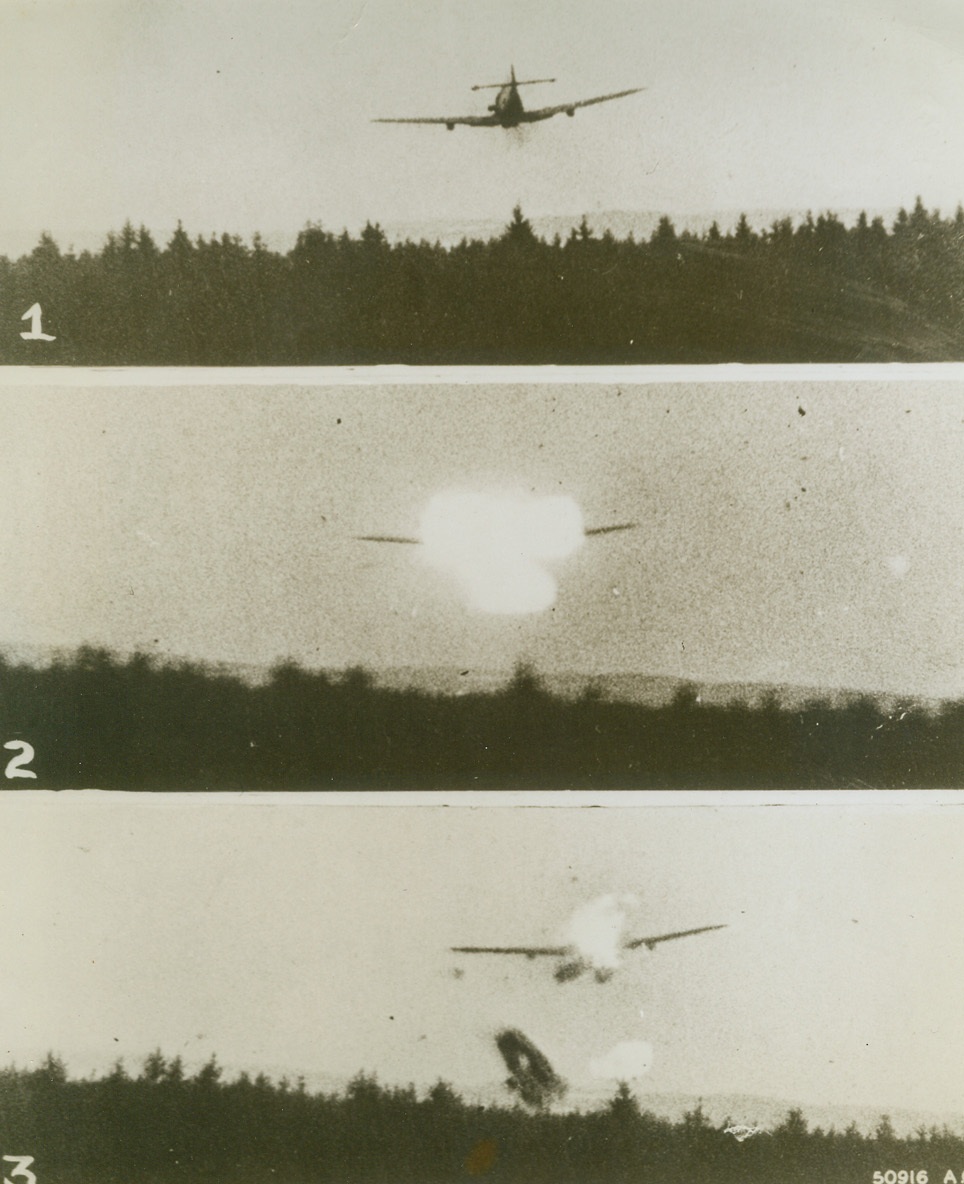
FIERY FINISH FOR NAZI, 5/24/1944. In these remarkable photos taken by the automatic camera gun of the attacking American fighter of the Eighth Air Force, a German ME-109 pursuit plane is shown meeting a flaming end under the guns of the Yank. At the top, the enemy plane roars along at treetop level in an effort to escape. Center, the ship bursts into flame as American guns register, and, at bottom the fiercely burning plane starts to disintegrate before crashing to earth.Credit: U.S. Army photo from Acme;
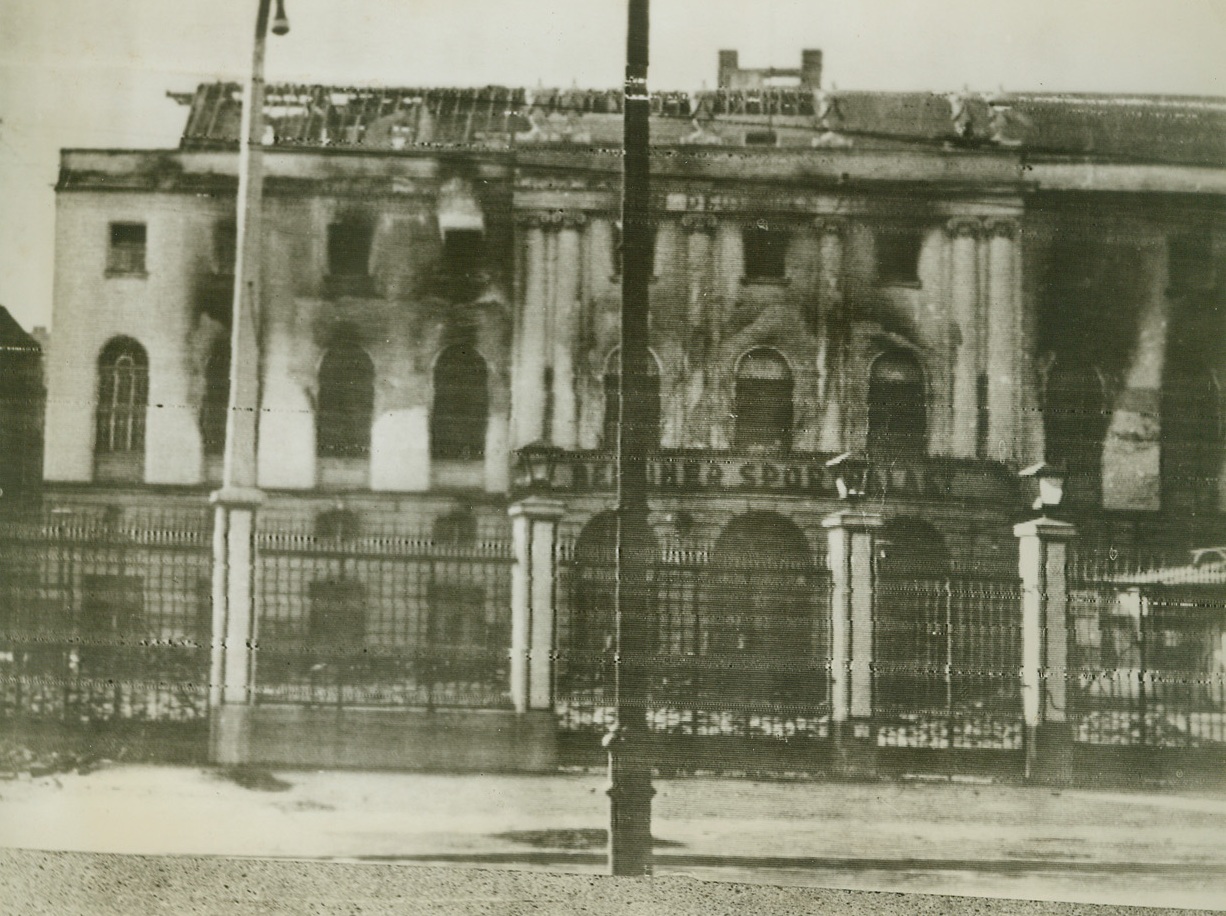
NO MORE HEIL-ING HERE, 5/19/1944. BERLIN, GERMANY—This photo, received by radio from a neutral source, shows the Berlin Sportpalast, home of the famous “Heil, Hitler” speeches, merely a shell left standing after a recent Allied attack on the German capital. It was in this stadium that the youth of Germany gathered to pay blind homage to their Paperhanger Dictator.Credit: Acme;
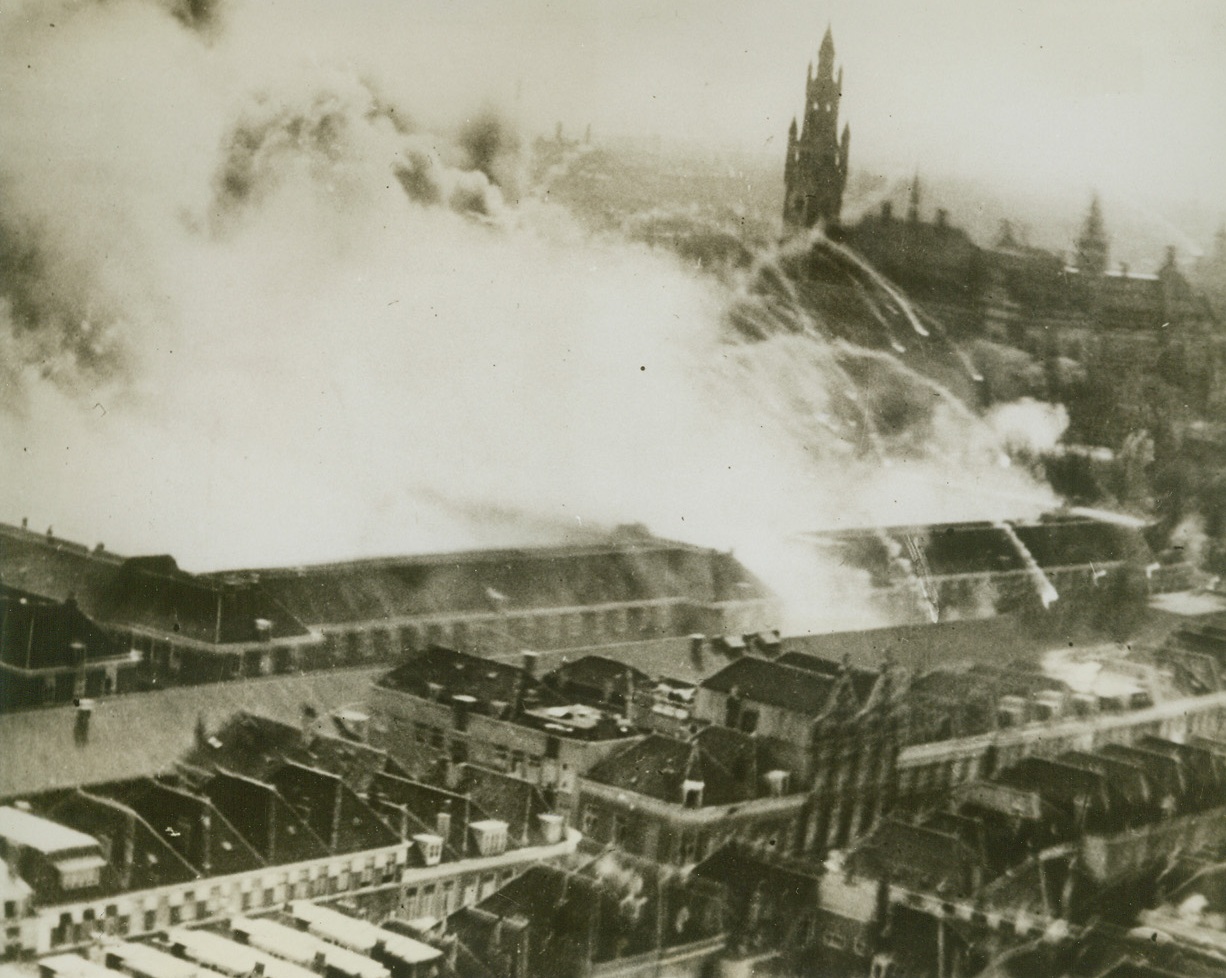
MOSQUITOES BOMB THE HAGUE, 5/9/1944. By pinpointing, attacking and destroying one particular building in the Hague, RAF Mosquitoes of the 2nd Tactical Air Force carried out one of the most spectacular attacks of this war. Many valuable German records were destroyed as a result of the raid. Here is a view of the attack, as the target area is enveloped in the smoke from bombs dropped by our aircraft. In background is the tower of the Peace Palace. Credit: British official photo from Acme;
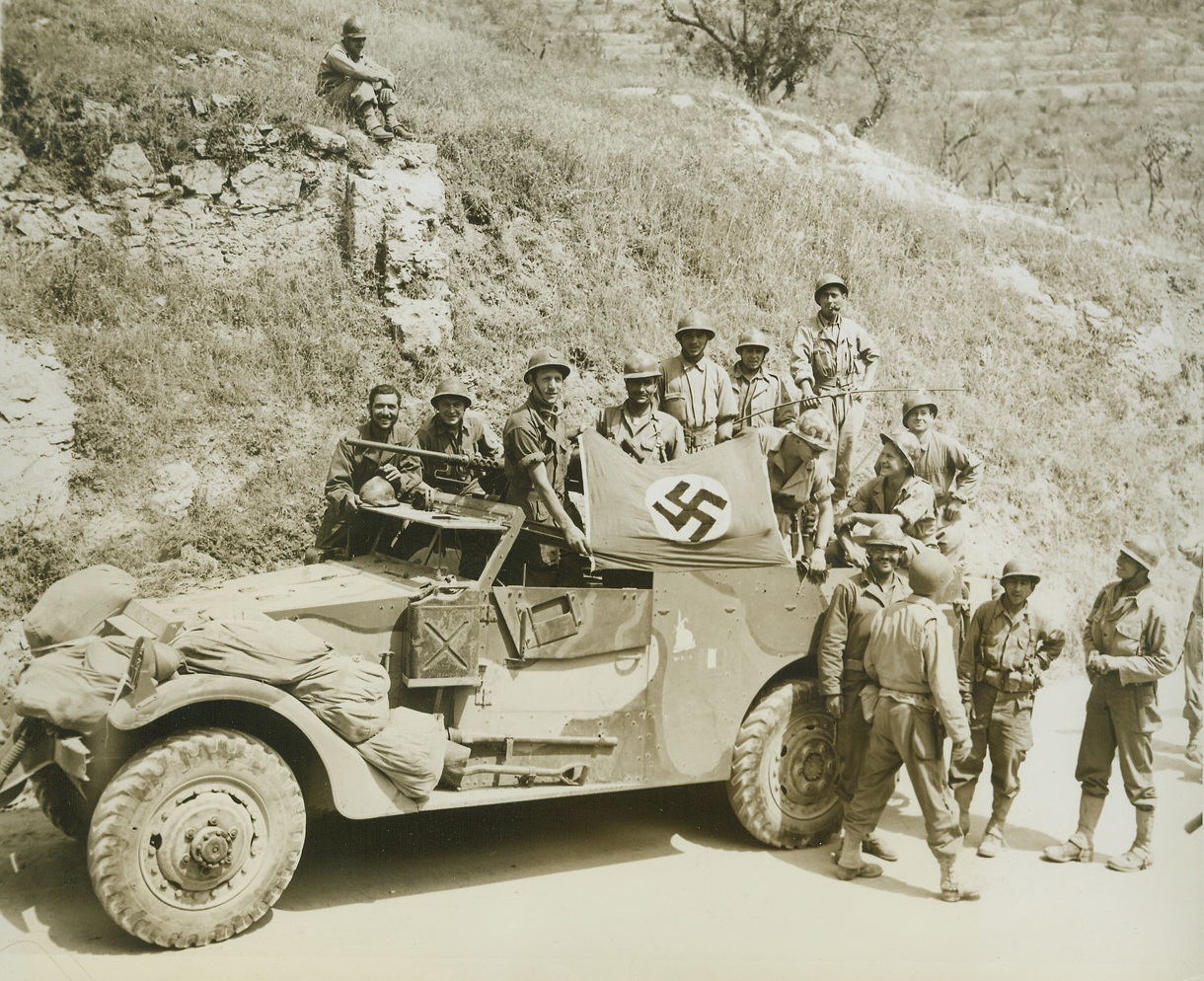
Sweet are Fruits of Revenge!, 5/23/1944. ESPERIA, ITALY—Smiling broadly, French infantry-men, who had seen their beloved country overrun by the Nazi horde, hold up a German flag they captured earlier in the day in the fighting reconnaissance car, and all of them wear U.S. equipment—all but their helmets, which they have retained as a badge of membership in the once-powerful Army of France. Credit: ACME PHOTO BY CHARLES SEAWOOD FOR THE WAR PICTURE POOL.;
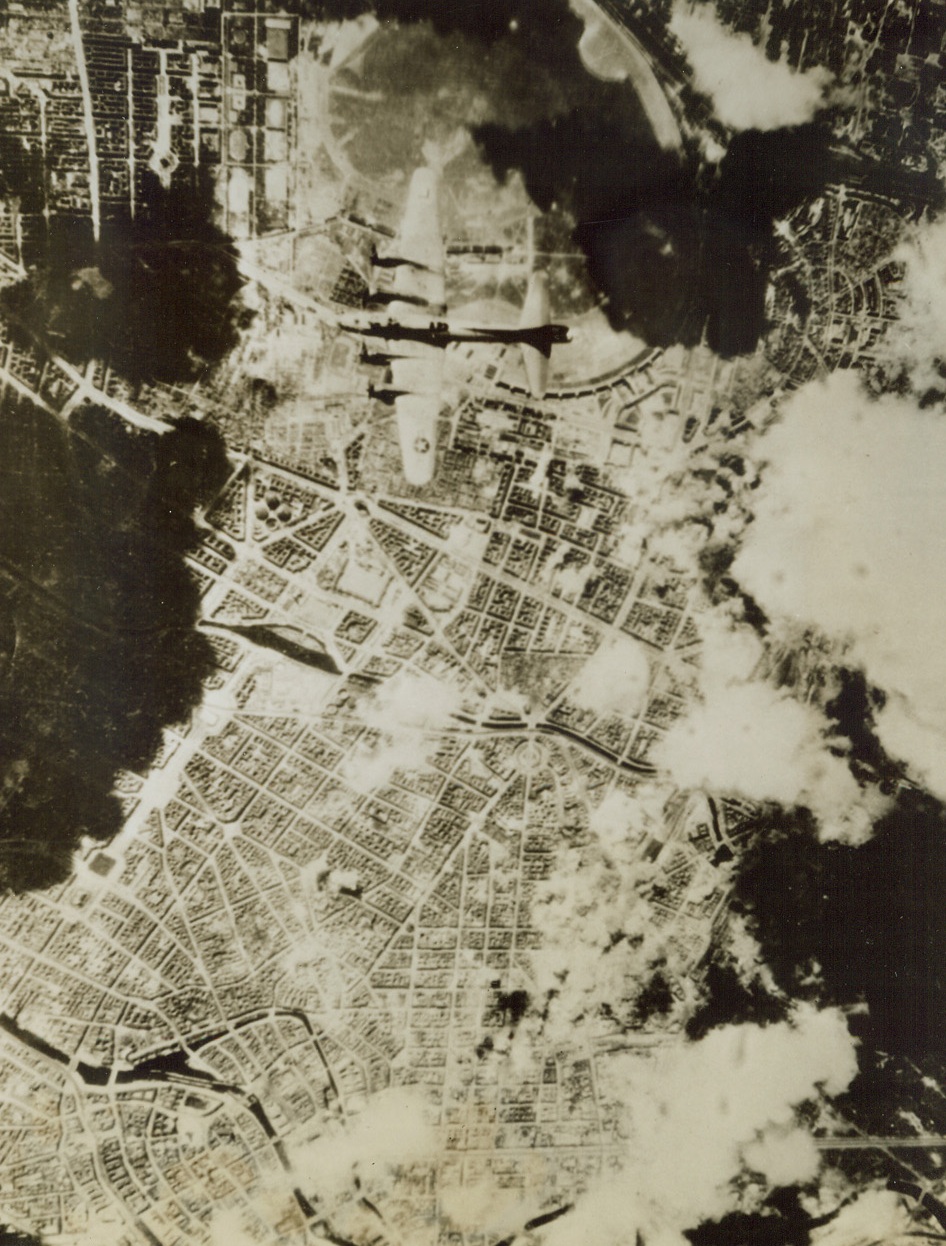
Berlin Blitzer, 5/7/1944. BERLIN-With bombs bursting below, a four-motored heavy bomber of the U.S. 8th Air Force wings its way through the skies over Berlin in the daylight attack of April 29th. At lower left clouds of black smoke rise from a direct hit on the Templehof Railway marshalling yards, while bursts can be seen on the Anhalter Railway station and tracks (center). The Templehof Airport is at right. Credit: ACME.;
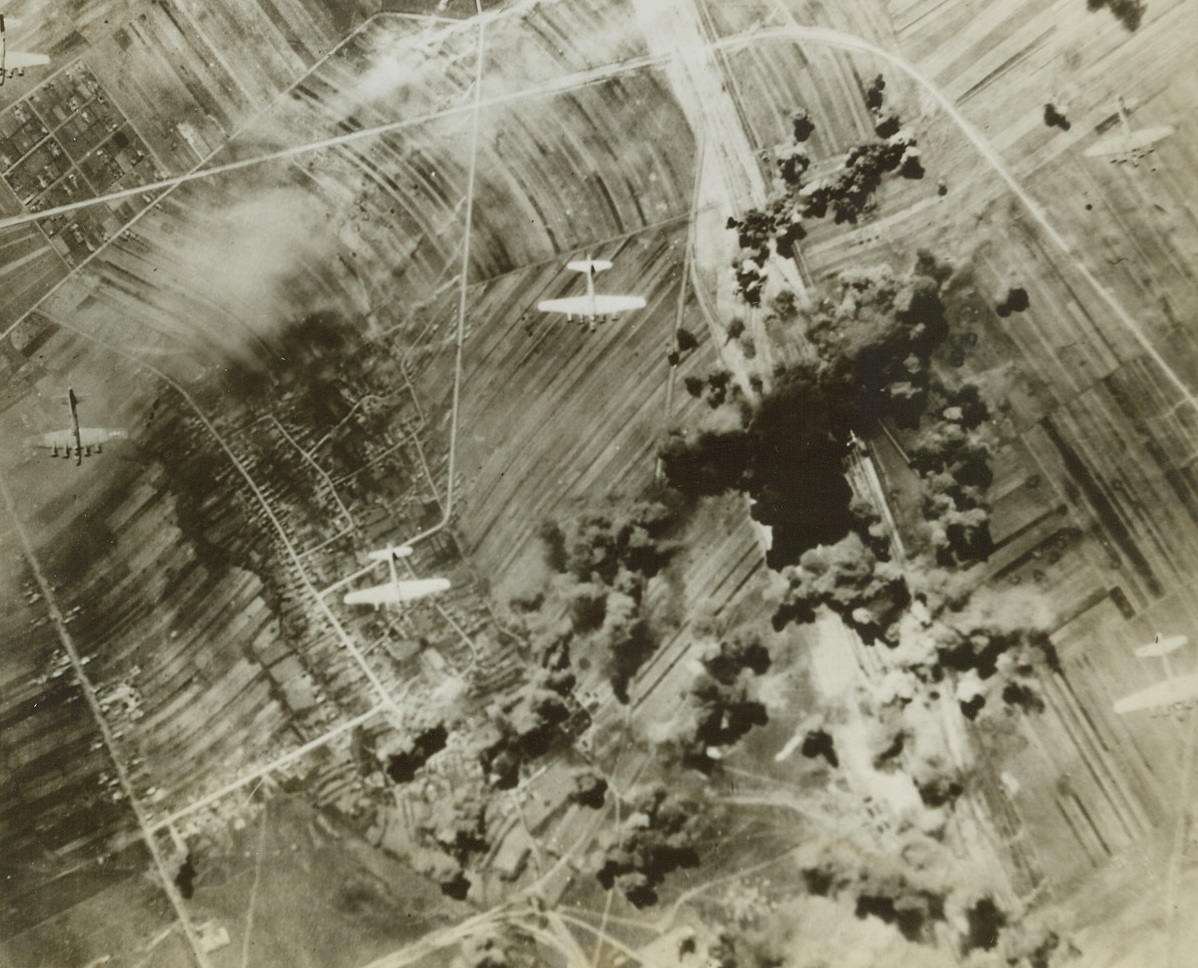
Ploesti Smashed Again by U.S. Airmen, 5/6/1944. PLOESTI, ROMANIA—Stepping up their non-stop pace in air offense, the Allies again hit the railroad marshalling yards at Ploesti and here Allied bombers wing over their target, leaving explosions and fires in their wake. The Flying Forts, based in Italy, were playing an early return engagement on the oil center which they attacked heavily not long ago. It appears that the Allies’ aim is to cripple German transportation and supply facilities as much as possible before the dawn of “D” day. Credit: OFFICIAL AAF PHOTO FROM ACME.;
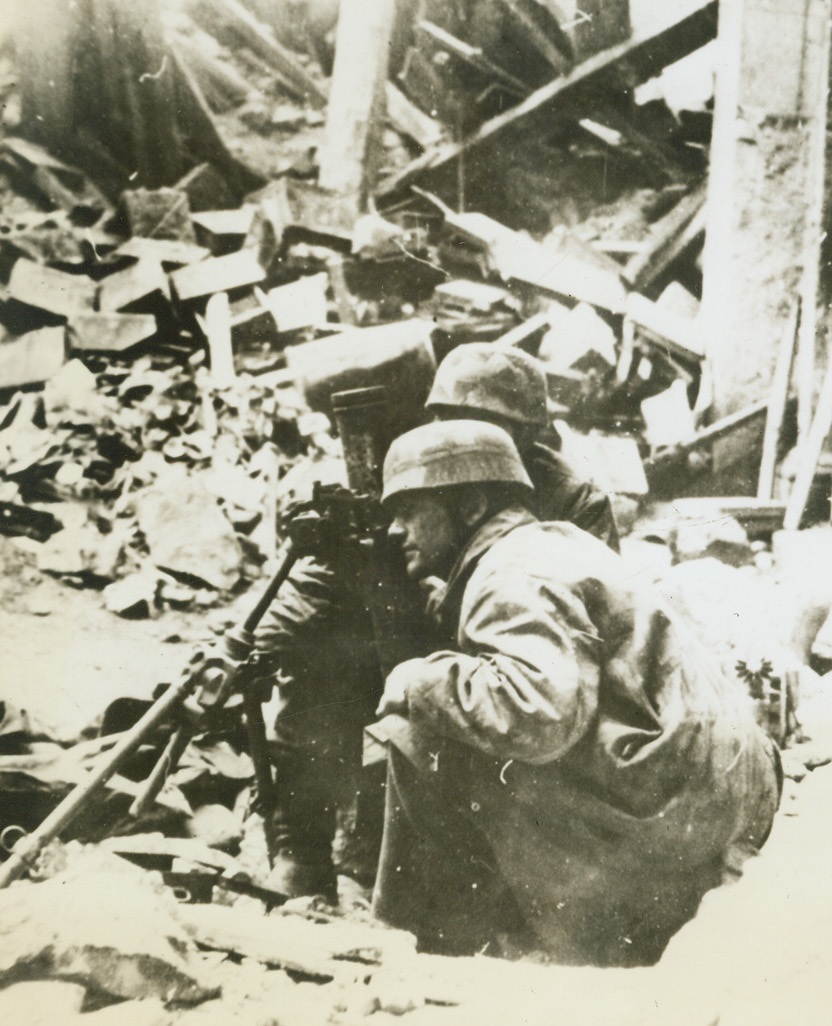
Nazi Paratroopers “Gunning” in Italian streets, 5/5/1944. CASSINO, ITALY—The caption accompanying this German photo, received in the U.S. through Sweden and London, describes it as showing German paratroopers manning a mortar gun during street fighting in the Cassino convent area. Note the ruined buildings which completely surround the gun nest. Credit: ACME.;
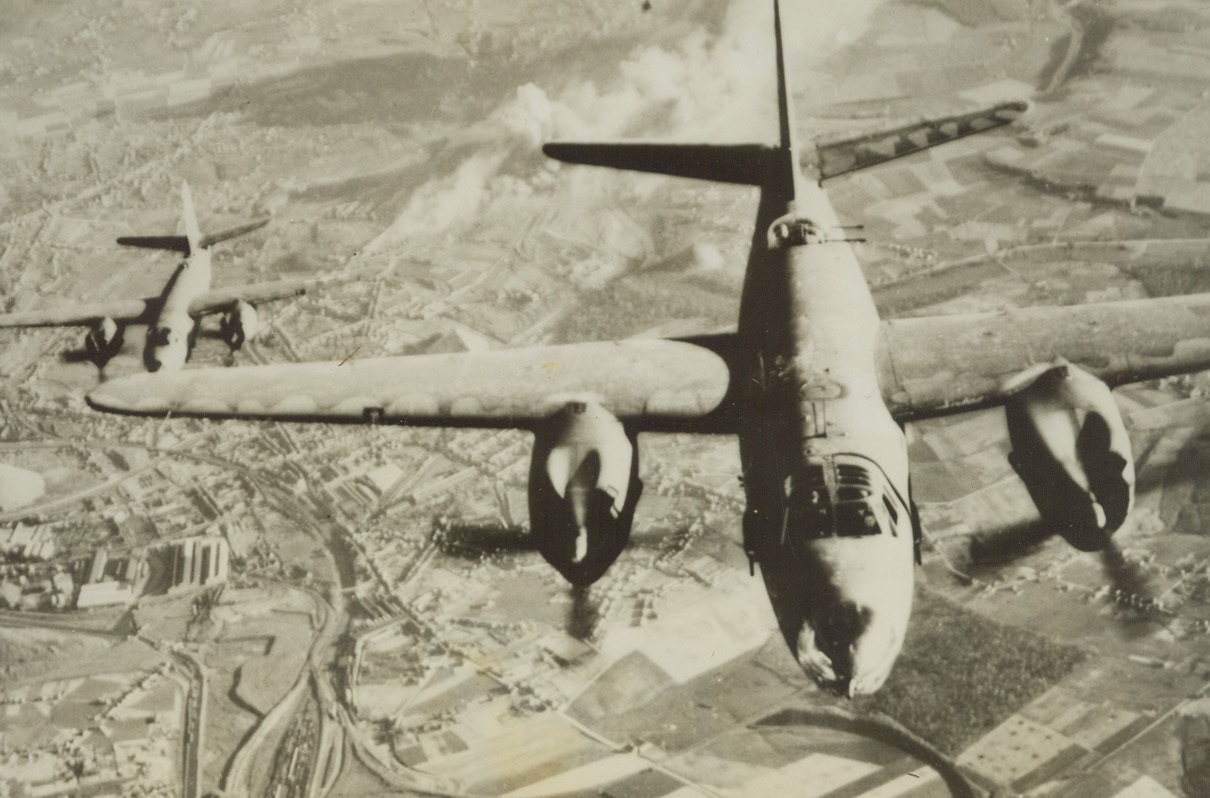
Bomb Belgian Rail Yard, 5/12/1944. BELGIUM—B-26 Marauder bombers head for home after a successful bombing tour of the railway yard and power station at Charleroi, Belgium, 30 miles south of Brussels. Yesterday medium bombers like these hammered Nazi coastal fortifications in France and Belgium. Allied bombers have blasted the invasion coast for 27 consecutive days—crippling the Nazi transportation system. Credit: US ARMY PHOTO FROM ACME.;
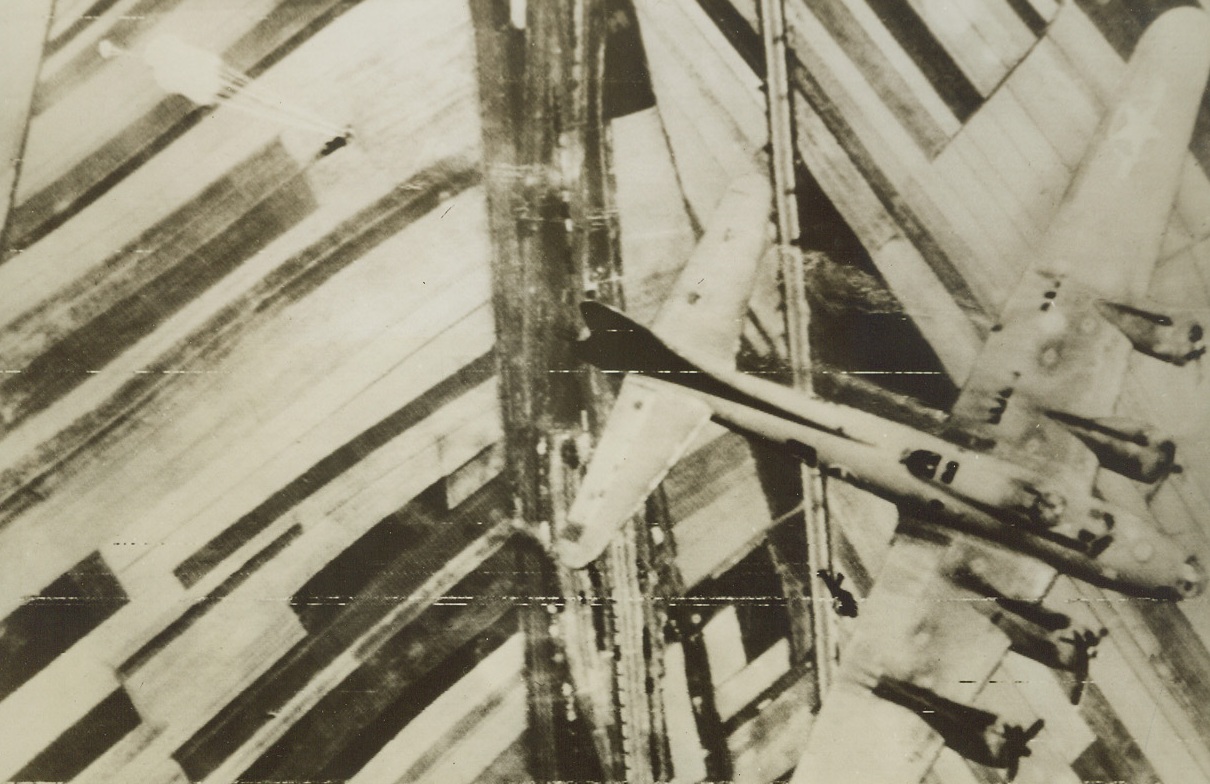
Yanks ‘Chute to Safety, 5/13/1944. WEINER NEUSTADT, AUSTRIA—Their ‘chutes of this crippled B-17 bail out over Weiner AAF bombed the aircraft assembly plant on May 10th. Shortly after this picture was made, the rest of the crew “hit the silk” and the plane exploded. Credit: U.S. ARMY RADIOTELEPHOTO FROM ACME.;
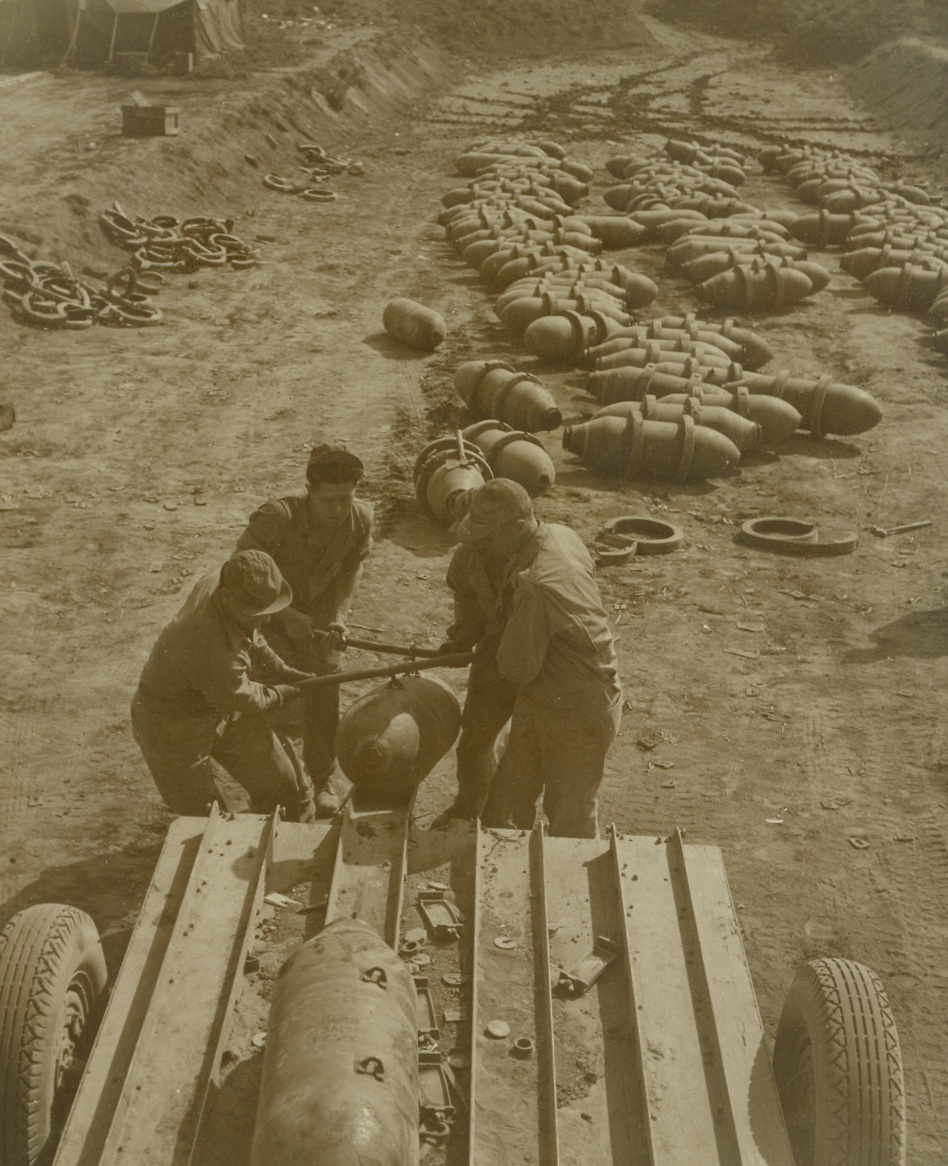
Headed for Hitlerland, 5/11/1944. ITALY—The work of the Air Force Service Groups often go unheralded but they keep Allied aircraft in the air and hitting at the enemy. Nobody, however, appreciates their service more than the men who fly the planes they repair and sometimes maintain. Here, at an USAAF base in Italy, bombs are started on their journey of destruction aimed at Hitler. Credit: ACME photo by Charles Seawood, War Pool Correspondent.;
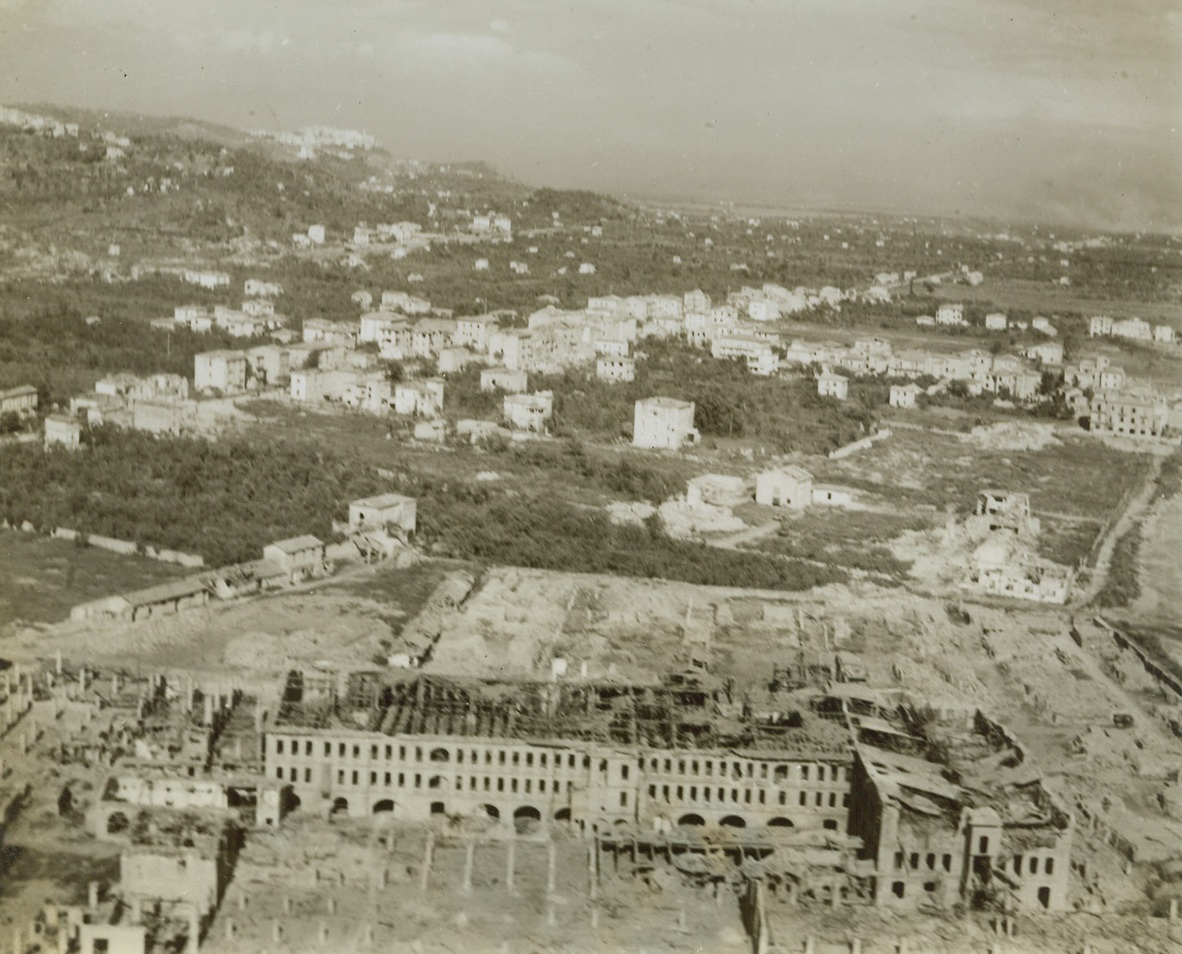
A Peaceful Town that Was, 5/25/1944. ITALY—Marked by the signs of battle, the Italian town of Scari presents a tragic picture just a few hours after Fifth Army troops entered the town. Yesterday, just one hour after dawn, the Allies struck their expected blow from the Anzio beachhead, to start the final battle for Rome. Credit: ACME photo by Charles Seawood, War Pool Correspondent.;
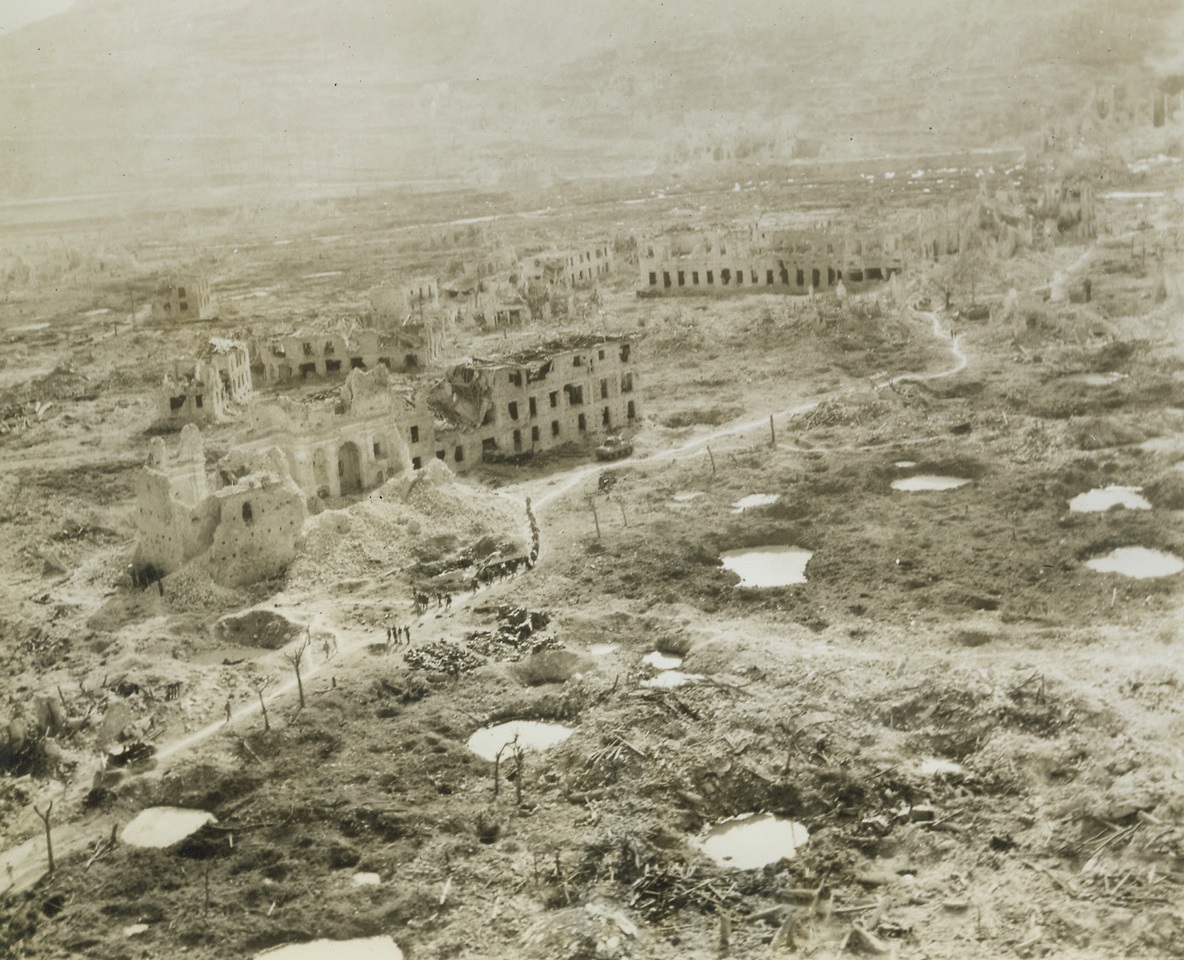
Ghost Town, 5/24/1944. CASSINO, ITALY—Here’s the entrance to Cassino from Route 6. The first building at the left in a bombed-out, while others are not identifiable. Only broken walls remain after virtually a four-month siege during which time countless rounds of artillery fire were poured into the town and thousands of tons of bombs were dropped on the German stronghold of the Gustav Line. Credit: ACME photo by Charles Seawood, War Pool Correspondent.;
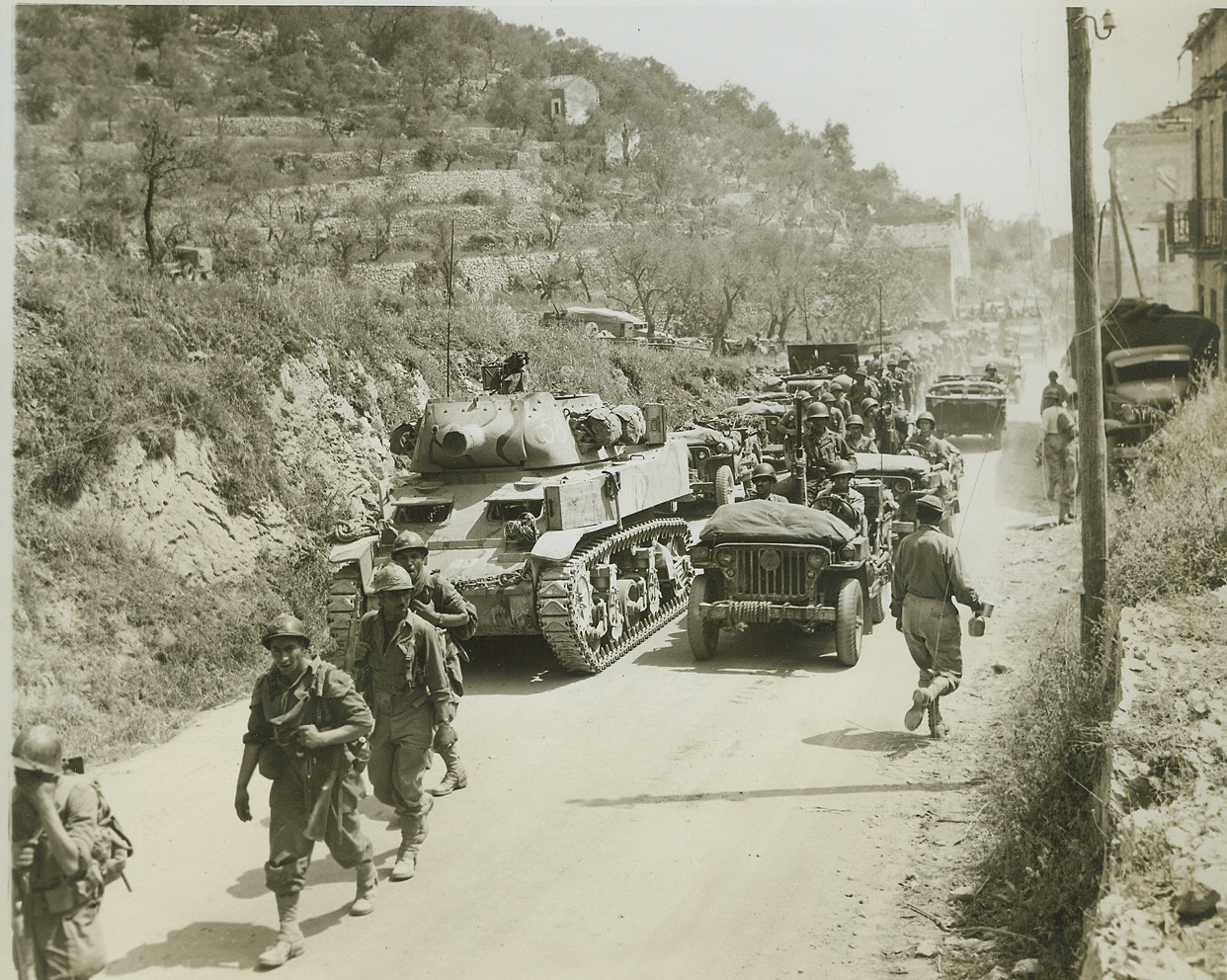
One-Way Traffic – to the Front, 5/23/1944. Esperia, Italy – French infantrymen of the Allied Fifth Army, (left, foreground), march along a road toward Esperia ahead of a long line of Fifth Army vehicles, after the Allies had smashed through the Gustav Line in Italy. Today, Americans on the Anzio beachhead began a smashing offensive synchronized with a renewed attack on the Hitler Line by troops of the Fifth and Eighth Armies. Credit: (ACME Photo by Charles Seawood for the War Picture Pool);
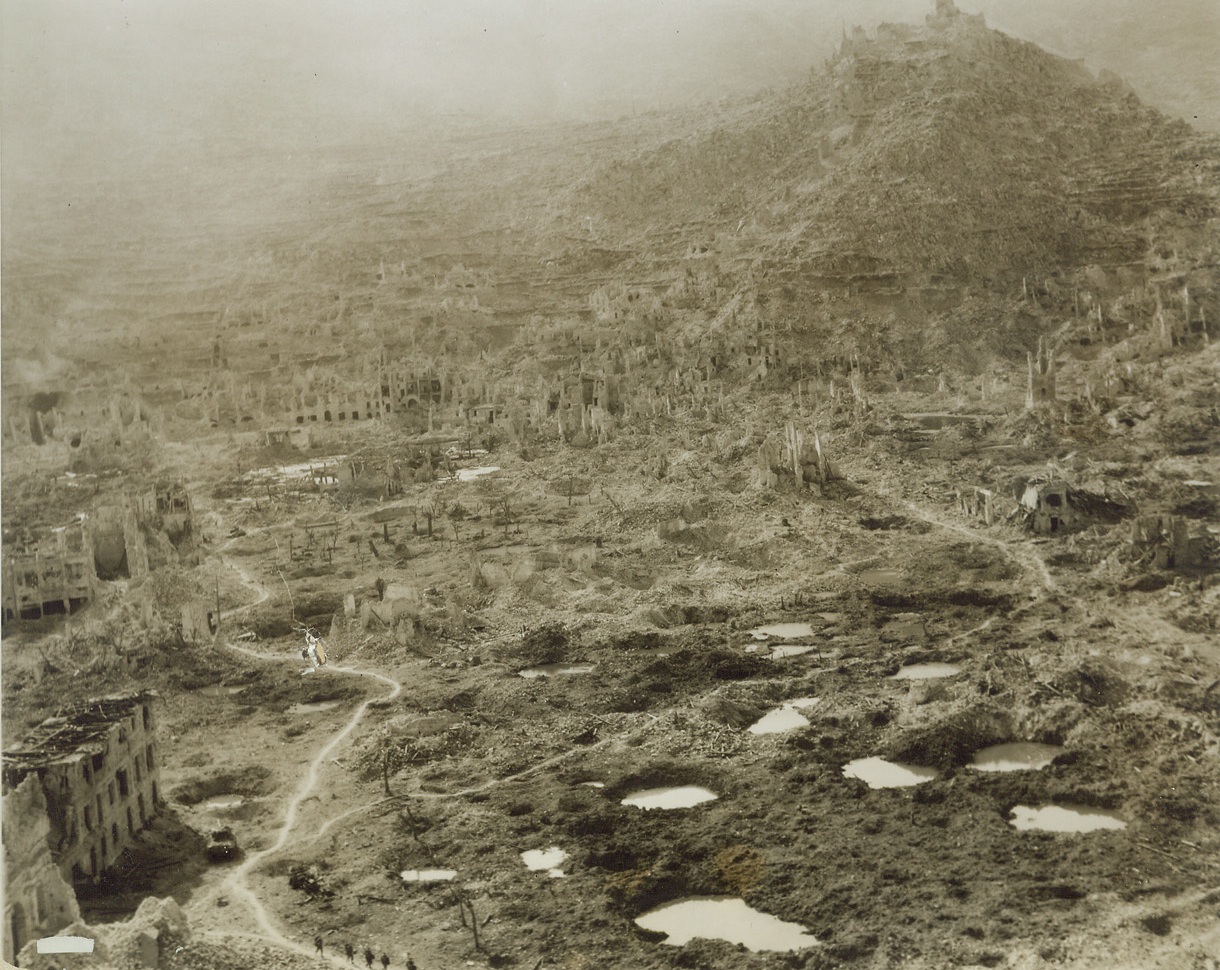
Ghost Town, 5/24/1944. CASSINO, ITALY—Here’s a view of the best part of the town of Cassino—“best” meaning that part least damaged by artillery and air power. In these crumbling ruins the German defenders proved the lesson learned at Stalingrad—that fire-power can kill a town but not its resistance. Crowning the crest of the hill at right is the famed Banedictine Monastery, used by the Nazis as a fort, which suffered the greater part of our concentrated barrage. Germans held out against the most powerful artillery fire in the Italian campaign, the greatest bombing raids and numerous infantry assaults until they were finally encircled by the Allies. Credit: ACME Photo by Charles Seawood, War Pool Correspondent.;
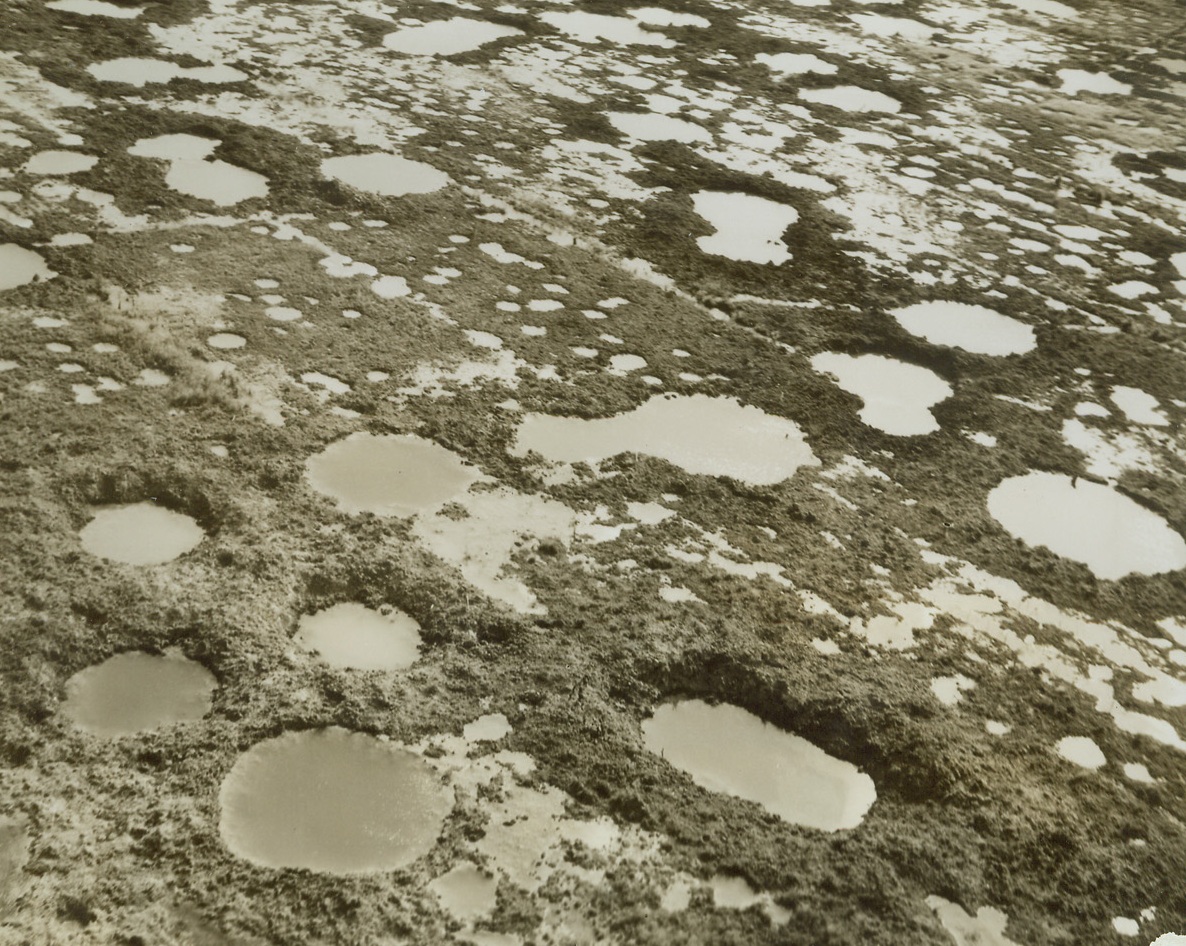
Raid Perimeter, 5/24/1944. CASSINO, ITALY—Closely-spaced bomb and shell craters dot the edges of Cassino. Many of them are markers of the great bombing raid that was designed to “fumigate” the town. Since these craters are really outside the town, they mark target misses. Credit: ACME Photo by Charles Seawood, War Pool Correspondent.;
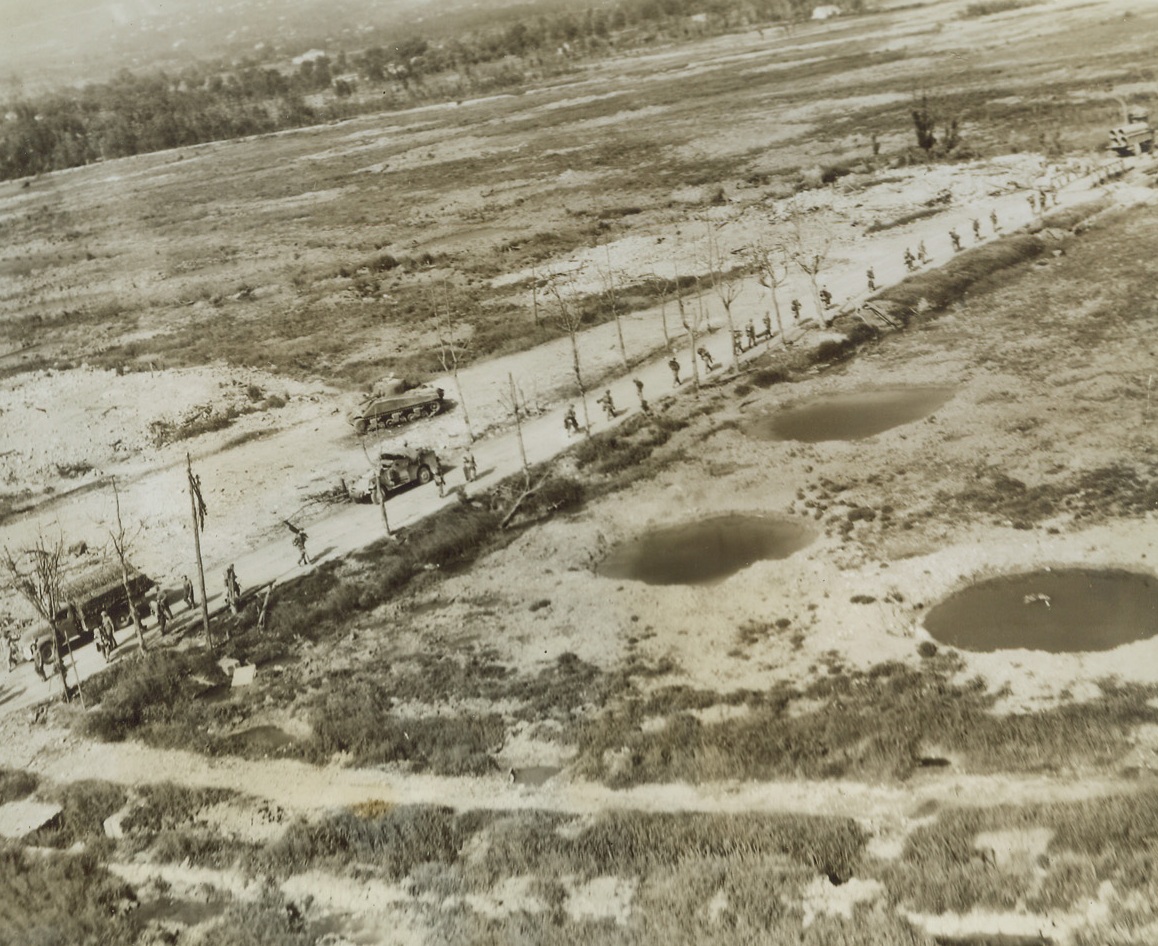
Their Job is Done, 5/24/1944. CASSINO, ITALY—South of the dead town of Cassino, British Infantrymen of the Eighth Army move back to the rear. Their job of cleaning out Cassino of all enemy resistance is complete. Credit: ACME Photo by Charles Seawood, War Pool Correspondent.;
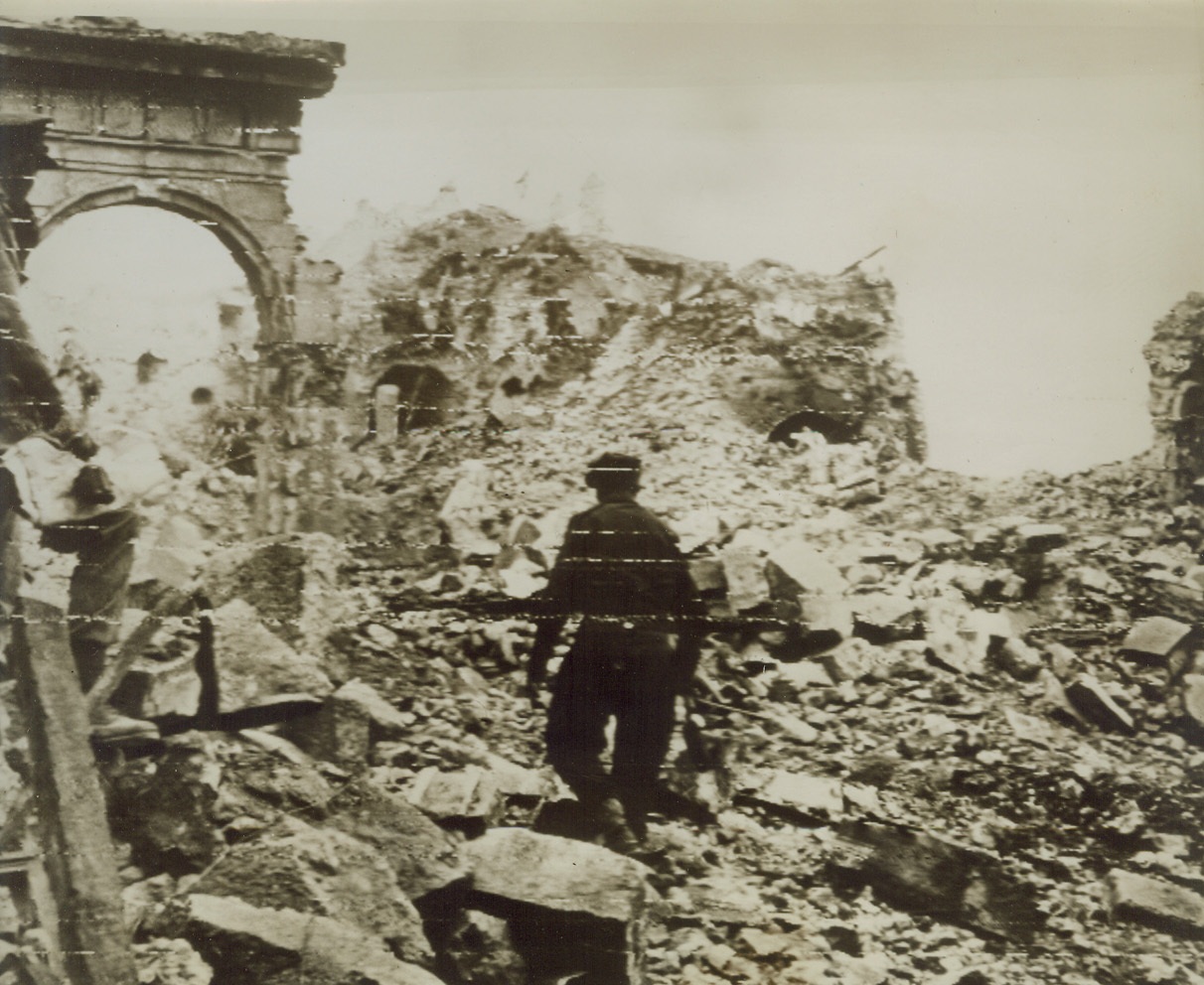
Ruins of Cassino Abbey, 5/24/1944. This photo, flashed to the U.S. by Radiotelephoto today, shows an Allied Eighth Army soldier carefully making his way through the shattered ruins of the once-beautiful Benedictine Abbey on a mountain top overlooking the city of Cassino, Italy. The Abbey were Germans emplaced heavy guns to fire on the Allies besieging Cassino, has been the scene of some of the bitterest fighting of the Italian Campaign. It was blasted by tons of bombs from USAAF planes, and shattered by Allied Artillery shells until only a heap of rubble remains. Credit: ACME photo via ARMY RADIOTELEPHOTO.;
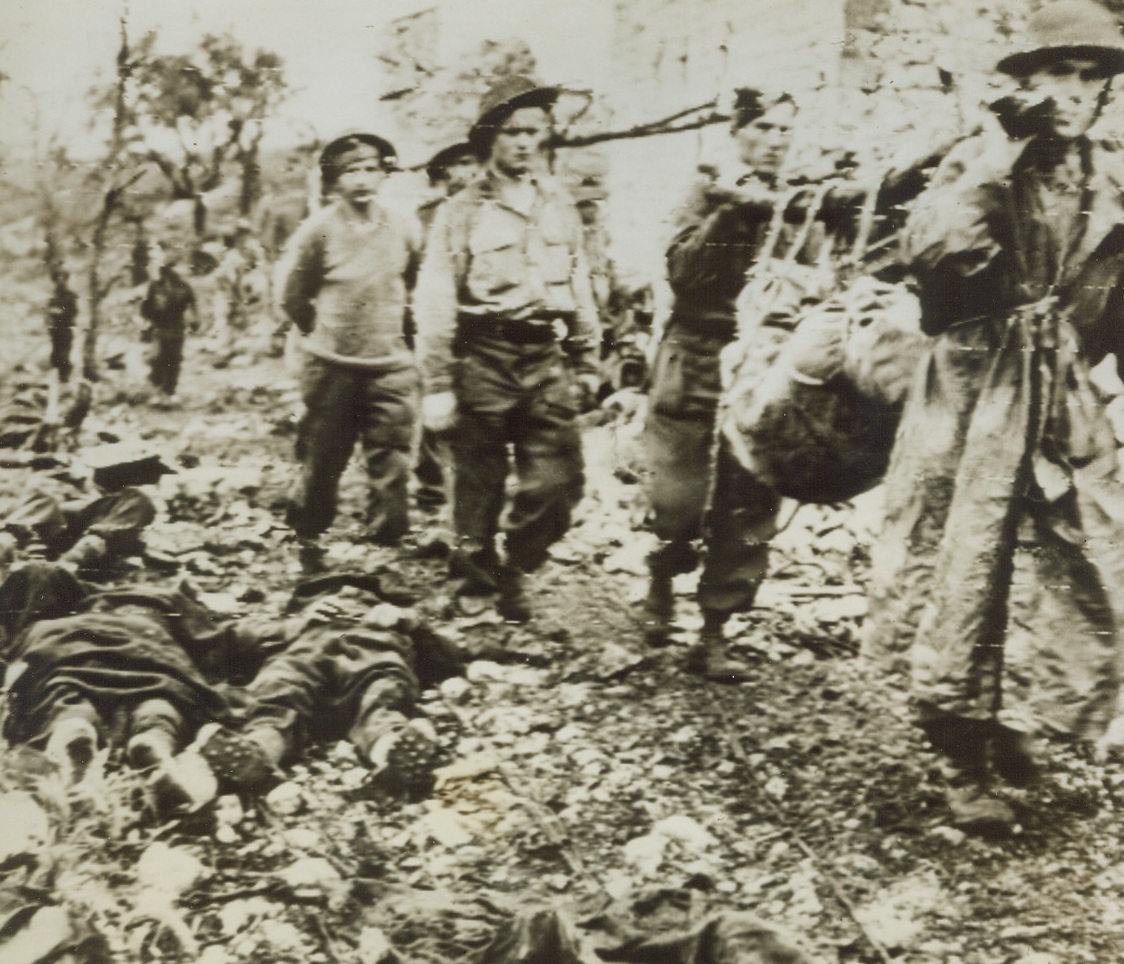
Gallant Poles Collect Their Dead, 5/24/1944. CASSINO, ITALY—After the capture of the long besieged Benedictine Monastery at Cassino by troops of the Allied Eighth Army, these Polish soldiers who fought the gallant fight with the Allies, sadly collect their comrades who were killed in the bitter and bloody battle. Here, they carry dead in from the field to a collecting point for burial. Today, Canadian troops of the Eighth Army smashed a gaping hole in the Adolf Hitler line between Pontecorvo and Aquino. Credit: U.S. ARMY RADIOTELEPHOTO FROM ACME.;
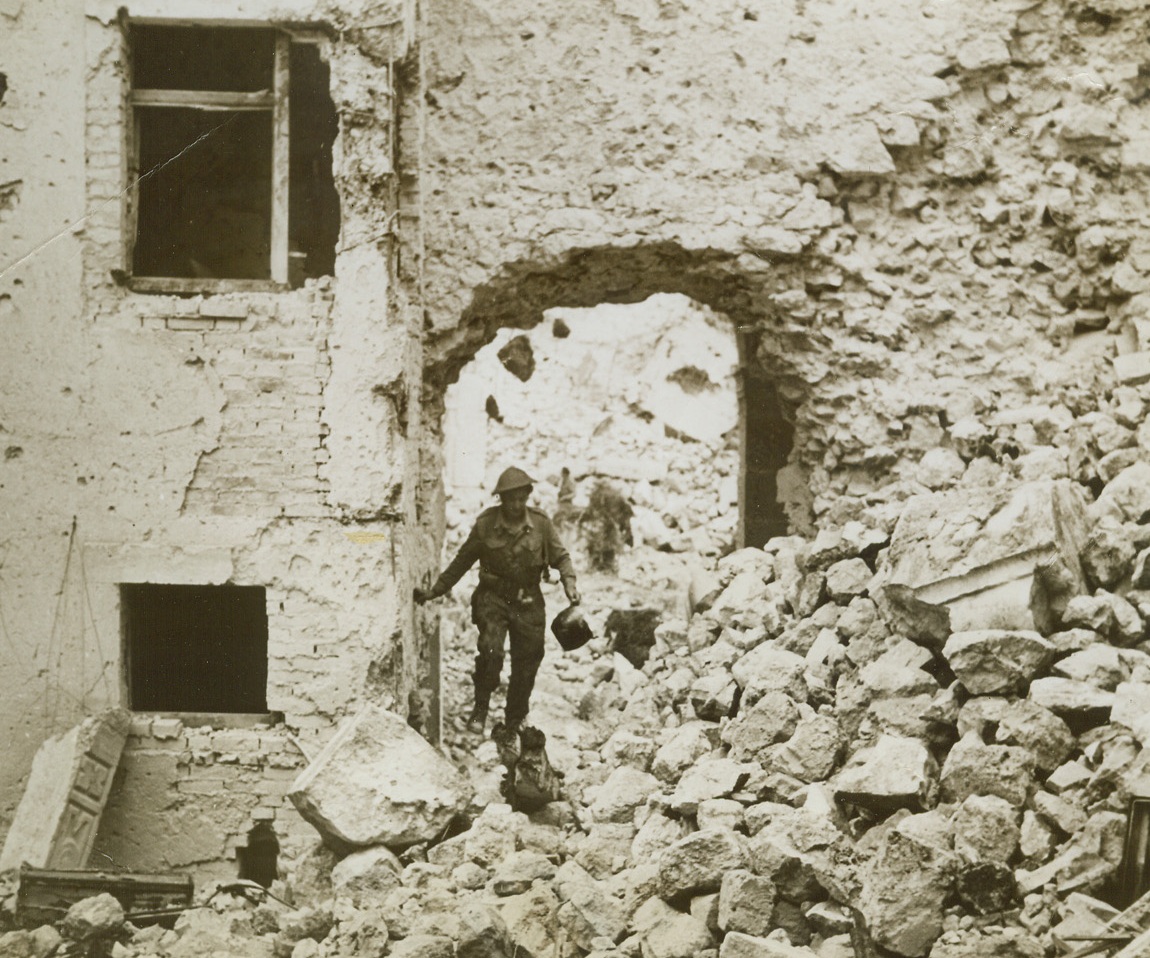
Only Rubble Remains, 5/25/1944. CASSINO, ITALY—The crumbled walls of the ancient Benedictine Monastery overlooking Cassino, torn down by intensive bombardment by Allied planes and long range artillery pieces, make the going rough for a fighting man who picks his way through the debris. Although the old house of worship was in ruins when captured by the Allies, our military leaders are confident that the building can be restored.Credit Line – WP- (ACME);
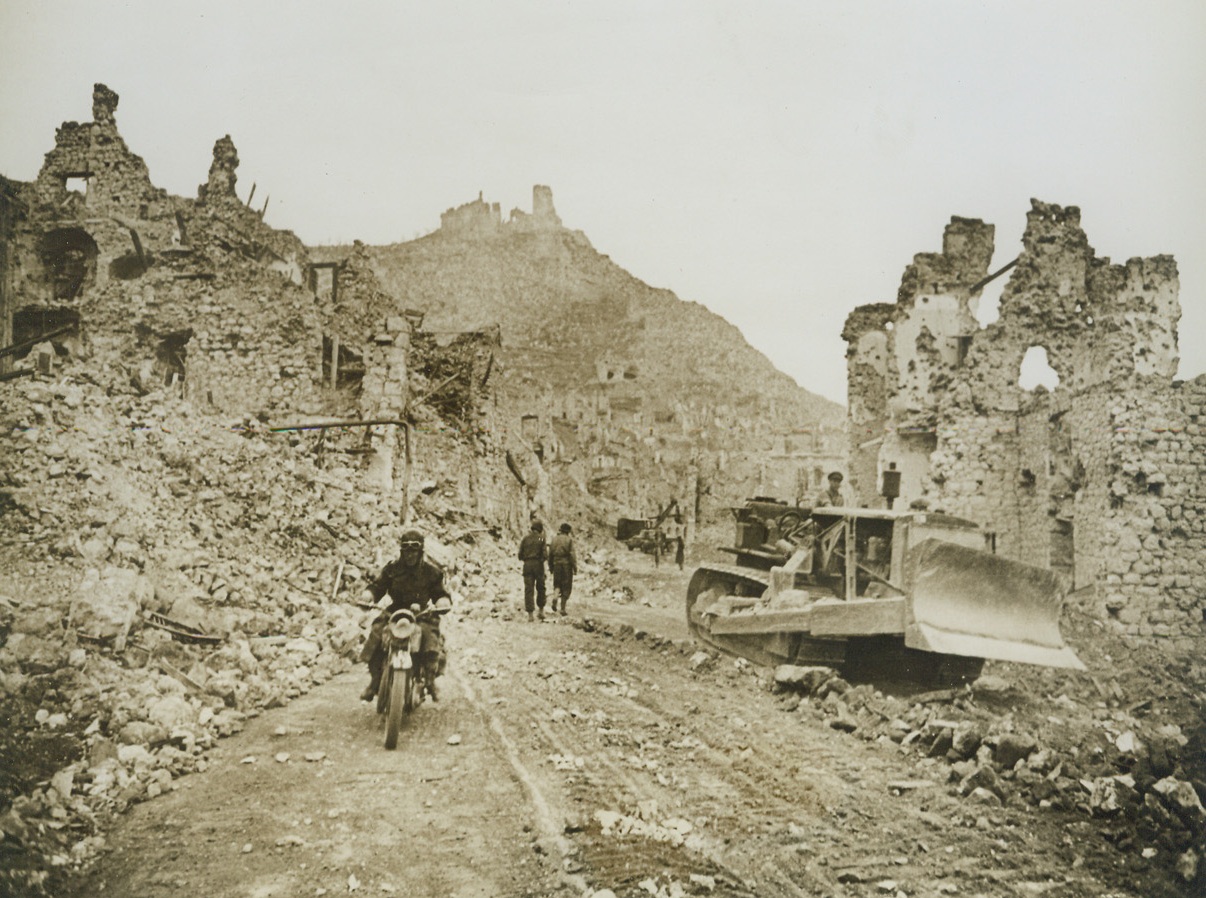
The Aftermath, 5/26/1944. CASSINO, ITALY—Allied bulldozers clear the road between the mountains of rubble that was once Cassino, as Army engineers work to repair the highway leading to Rome. The hotel des Roses, which housed German gun emplacements during the Allied siege, lies on the right, a mass of shattered wreckage. Hangman’s Hill, with the Benedictine Monastery atop it, lies in the background. All of the city, with the exception of the Monastery, has been declared “dead” by the Allies and no efforts are being made to rehabilitate it. Credit: ACME.;
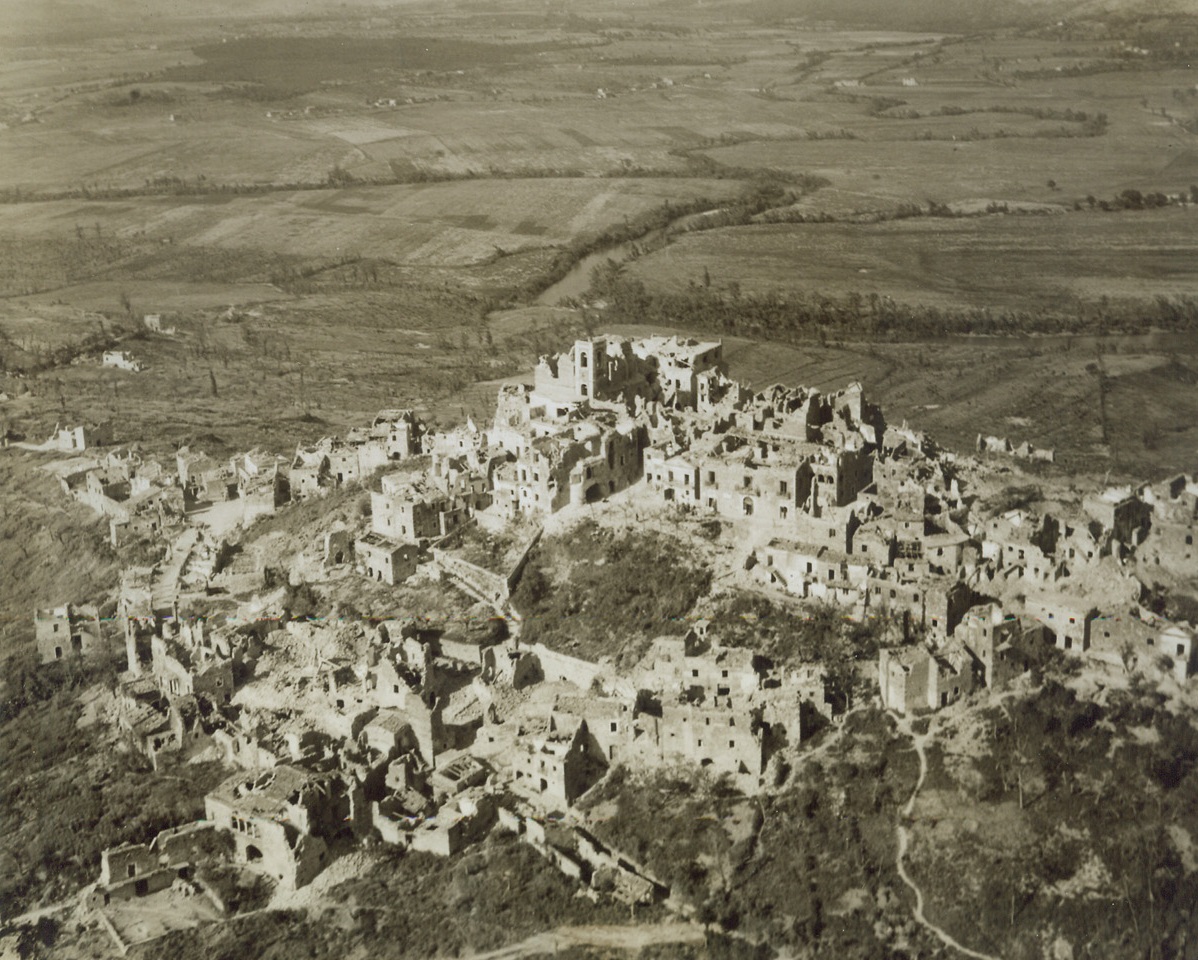
Marked by Allied Artillery, 5/25/1944. ITALY—The cluster of homes that was San Ambrogia remains just a shattered bomb-gutted town after a heavy barrage by Allied guns and planes. The town was taken by American troops of the Fifth Army as it continued its progress along the road to Rome. Credit: ACME Photo by Charles Seawood, War Pool Correspondent.;
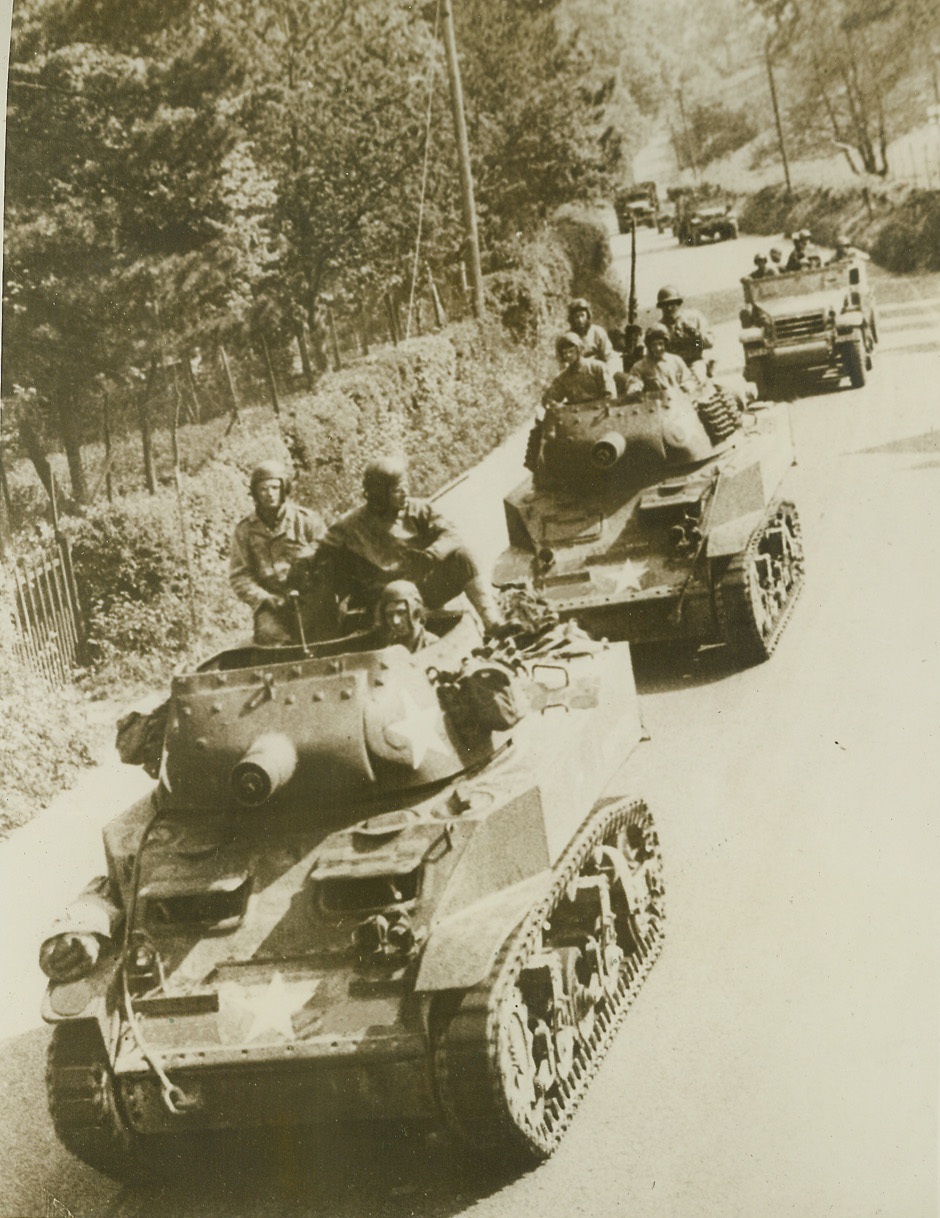
Move to Jump-off Positions, 5/22/1944. England – A U.S. army convoy winds its way along a country road in England to an unknown destination. Allied mobile might has been clogging the roads and lanes of rural England on the move from their bases possibly to points from which they will cross the Channel to play their parts in the liberation of Nazi-held Europe. Credit: (ACME);
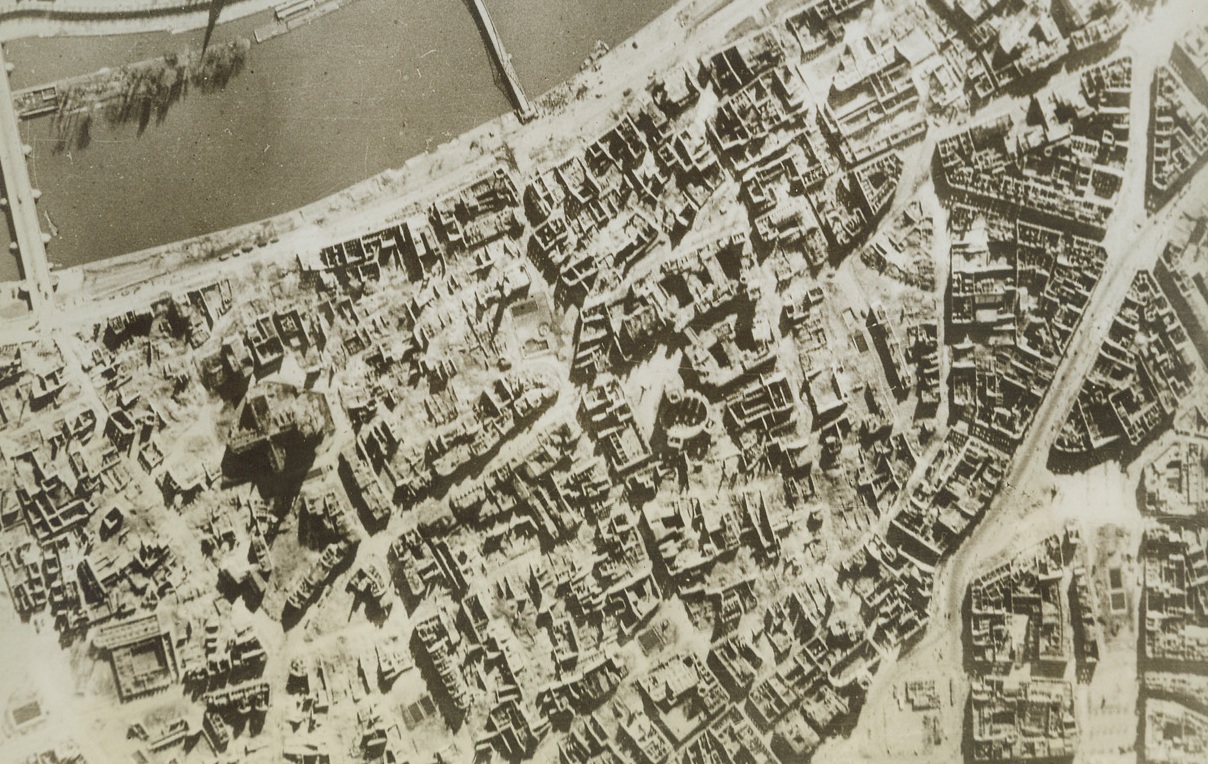
Devastated Frankfurt, 5/7/1944. FRANKFURT, GERMANY—Long one of Germany’s most important commercial cities and therefore an important target of Allied Air Force bombers, Frankfurt has suffered heavily at the hands of our air fighters. Shown shortly after the major daylight and night attacks by RAF Bomber Command and U.S. 8th Air Force planes between March 18th and 24th, the center of the city is almost wholly devastated. Although destruction is heaviest in this area, severe damage spreads eastward and westward to the industrial and commercial districts. Credit: ACME.;
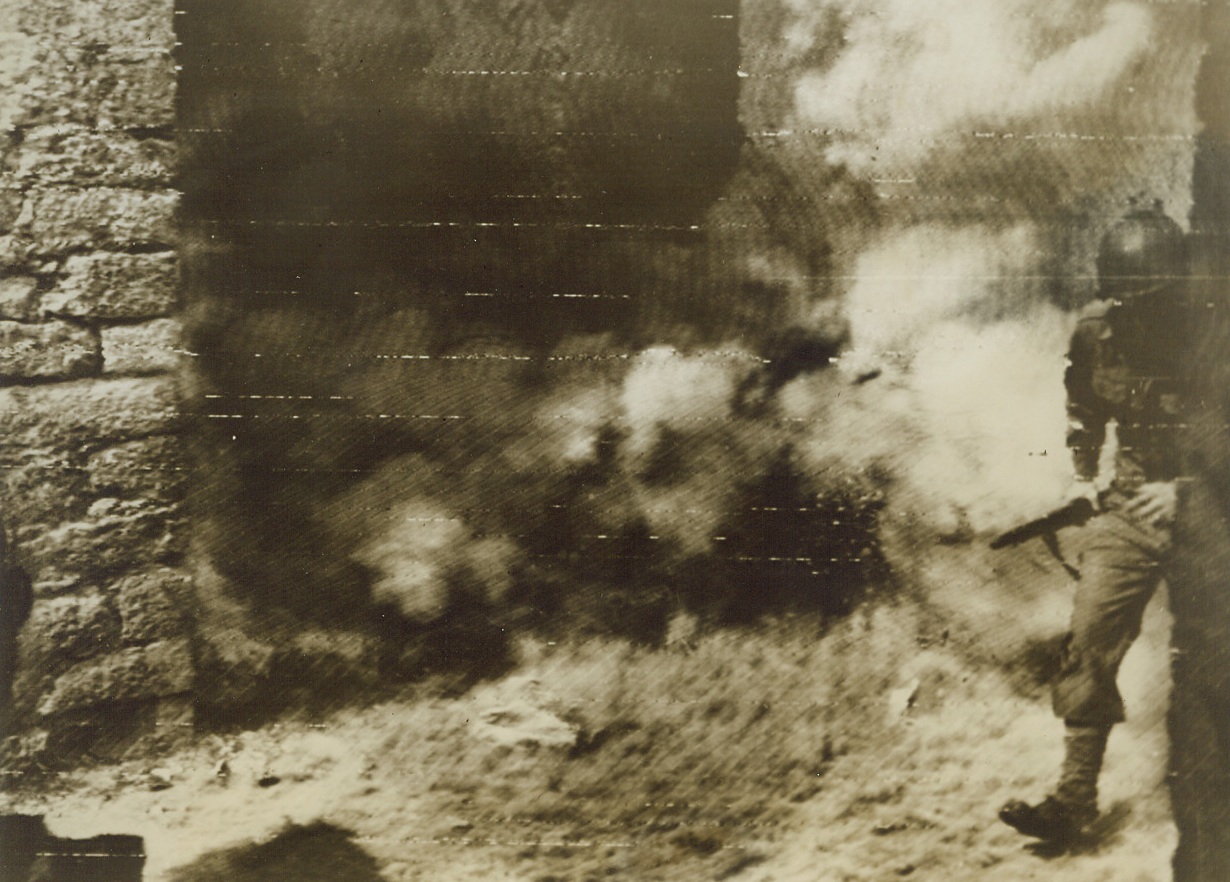
Rounding Corner to Trouble, 5/1/1944. ITALY—Rounding a corner in a narrow street of an Italian village while on daylight patrol, this American soldier runs into enemy mortar fire. The Yank was wounded by the shell exploding in the dust before he could take cover. Credit: U.S. ARMY RADIOTELEPHOTO FROM ACME.;
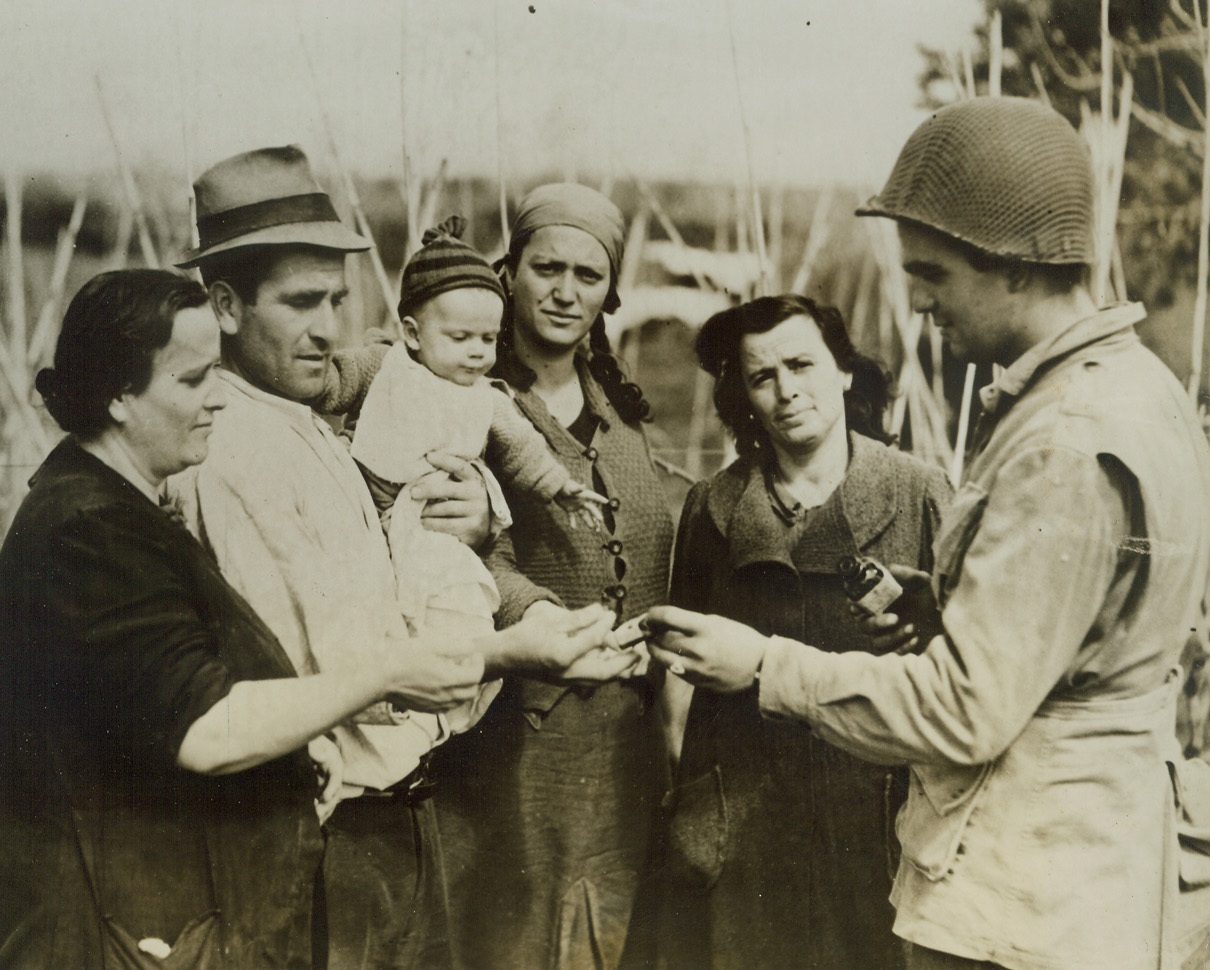
Malaria Prevention, 5/2/1944. ANZIO, ITALY—Teaching the natives the care and prevention of Malaria is one of the big chores of Allied troops in Italy. Here Pfc. Delmar Richardson of Fort Wayne, Ind., of the Medical Corps, explains the use of Atabrine in malaria prevention to a group of Italian Civilians. The natives are receiving a supply of the medicine from Richardson. Credit: ACME.;
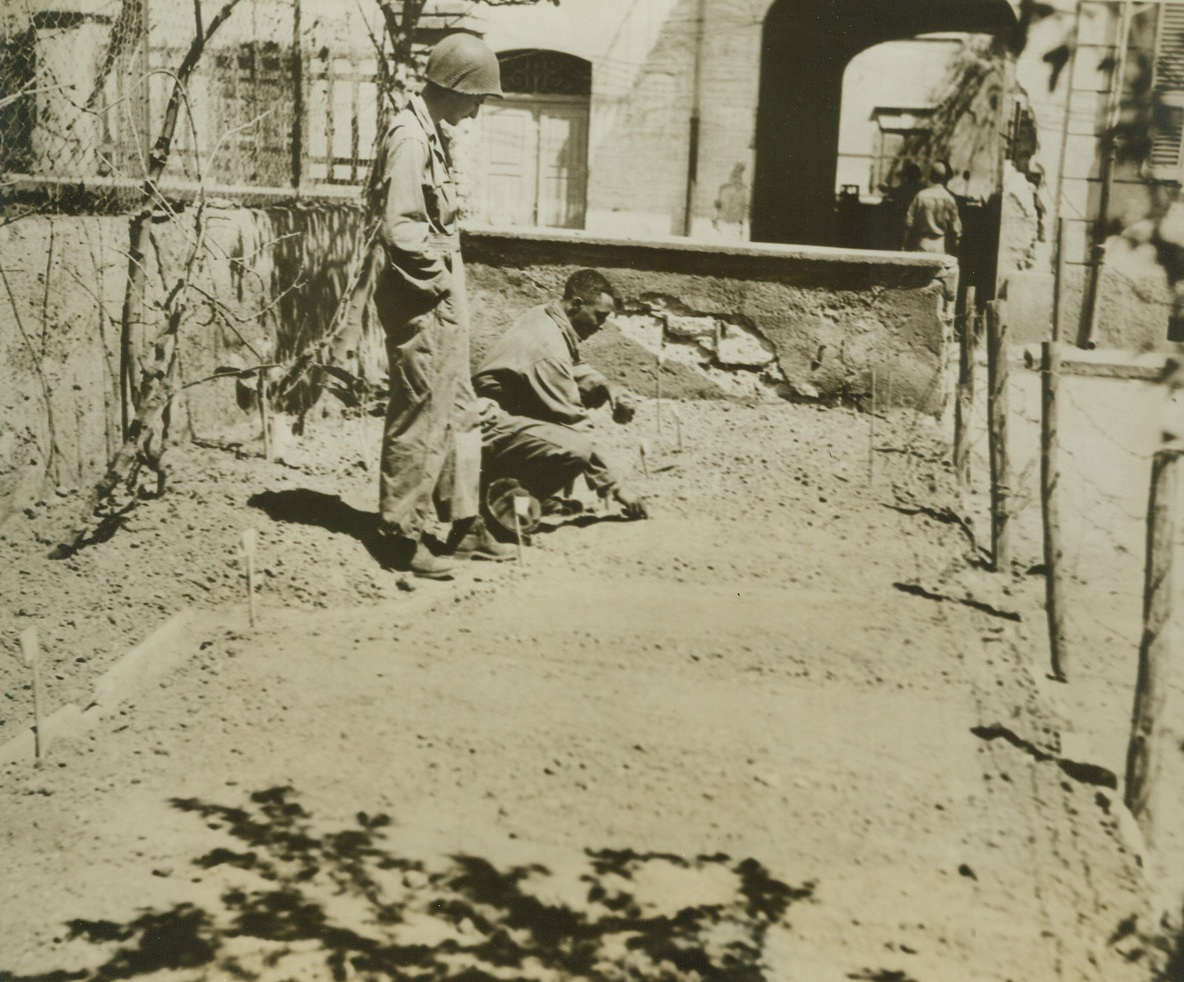
Victory Garden at the Front, 5/2/1944. ANZIO, ITALY—Digging in the dirt, planting seeds, and watching things grow is the pleasure enjoyed by these American soldiers at Anzio. It’s a lot different from digging fox holes and more fun. This is the only victory garden on the Anzio beachhead hand in it tomatoes, beans, and potatoes have been planted. Pfc. Richard C. Woodward, Oklahoma City, Okla., looks on while Sgt. George O. Edmonds, Charleston, West Virginia, does some planting.;
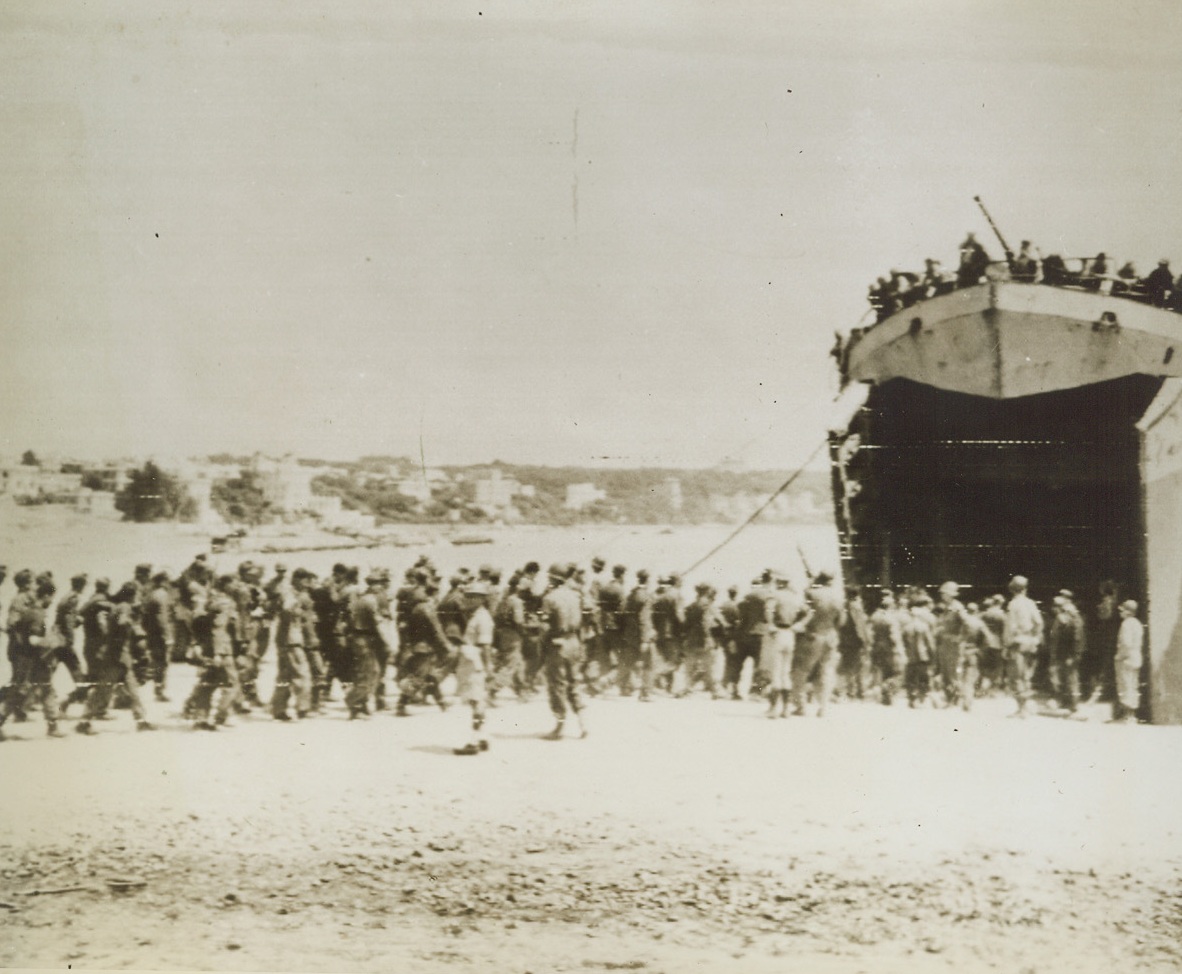
All Aboard for a POW Camp, 5/29/1944. ANZIO, ITALY—A long line of German prisoners from the Anzio beachhead tramp into the yawning mouth of an LST that will take them to another prisoner of war encampment. The luckless enemy soldiers were among the first caught in the swift tide of advancing Allied troops in Italy. Credit: U.S. ARMY RADIOTELEPHOTO FROM ACME.;
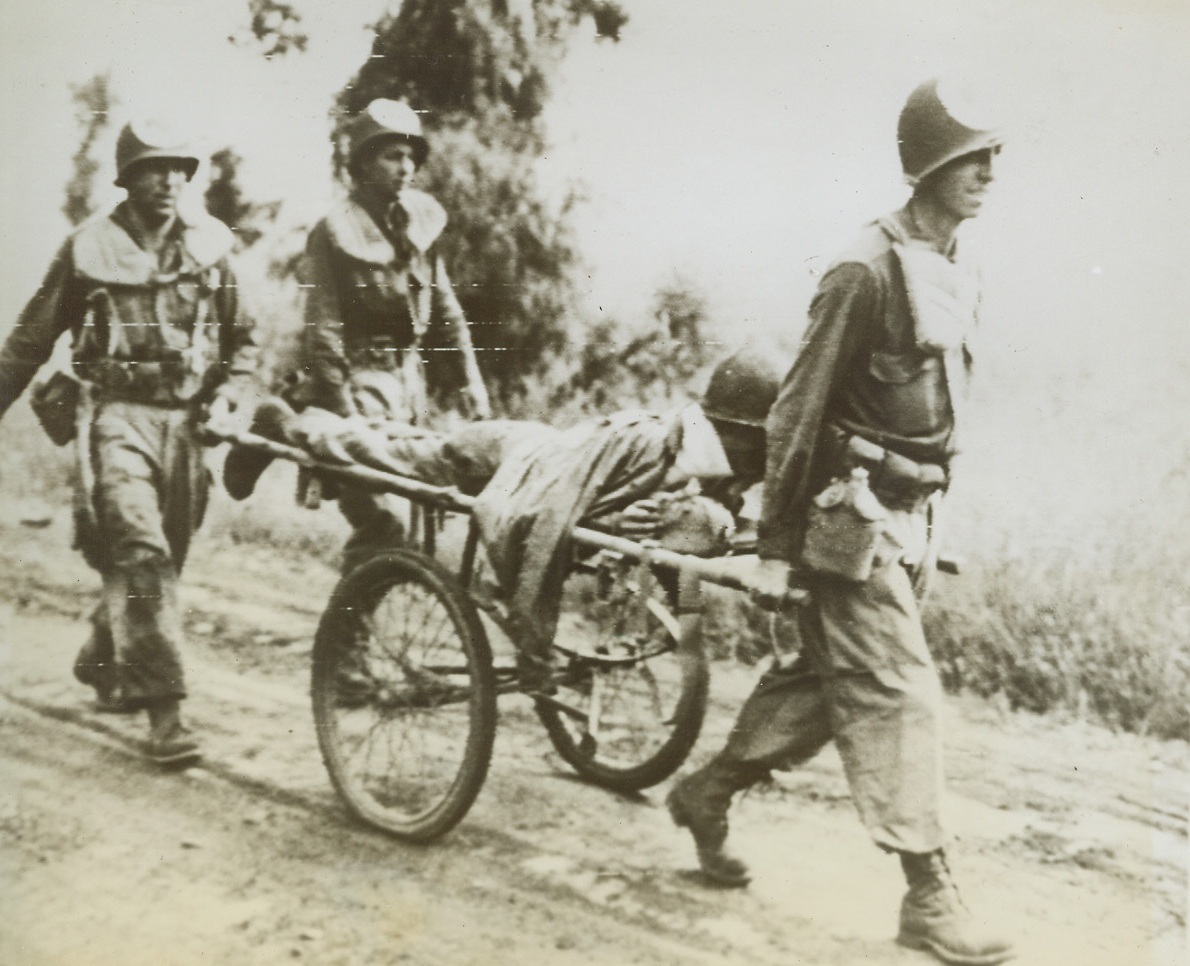
Litter-Borne Fighting Man, 5/29/1944. SOMEWHERE IN ITALY -- Returning from the Allied fighting front, this wounded soldier travels in a wheeled litter which is guided along the rough road by U.S. Army medical corpsman. The fighting man was felled at the start of the current offensive in the area. Credit: U.S. ARMY RADIOTELEPHOTO FROM ACME.;
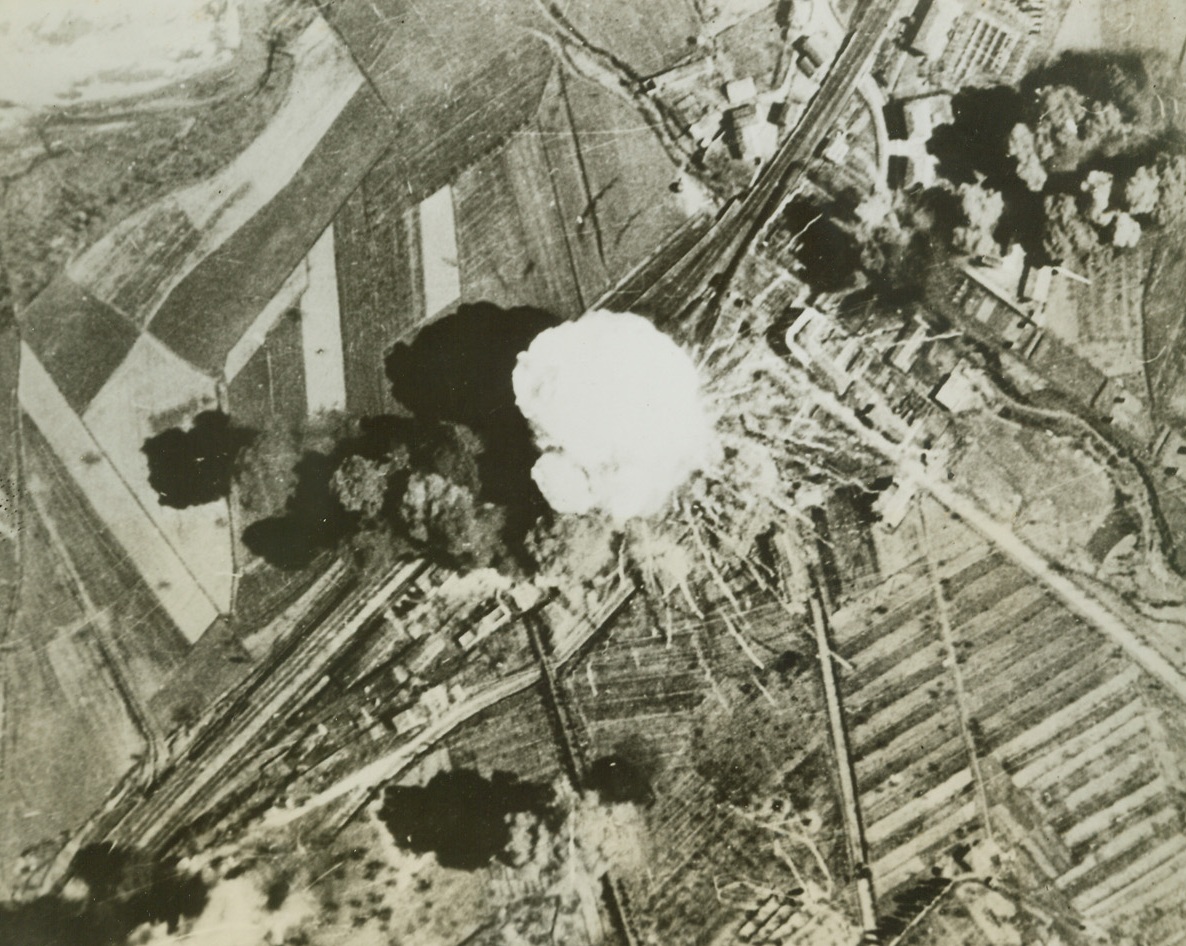
Bullseye for Yank Bombers, 5/2/1944. An enemy ammunition train goes up in a huge cloud of smoke as it is hit directly by bombs from B-25 Mitchells of the U.S. 12th Air Force, during a recent raid. On the railroad yards at Orvieto, Italy, 60 miles north of Rome, on the main line to Florence. Allied bombers have kept service on the rail lines in Northern Italy virtually at a standstill. Credit: USAAF photo from ACME.;
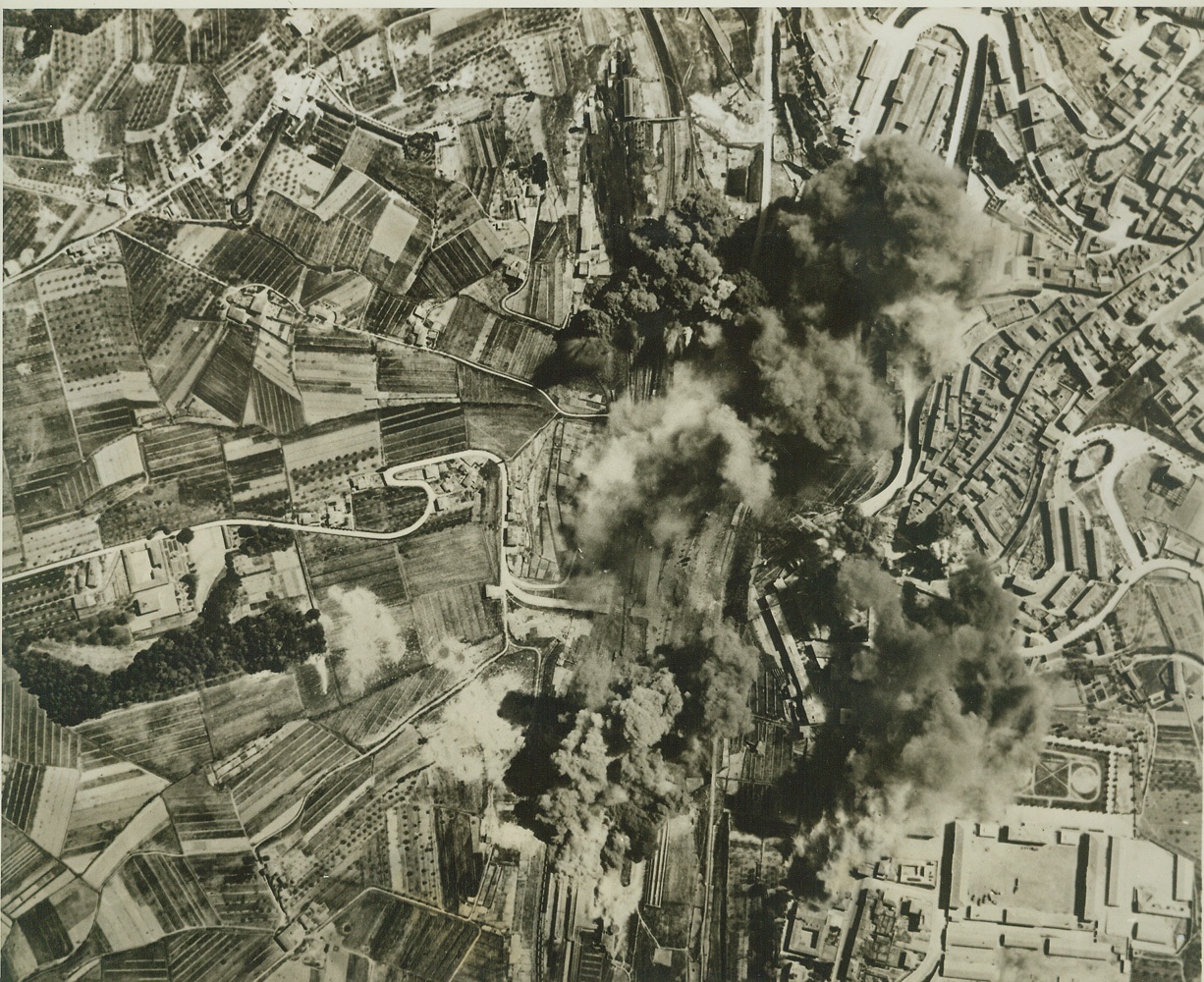
Ploesti Smashed Again by U.S. Airmen, 5/6/1944. PLOESTI, ROMANIA—Stepping up their non-stop pace in air offense, the Allies again hit the railroad marshalling yards at Ploesti and here Allied bombers wing over their target, leaving explosions and fires in their wake. The Flying Forts, based in Italy, were playing an early return engagement on the oil center which they attacked heavily not long ago. It appears that the Allies’ aim is to cripple German transportation and supply facilities as much as possible before the dawn of “D” day. Credit: OFFICIAL AAF PHOTO FROM ACME.;
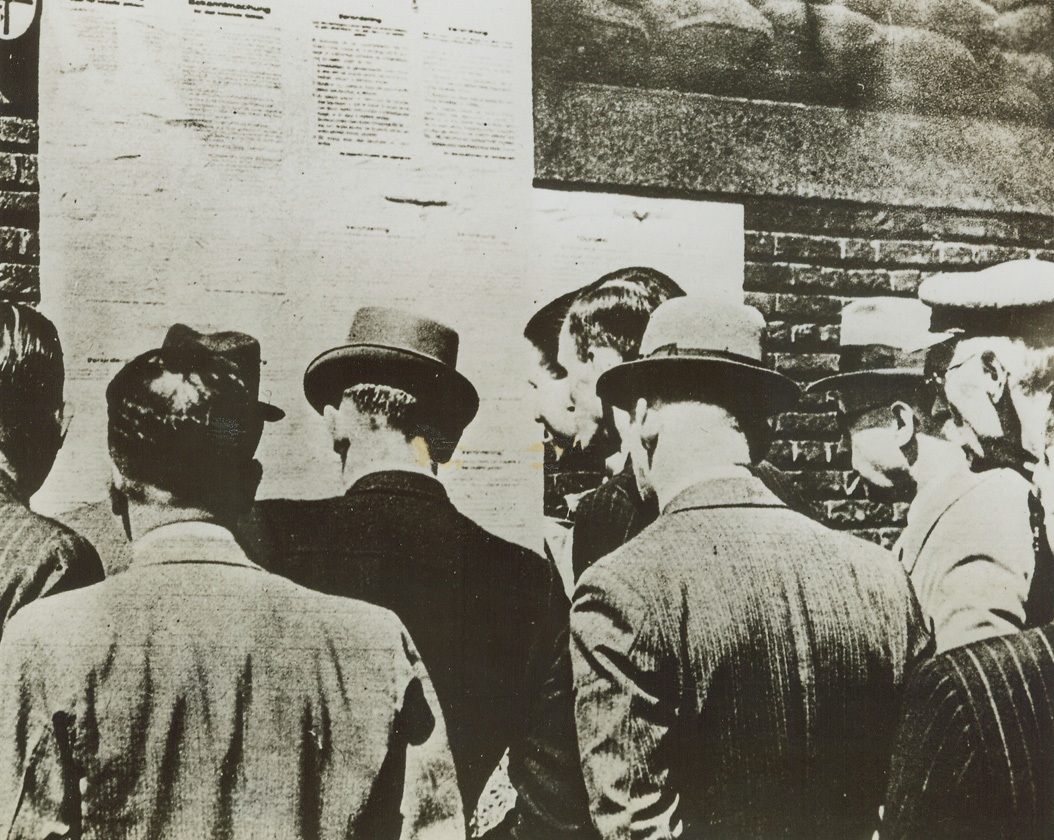
Holland Tense as “D” Day Nears, 5/26/1944. HOLLAND—Their expressions unreadable, these Dutch-men in occupied Holland flock to read the Latest Nazi decrees. This photo, just received from England, is a good example of the prevailing tenseness in Western Europe as “D” day, and the day of their liberation nears. Credit: ACME.;
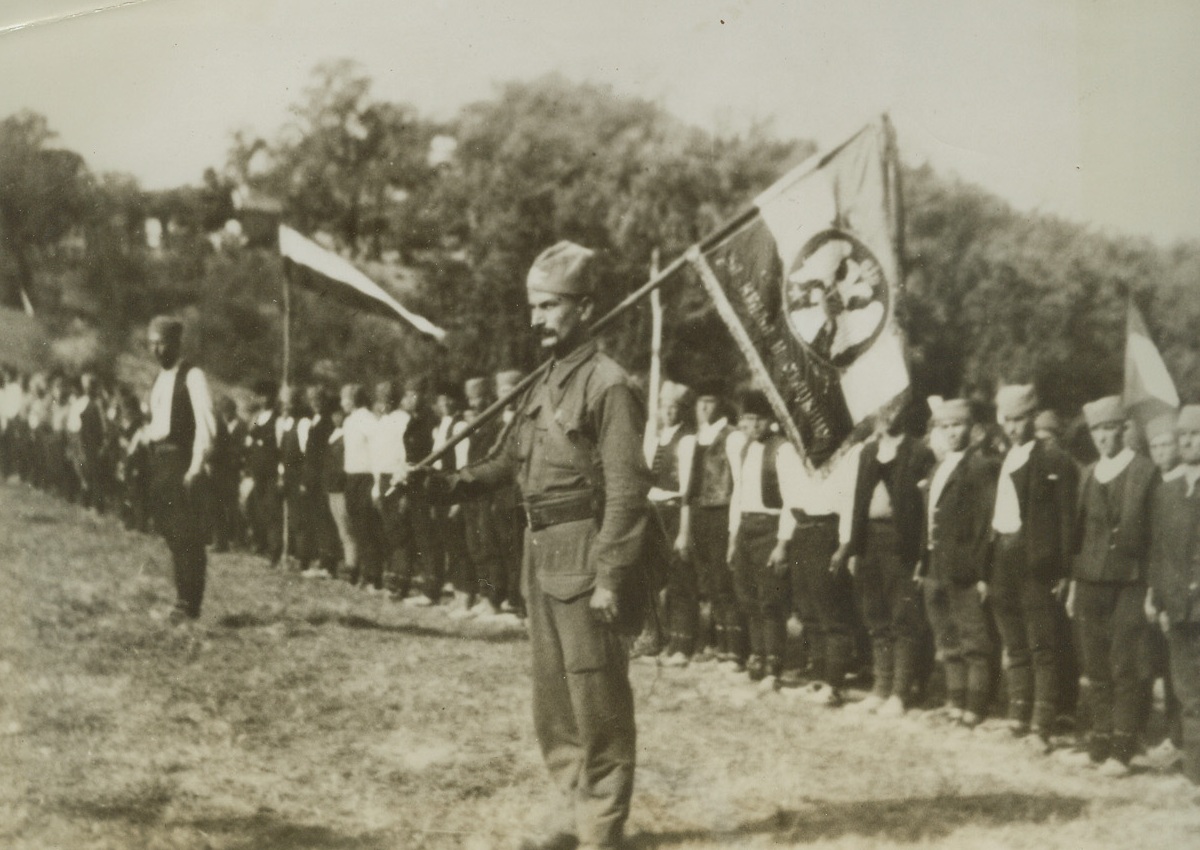
Mikhailovich Recruits, 5/2/1944. YUGOSLAVIA—New recruits of the Kings Mountain Guards stand at attention in the hills of Serbia awaiting orders, the flag in the foreground was made by nuns of a monastery in Serbia. This is but one of the many divisions fighting under guerrilla leader Draja Mikhailovich. A Mikhailovich aide arms and supplies 400,000 effectives could be mobilized. Credit: ACME.;
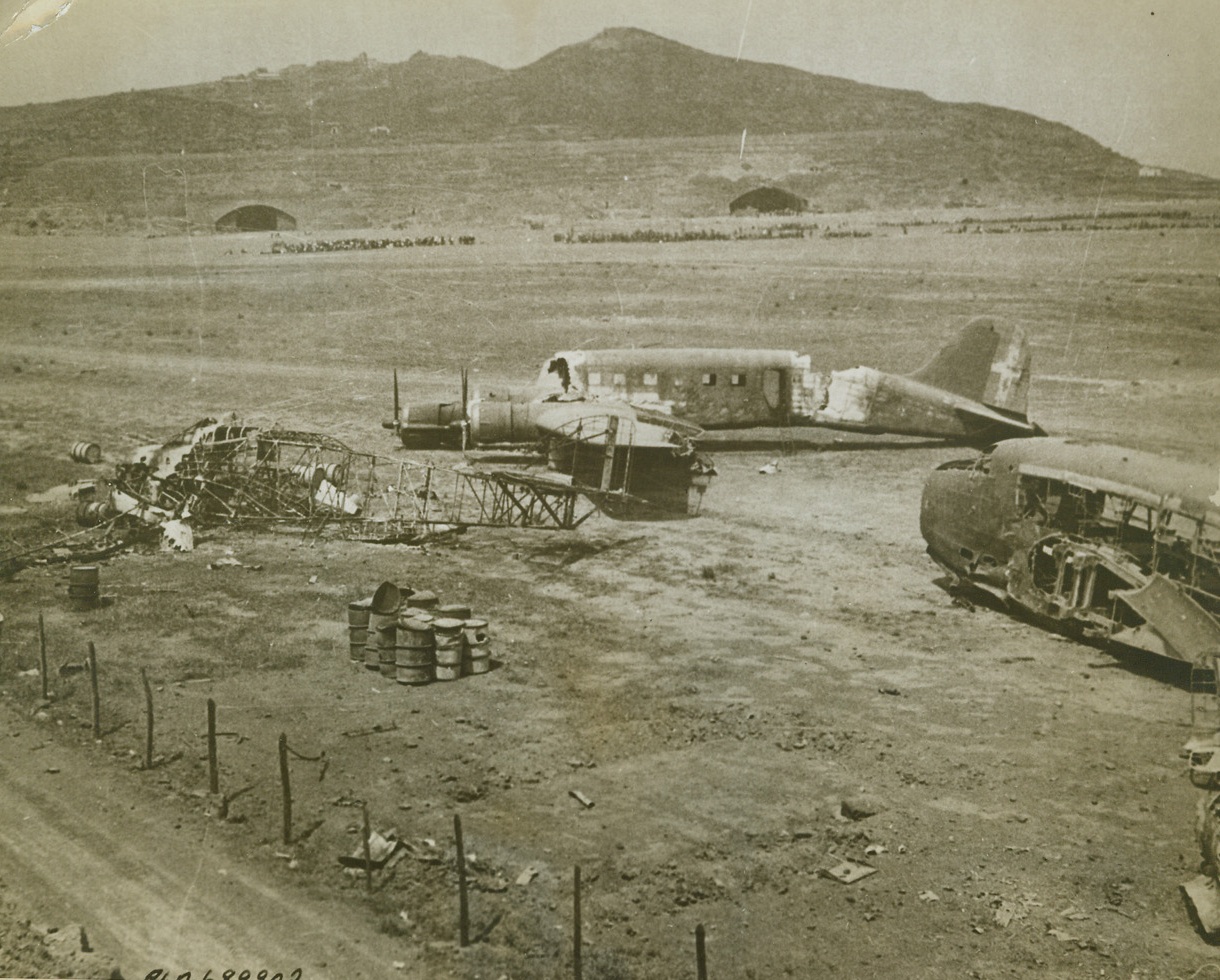
Didn’t Reach the Underground Hangers, 5/2/1944. PANTELLERIA-- A trio of Axis planes that were caught above ground during an Allied bombing of Pantelleria are crippled junk. Two entrances to the below surface hangers can be seen in the background. The sub-stratum plane facilities will serve the Allies well, on the conquered island. Credit: ACME.;
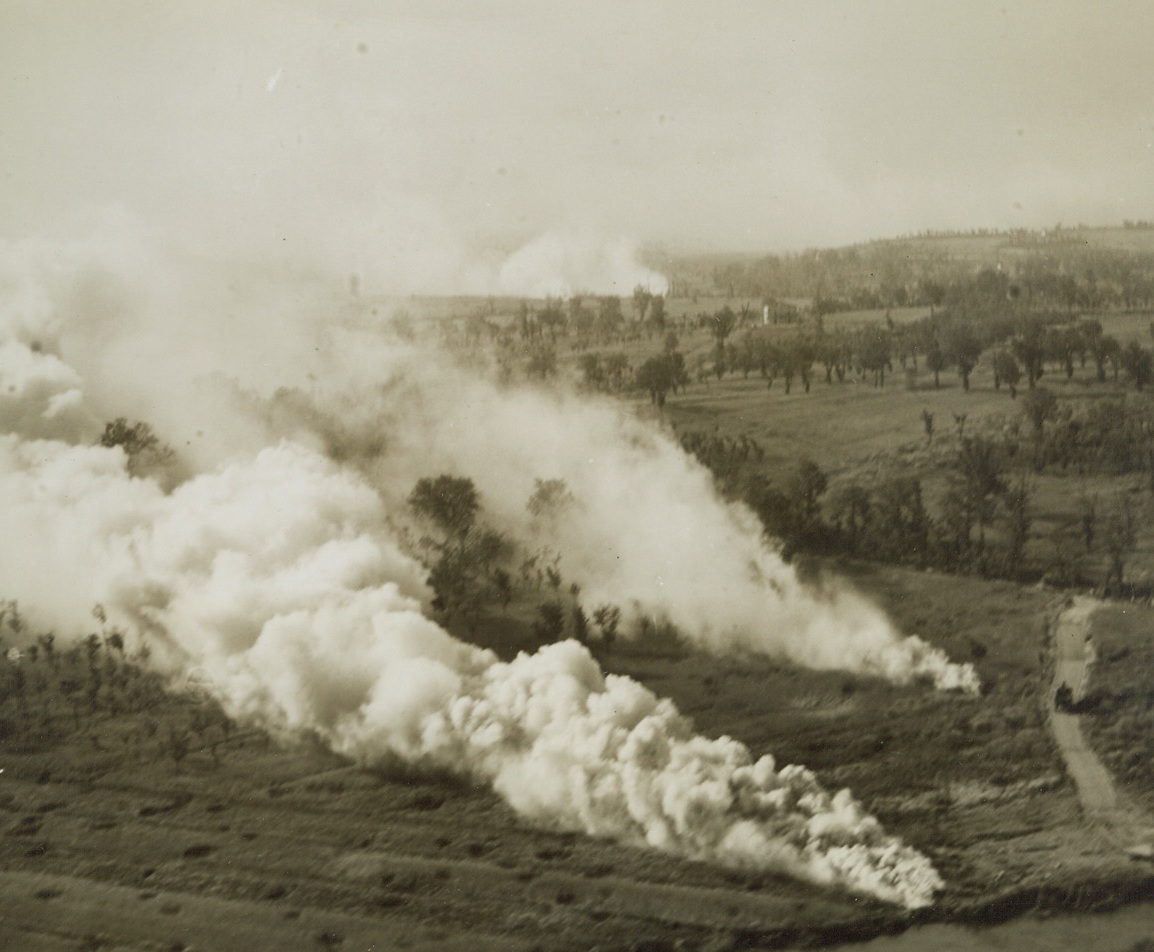
Where Rivers and Fighters Meet, 5/25/1944. ITALY—The junction of the Rapido, Liri, and Garigliano Rivers in Italy is screened by smoke pots after a bitter duel by German and Allied troops fighting in the area. With the opening of the new drive from the Anzio beachhead, the Allies are set for the final battle for Rome. Credit: ACME PHOTO BY CHARLES SEAWOOD, WAR POOL CORRESPONDENT.;
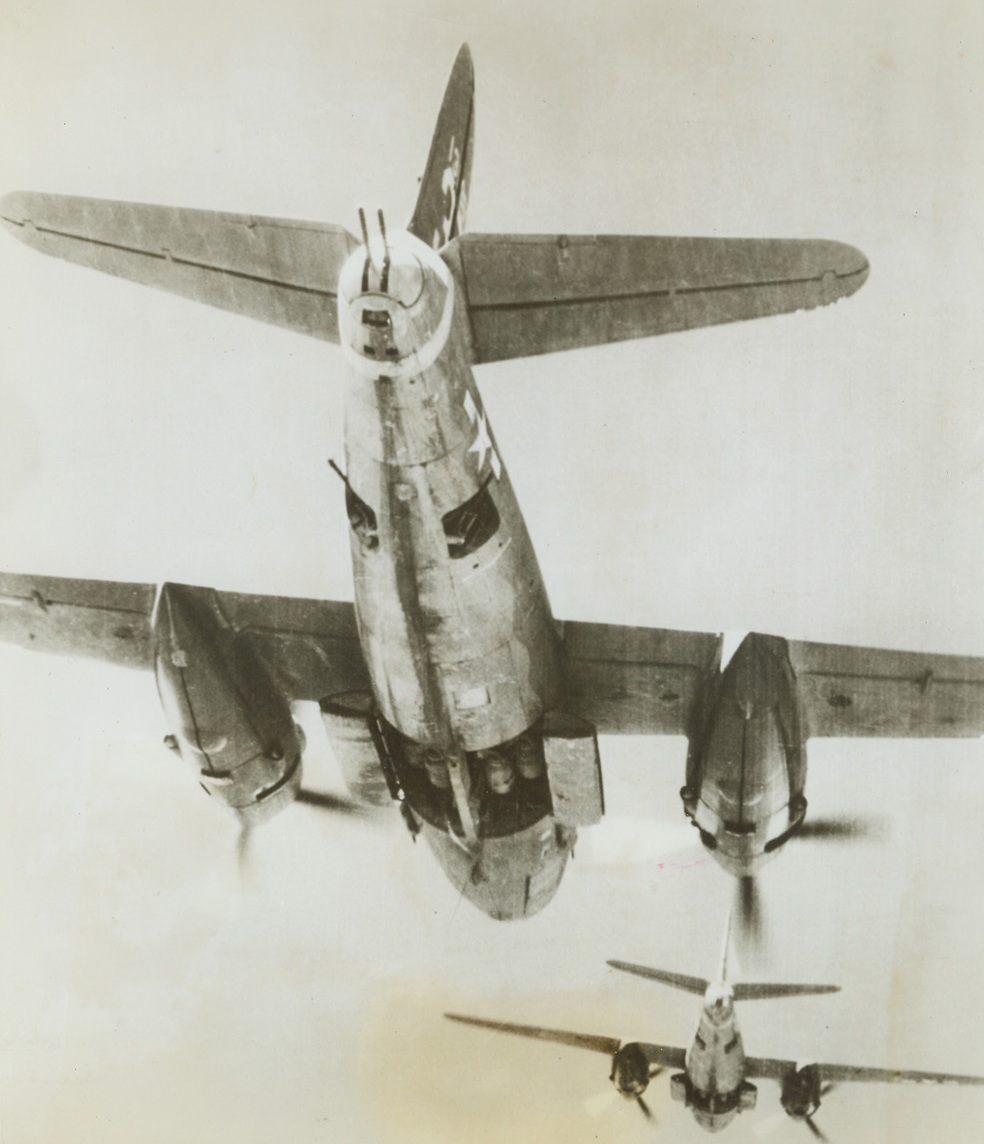
BOMBS AWAY, 5/20/1944.ITALY—In this unusual photo bombs can be seen through the open bomb bay doors of U.S. Army B-26 Marauders just before they went hurtling down through space on a railroad bridge south of Florence, Italy. Bombs cut the rail line used by the Nazis to supply their Cassino and Anzio fronts.Credit: USAAF photo from Acme;
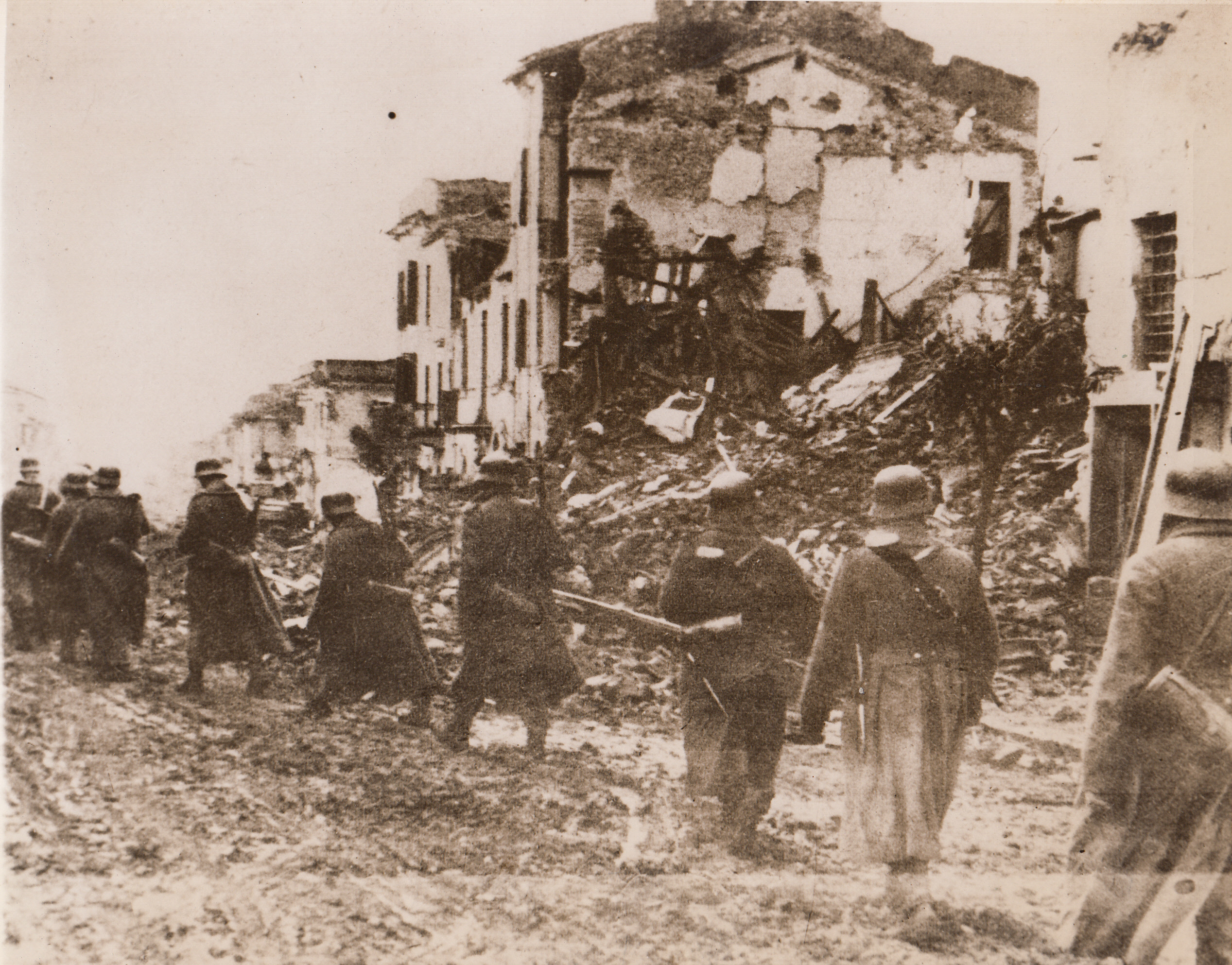
NO REST FOR THE WICKED, 5/19/1944. ITALY—The houses on the side of this road leading to the German front lines might once have provided suitable quarters for the Nazi troops, but no more. Allied artillery, hitting at the enemy with renewed vigor, has shattered the houses into uselessness. Nazi soldiers plodding up the road are moving up to relieve one of their units on the Italian front. This scene of destruction has been repeated in the key towns of Castelforte and Cassino, which are now in the hands of the Allies.;
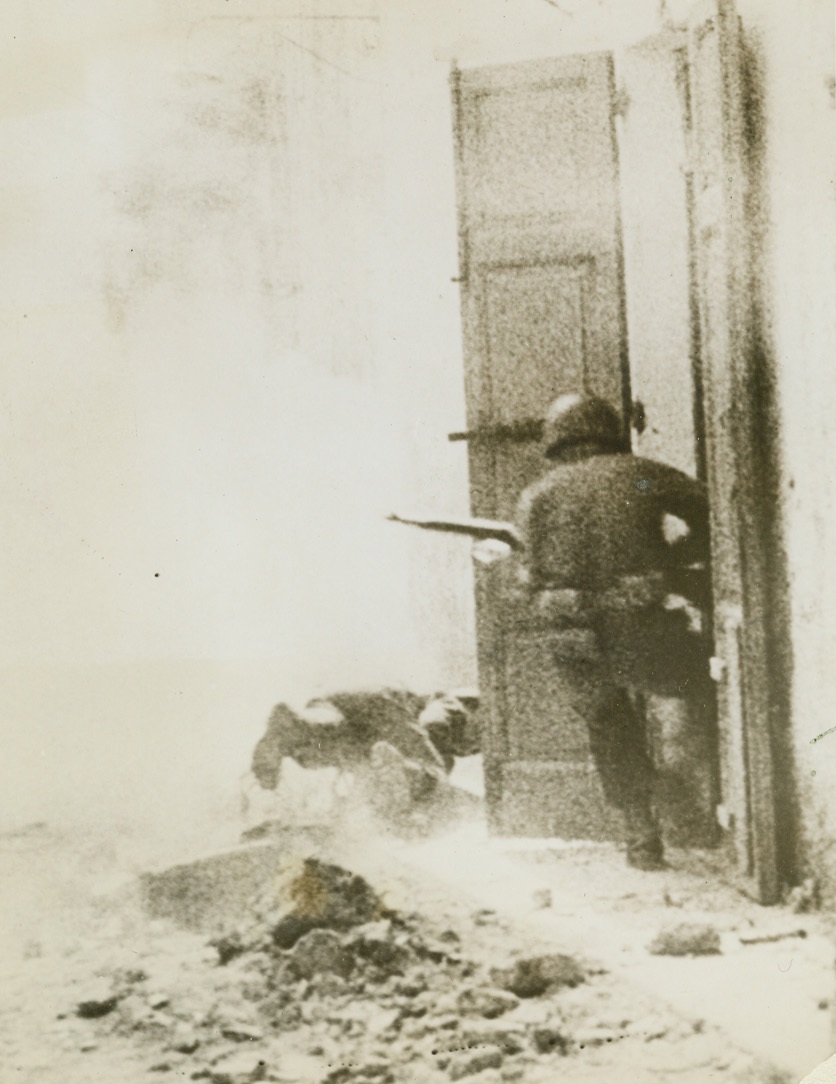
AND ONE WAS HIT (#3), 5/7/1944. ITALY—This is the last photo in a dramatic sequence made in an unnamed Italian village as three U.S. scouts fought a building-to-building scrap against entrenched Nazis. Here one of them is hit by a Nazi bullet and falls as his two comrades quickly dart into an open door for momentary shelter. White could is probably caused by exploding grenade.Credit: Signal Corps newsreel photo from Acme;
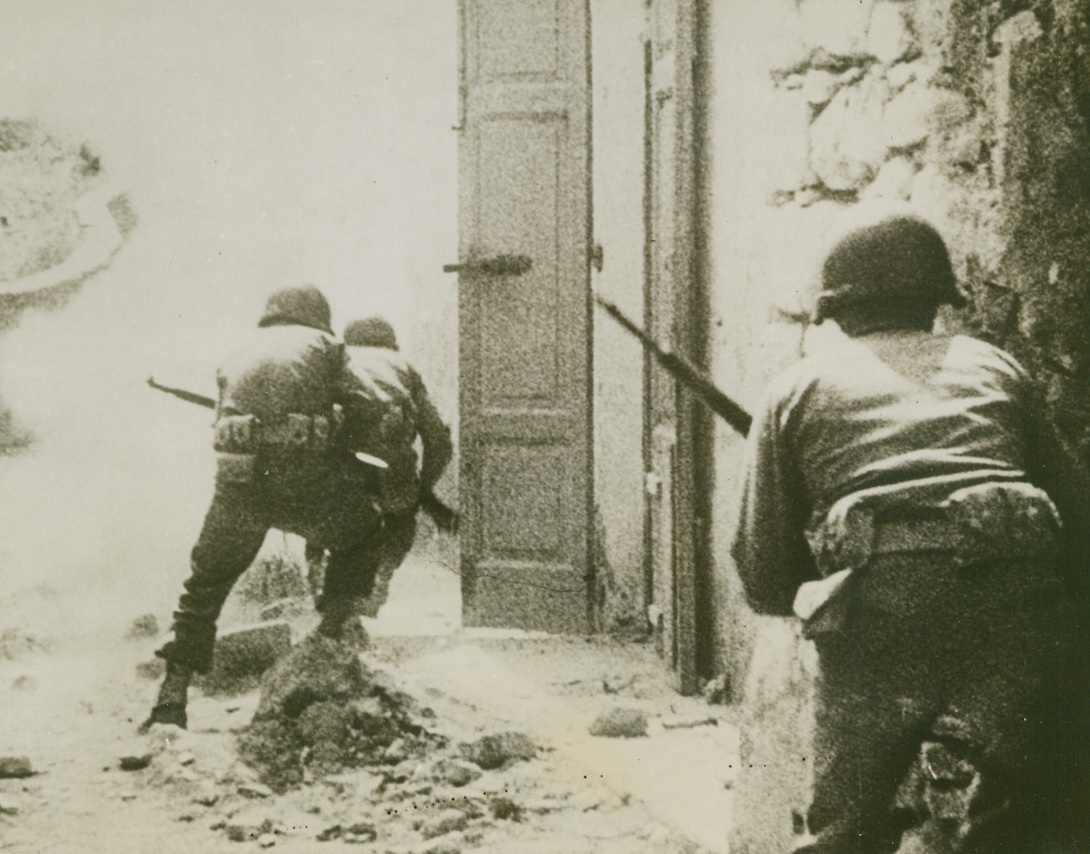
![AND ONE WAS HIT (#2), 5/17/1944. ITALY—This is second photo in a dramatic sequence made in an unnamed [sic] Italian village as three U.S. scouts fought a building-to-building scrap against entrenched Nazis. Here the men try to keep their heads low as they edge cautiously toward an open door.Credit: Signal Corps newsreel photo – Acme;](/media/14695/77091697.jpg)
AND ONE WAS HIT (#2), 5/17/1944. ITALY—This is second photo in a dramatic sequence made in an unnamed [sic] Italian village as three U.S. scouts fought a building-to-building scrap against entrenched Nazis. Here the men try to keep their heads low as they edge cautiously toward an open door.Credit: Signal Corps newsreel photo – Acme;
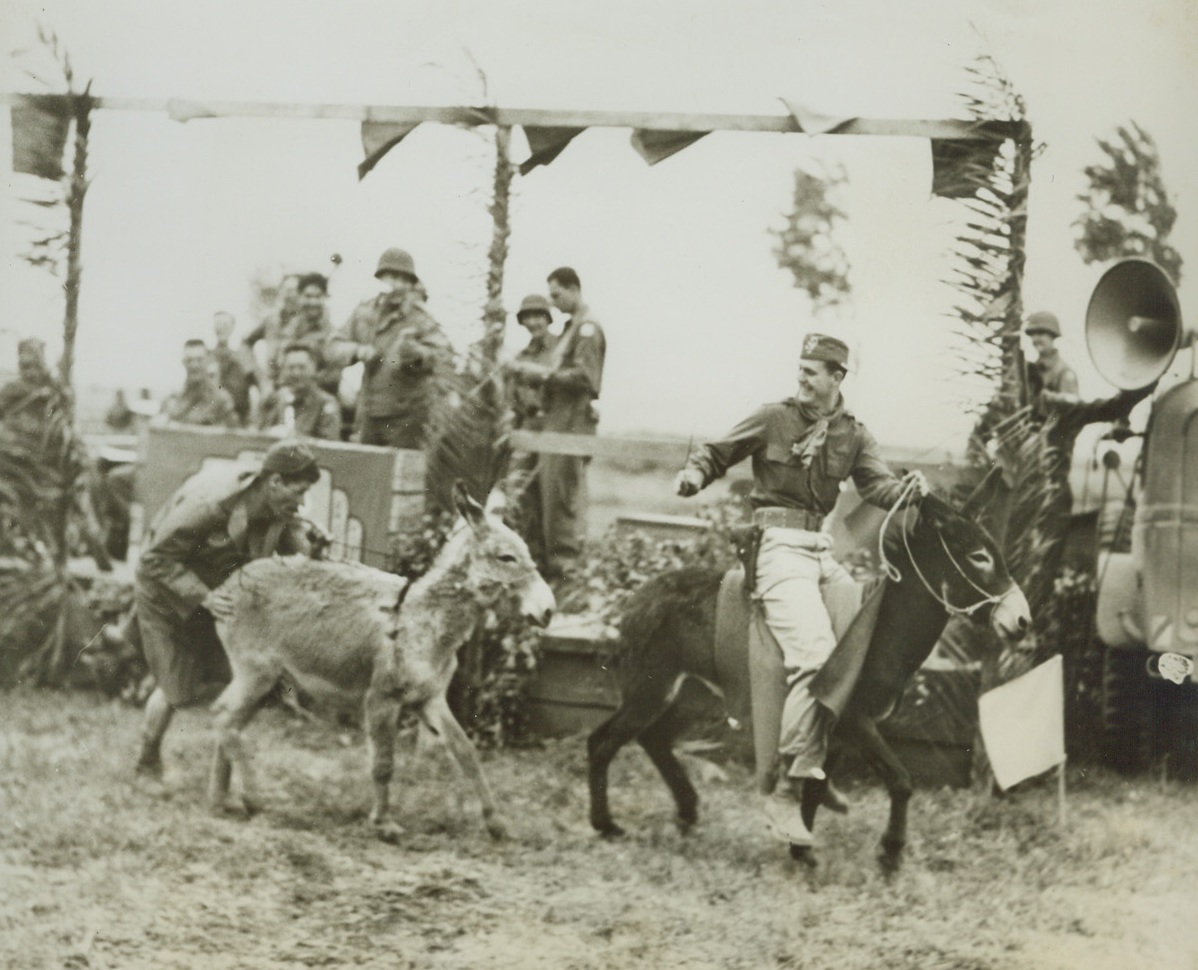
AND ONE WAS HIT (#1), 5/17/1944. ITALY—This is the first photo in a dramatic sequence made in an unnamed Italian village as three U.S. scouts fought a building-to-building scrap against entrenched Nazis. Here the trio moves cautiously down the street as a fourth scout watches them go and is prepared to cover the rear.Credit: Signal Corps newsreel photo from Acme;
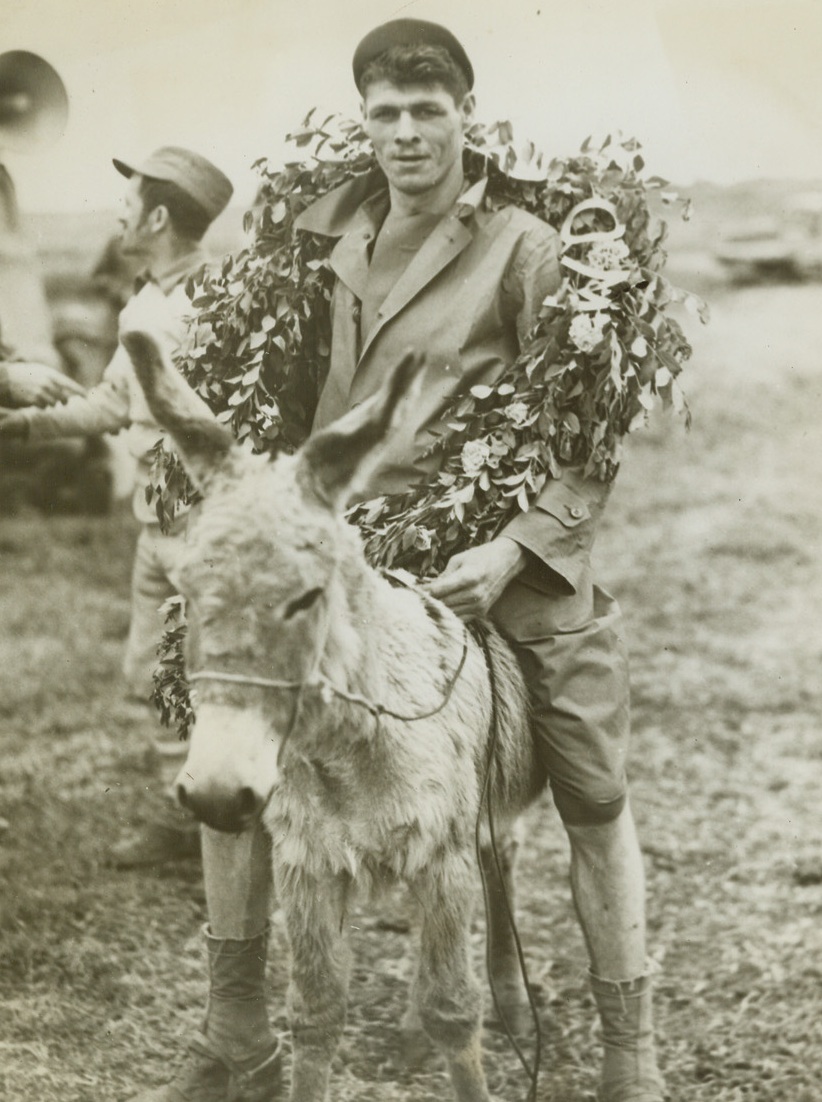
THE WINNAH—WHICH ONE?, 5/20/1944. ANZIO, ITALY—This poor little donkey certainly lives up to his other name. He did all the running in the Donkey Handicap, but stands calmly by as his rider, Pvt. Daniel L. Cason, of St. Joseph, Mo., dons the winner’s horseshoe. Pvt. Cason rode his bonny bray to victory in the handicap which was part of the rodeo staged by men of the 5th Army on the Anzio beachhead.Credit: Acme;
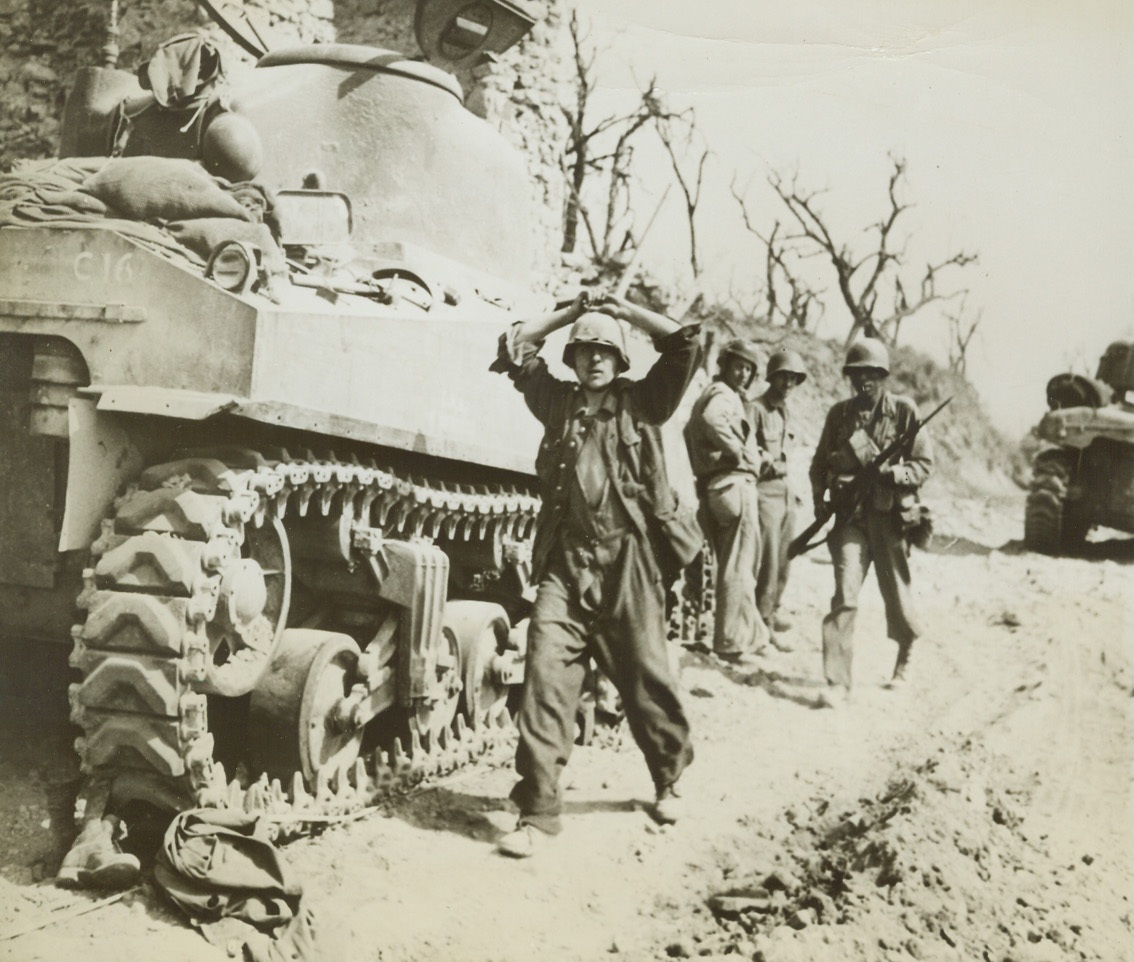
“SUPERMAN” FINDS CAPTURE EASY, 5/19/1944. ITALY—A german soldier, captured at Santa Maria Infante, Italy, is led to a detention camp behind the front lines. Americans took the town recently during the current Allied offensive and have already moved forward to pierce the Hitler Line.Credit: Acme;
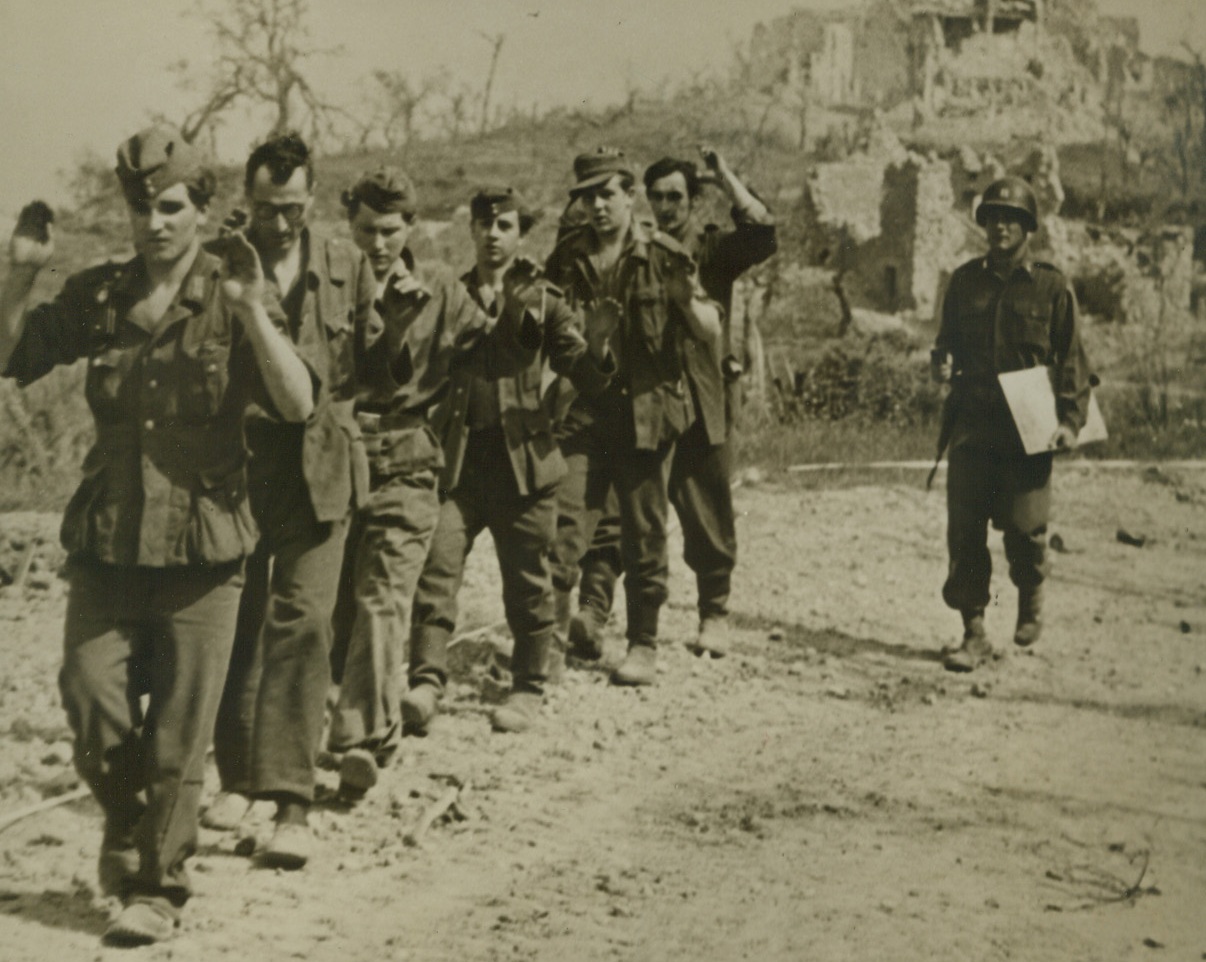
CAPTURED NAZIS IN ITALY, 5/19/1944. ITALY—An American captain of the Allied 5th Army leads a group of German prisoners to depots behind the front lines at Santa Maria Infante, Italy, where the enemy soldiers were captured. According to latest reports the Nazi retreat along the entire Italian front has approached the proportions of a rout.Credit: Acme;
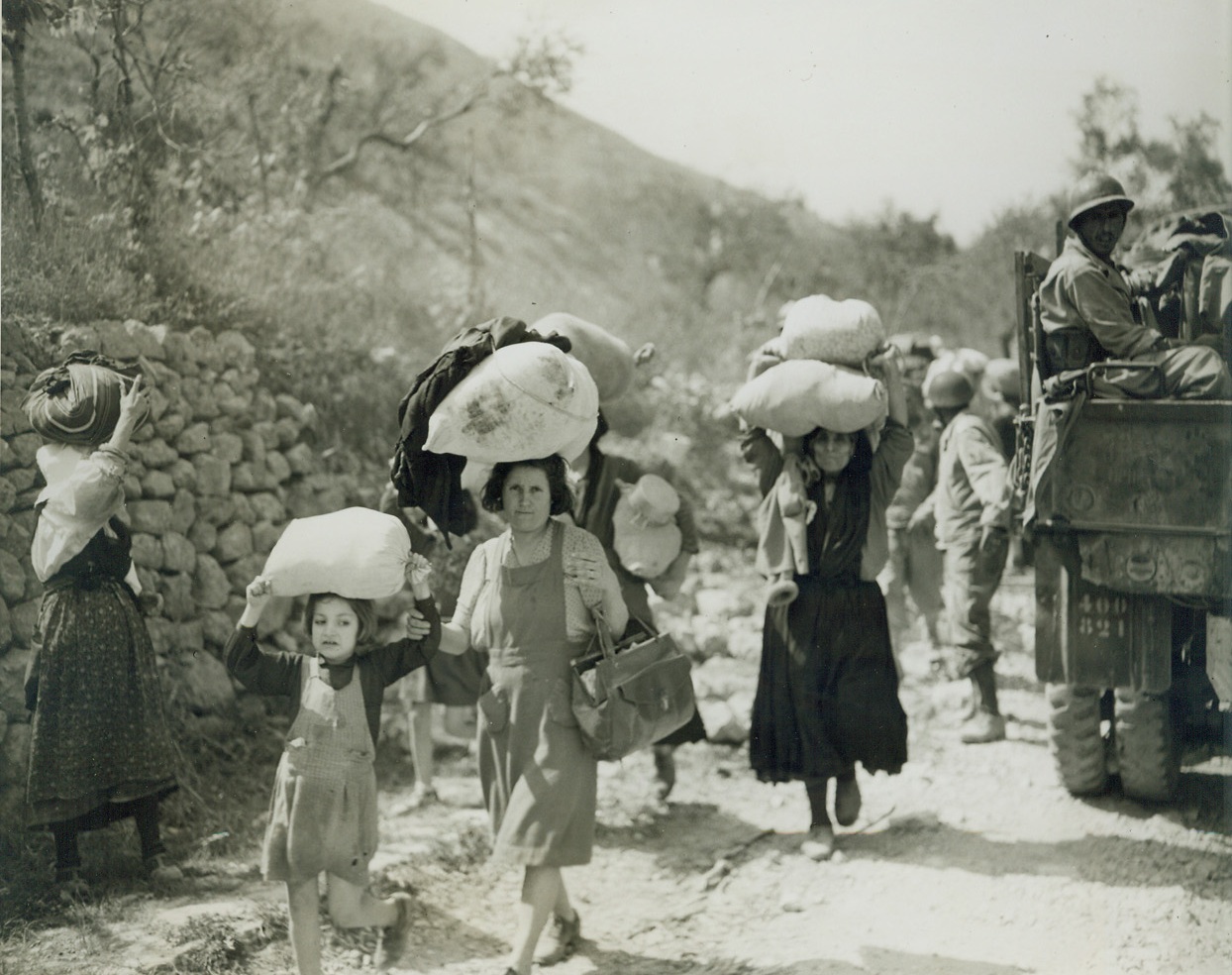
FIRST ORIGINAL PHOTOS OF LATEST ITALIAN DRIVE, 5/18/1944. This is one of the first original photos to be received from the Italian front since the start of the new Allied drive. The picture was made on May 13th and despite the various channels of censorship and transportation problems they were in Washington, D.C., by the afternoon of May 18th. It is believed that a new record for expediting of newspictures has thus been established by the Army. Photo shows—Italian refugees as they fled from the town of Castleforte following the capture of the German stronghold by French and Allied Forces on the second day of the spring offensive.Credit: Acme photo by Charles Seawood for the War Picture Pool;
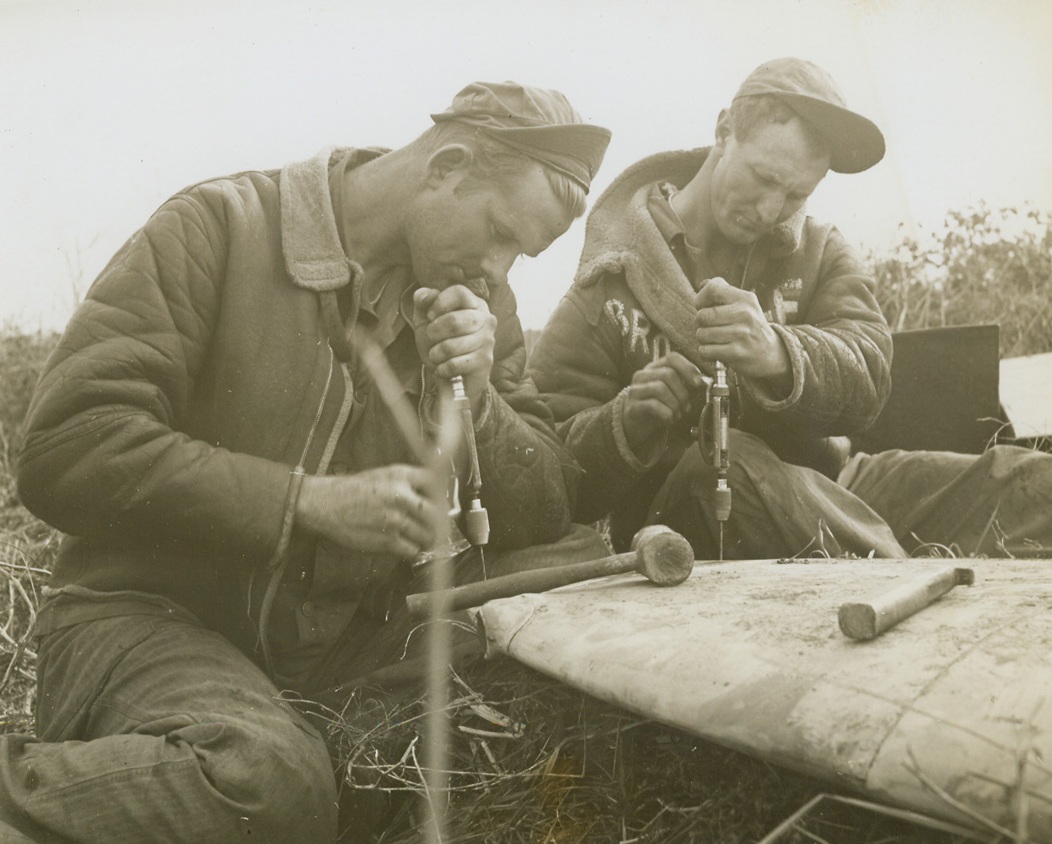
SALVAGE SOLDIERS, 5/17/1944. NETTUNO, ITALY—S/Sgt. Robert S. Lockett, of Dallas, Tex., and S/Sgt. Lewis Brooks, of Gunter, Tex., salvage parts of a Spitfire at Nettuno airfield.Credit: Acme photo by Charles Seawood for the War Picture Pool;
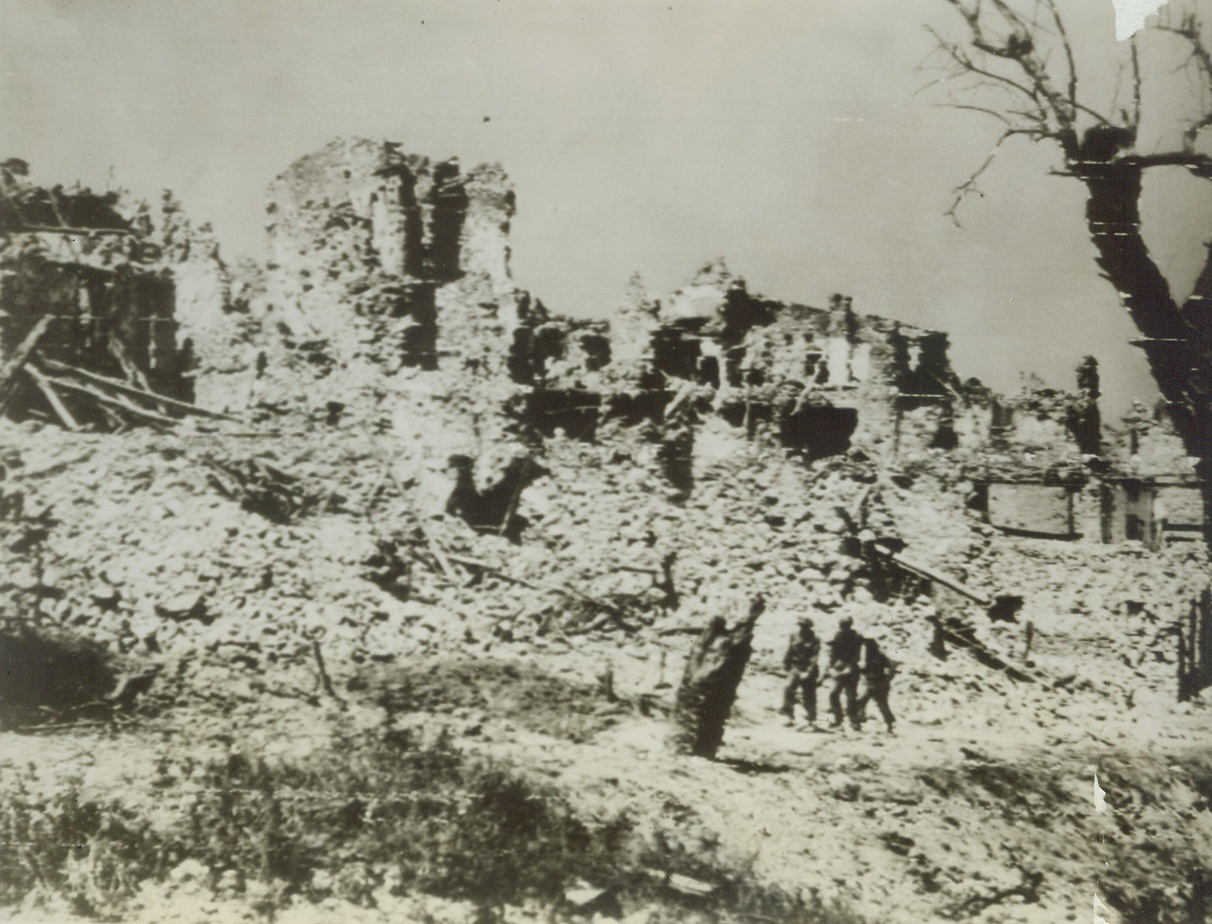
RUBBLED ADVANCE, 5/17/1944. ITALY—A trio of Americans walk through the debris-filled streets of San Maria Infante which was captured by the Allies after they renewed their offensive actions against the German forces in Italy.Credit: U.S. Army Radio from Acme;
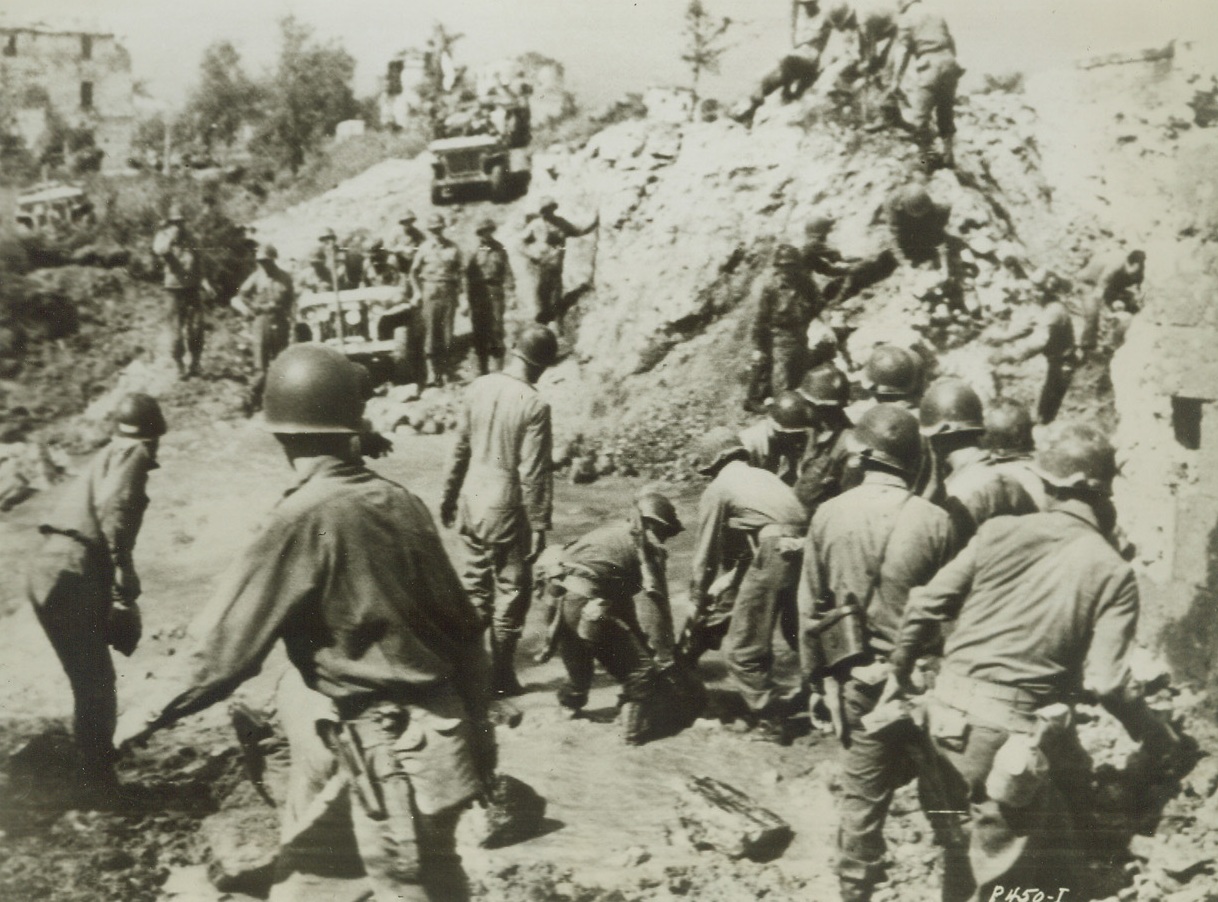
DAMAGED ROAD DIDN’T STOP ADVANCING TROOPS, 5/18/1944. ITALY—Retreating Germans blew up a bridge near Castellonorato in an attempt to impede the Allied advance on the town. Our troops, geared to the high tempo of the new Italian offensive, are shown filling in a road crossing next to the blown up bridge. Latest Italian announcement confirmed the German evacuation of Cassino, Nazi stronghold.Credit: US Army Radiotelephoto from Acme;
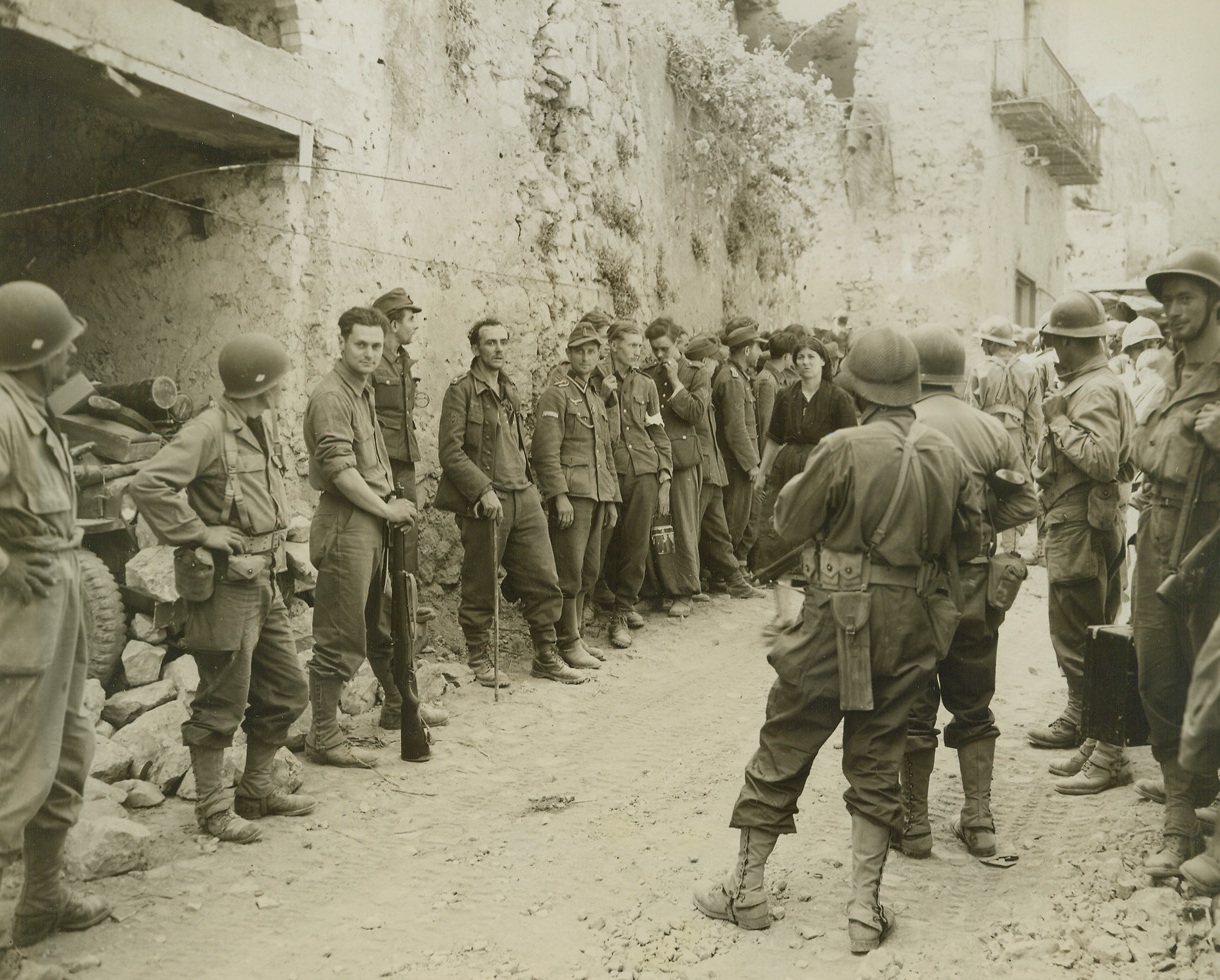
ALLIES SMASH GUSTAV LINE—FIRST PHOTOS, 5/18/1944. CASTLEFORTE, ITALY—This photo, one of the first originals to be received in the U.S. of the current smashing Allied offensive against the Germans in Italy, shows American-equipped French troops of the Fifth Army (right, and left foreground), rounding up Germans in Castleforte after the Allies had taken the town on the second day of the attack. The enemy troops were left to hold the town “at all costs,” but were no proof against the fury of the Fifth Army attack, which cracked the Gustav Line and is now pressing strongly against the Hitler Line—last line of German fortifications in Italy. This photo, taken May 13th and which was received in the U.S. today, (May 18th) is believed to have set a new record in the expediting of news pictures by the U.S. Army.Credit: Acme photo by Charles Seawood for the War Picture Pool;
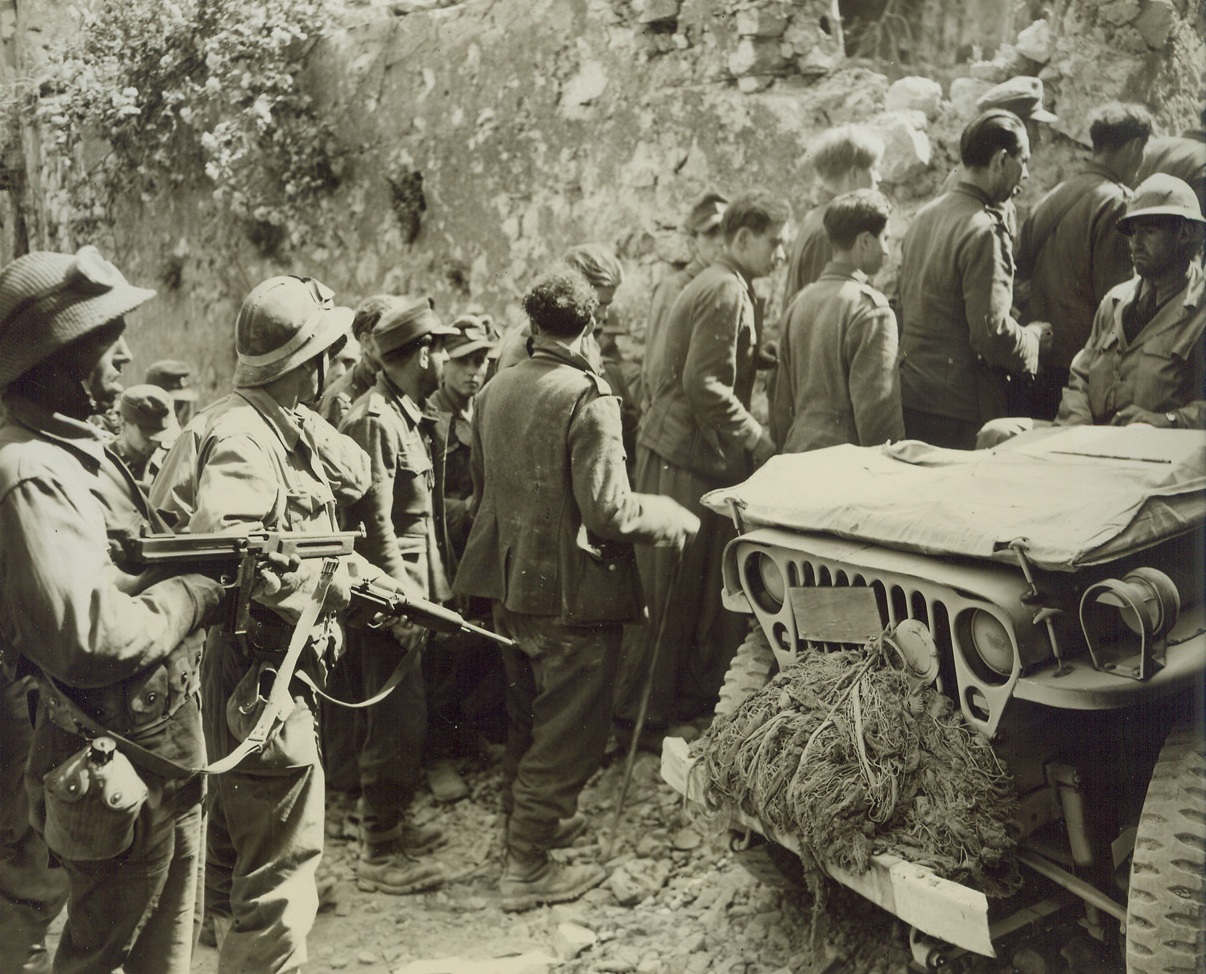
ALLIES SMASH GUSTAV LINE—FIRST PHOTOS, 5/18/1944. CASTLEFORTE, ITALY—This photo, one of the first originals to be received in the U.S. of the current smashing Allied offensive against the Germans in Italy, shows two American-equipped French soldiers of the Fifth Army, holding submachine guns ready for use (left), as they round up enemy soldiers in Castleforte after it had been taken by the Allies the second day of the attack. The Germans were left to defend the town “at all costs”, but were no proof against the fury of the Fifth Army advance. Today, five days after this photo was taken, the Allies have almost completely obliterated the Gustav line and are pressing strongly against the Hitler Line—last line of Nazi fortifications in Italy.Credit: Acme photo by Charles Seawood for the War Picture Pool;
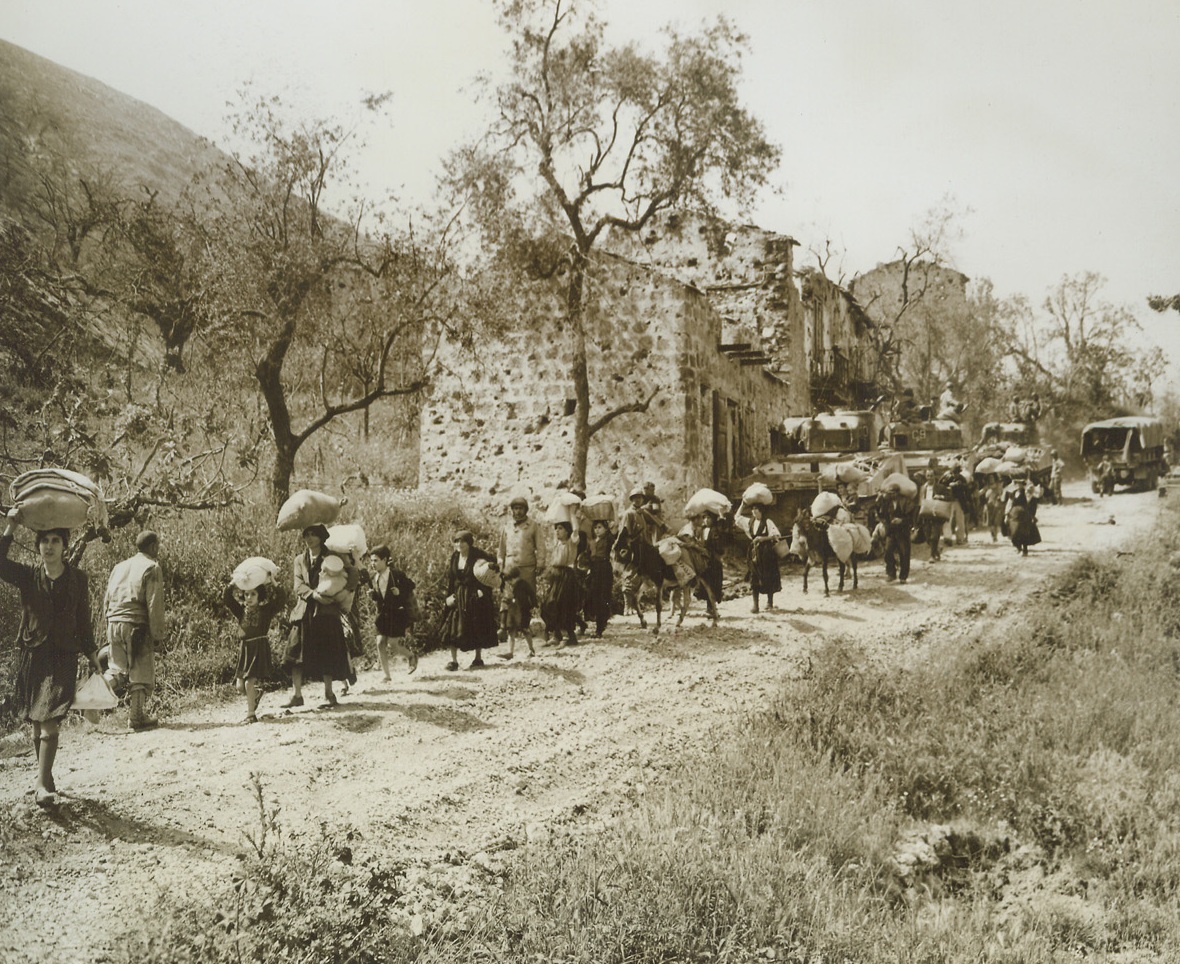
LEAVING THEIR HOMES BEHIND, 5/19/1944. CASTELFORTE, ITALY—Their possessions wrapped in tiny bundles and blanaced on their heads, Italian refugees from the battered town of Castelforte stream away from their homes, heading for safety as the battle for the town rages. Captured by French and American troops, the German stronghold fell during the second day of the new offensive in Italy.Credit: Acme photo by Charles Seawood for the War Picture Pool;
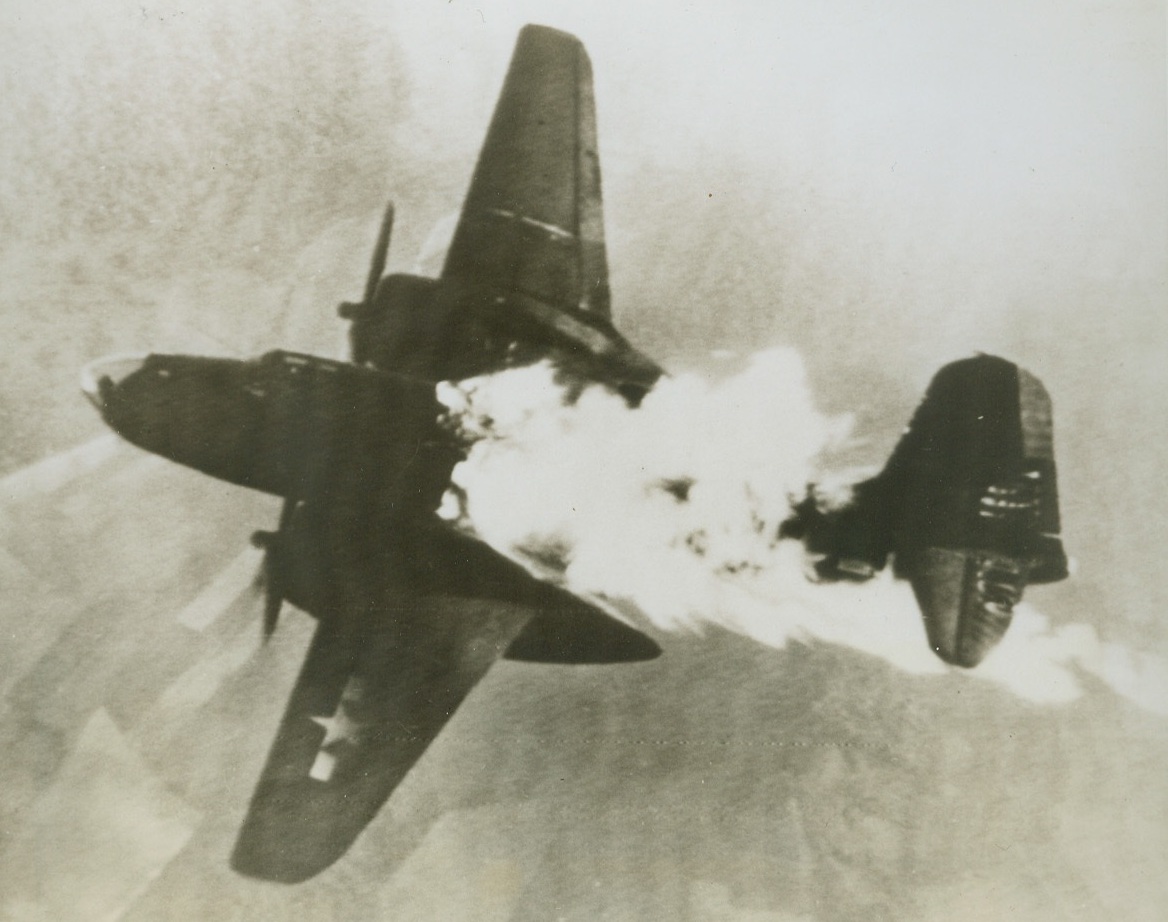
One for the Nazis, 5/17/1944. ENGLAND -- This A-20 Havoc of the Ninth Air Force was hit and burst into flames while on a mission over France recently. Picture was flashed to the U.S. by radiotelephoto. Credit (U.S. Army Radio From ACME);
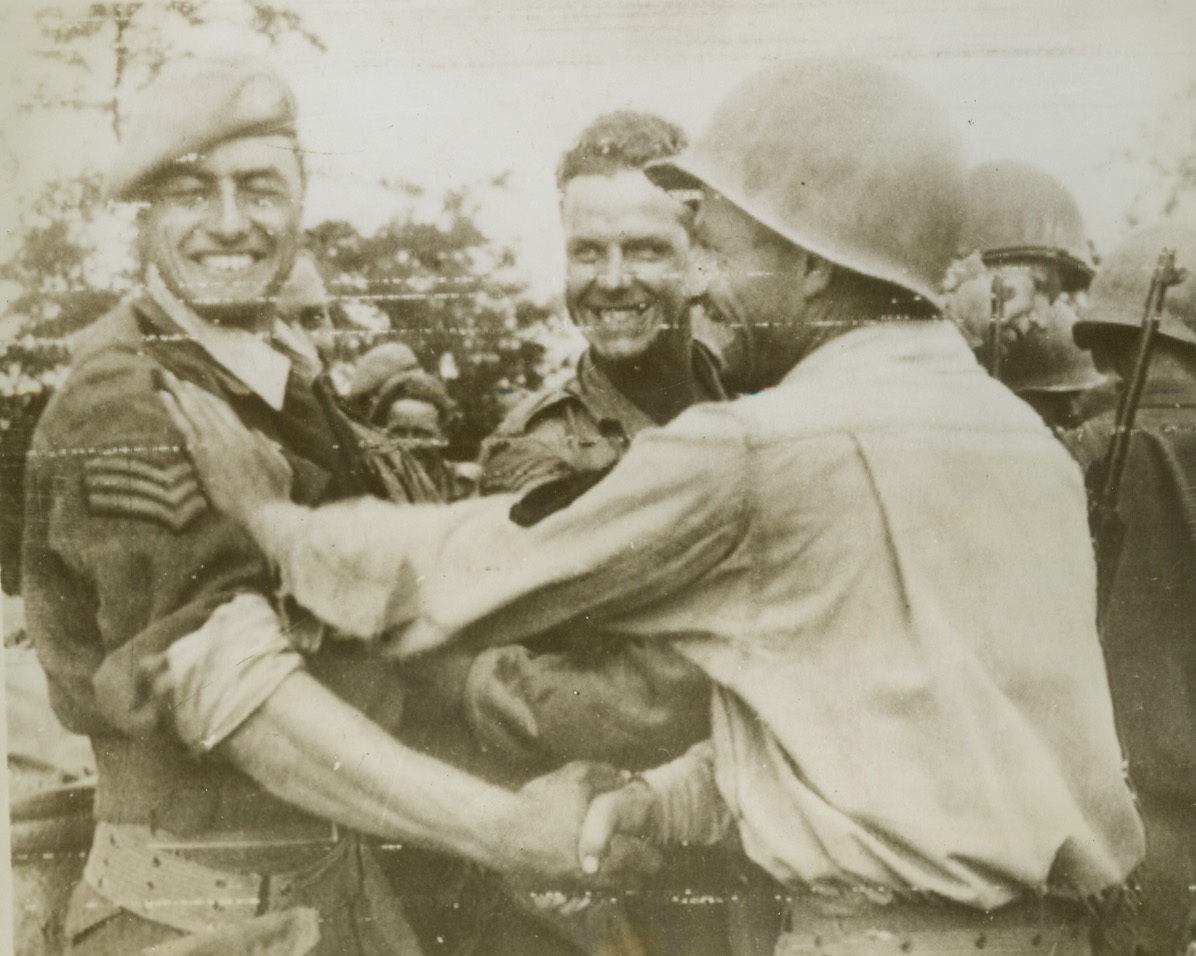
FORCES JOINED FOR MARCH ON ROME, 5/25/1944. ITALY—The Fifth Army merged its two fronts today and is now set for a unified push on Rome. The climax came when troops from the Anzio beachhead and the main force above Terracina met in the Pontine Marshes area. As the beachhead forces met, Sgt. W. Cumber of London, England, is greeted by Sgt. D. Russell, St. Louis, Mo.Credit: British official photo via OWI Radiophoto from Acme;
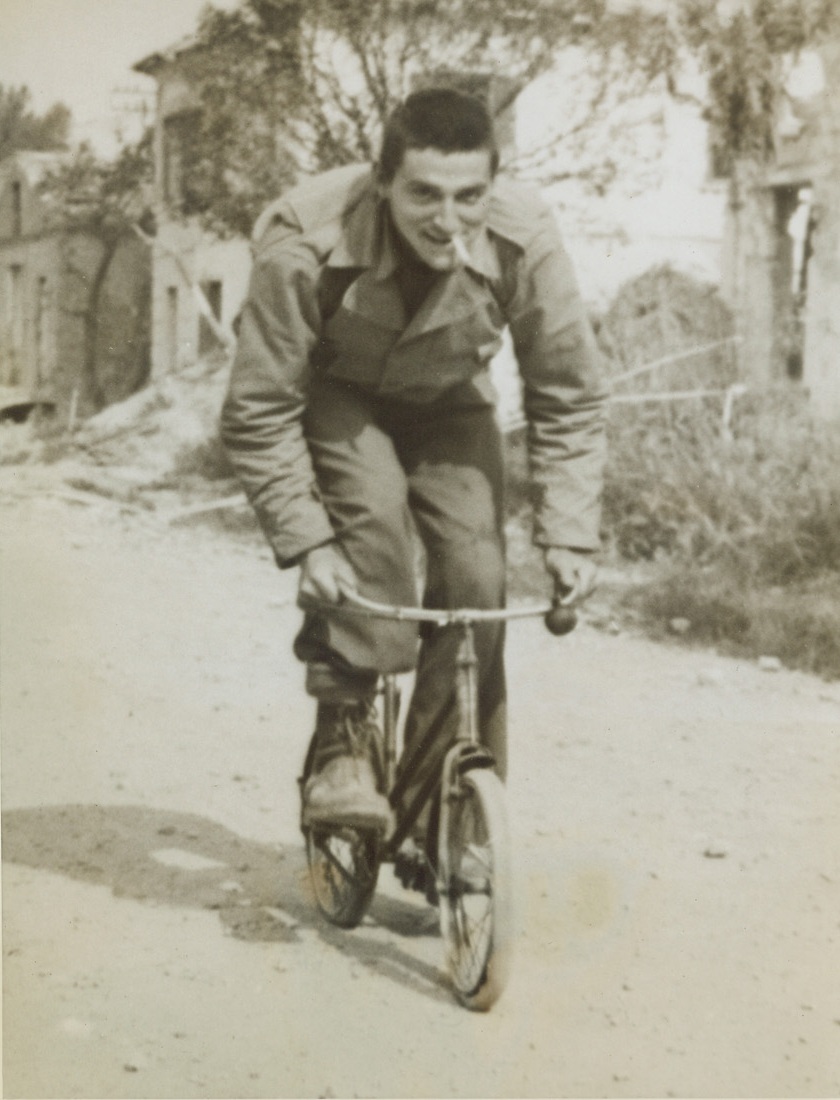
A BICYCLE BUILT—NOT FOR HIM, 5/29/1944. SCAURI, ITALY—Trundling along at snail’s pace on this diminutive two-wheeler, Cpl. Jim Ross, of Wilkinsburg, Pa., doesn’t seem at all bothered by the fact that he is joy-riding only 1,500 yards from the front lines. Cpl. Ross found the child’s bike when the American troops took Scauri in the current Allied offensive drive in Italy.Credit: Acme;
![SUGAR BABY—A REFUGEE, 5/31/1944. ITALY—An Italian mother feeds her child a piece [illegible] on returning to Minturno after the [illegible] occupation of the town. Officials of the [illegible] Military Government are taking care of [illegible] Italian civilian refugees. Credit: Acme;](/media/14710/77091755.jpg)
SUGAR BABY—A REFUGEE, 5/31/1944. ITALY—An Italian mother feeds her child a piece [illegible] on returning to Minturno after the [illegible] occupation of the town. Officials of the [illegible] Military Government are taking care of [illegible] Italian civilian refugees. Credit: Acme;
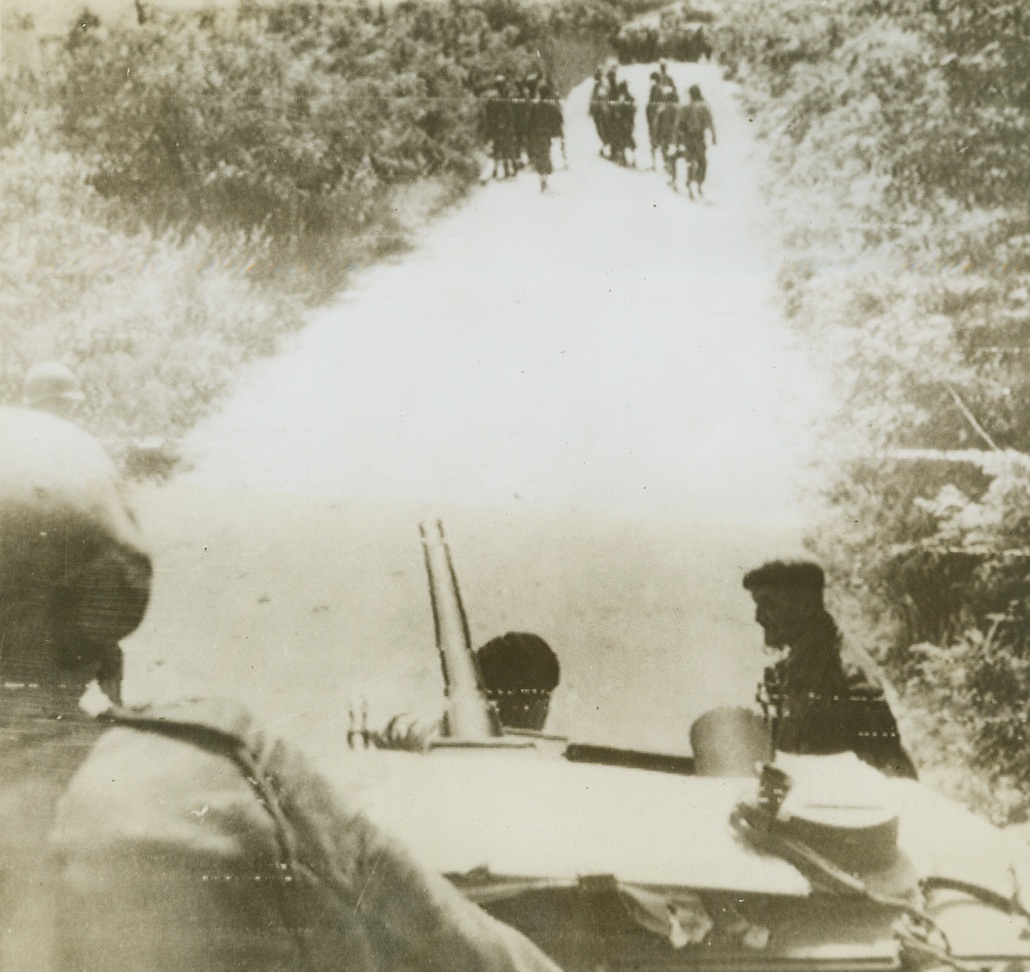
FIFTH ARMY MERGES TWO FRONTS, 5/25/1944. ITALY—Climaxing a lightning march which burst through sixty miles of German defenses, the Fifth Army merged its two fronts—the Anzio beachhead and the main force above Terracina—today for a unified drive on Rome. A British recon unit approaches on a road in the Pontine Marshes area where the meeting took place. Credit: British official photo via OWI Radiophoto from Acme;
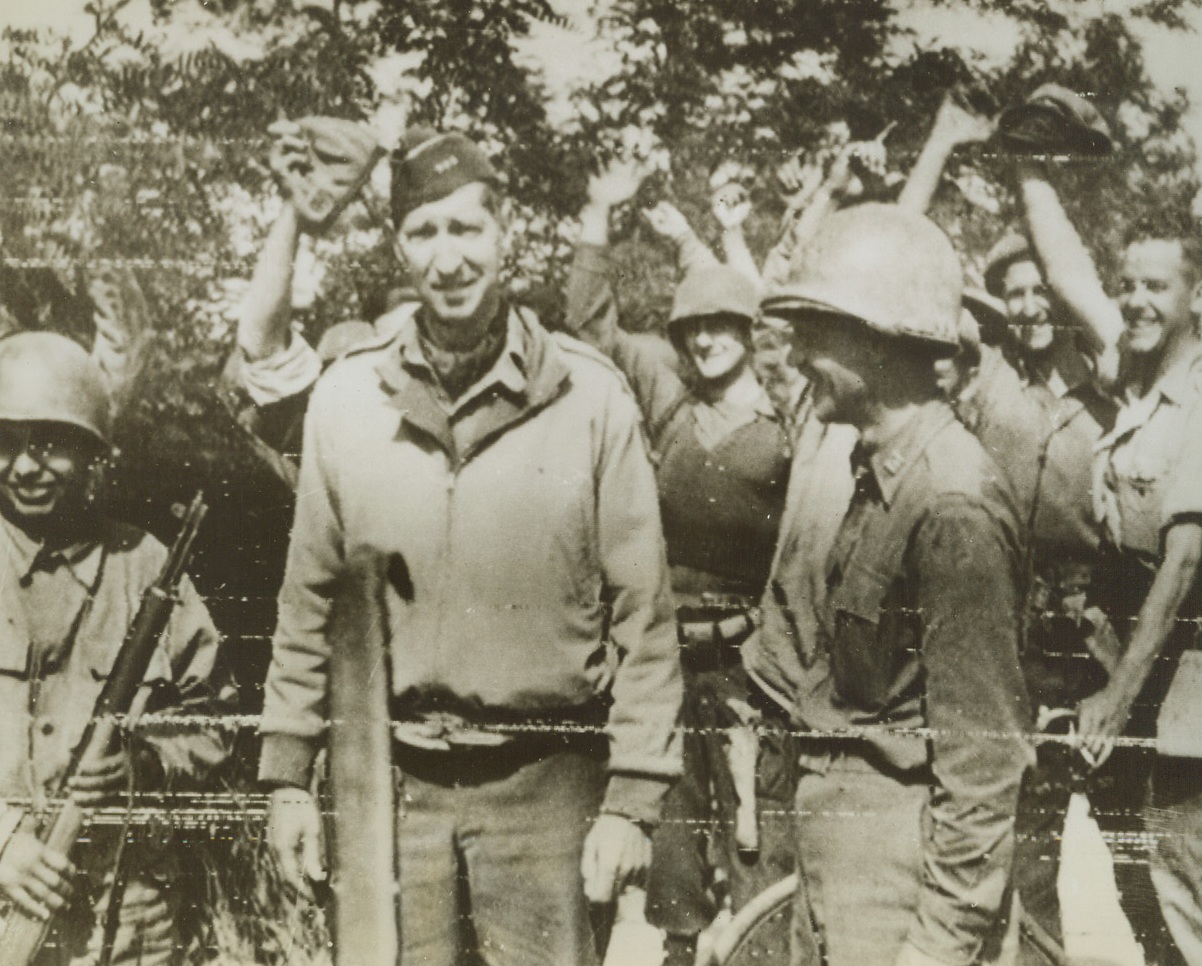
CHEER GEN. CLARK AS TROOPS JOIN, 5/25/1944. ITALY—Gen. Mark Clark is cheered by Yank and British troops surrounding him as the Fifth Army merged its two fronts today for a unified drive on Rome. Gen. Clark, arriving with British troops, was the first American officer to reach the meeting place. Credit: British official photo via OWI Radiophoto from Acme;
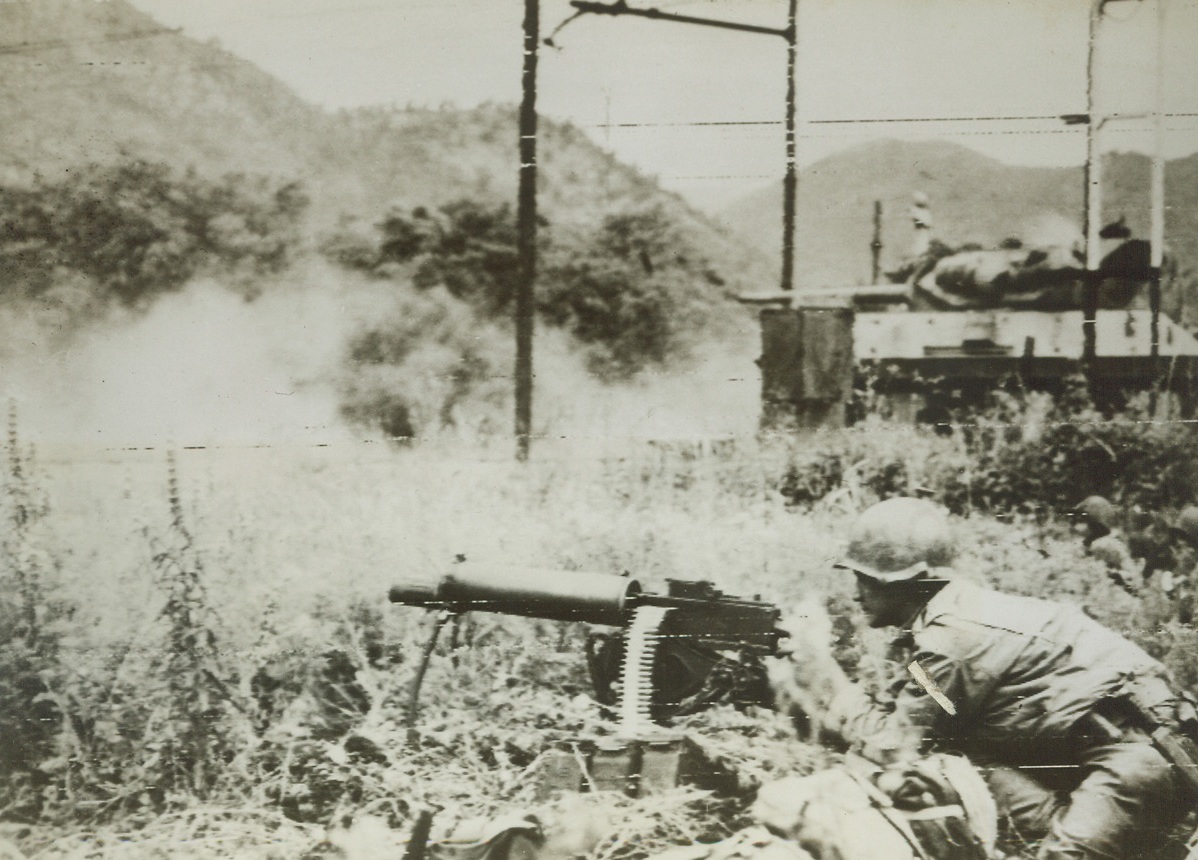
BOTTLING UP THE GERMANS, 5/25/1944. FONDI, ITALY—A M-10 tank destroyer of the American forces fighting with the Allied Fifth Army near Fondi, slams heavy shells into the Mont Orso Tunnel along the west coast electric rail line where Germans were trapped by the Yanks. An American machine gunner, (foreground), helps to blast the enemy out of their hole. Today, American forces driving south from the Anzio beachhead formed a juncture with other U.S. troops heading north from captured Terracina, at Lake Fogliano. Credit: Army Radiotelephoto from Acme;
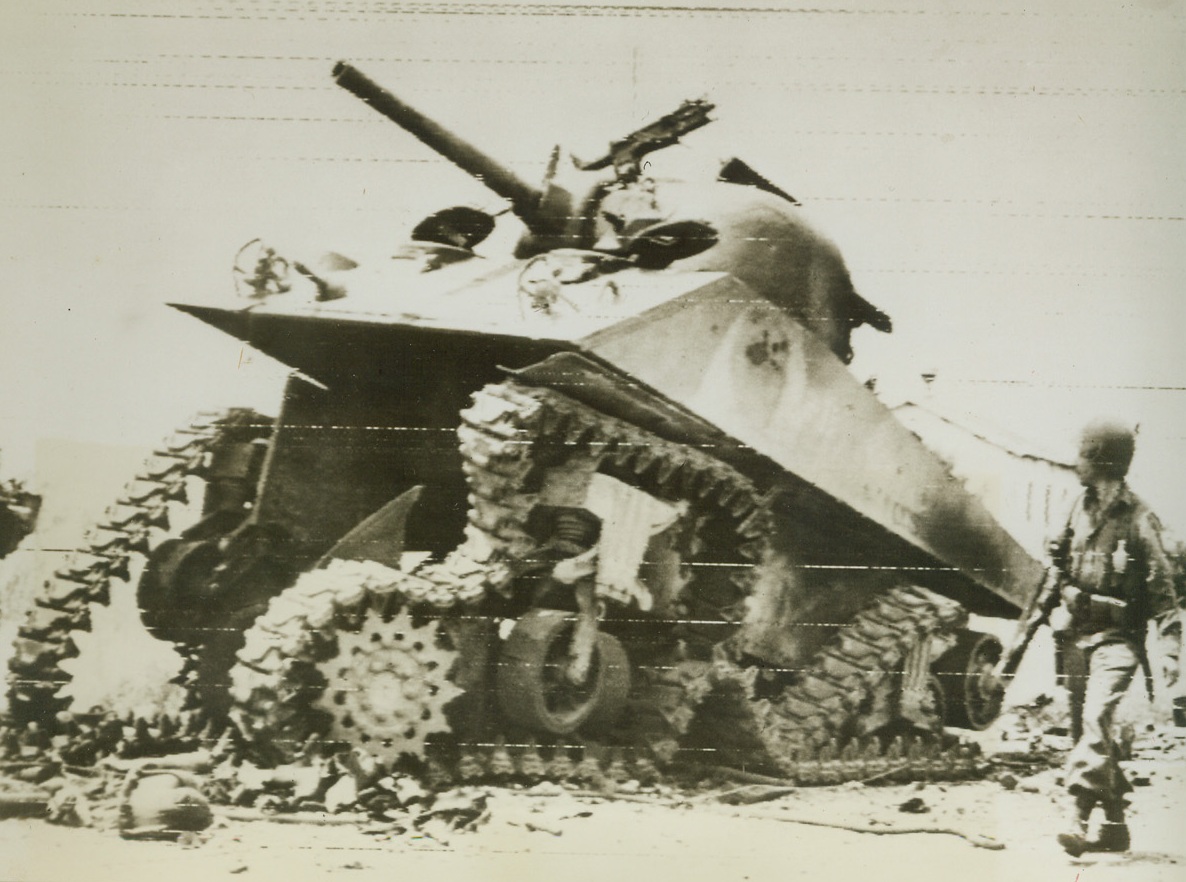
SET BACK ON ITS HEELS, 5/25/1944. ITALY—This American M-4 tank, disabled by a German Teller mine during the renewed offensive on the Anzio beachhead, near Borgo Sabotino, was blasted “back on its haunches” by a demolition charge set by an American patrol so that the monster wouldn’t prove of use to the enemy. Here, an American infantryman looks over the wrecked tank. Credit: Army Radiotelephoto from Acme;
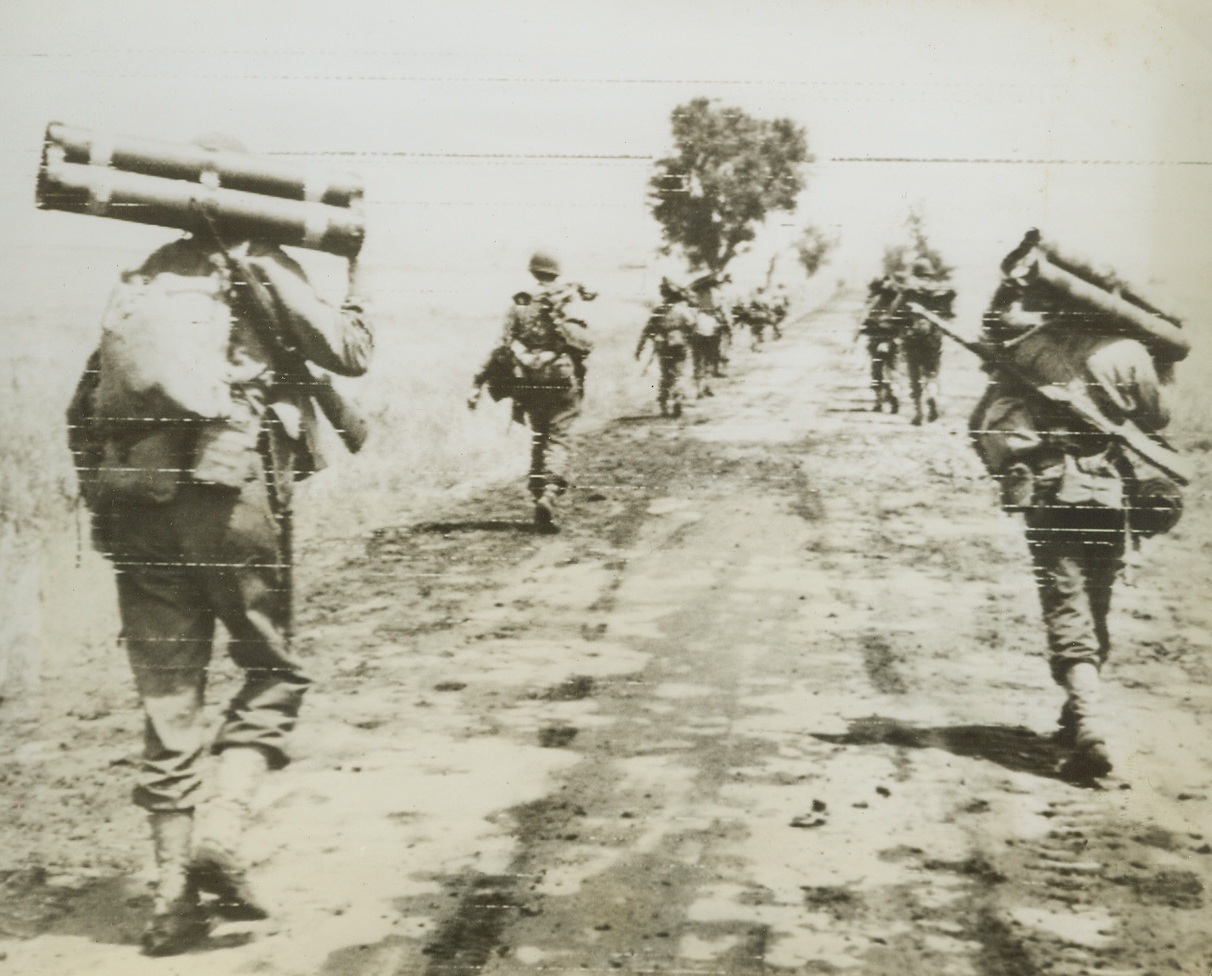
HEADED FOR ROME—WITH A VENGEANCE, 5/25/1944. CISTERNA, ITALY—An American Fifth Army mortar platoon advances in open order, to support troops smashing toward Rome from captured Cisterna in the renewed Anzio beachhead offensive. Today, Anzio forces and Yanks moving north from Terracina, met near Lake Fogliano joining the two fronts. Credit: Army Radiotelephoto from Acme;
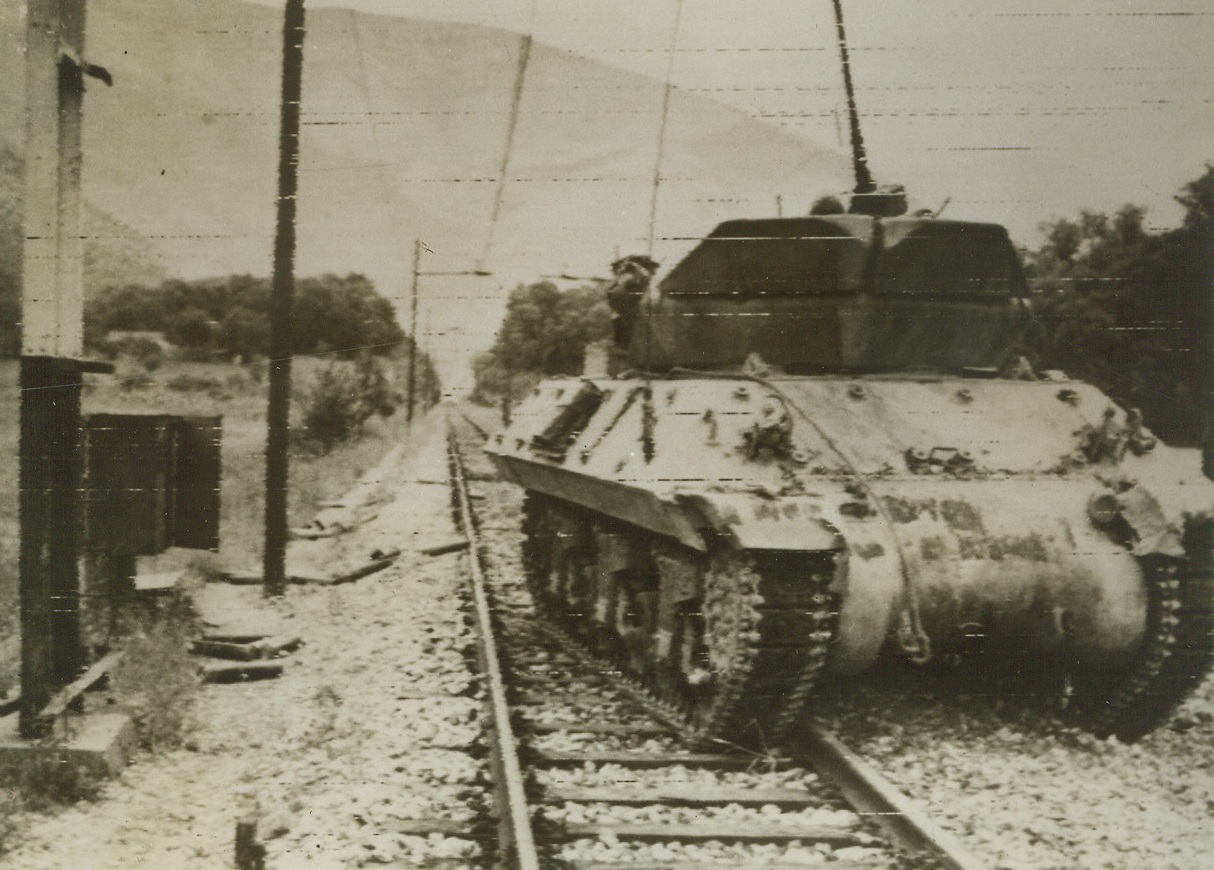
HEADED TO BLAST TRAPPED NAZIS, 5/25/1944. FONDI, ITALY—An American M-10 tank destroyer doubles as an anti-personnel artillery piece, as it moves up to blast Germans trapped in the Mont Orso tunnel of the west coast electric railway near Fondi. Today, U.S. forces of the Fifth Army have moved up to join troops from the Anzio front at a point near Lake Fogliano. Credit: Army Radiotelephoto from Acme;
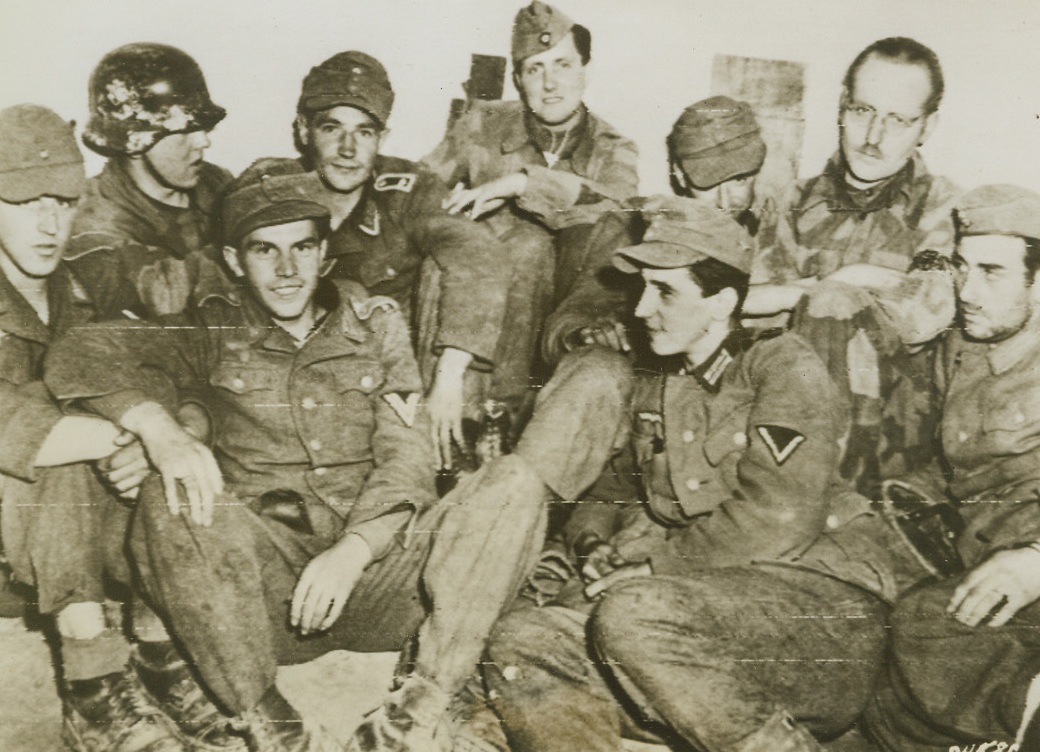
MORE GERMAN PW IN ITALY, 5/26/1944. ITALY—German prisoners of war, captured during the first day’s battle in the new Italian offensive, relax before being marched to the rear and PW compounds. Note German medical man (right) in camouflaged battle dress. Credit: Signal Corps Radiotelephoto from Acme;
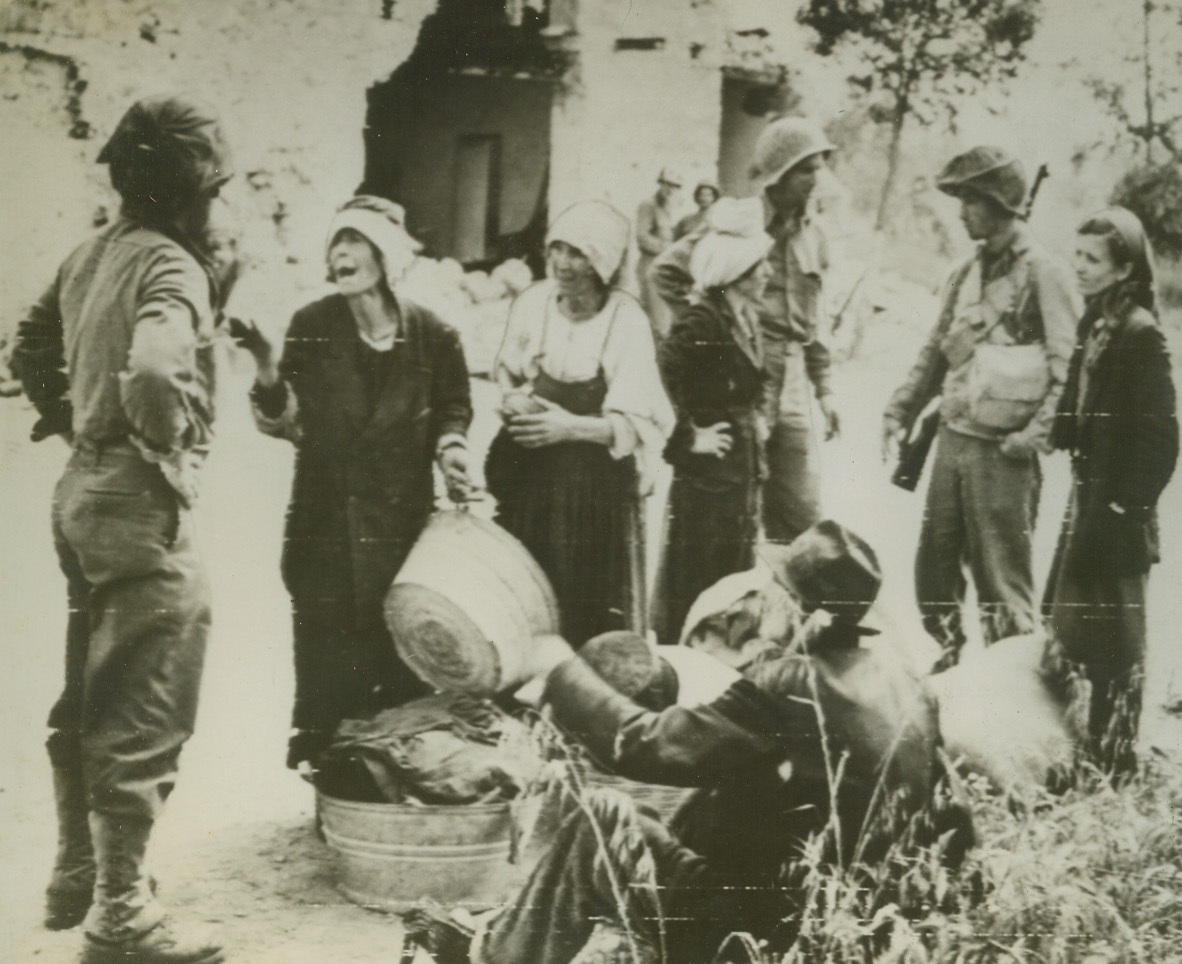
TRIBULATIONS OF AN AMERICAN INFANTRYMAN, 5/26/1944. ITALY—American infantrymen are stopped on the Appian Way and bombarded with questions by confused Italian refugees from nearby Formia. Note the woman on the left gesturing wildly. She wears a man’s double-breasted jacket. Credit: Acme photo by Charles Seawood, War Pool Correspondent via Army Radiotelephoto;
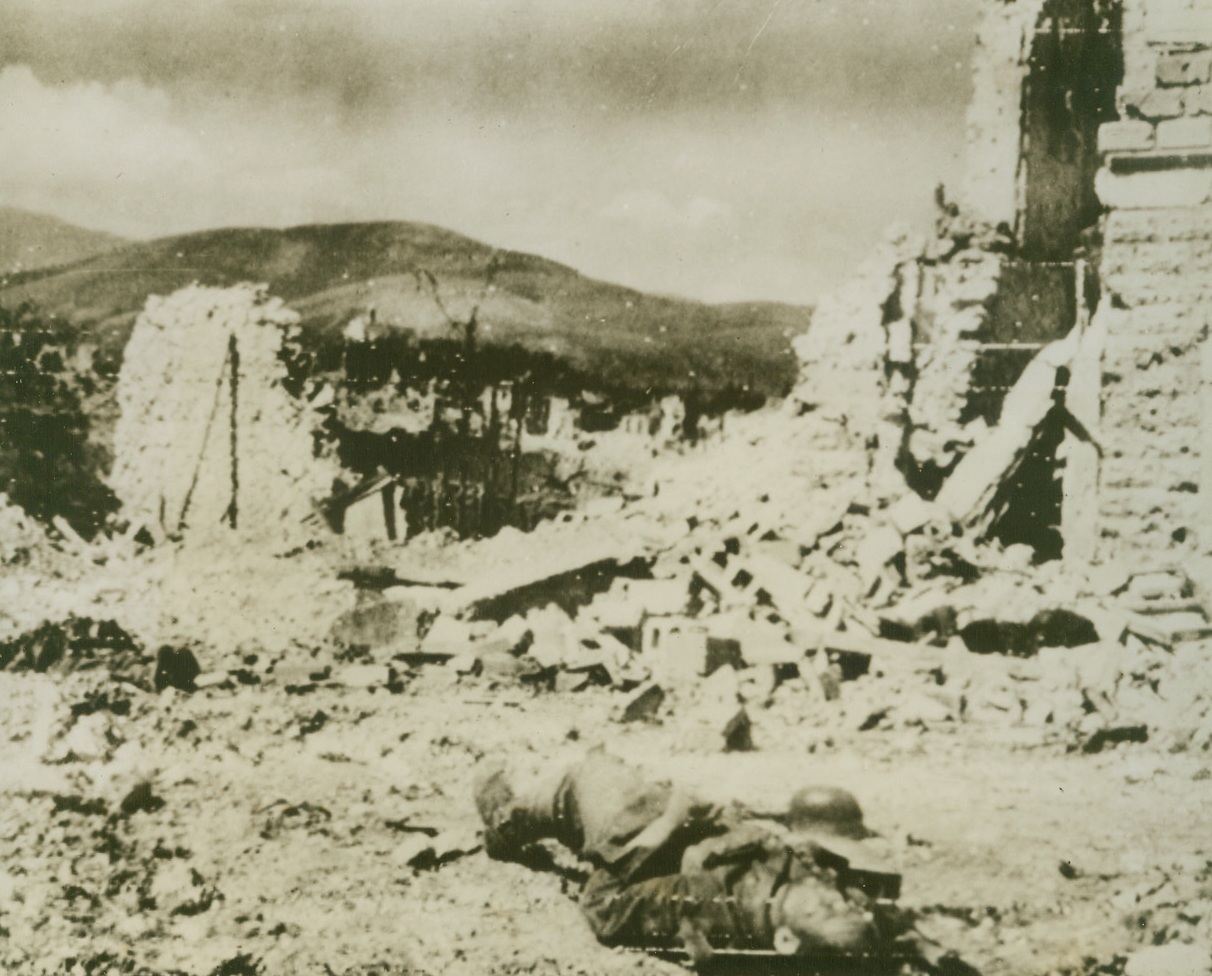
THE PRICE OF GLORY, 5/26/1944. ITALY—The final stages of the Allied march on Rome were started yesterday with the joining of Fifth Army troops in the Pontine Marshes area. In the wake of our forces’ drive are the shell-shattered and bomb-wracked towns that bore the brunt of continuous artillery and aerial assault. The ever forward push in the southeast by British, Canadian, and Polish troops has been climaxed, to date, with the capture of Aquino and Piedimonte. At Tontecorve, below Aquino, dead Germans lie among ruins on the outskirts of the town taken by Canadian soldiers. Credit: OWI Radiophoto from Acme;
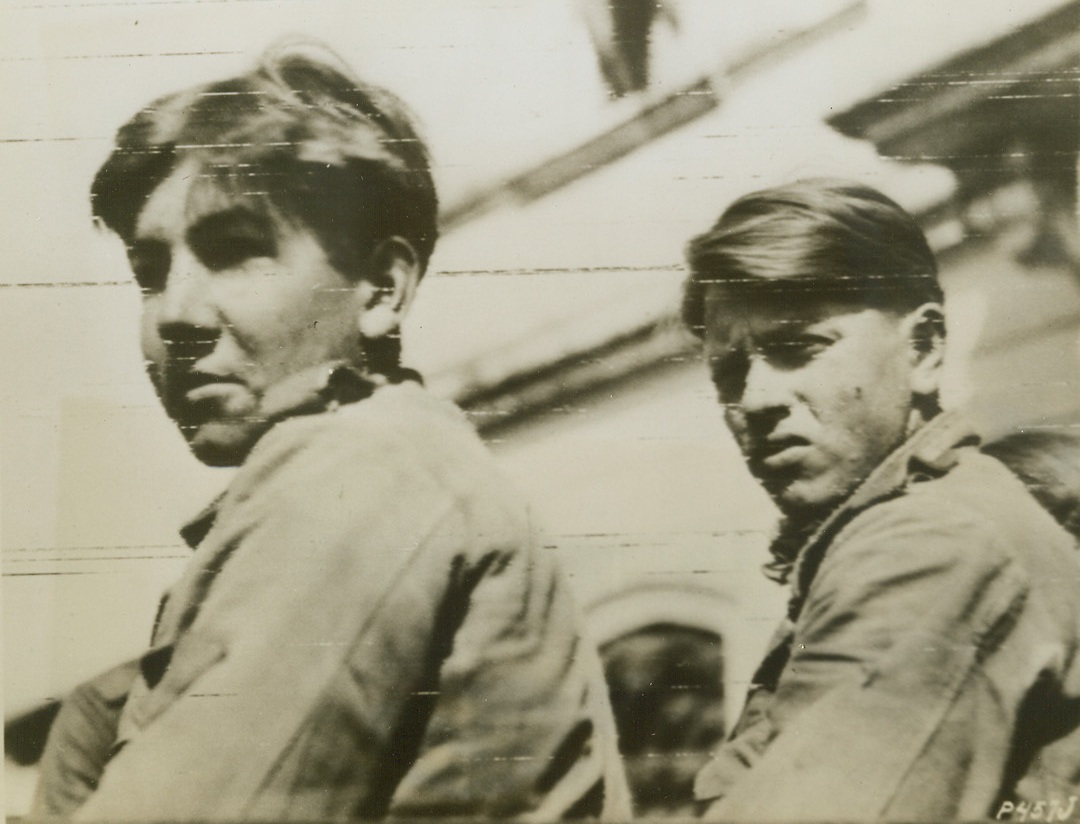
TEEN-AGE GERMAN PRISONERS, 5/26/1944. ITALY—In the current Italian offensive, these teen-age Germans were taken prisoners of war. The youths were captured after bitter fighting near Cisterna. Credit: Army Radiotelephoto from Acme;
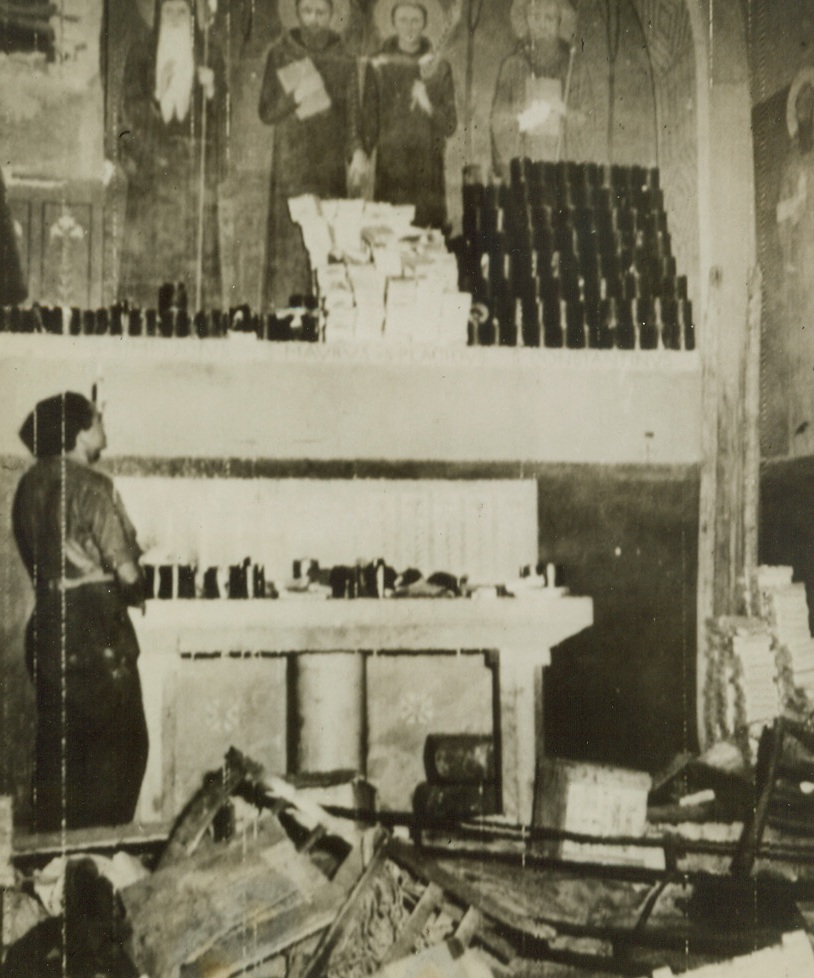
DESECRATION, 5/26/1944. ITALY—Nazis, with no apparent regard for religious significance, stored rations in the Montecassino Abbey. A Polish soldier, candle in hand, looks at paintings of Saints, partly concealed by the German food, above the altar. Credit: Army Radiotelephoto from Acme;
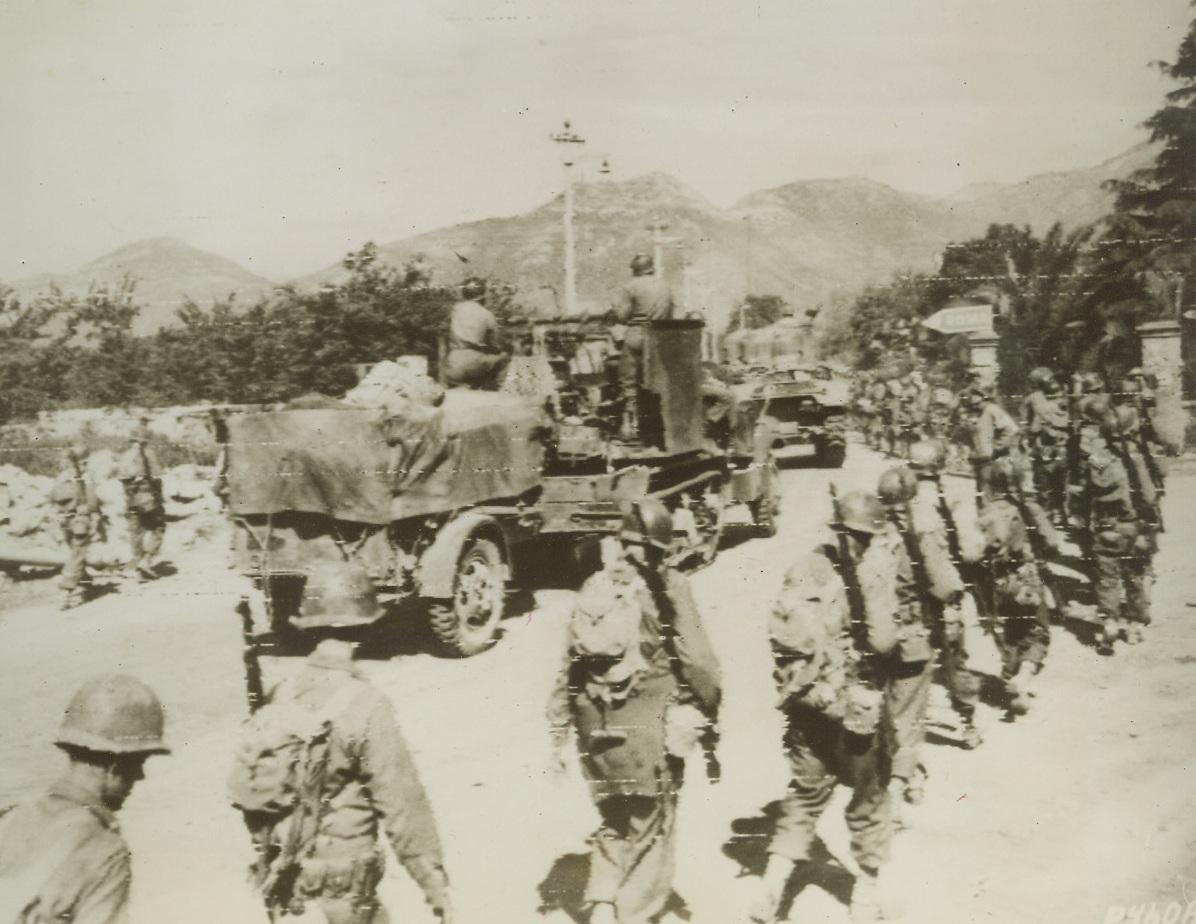
TO ROME!, 5/26/1944. ITALY—All signposts point to Rome, but our Allies full well know the way—they’ve been heading there for months. With the joining of the Anzio beachhead forces and the main front Fifth Army troops, the Allies are now marching swiftly toward the Alban Hills some fifteen miles southeast of Rome, where the Germans apparently hope to make their final stand for the Eternal City. Credit: US Army Radiotelephoto from Acme;
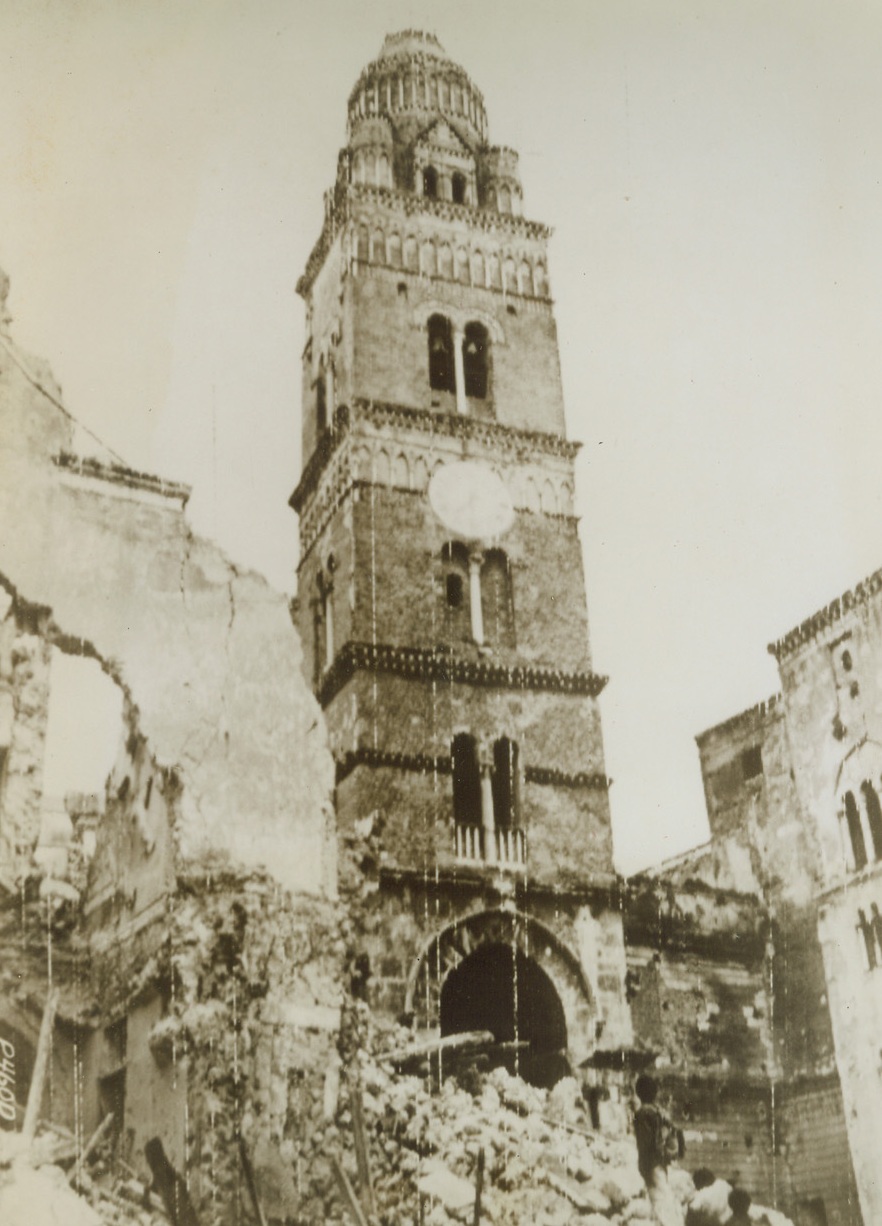
ITALIAN CHURCH ESCAPES MINE BLAST, 5/26/1944. GAETA, ITALY—Curious children stare amazed at the St. Erasmo Church, its pillar reaching high into the sky, unscathed although the buildings around it crumble to the ground after a mine blast in the vicinity of Gaeta. Main front Fifth Army troops in Italy have effected a junction with Anzio beachhead forces and are marching toward Rome from the south, while French and British forces take the northern route toward the Eternal City. Credit: US Army Radiotelephoto from Acme;
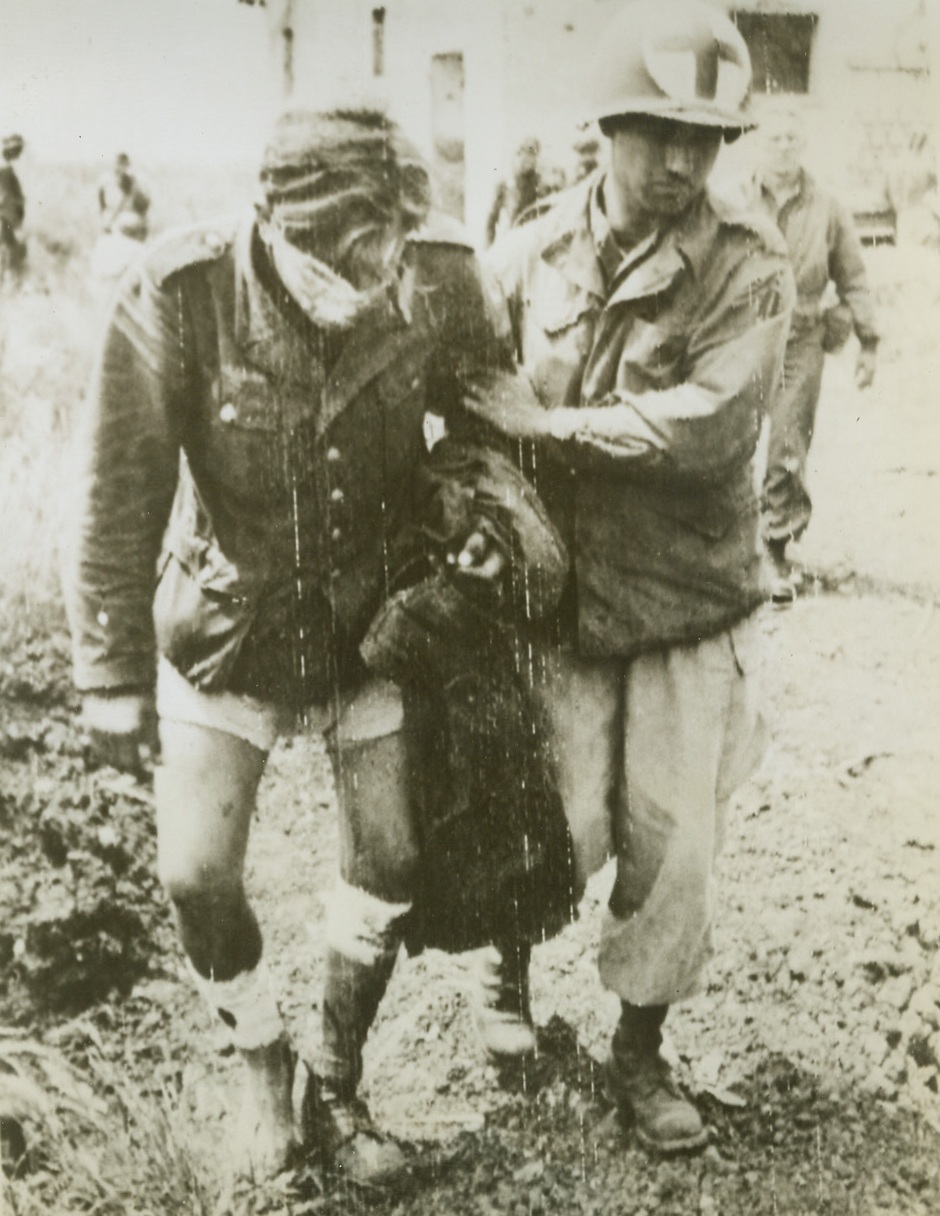
WOUNDED PRISONER GIVEN TREATMENT, 5/30/1944. CISTERNO AREA, ITALY—Wounded in both legs and the face, this German prisoner is assisted to a jeep by a US Medical Corpsman for transportation to a first aid station. The Nazi was captured by Yank forces when they took Cisterno. Allied armies are now within sight of Rome and are pounding at German defenses in the Alban Hills.;
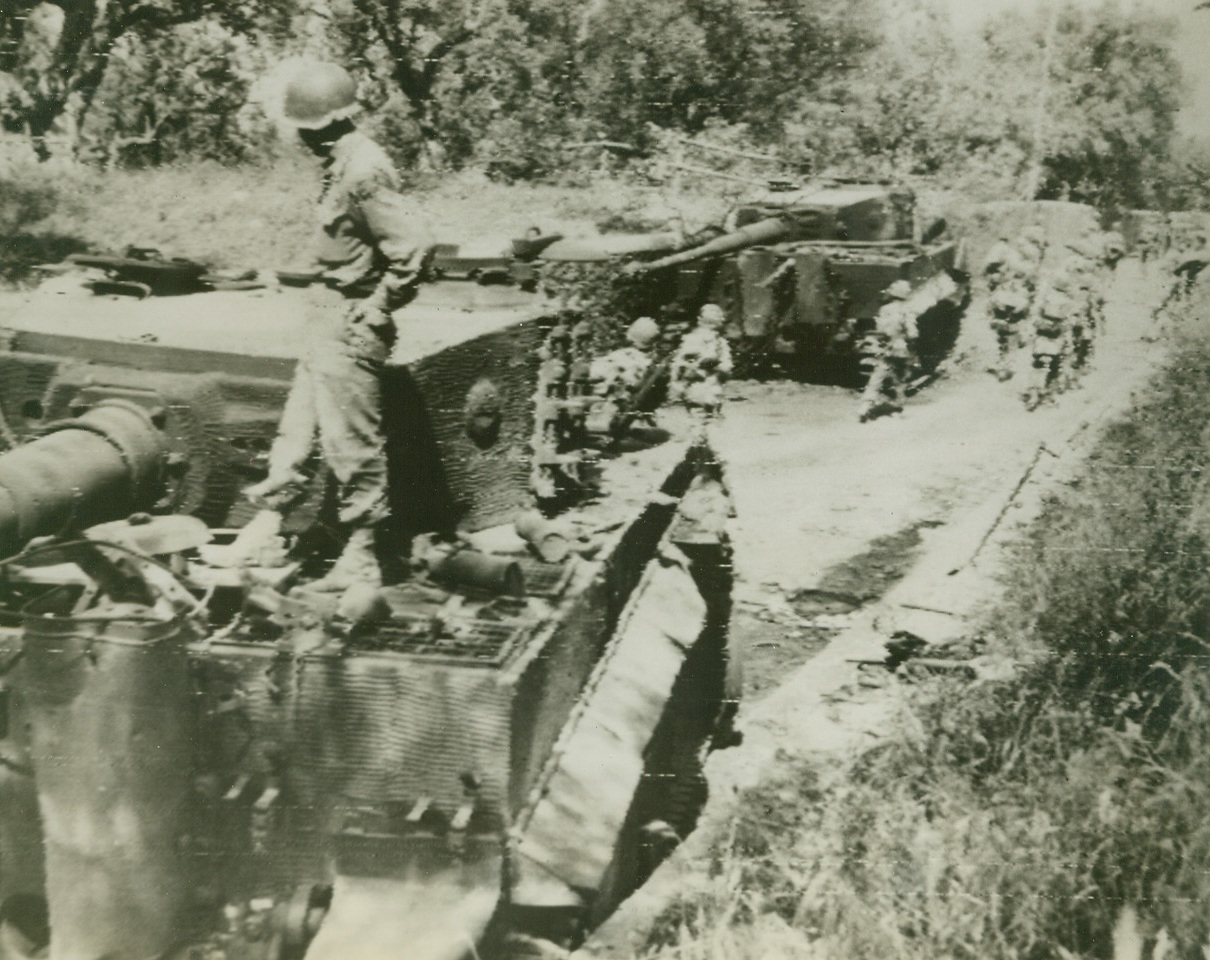
ABANDONED IN FLIGHT, 5/30/1944. CORI, ITALY—Yank infantrymen, advancing into Cori after the German evacuation, pause on the road to examine two knocked out Nazi “Tiger” tanks. Fleeing desperately with the Allies on their heels, the enemy forces left behind volumes of equipment in all stages of disrepair. Allied armies have continued their advance toward Rome, and latest reports state that at least three drives have cut into Nazi defenses in the Alban Hills sector. Credit: Signal Corps Radiotelephoto from Acme;
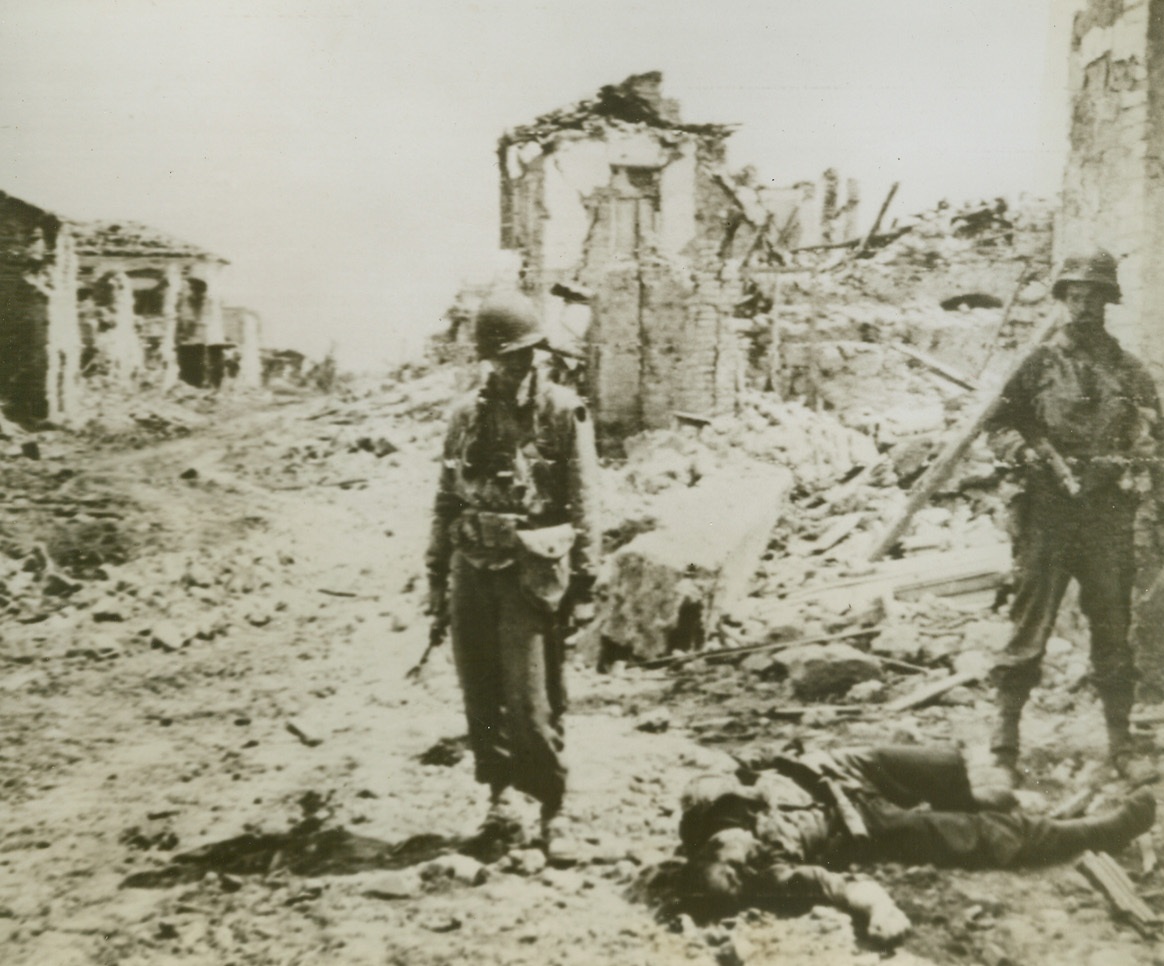
DEATH WITHOUT GLORY, 5/30/1944. CISTERNO, ITALY—This dead German, found by two 5th Army infantrymen in a debris-littered street of Cisterno, gave his life for a hopeless cause. Fighting to the end to hold the Italian key town in the face of Allied assault, he and his comrades finally bowed down and the 5th Army troops took the town. The Allies are now within sight of Rome and smashing into German defenses in the Alban Hills. Credit: US Army Radiotelephoto from Acme;
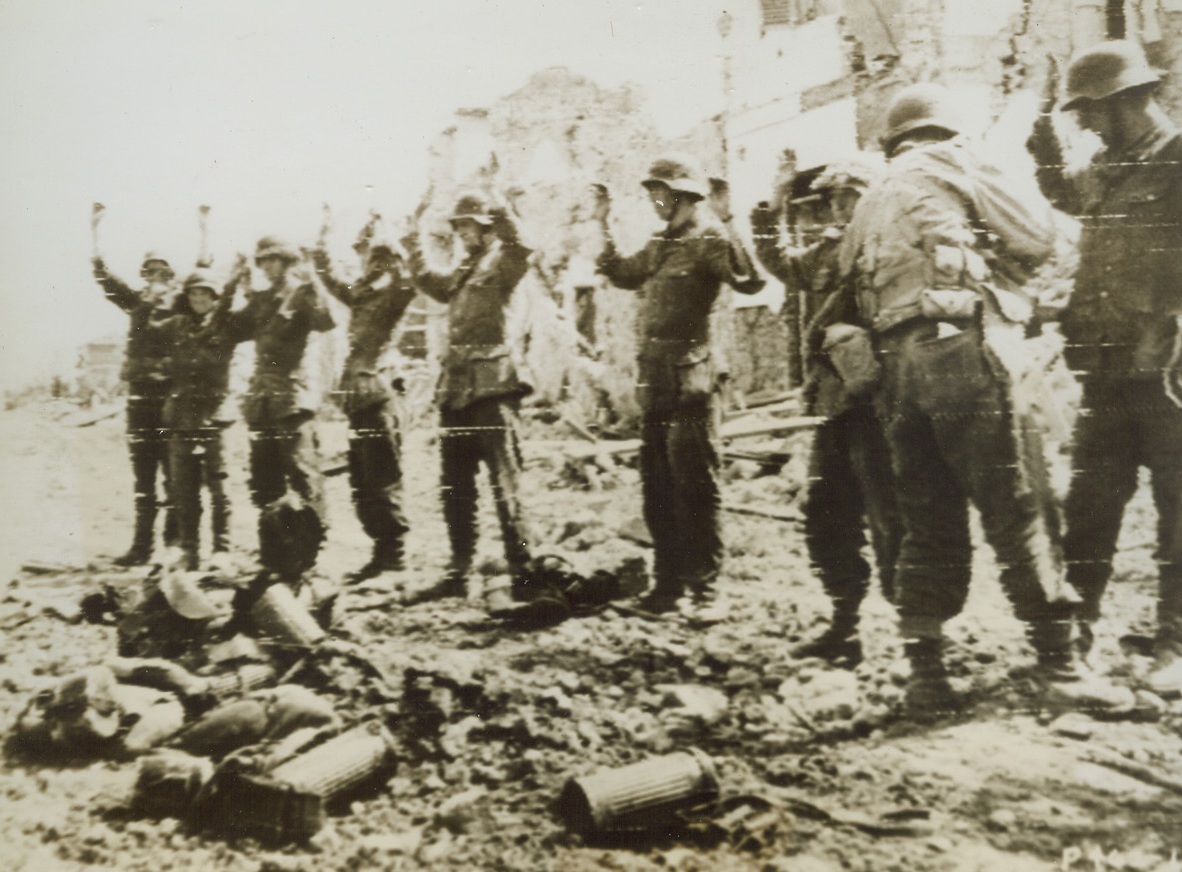
Trapped Nazis, 5/29/1944. CISTERNA, ITALY – Trapped in Cisterna by Infantrymen of the Allied Fifth Army, these Nazi prisoners raise their hands high as our warriors search them for hidden weapons. All of the soldiers in the group were sniping from a ruined building until they ran out of ammunition – then they surrendered. The gear the captives carried with them lies in foreground. Credit Line (U.S. Army Radiotelephoto from ACME);
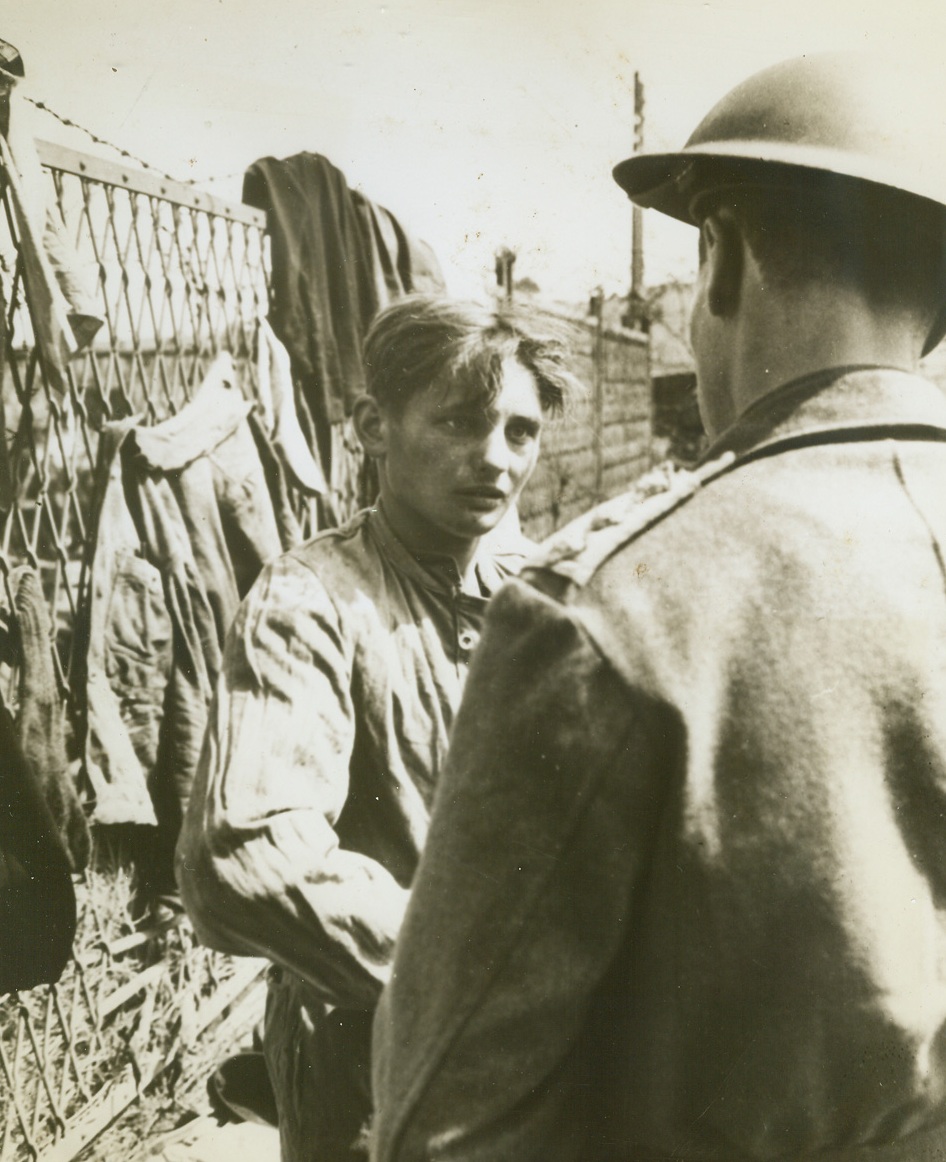
Captured Pilot of Nazi One-Man Sub, 5/31/1944. ITALY -- This 17-year-old German lad, (left), looks frightened and very unhappy as he is questioned by a British captain after his capture in a Nazi one-man submarine at Peter Beach in the Anzio beachhead area. The sub consisted of a driving tube which housed the pilot, and a detachable torpedo slung underneath. As the pilot reached his objective, he released the lethal charge and then piloted the driving tube to safety. Credit Line (U.S. Army Photo from ACME);
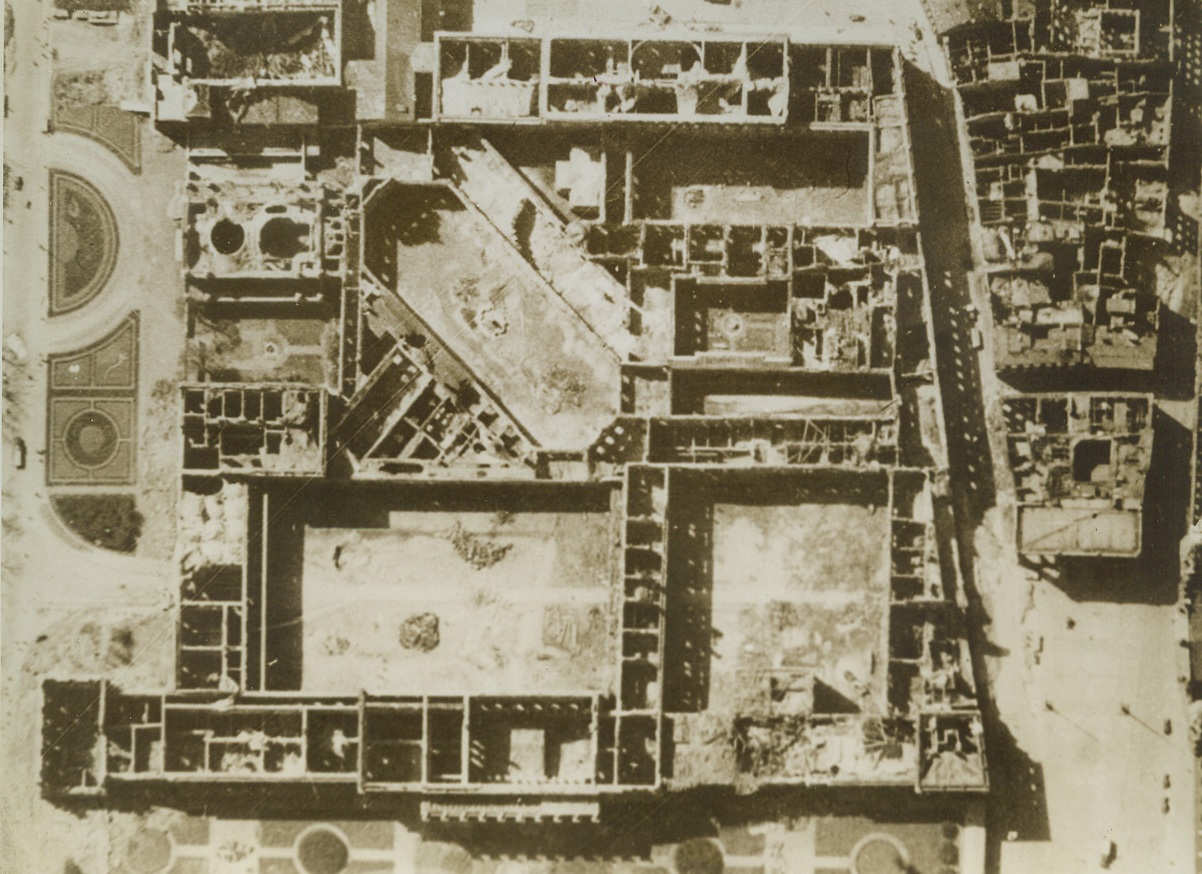
Infamous Meeting Place Blasted, 5/31/1944. GERMANY -- Aircraft of the R.A.F. Bomber Command attacked Munich on the night of April 24/25 completely destroying the Residenz, a group of buildings used by the Nazi Party as a meeting place. This picture taken after the RAF attack shows the Residenz, previously damaged, now completely gutted. At the bottom center is a smaller block of buildings which was also used by the Nazis. Most of the roofs of this small block have collapsed. Credit Line (ACME);
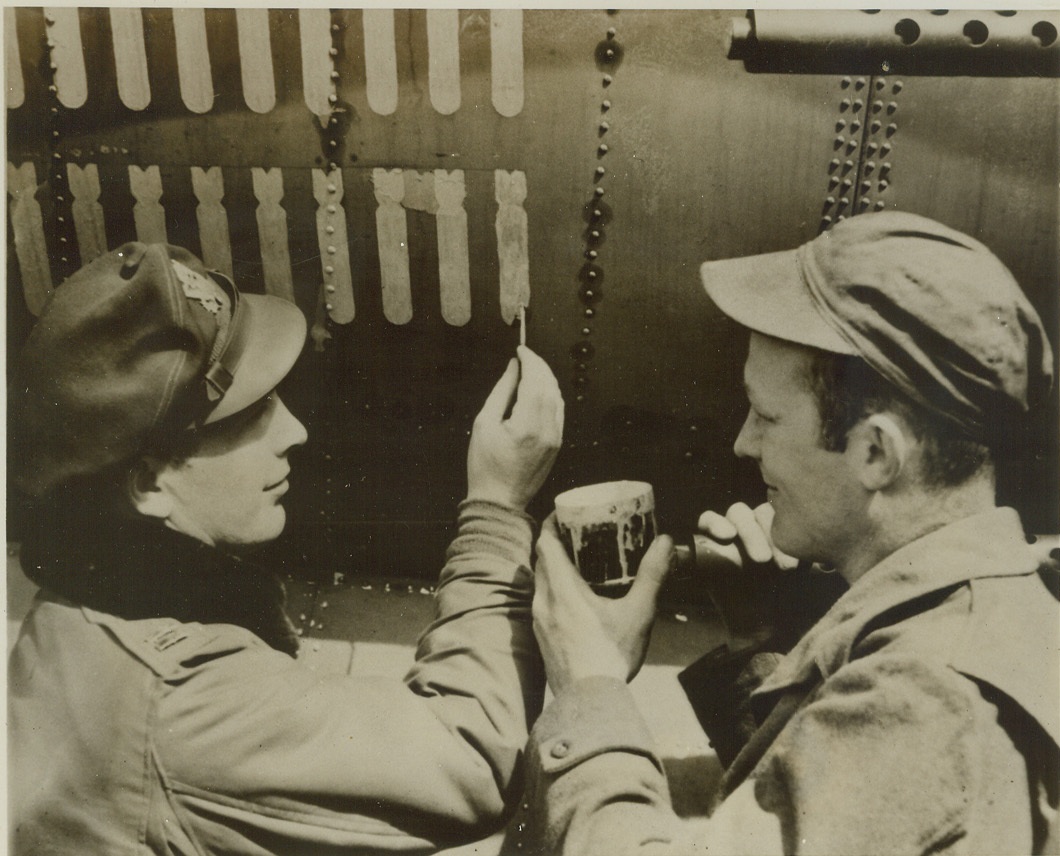
Chalking Up 100th Mission, 5/16/1944. ENGLAND -- Capt. Paul Shannon (left), Attica, Kan., paints 100th bomb symbol on 9th Air Force Marauder medium bomber "Mild and Bitter" at an English base as T/Sgt. William L. Stuart, Donna, Tex., crew chief of the bomber, watches. Stuart has groomed the plane, the first in the E.T.O. to fly 100 missions, for every one of its flights. Credit:-WP-(ACME);
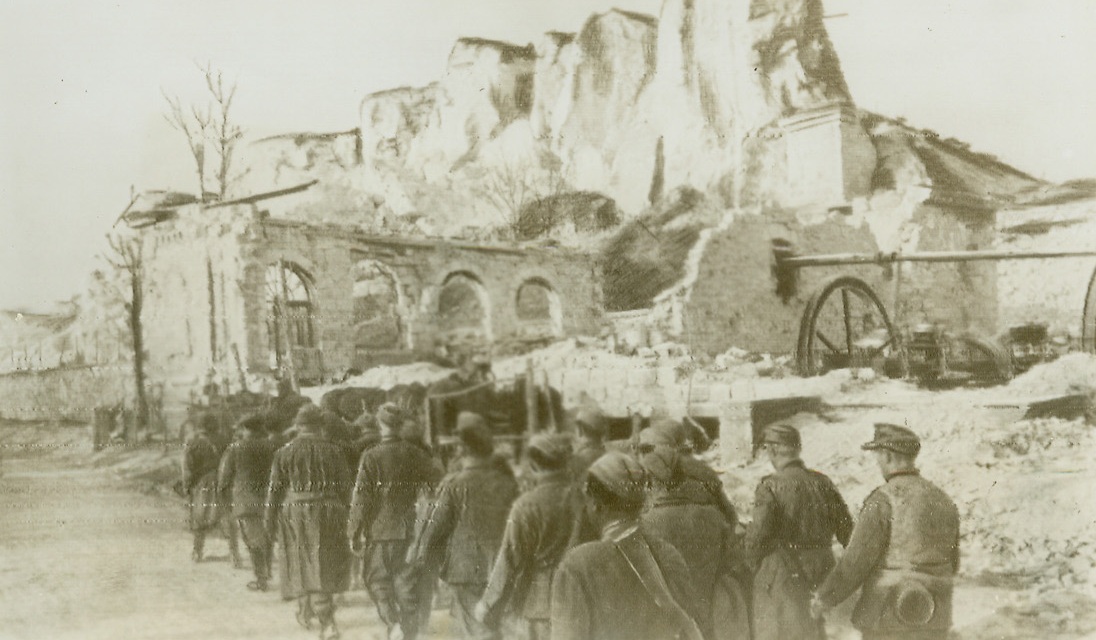
The Bitter Taste of Defeat, 5/14/1944. SEVASTOPAL – German and Romanian prisoners trudge wearily through the battle-scarred streets of Sevastopol, tasting the bitter gall of defeat. Their cherished dreams of becoming masters of the Crimea were shattered forever when hardy Soviet troops stormed the beloved city, after weeks of fighting on the outskirts. Having gone through two sieges – once when the Germans took it form Russian, and again when Russia reclaimed it, Sevastopol is only a shattered wreck of the proud city that once graced the Crimea.Credit (ACME Radiophoto);
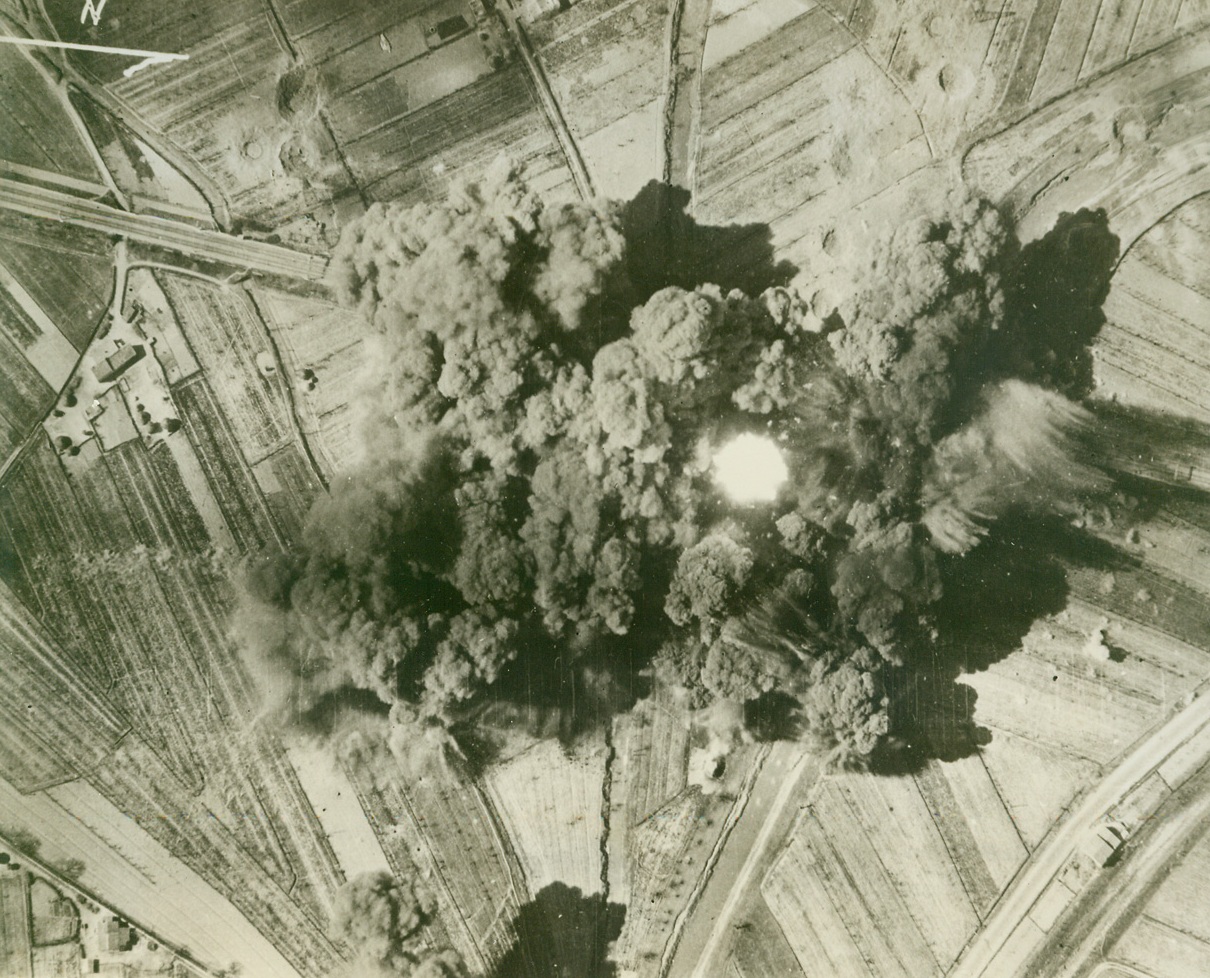
“Operation, Strangle”, 5/14/1944. ITALY – Allied strategy has been at work in Italy since February 18, in an all-out movement to cut off all means of transporting supplies to the Germans on the Anzio and Nettuno fronts. The Mediterranean Allied Air Forces, using B-26 and B-25 medium bombers, P-47’s, and A-36 and P-40 fighter-bombers, has succeeded in winding an impenetrable noose around Central Italy, successfully choking off all German access to reinforcements and supplies. The Air Plan, nicknamed “Operation, Strangle”, consisted mainly of (1) smashing marshalling yards in Central Italy in order to shove all marshalling activity north of the Pisa-Rimini line; (2) using medium and fighter-bombers to cut bridges south of the Pisa-Rimini Line, thus forcing the Hun to use motor transport; (3) hitting the freight-jammed marshalling yards in Northern Italy with heavy bombers; and (4) using light bombers and fighter bombers to strafe motor transport an road bridges in Central Italy. The plan’s success was obvious when, by March 24, no though rail line led to Rome; the closet approach without transshipping was to within 125 miles of the city. Allied pressure on the besiege German forces reached a climax on May 13 when American tanks smashed into Castelforte, southern anchor of the Gustav Line, while along the front Allied troops cracked through the enemy’s outer defenses, capturing nine strategic hills and four towns.New York BureauThere’s a flash of flame, then dense clouds of smoke rolling upward, and B-26 Marauder crews of the 1st Tactical Air Force know that they have scored a direct hit on this supply train crossing a rail bridge near Ficculle, 50 miles north of Rome on the line to Florence. This objective in the “Operation, Strangle” plan of the MAAF was destroyed on April 6, and marked another successful venture in the Allies’ plan to cut off supplies from German forces on the Anzio and Nettuno fronts.Credit (Official USAAF Photo from ACME);
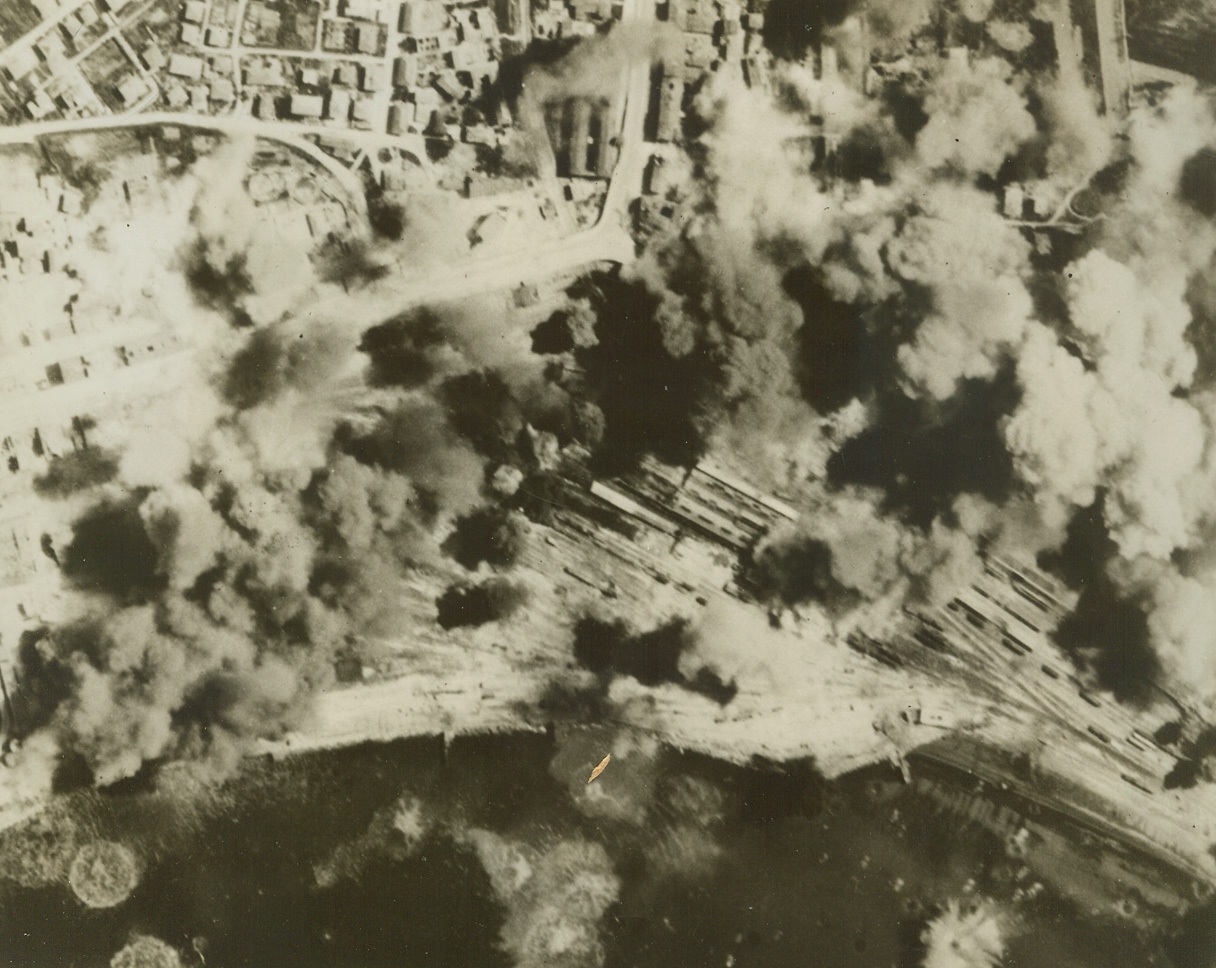
“Operation, Strangle”, 5/14/1944. ITALY – Allied strategy has been at work in Italy since February 18, in an all-out movement to cut off all means of transporting supplies to the Germans on the Anzio and Nettuno fronts. The Mediterranean Allied Air Forces, using B-26 and B-25 medium bombers, P-47’s, and A-36 and P-40 fighter-bombers, has succeeded in winding an impenetrable noose around Central Italy, successfully choking off all German access to reinforcements and supplies. The Air Plan, nicknamed “Operation, Strangle”, consisted mainly of (1) smashing marshalling yards in Central Italy in order to shove all marshalling activity north of the Pisa-Rimini line; (2) using medium and fighter-bombers to cut bridges south of the Pisa-Rimini Line, thus forcing the Hun to use motor transport; (3) hitting the freight-jammed marshalling yards in Northern Italy with heavy bombers; and (4) using light bombers and fighter bombers to strafe motor transport an road bridges in Central Italy. The plan’s success was obvious when, by March 24, no though rail line led to Rome; the closet approach without transshipping was to within 125 miles of the city. Allied pressure on the besiege German forces reached a climax on May 13 when American tanks smashed into Castelforte, southern anchor of the Gustav Line, while along the front Allied troops cracked through the enemy’s outer defenses, capturing nine strategic hills and four towns.New York BureauAllied B-17’s did a double job when they hit this rail and port target at Ancona on the Adriatic Coast of middle Italy. Bombs smashed into the rail lines and crippled ships in the harbor, striking another fierce blow on the already-diminishing sources of Nazi supplies.Credit (Official USAAF Photo from ACME);
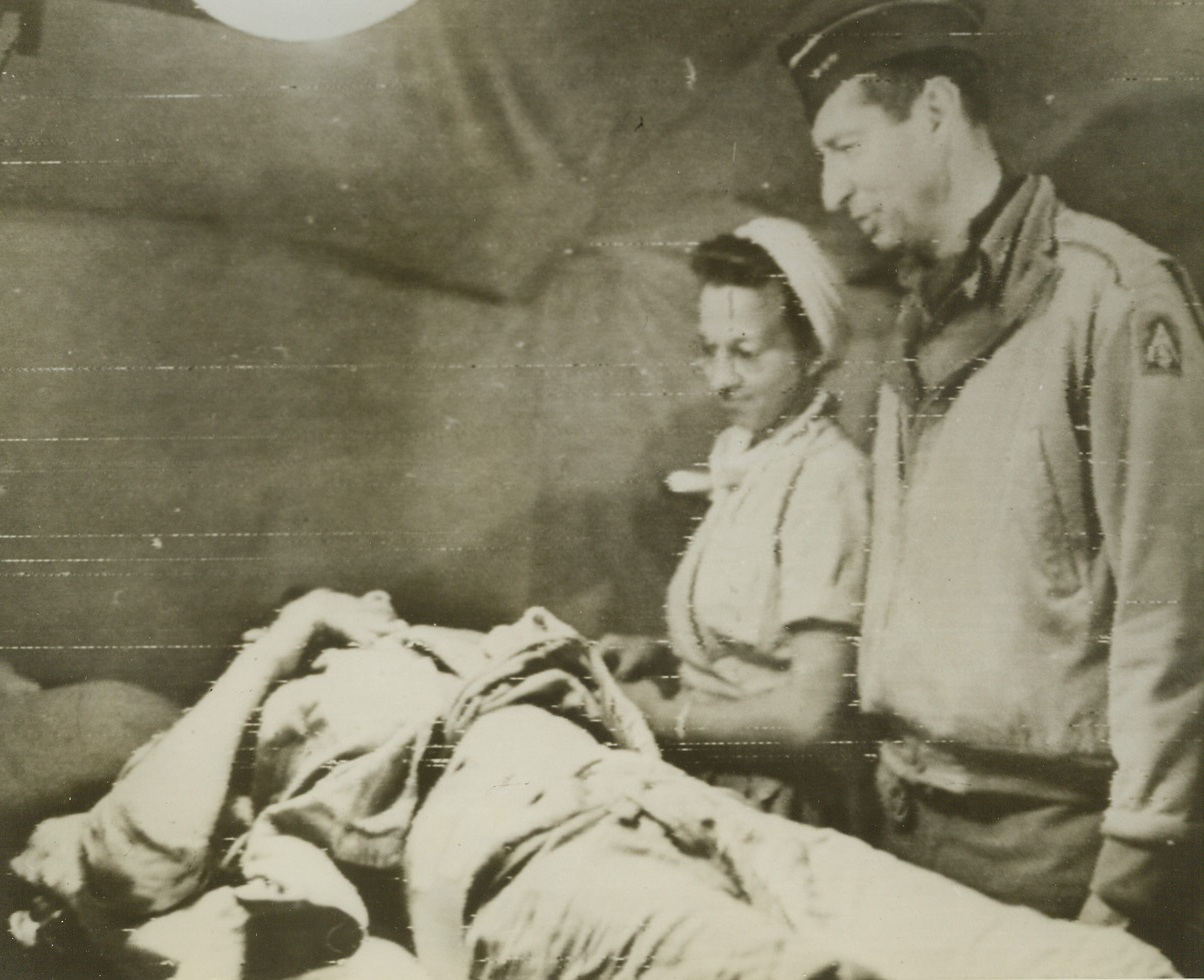
Four Star Sympathy, 5/29/1944. SOMEWHERE IN ITALY – Flat on his back after being treated for wounds received in the battle of Cisterna, an American soldier is visited by his “chief” – Lt. Gen. Mark W. Clark, commander of the Allied Fifth Army. The General chats with the felled fighter as a nurse looks on.Credit (U.S. Army Radiotelephoto from ACME);
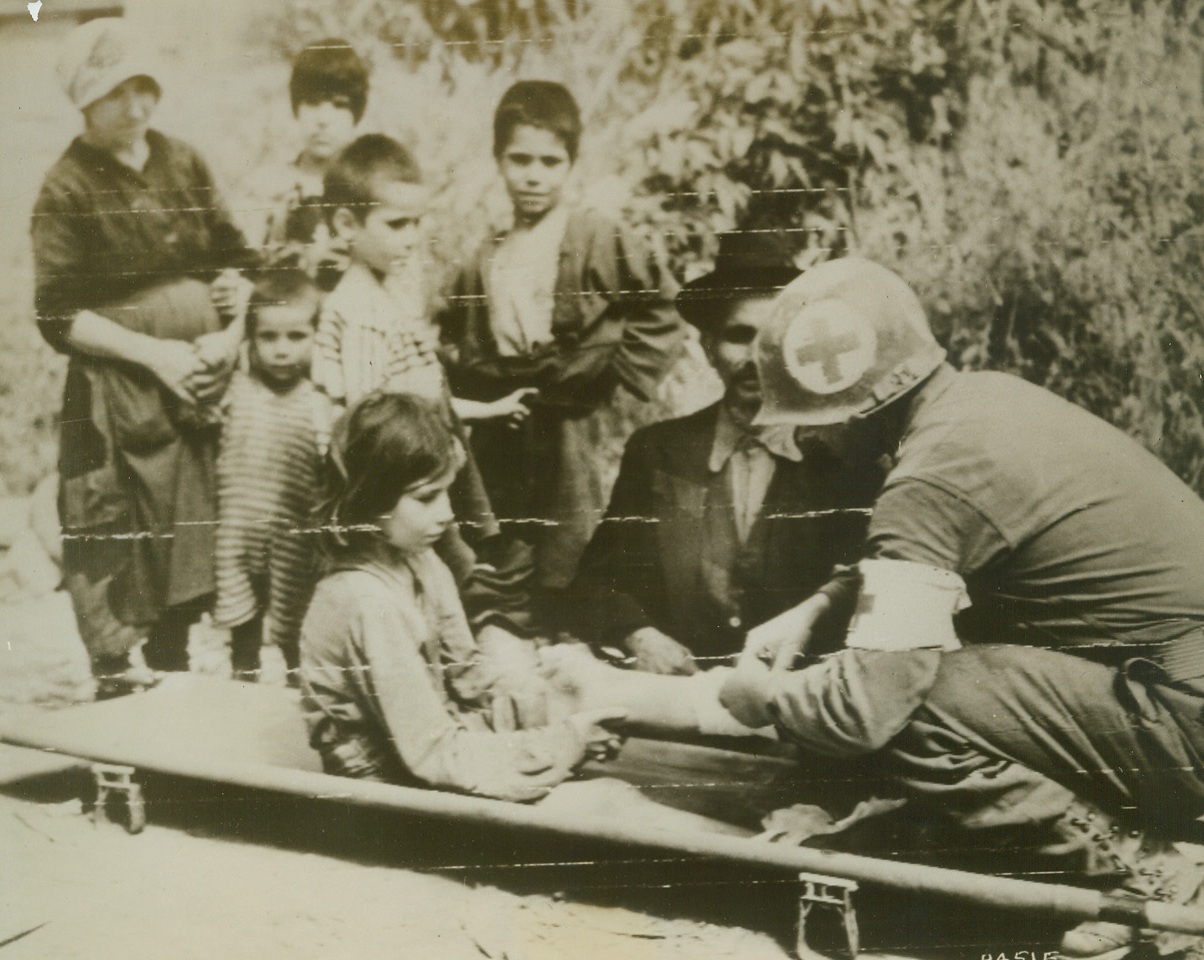
With the Greatest of Care, 5/18/1944. ITALY – A member of the U.S. Army Medical Corps tenderly and gently dresses the leg of a young Italian girl who was wounded in the Castelonorato area during the latest drive. This photo was flashed by Army Radiotelephoto.Credit (U.S. Army Radio from ACME);
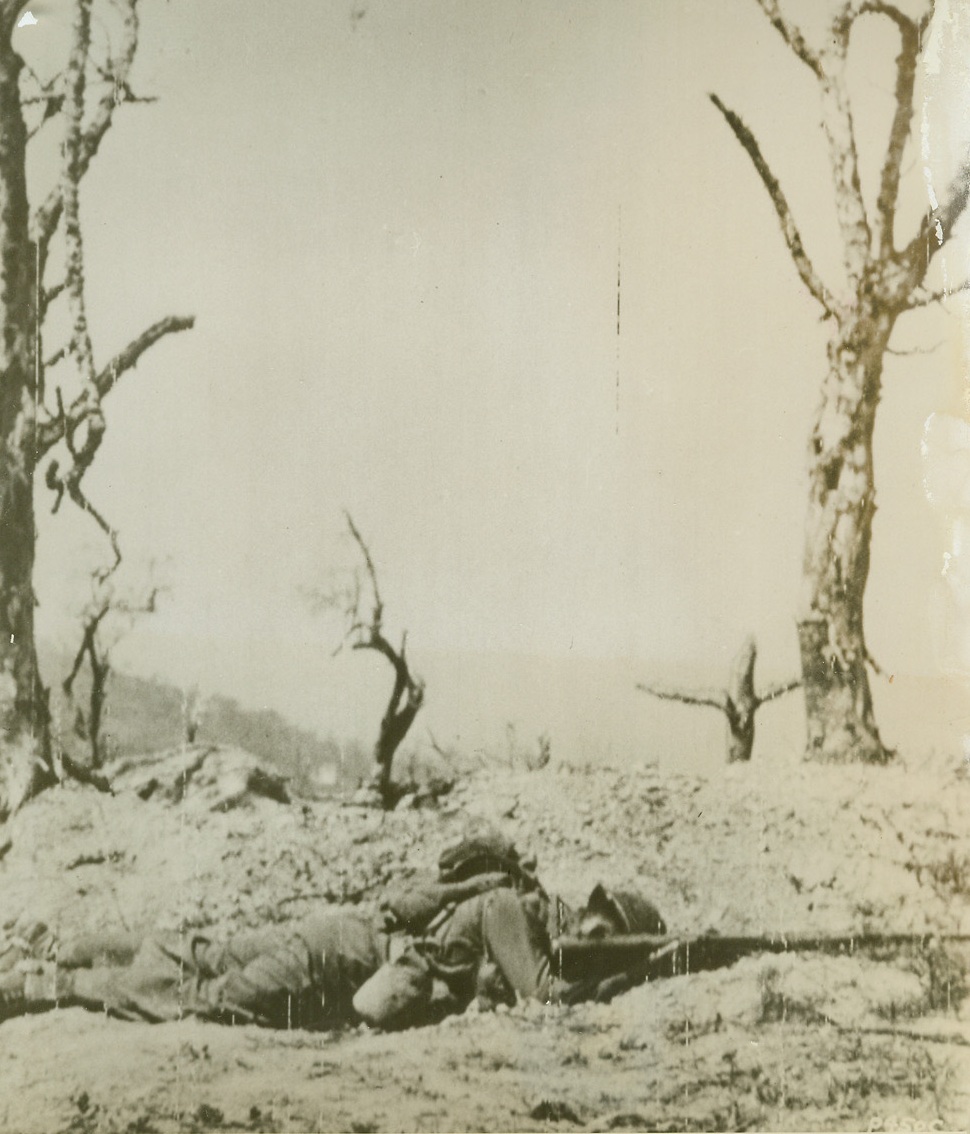
For Freedom’s Sake, 5/18/1944. ITALY – With his rifle still clenched in lifeless hands, an unnamed Allied infantrymen lies as he died in a position of combat – fighting for the liberation of mankind from the forces of Fascism. He was killed by enemy mortar fire in the assault on Santa Maria, Italy. In the background a shell- scarred tree forms a crude cross lending a reverent touch to the desolate scene.Credit: (US Army Radiotelephoto from ACME);
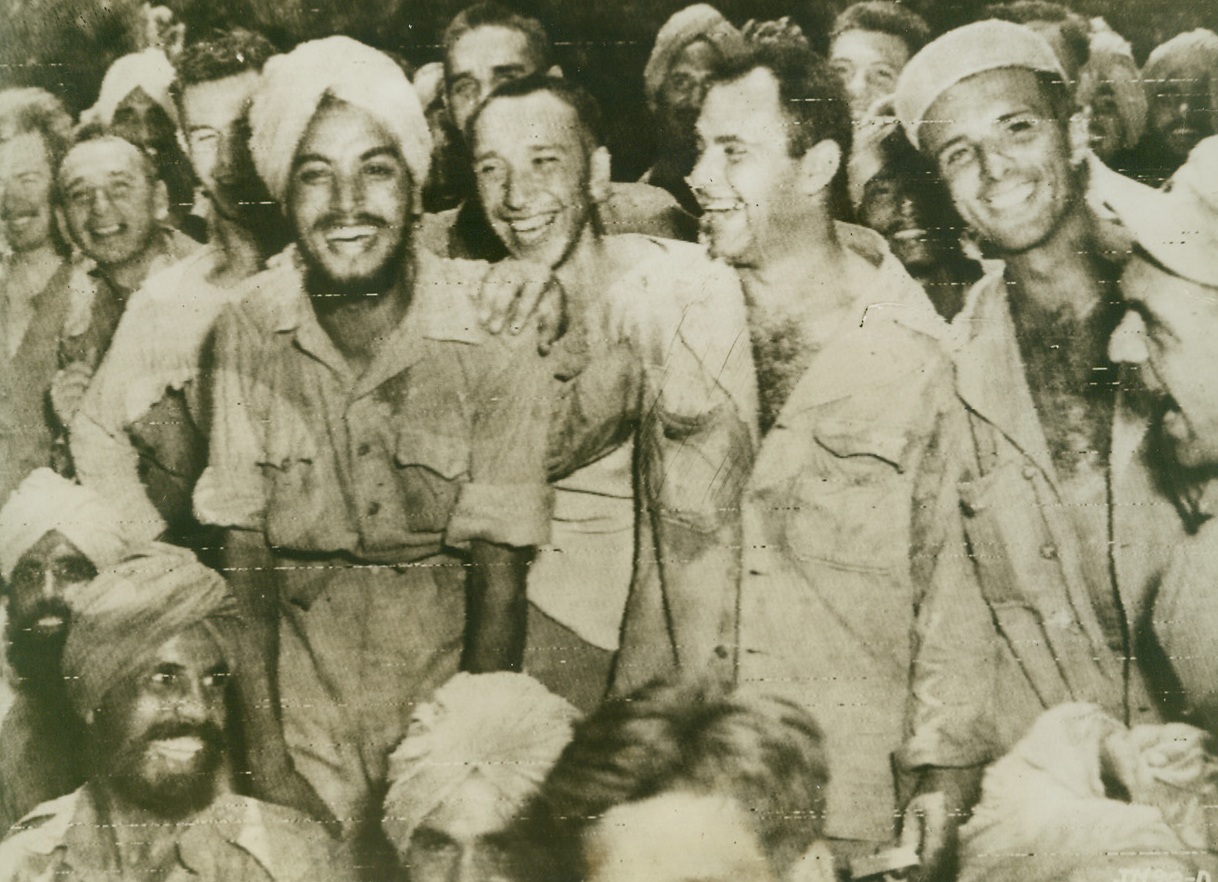
HAPPY DAY, 5/13/1944. NEW GUINEA—Turbaned Indians of the “Sikh” troops grin joyously as they get acquainted with Yanks at a base in New Guinea. The Indian soldiers, captured at Singapore and formed into labor battalions by the Japs in the Admiralties, were liberated by Gen. MacArthur’s invading forces. The remarkable success of the Allied invaders has made it a happy day for Sikhs and Yanks alike, and their broad grins bear this out. Credit (US Army Radiotelephoto from ACME);
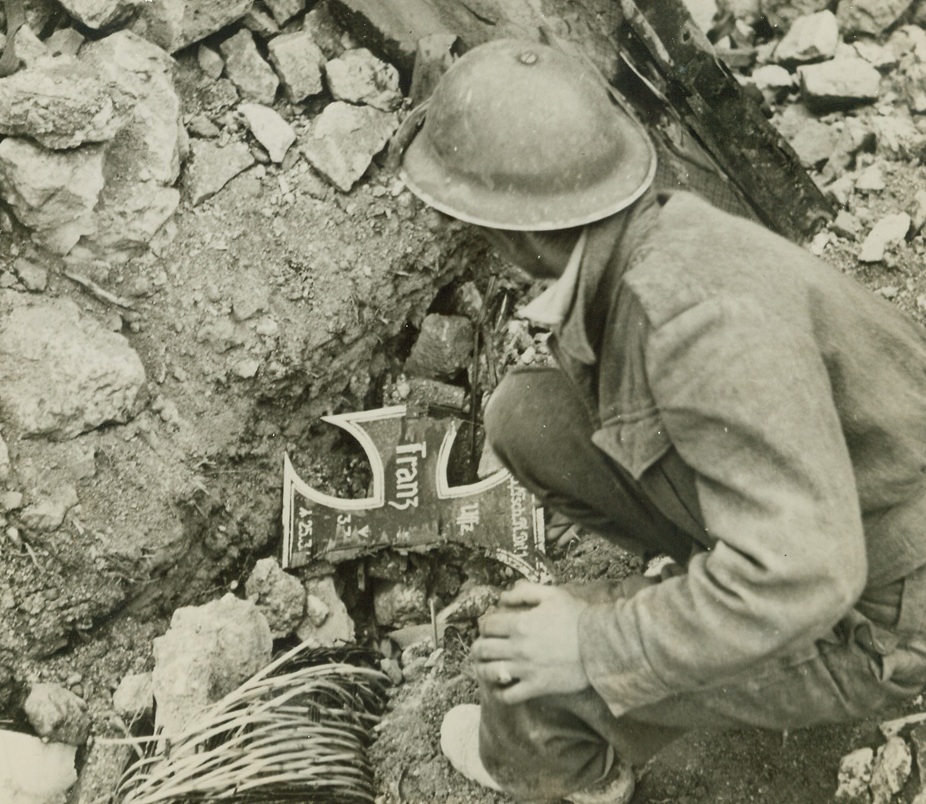
GRAVE IN RUINS OF MONASTERY, 5/25/1944. CASSINO, ITALY—an Allied soldier stoops to examine the grave of a Nazi warrior whose body lies beneath a pile of broken glass and rubble amid the ruins of the famous Benedictine monastery. Used as a fortress by the Germans, the ancient house of worship was the target for long and intense Allied aerial and long range artillery bombardment. Credit Line—WP—(ACME);
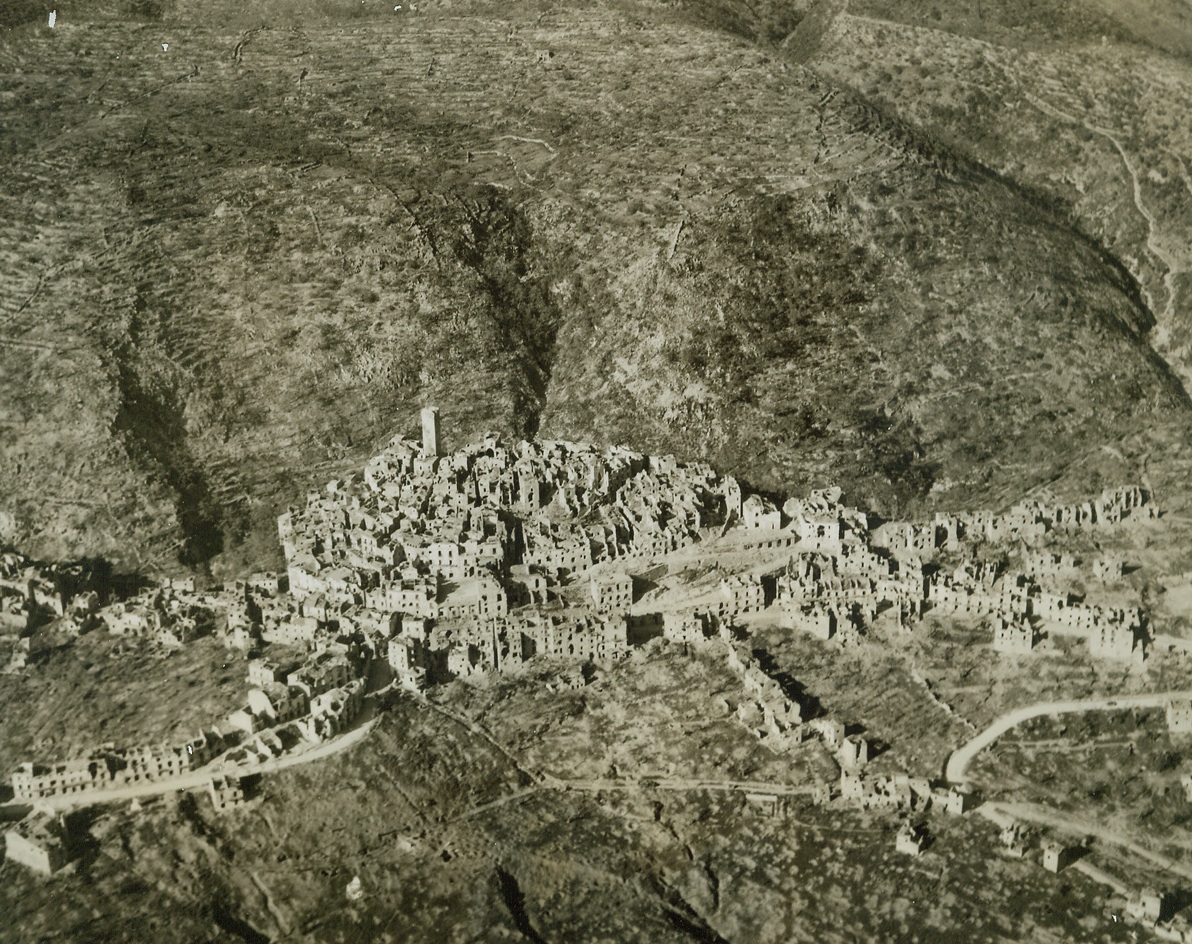
Stepping Stone to Rome, 5/25/1944. ITALY—Castleforte lies tranquilly in its mountain location in Italy after being shelled heavily by Allied artillery. The town fell to our forces early in the concerted march to Rome—hitting on all gears now. Credit-WP-(ACME Photo by Charles Seawood, War Pool Correspondent);
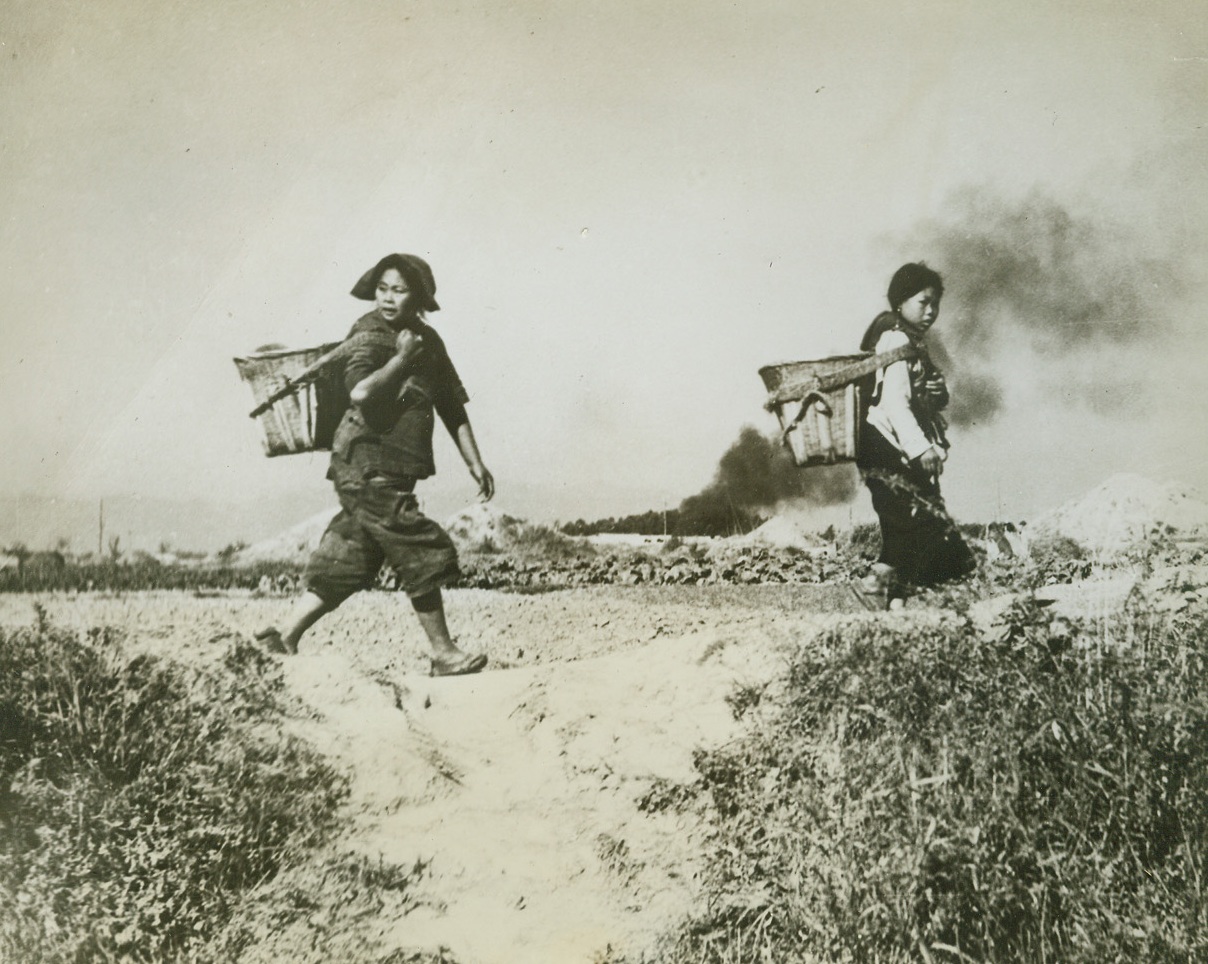
”Jing Bow! – Jing Bow!”, 5/9/1944. Somewhere in China – As the warning cry of “Jing Bow” echoes through the area, the Chinese peasants hurriedly leave the field on which they have been working, running to the nearest shelter.Chinese for “air raid,” the cry is one that every Chinese has learned to obey at a moment’s notice. P-40 Fighters were rushing to meet the attacking enemy planes as the warning was given, and a plane, already downed, sends up a black pall of smoke as it burns in the background. Credit: U.S. Army official photo from ACME;
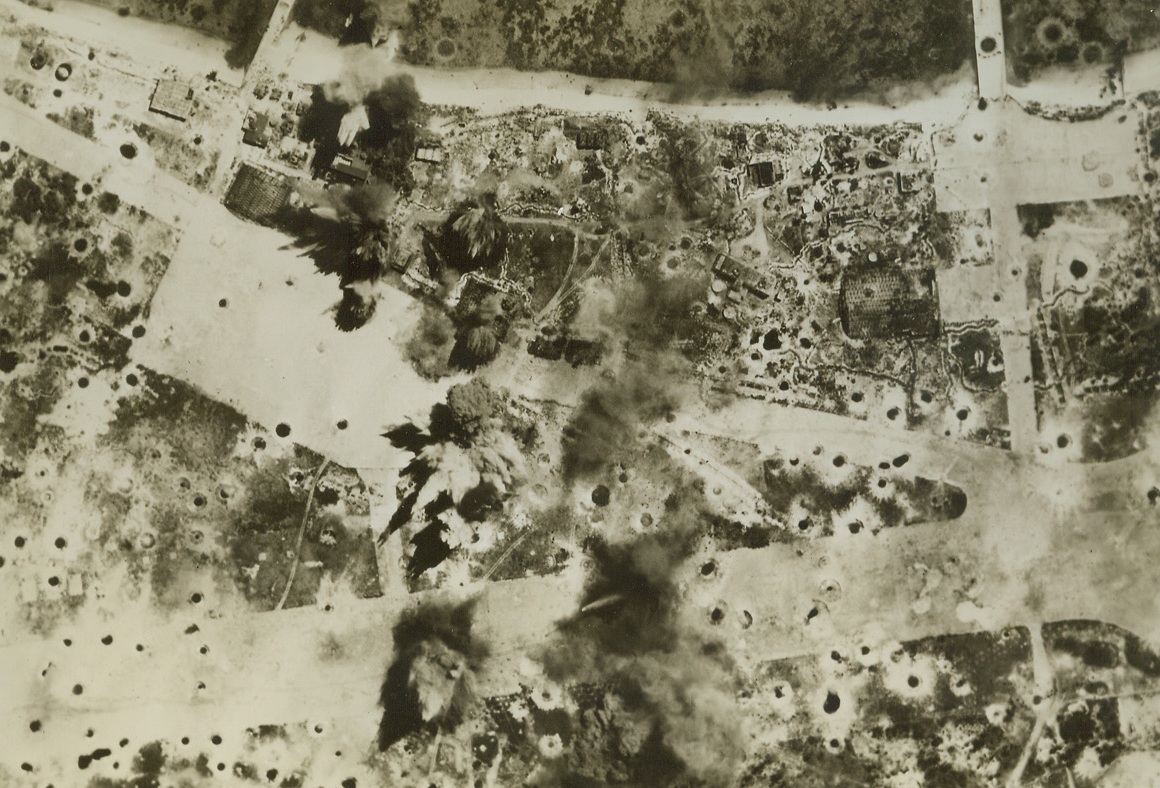
Practice Bombing – The Real Thing, 5/10/1944. Central Pacific – Bombs pock mark an air strip on one of the few remaining Jap bases in the Marshalls, one of the most heavily bombed spots in the world. These islands, not further identified by the Navy, are now being attacked thrice daily as part of a battle indoctrination program for new 7th AAF bomber crews. Credit: USAAF photo from ACME;
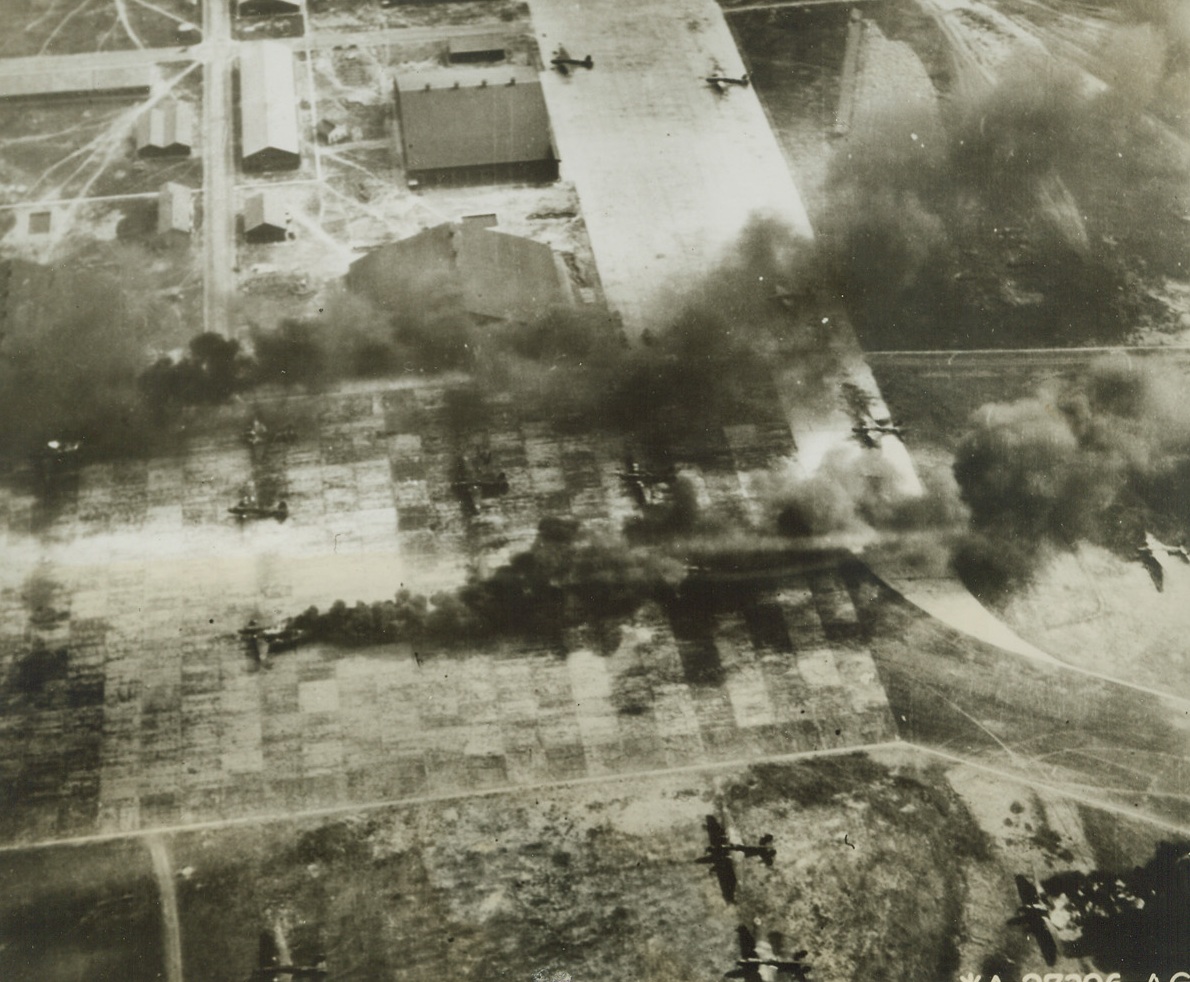
Jap Airbirds Grounded for Good, 5/5/1944. Formosa – These Jap planes are all lined up for a possible hurried flight call, but it will be a long time (if ever) before they will ever take to the air again. Strafing USAAF planes raiding Shinkchiku Airdrome found these grounded “Nells” easy prey for their bullets and fragmentation bombs, and they’re knocking them off one by one with the Japs powerless to stop the raiders. This photo was taken from a B-25. Credit: Official AAF photo from ACME;
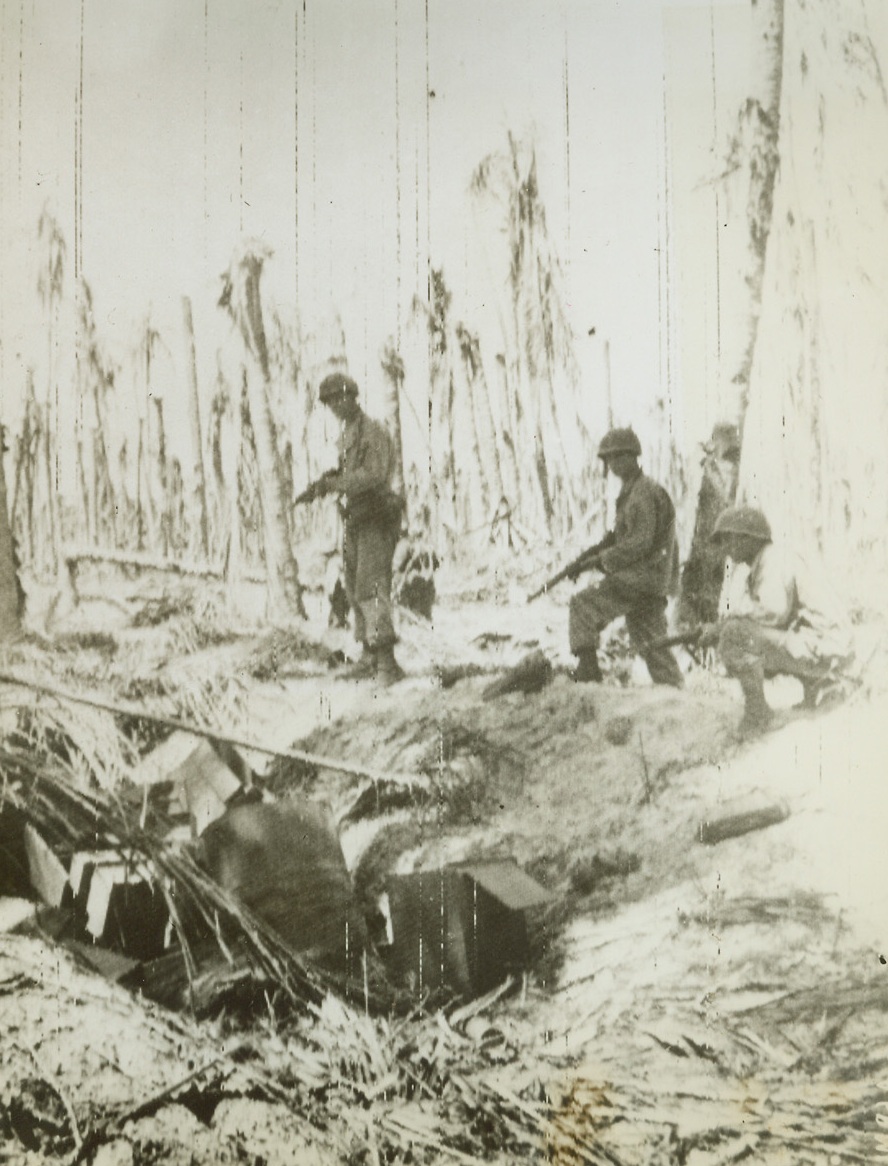
Trapping Nips on Wakde, 5/23/1944. Three U.S. Infantrymen, their guns held ready, advance cautiously on one of the few remaining pockets of Jap resistance on Wakde Island, off the coast of Dutch New Guinea – a battered pillbox. Today, Yanks are in full possession of the area and are using its airfield – a big step nearer the Philippines. Credit: ACME photo by Frank Prist for the War Picture Pool via Army Radiotelephoto;
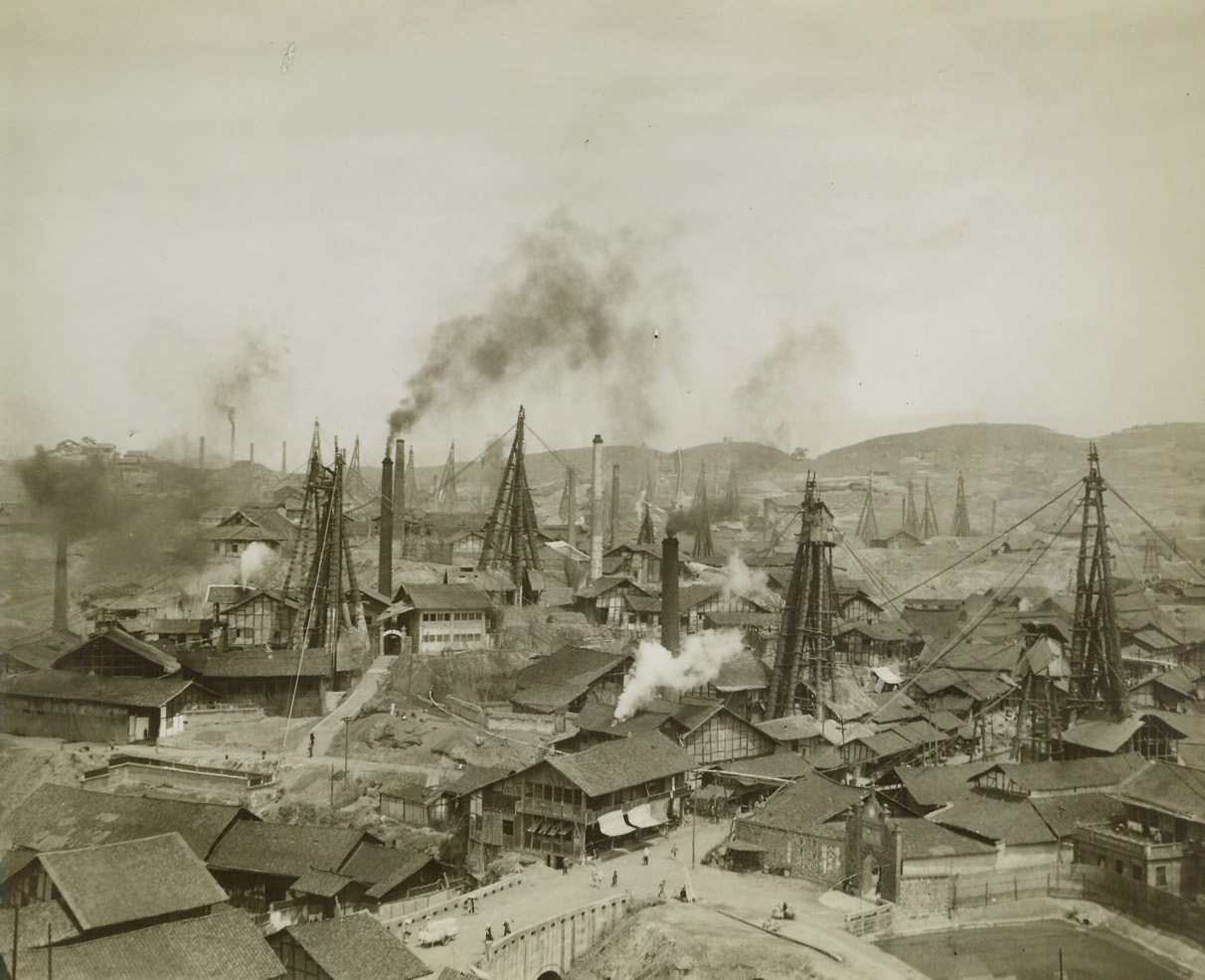
Salt for the Cellars of China, 5/23/1944. Tse Liu Ching, China – One of the most thriving industries in this area of China is the salt mines located at Tse Liu Ching. These mines, 2,600 years old, are cultivated by rustic methods, but nevertheless produce 250,000 metric tons of salt a year, or one fourth of all the salt produced in free China. Three hundred thousand laborers work the mines, from which salt is shipped to all parts of the East. Picture shows: A general view of a salt well city. The wells are from three to four thousand feet deep and take 4 years to dig. Credit: ACME photo by Frank Cancellare, War Pool Correspondent;
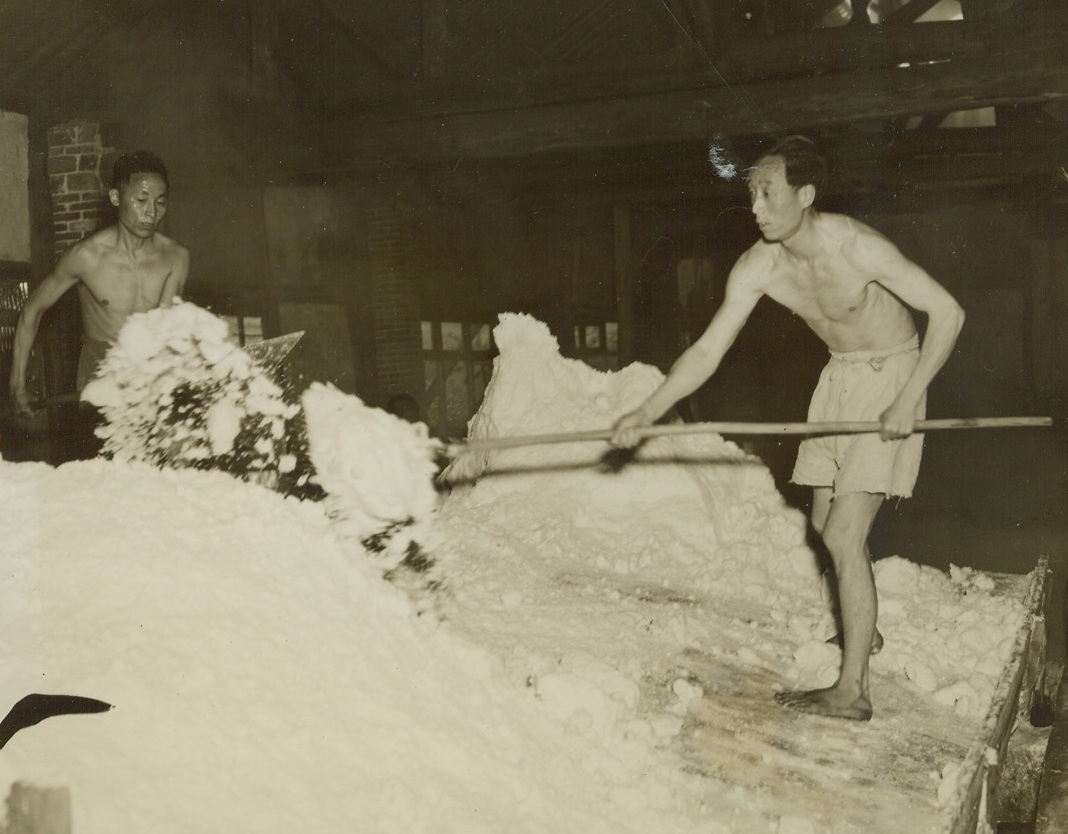
Salt for the Cellars of China, 5/23/1944. Tse Liu Ching, China – One of the most thriving industries in this area of China is the salt mines located at Tse Liu Ching. These mines, 2,600 years old, are cultivated by rustic methods, but nevertheless produce 250,000 metric tons of salt a year, or one fourth of all the salt produced in free China. Three hundred thousand laborers work the mines, from which salt is shipped to all parts of the East. Picture shows: The salt brine is boiled to remove all the moisture. Credit: ACME photo by Frank Cancellare, War Pool Correspondent;
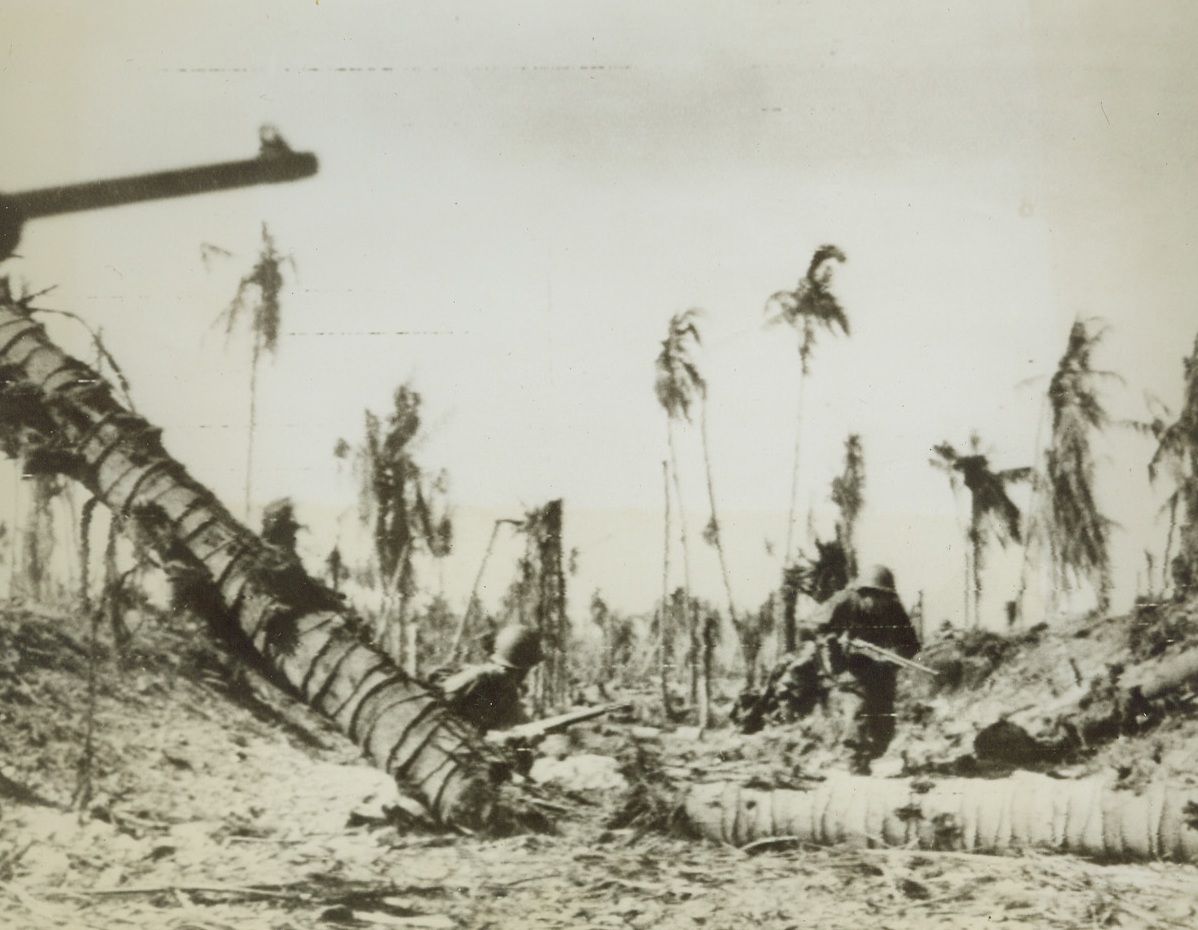
Mopping Up on Wakde, 5/23/1944. Two members of the U.S. invasion force move forward against last pockets of Jap resistance, after the invasion of Wakde Island, off the coast of Dutch New Guinea. Caught by surprise, the Nips offered comparatively little resistance and the Yanks are now in full possession of the area, including an excellent airfield. Credit: ACME photo by Frank Prist for the War Picture Pool via Army Radiotelephoto;
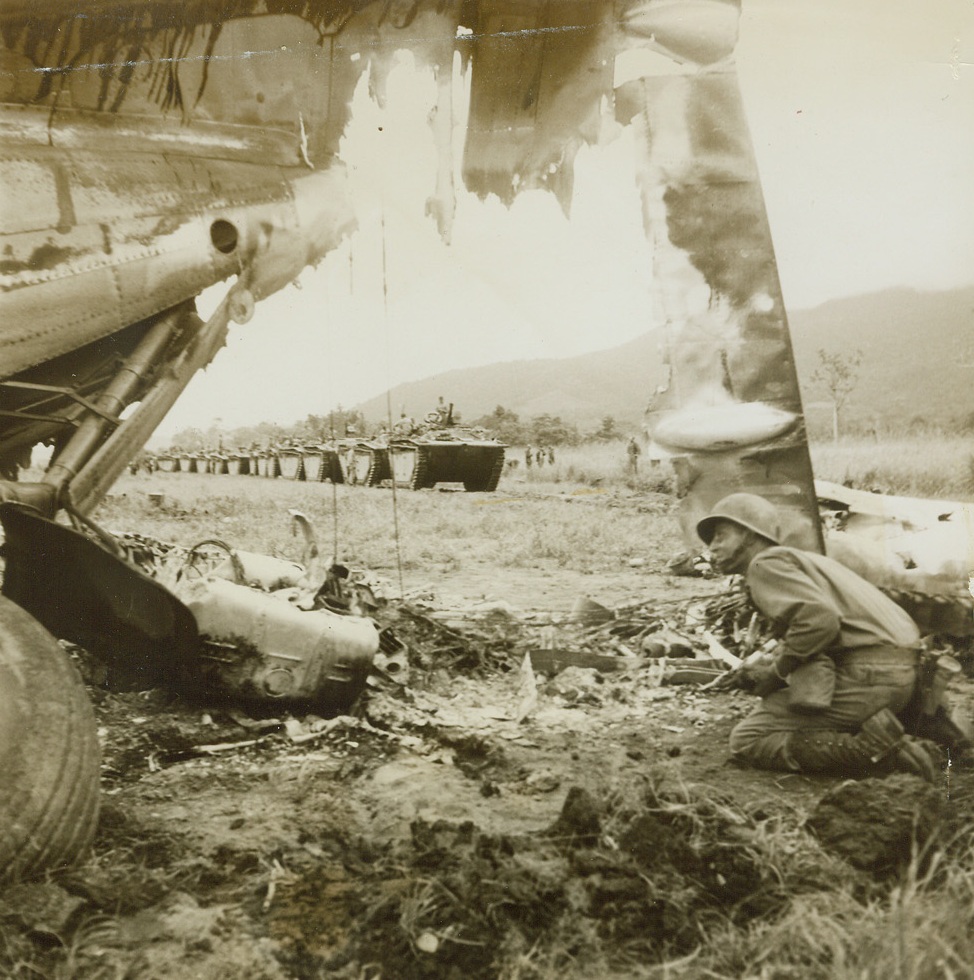
Alligators thru the Wreckage, 5/18/1944. Hollandia, Dutch New Guinea – In a line stretching far as the eye can see, amphibious Alligator Tanks are shown through the wreckage of a Japanese plane on Sentani Airdrome, near Hollandia. The alligators helped to take the airfield by circling through Lake Sentani. The soldier in foreground is apparently on the lookout for any Japs left in the area.Credit: ACME photo by Frank Prist, Jr. for the War Picture Pool;
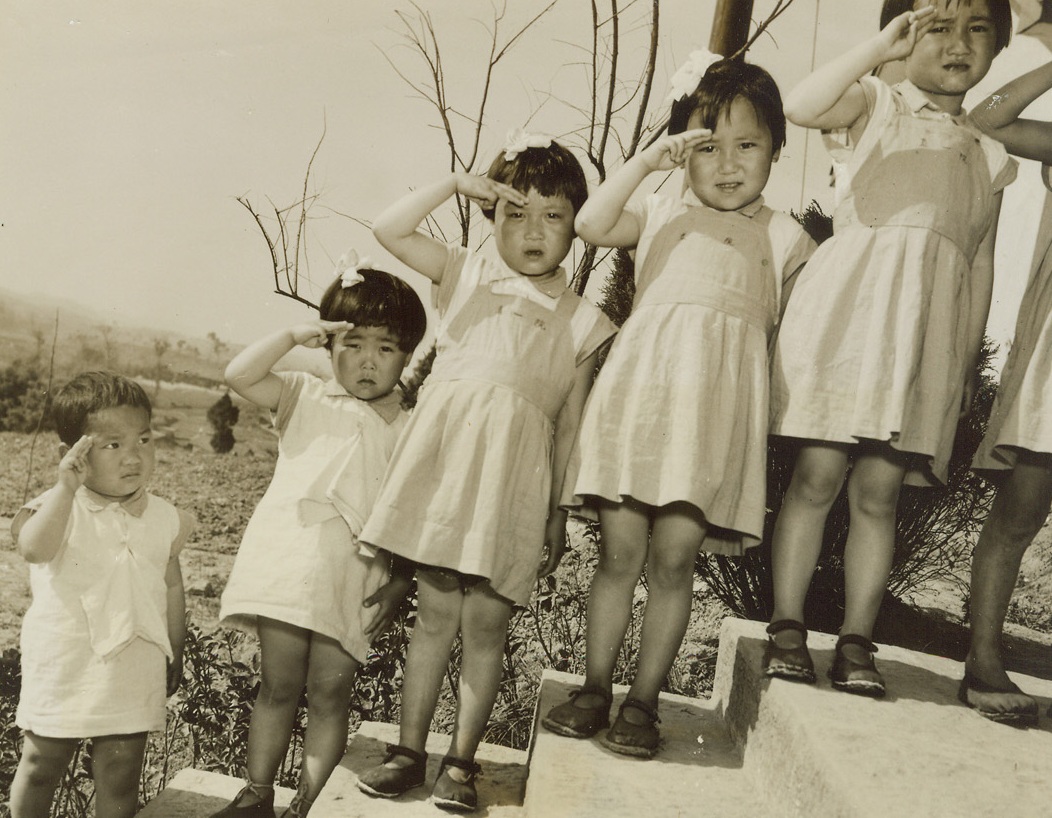
China’s Orphans, 5/18/1944. Chungking, China – Orphaned by the war that lays waste to their native land, these Chinese youngsters are learning to forget the terror that marked their early childhood at a new home for war orphans, near Chungking. Raising their hands to their foreheads, the youngsters salute Madame Chiang Kai-Shek as she visits their new home for opening day ceremonies on May 2nd.Credit: ACME photo by Frank Cancellare for the War Picture Pool;
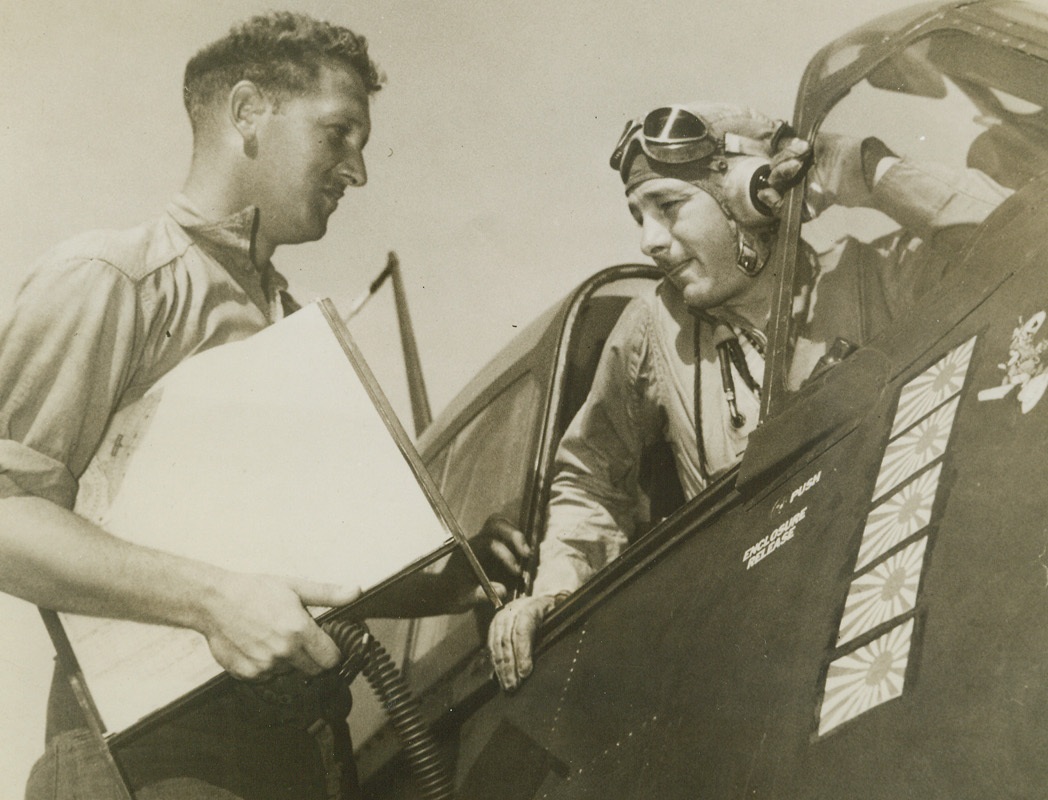
An Ace in One Day, 5/31/1944. Pacific – Lt. Comdr. E.C. Outlaw, USN, of Goldsboro, N.C., who led a flight of eitght Pacific fleet carrier-based fighters to a 21-to-0 victory over Japanese fighters in a single recent action over Truk, shooting down five enemy planes himself to join the ranks of Navy aces, prepares to take off on another strike. He is receiving a send-off from his plane Captain, H.T. Sliper, aviation machinist mate, third class.Credit Line (Official US Navy photo from ACME);
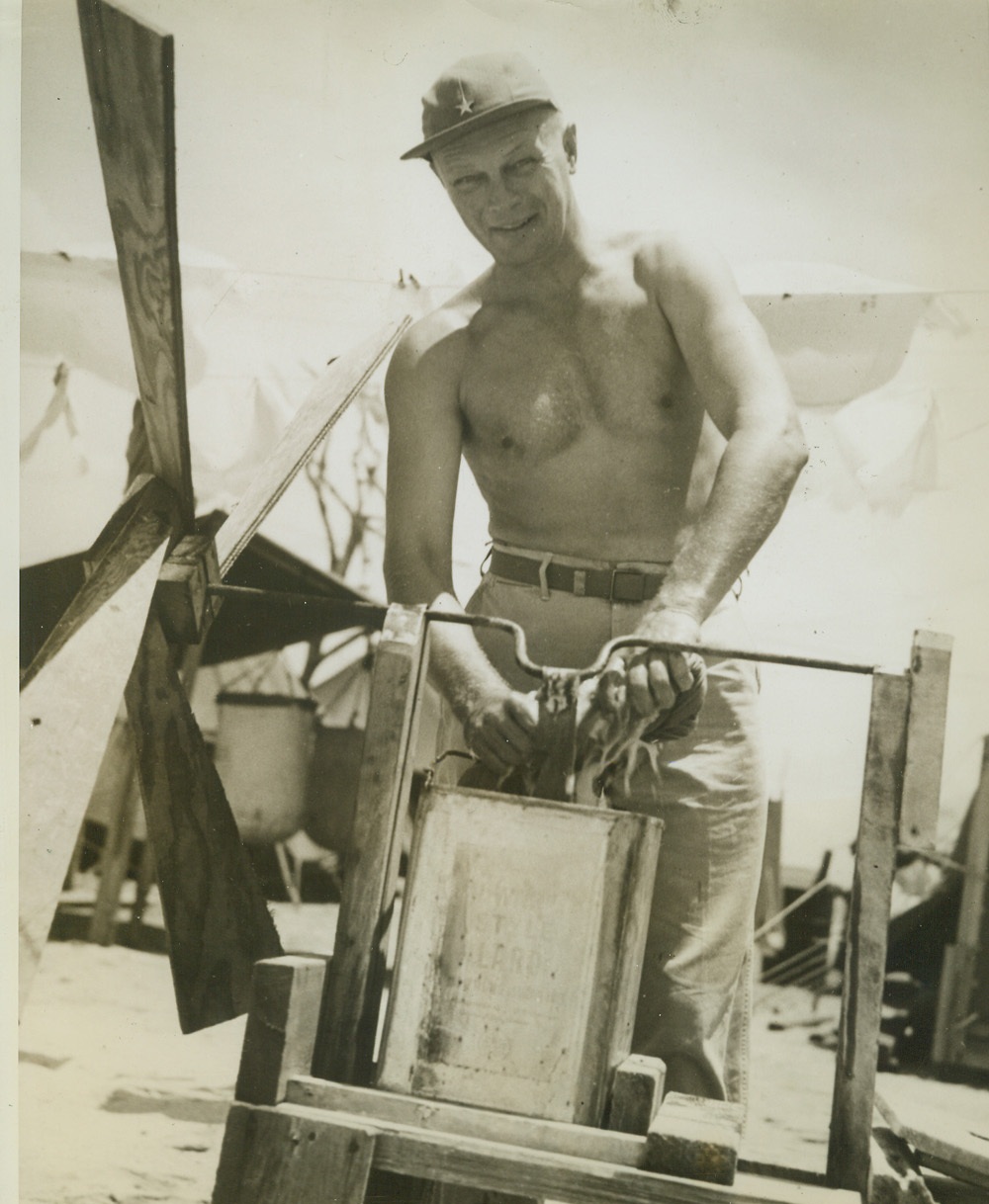
Everybody Does It In the Army, 5/10/1944. SOUTH PACIFIC -- Brig. Gen. T.H. Landon of Los Angeles, Calif., commander of the 7th Army Air Forces Bomber Command, does his washing in a home-made windmill washing machine at an advanced base somewhere in the South Pacific. Seems that the Army has its help problem as well as civilians. Credit:-WP-(ACME);
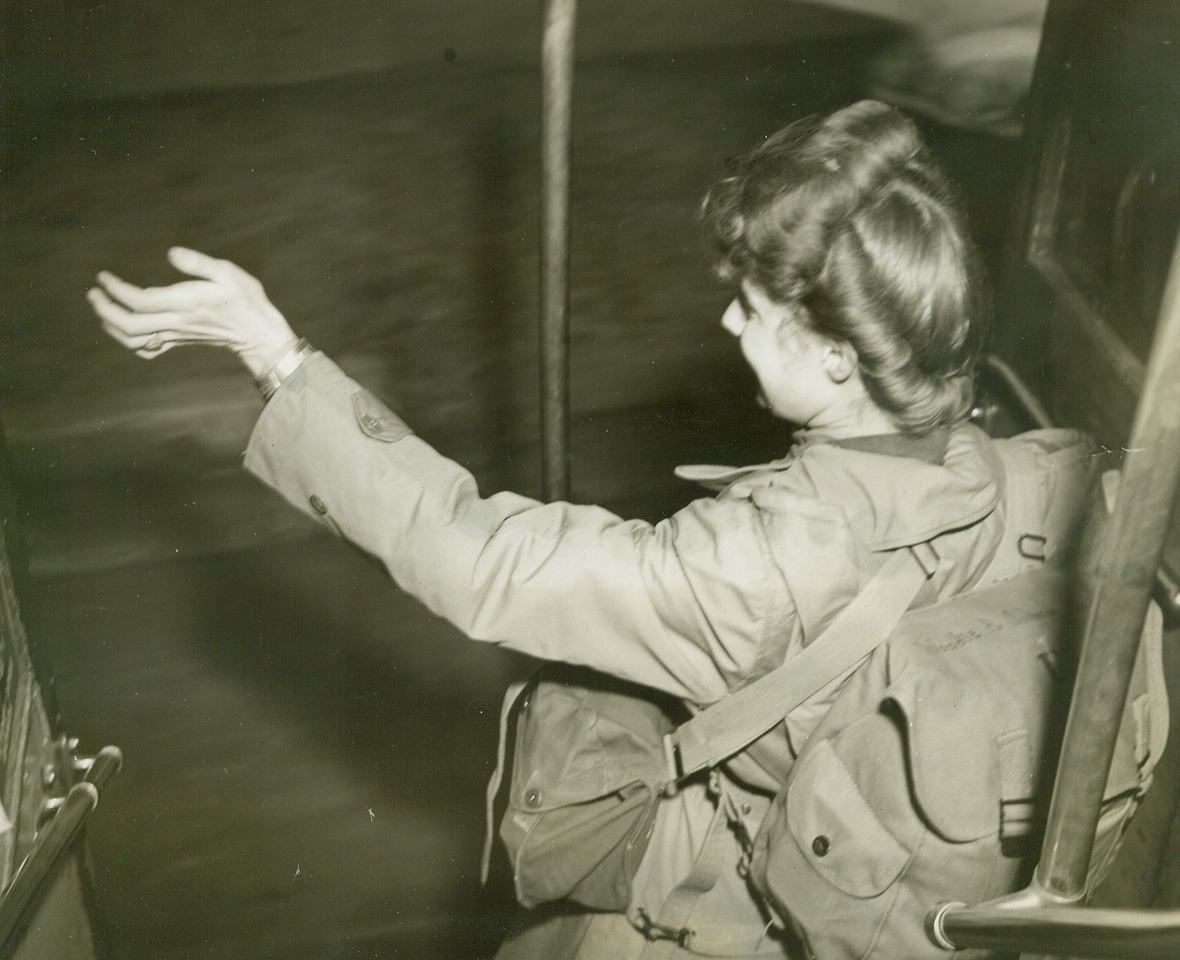
Texas WAC Rides to Australian Barracks, 5/24/1944. WAC Pvt. Woody R. Johnson, of Littlefield, Texas, a member of the first contingent of WACs to arrive in Australia, waves from the rear platform of a bus which transported the WACs from their ship to barracks in Sydney.;

Wrecked by Red Plane, 5/25/1944. On the Ukranian Front – This enemy warbird, a “Messerschmitt-323-Giant”, was wrecked by a Soviet plane on the Third Ukranian Front. No large-scale action is being reported on the German-Soviet front at present, but patrol and reconnaissance outfits continue activities against the Nazis. A late communiqué announces that the Russians have destroyed 27 German tanks and self-propelled guns as well as nine enemy planes during these actions. Credit: ACME Radiophoto;
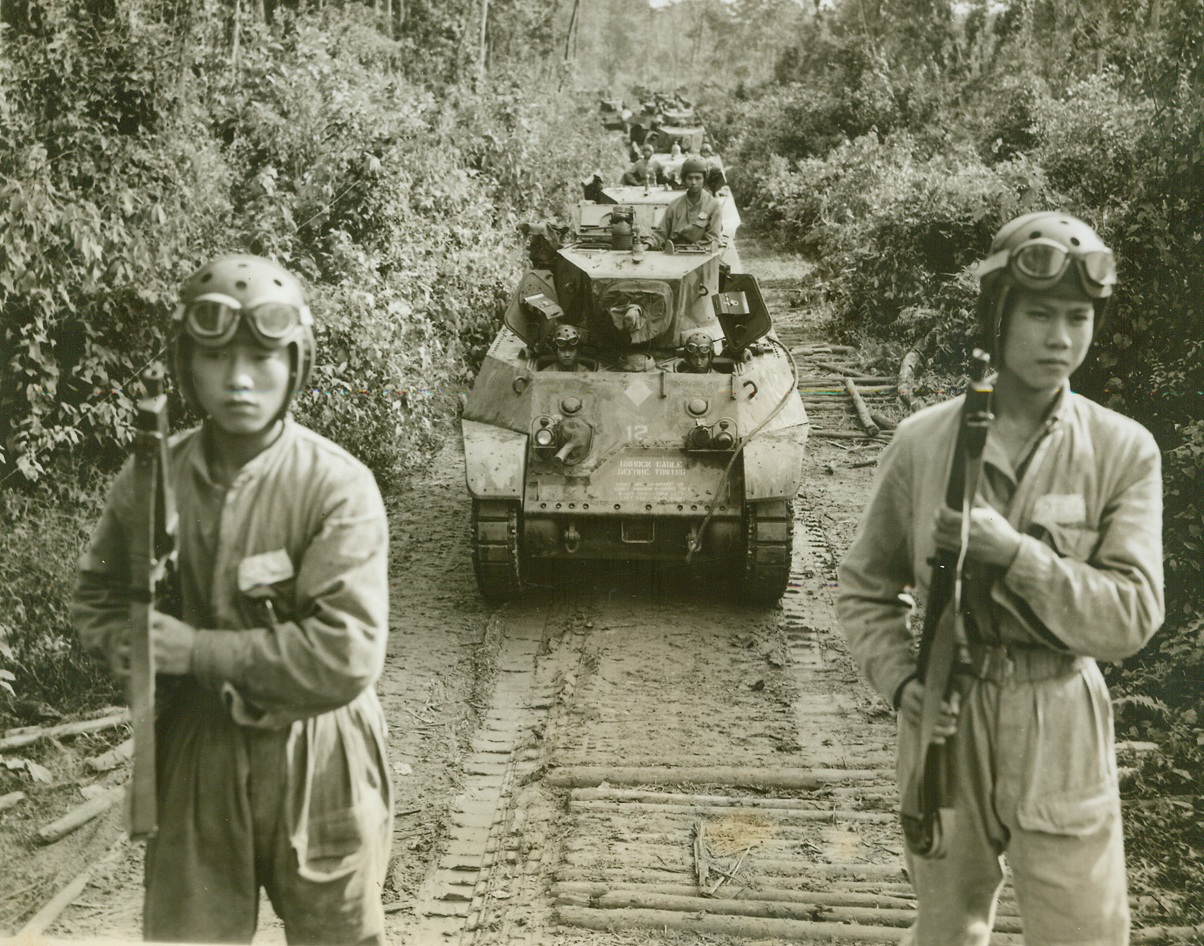
Yank Tanks Make Debut in Burma, 5/20/1944. Burma – To the American and Chinese jungle fighter troops in Burma have been added new mechanized units-American tanks. Now being used in the Hukawng Valley, the tanks have played a prominent part in driving back the Jap forces with resultant Allied gains. The Chinese soldiers who man the battle wagons have been trained by Americans and are fully equipped to use their vehicles to the best advantage. The tanks reached the battle area in Hukawng Valley by traveling over the newly constructed Ledo road, from Assam to the Valley. The following pictures show the tanks in use in their new territory. Flanked by an advance armed guard the tanks move down a small road hacked out of the jungle in the combat zone in Burma. Note the logs stretched across the road – they aid the tanks in traversing the gooey mud which is so characteristic of the Burma Jungle. Credit: ACME photo by Frank Cancellare, War Pool Correspondent;
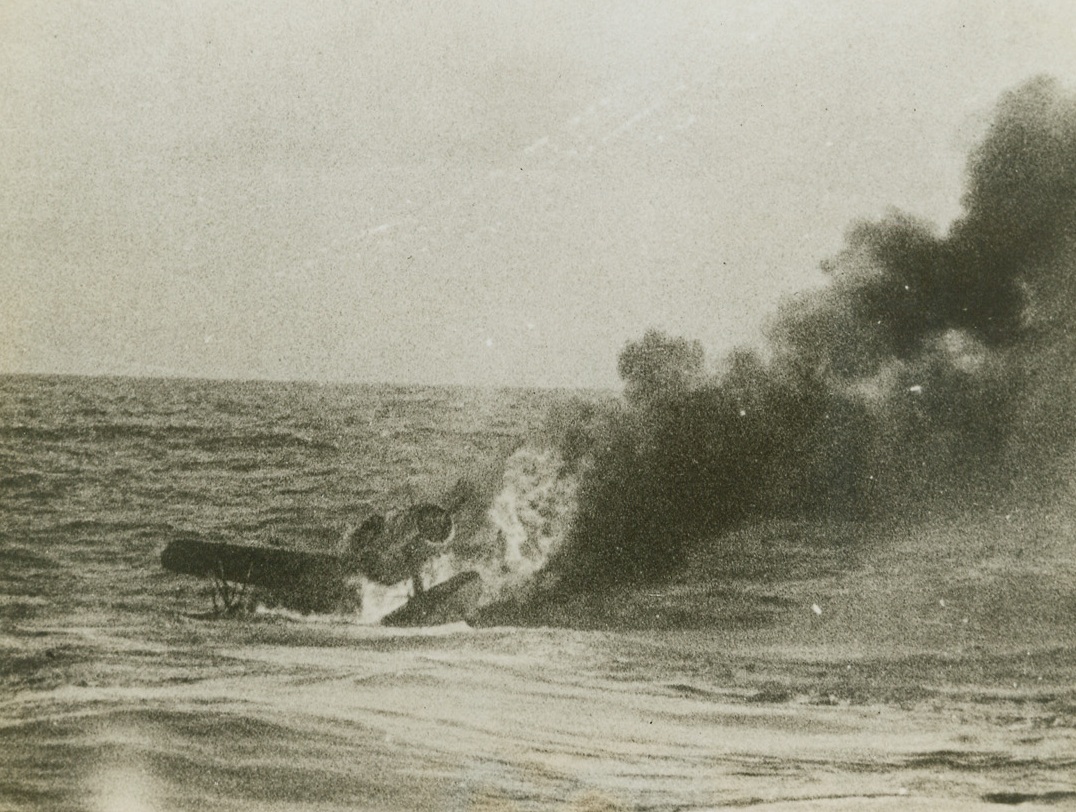
Sub Makes Daring Rescue off Truk, 5/20/1944. Truk – After the nine downed fliers clinging to this Kingfisher observation plane were rescued by the Navy sub “Tang”, the damaged plane was sunk by gunfire from the sub, and went to a watery grave, enveloped by flames. During the heavy allied attack on Truk, April 29-30, the submarine rescued a total of 22 downed fliers and brought them back to Pearl Harbor. Credit (US Navy photo from ACME;
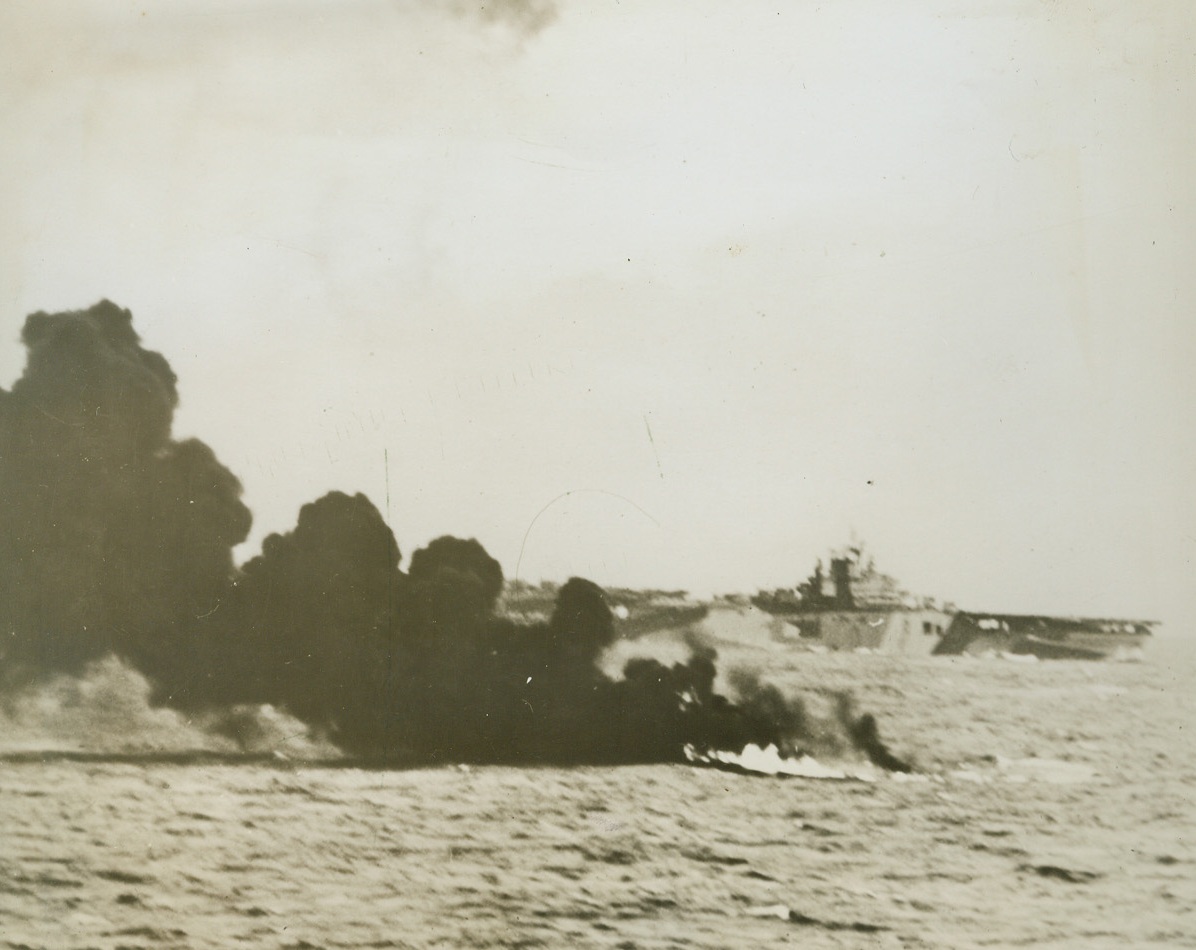
Score One for the Navy, 5/20/1944. Truk – A sheet of flame on the water with dense black smoke rising from it is all that remains of this Japanese torpedo bomber which was met by a hail of anti-aircraft fire when it attempted to hit the Pacific fleet carrier (in the background) during the naval attack on Truk April 29-30, 1944. Credit (US Navy photo from ACME);
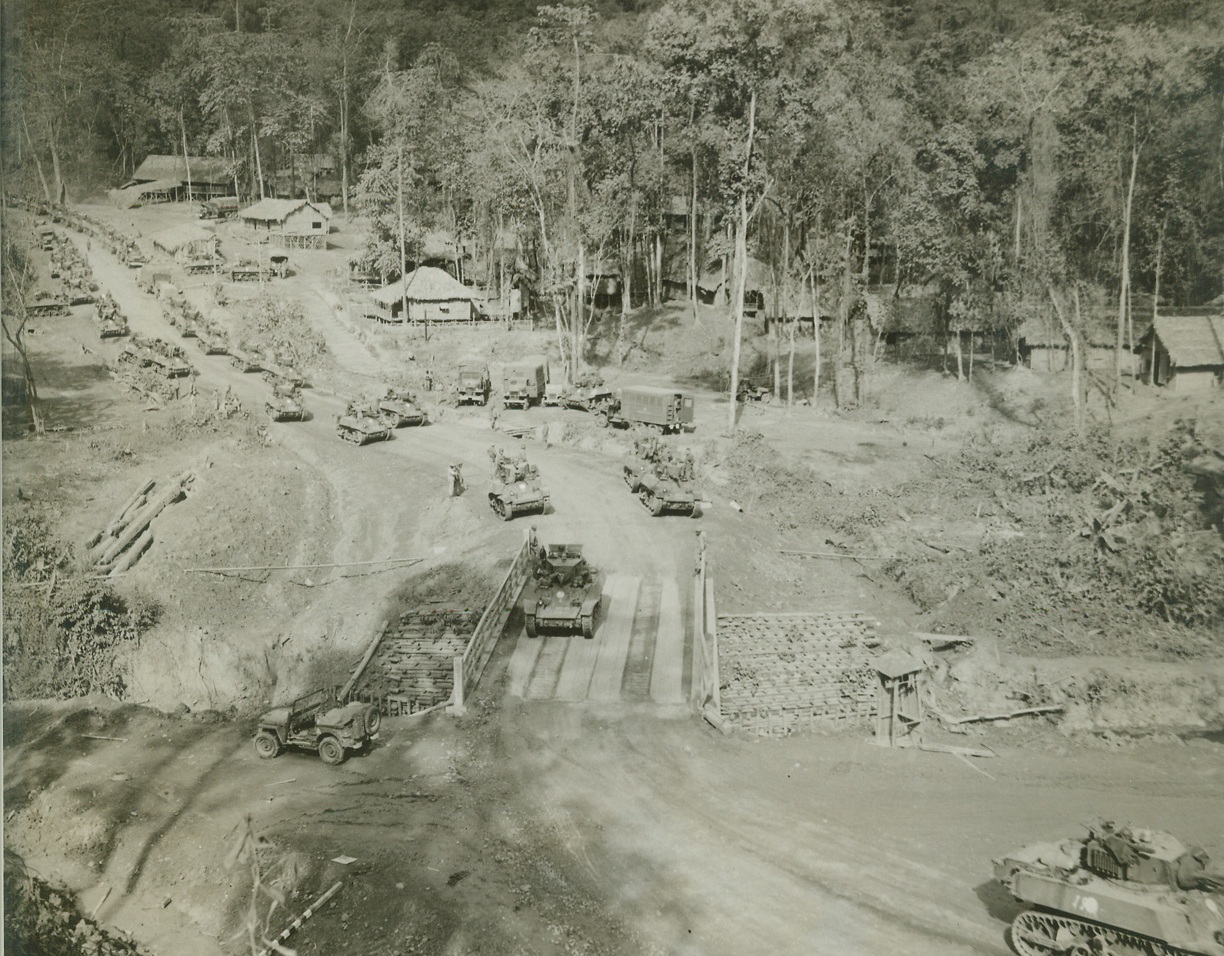
Yank Tanks Make Debut in Burma, 5/20/1944. Burma – To the American and Chinese jungle fighter troops in Burma have been added new mechanized units – American tanks now being used in the Hukawng Valley, the tanks have played a prominent part in driving back the Jap forces with resultant allied gains. The Chinese soldiers who man the battle-wagons have been trained by Americans and are fully equipped to use their vehicles to the best advantage. The tanks reached the battle area in Hukawng valley by traveling over the newly-constructed Ledo road, from Assam. To the valley the following pictures show the tanks in use in their new territory. New York Bureau Emerging from the hills around Assam, the tanks wind down the Ledo road en route to the battle front. The thatched huts are evidently part of a behind-the-lines Army camp. Credit (ACME photo by Frank Cancellare, War Pool correspondent);
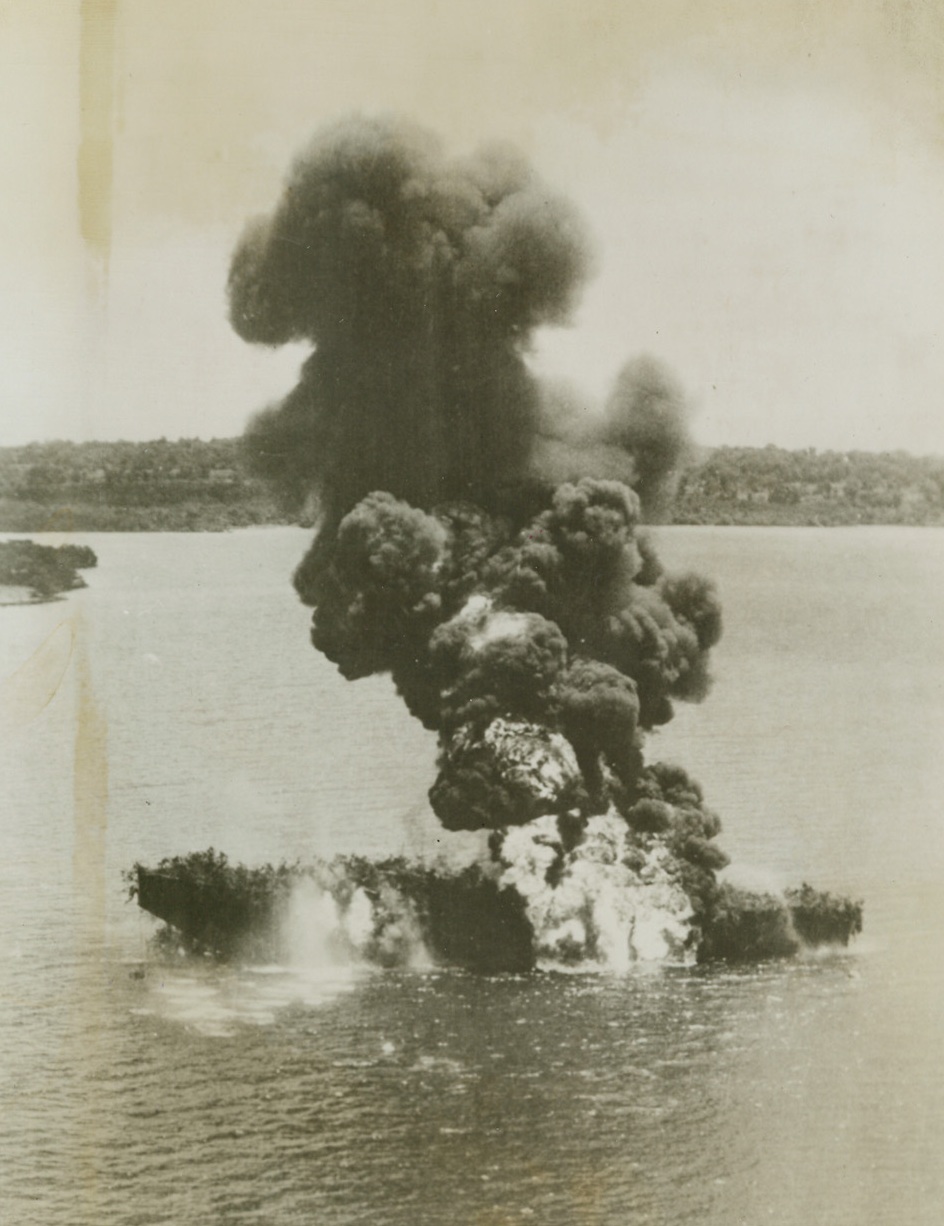
Jap Fuel Burns Beautifully, 5/20/1940. Timor – Smoke billowing skyward from the Pyre that has a Jap fuel boat, presents ample proof of Corp flyers marksmanship. The barge was caught by allied planes in a bay at Timor in the South Pacific. Flame and smoke indicate the cargo was probably oil. Note the use of vegetation for camouflage – a vain gesture in this case. Credit (USAAF photo from ACME);
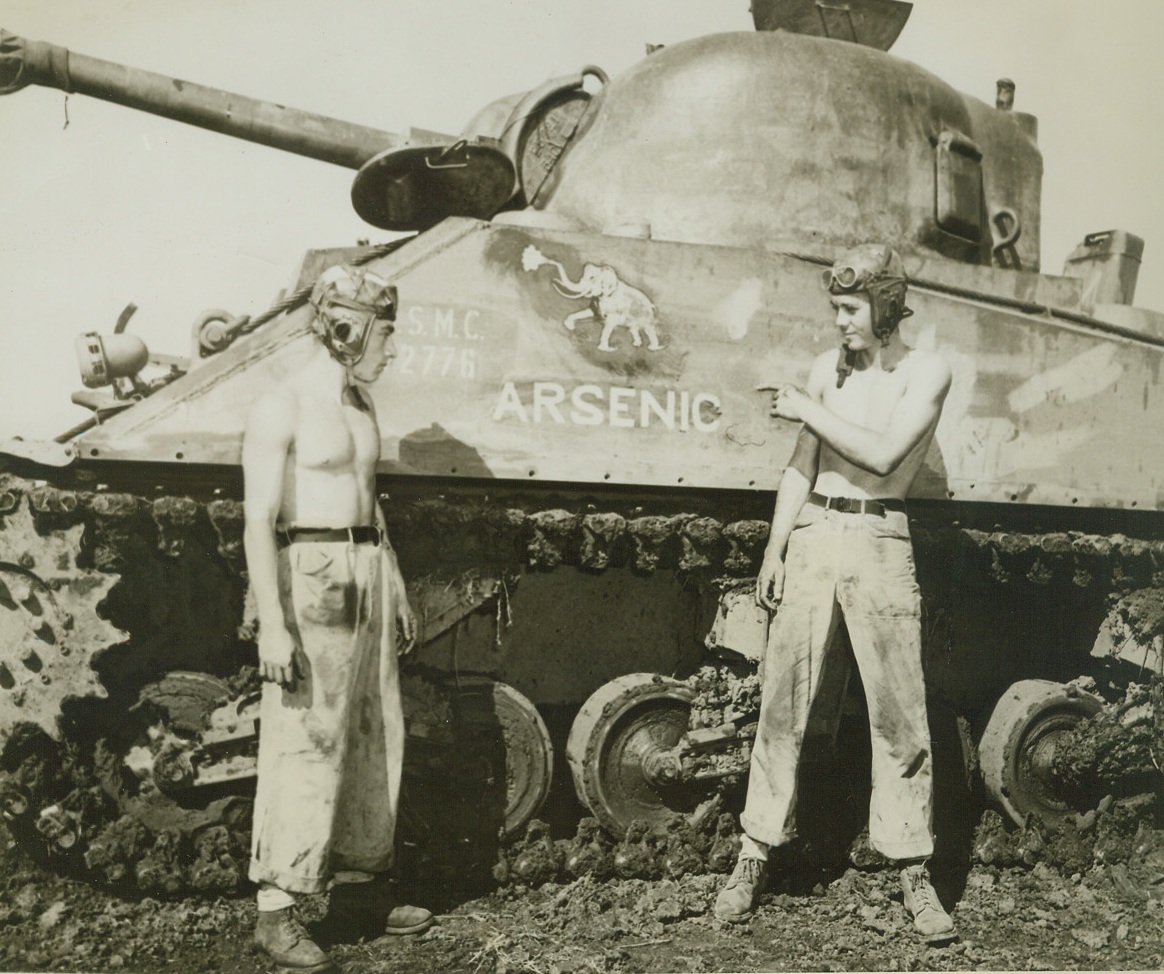
-- But, No “Old Lace”!, 5/18/1944. South Pacific – A bitter dose to the Japs in the South Pacific, is this U.S. Marine Corps tank, appropriately dubbed “Arsenic”. Two of the battle-hardened crew members stand beside their “Nip Eliminator.” Left to right, are: Cpl. Rocky J. Bonoma, son of Mrs. Ida Bonoma, 6258 Cuyler Ave., Chicago, Ill.; and Sgt. Paul E. Wyers, son of Mrs. Martha Wyers, 410 Weatherly St., Borger, Texas. Credit line (U.S. Marine Corps photo from ACME);
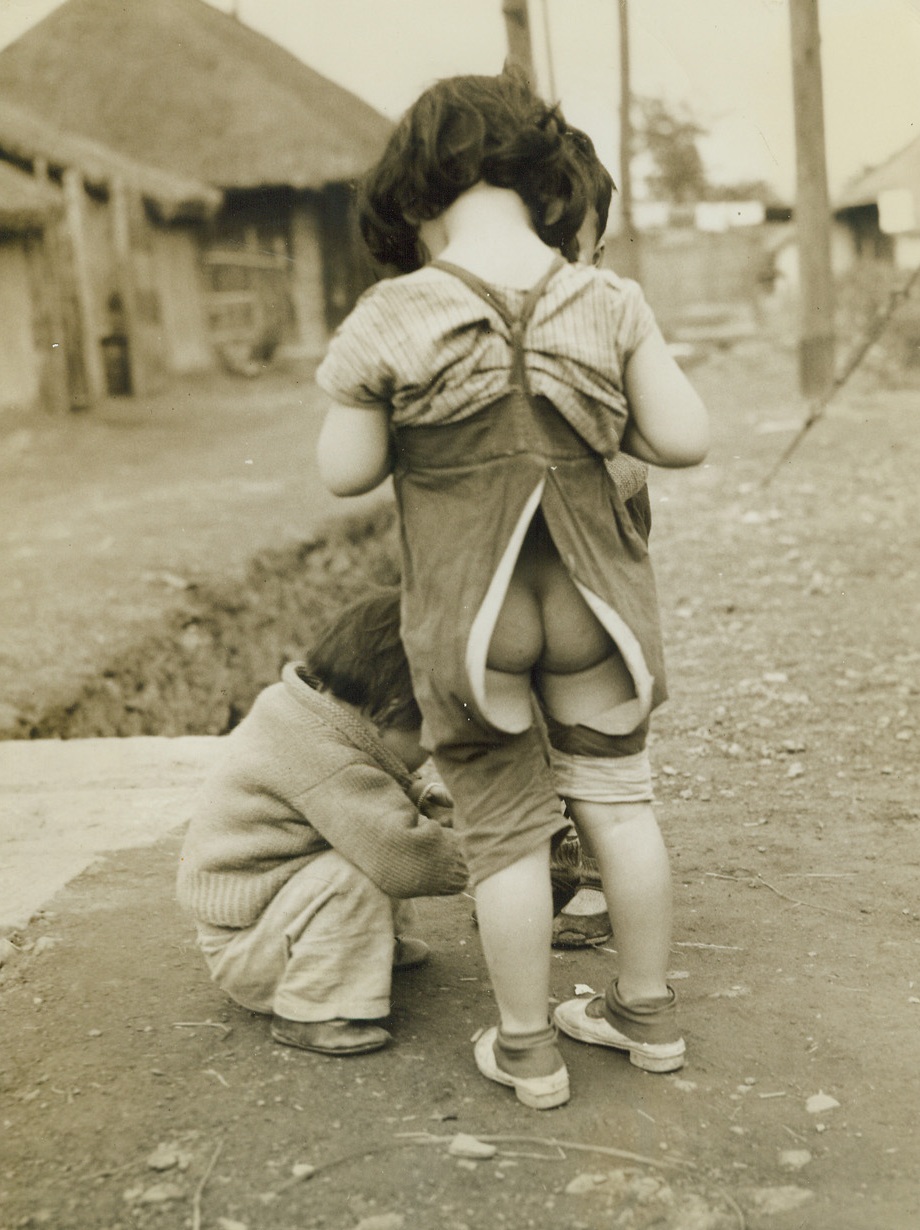
Air Conditioning – Chinese Style, 5/9/1944. Chungking – No, this isn’t a gag. Young Chinese children often wear their trousers this way for the sake of coolness, comfort & convenience. There’s no getting away from it – you can’t beat the Chinese for simple practicality. Credit line – WP – (ACME photo by Frank Cancellare, War Picture Pool correspondent);
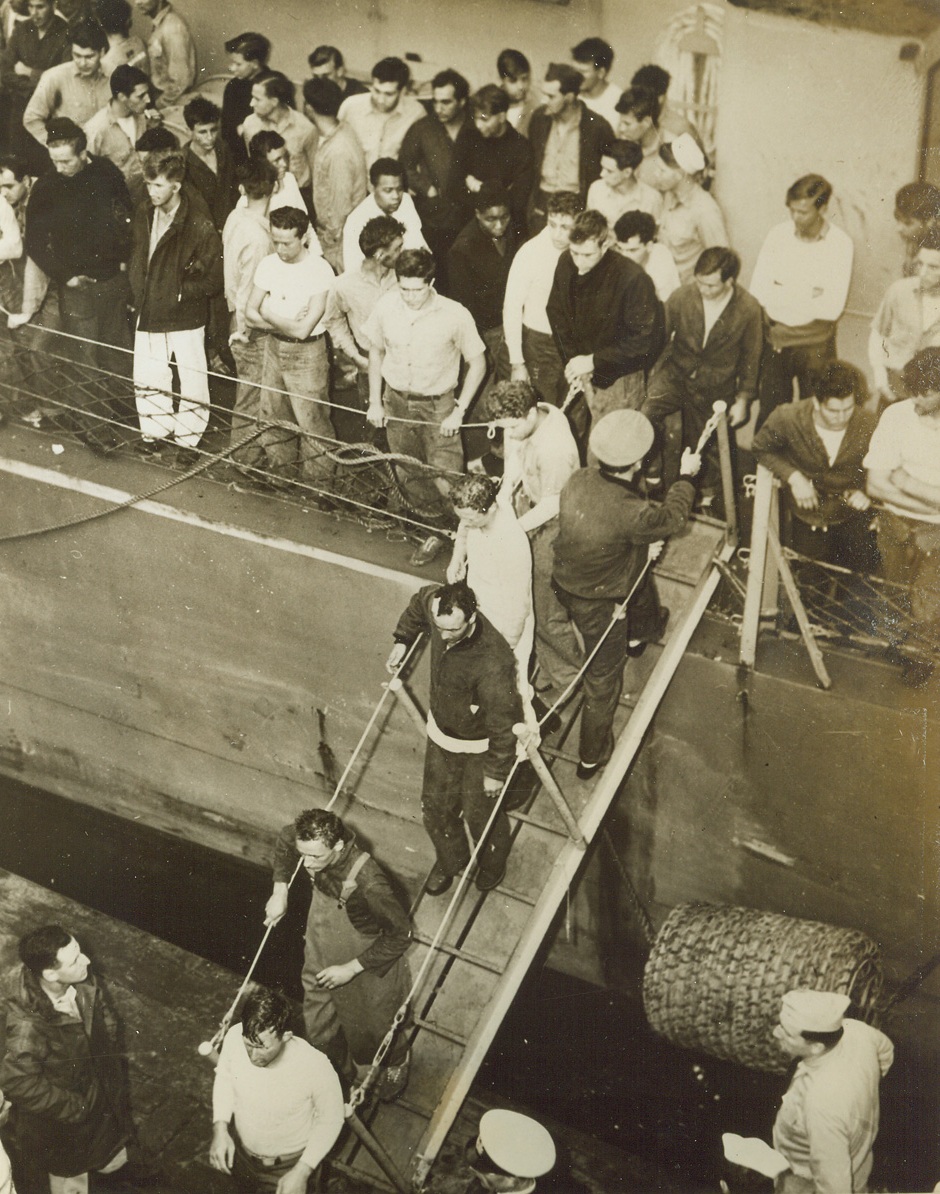
Escaped Death, 5/10/1944. North Africa – Lt. Robert Morgenthau, USNR, hands in pockets, extreme lower left, son of Secretary of Treasury Henry J. Morgenthau, Jr., was one of the many Americans rescued by two Coast Guard destroyer escorts after the destroyer Lansdale was bombed and sunk in a German attack off the coast of North Africa. Morgenthau, executive officer of the vessel, watches Navy seamen descend the gangway after they had been carried safely to a North African port. Credit (US Coast Guard photo from ACME);
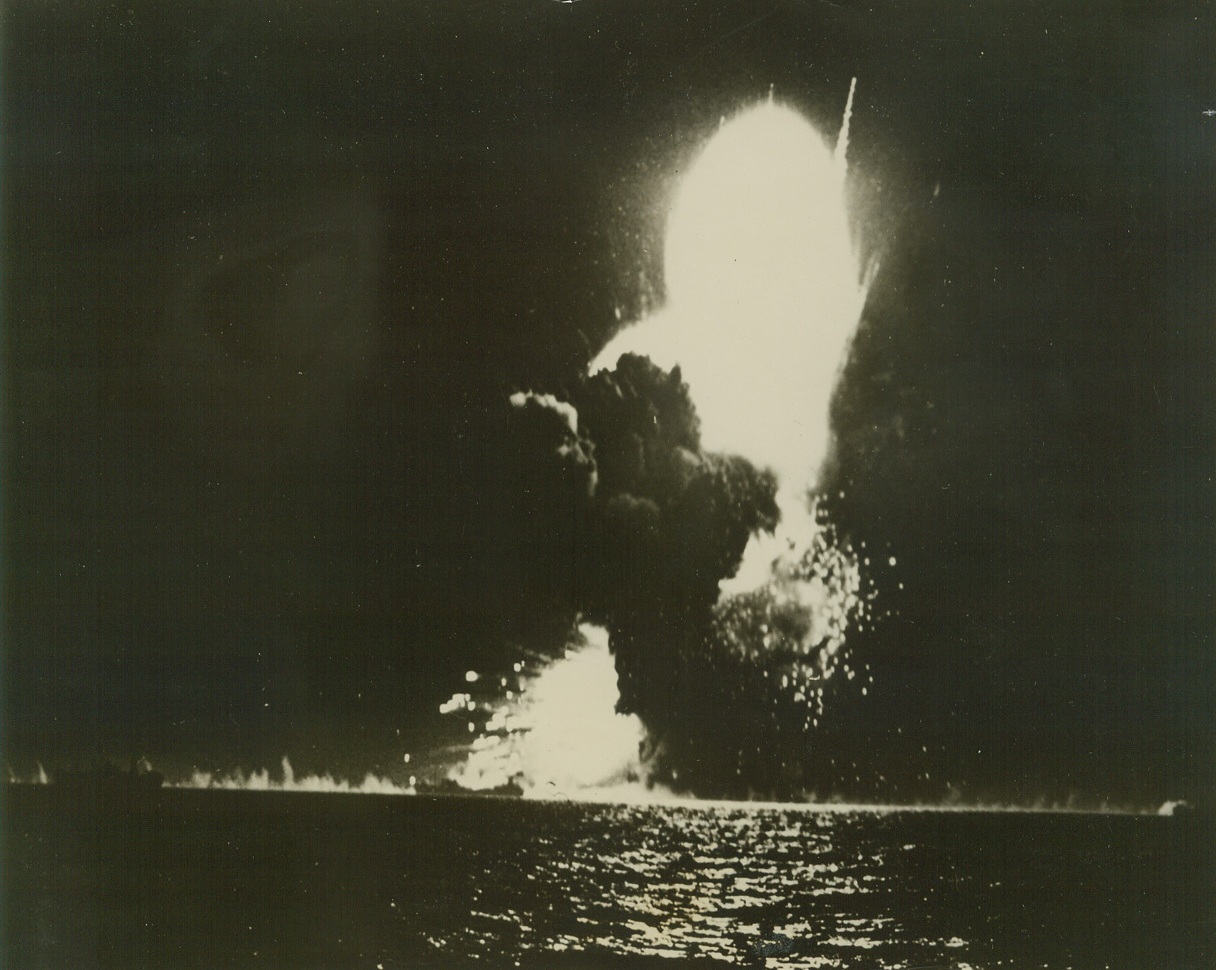
Tower of Destruction, 5/11/1944. North Africa – Cutting into the dense blackness of night, flames and smoke rise hundreds of feet into the air as an allied freighter explodes after a direct hit by a Nazi bomber. This dramatic photo of war pyrotechnics was taken at the height of a Nazi bomber attack on the North African coast. Credit line (US Coast Guard photo from ACME);
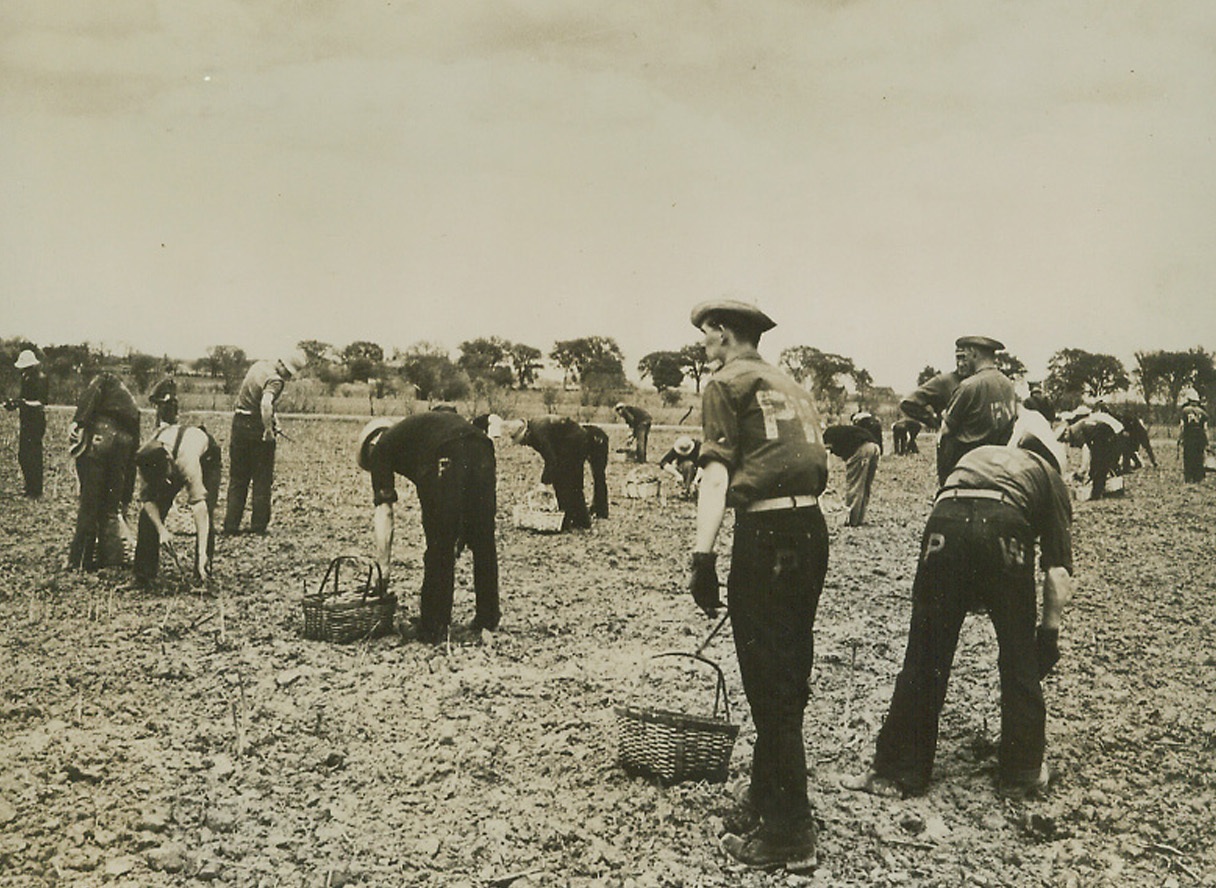
Nazis Work in Illinois Fields, 5/26/1944. Hoopeston, Ill.—Clearly marked with the initials P.W. (prisoner of war), these Germans work in the fields around Hoopeston, Ill., segregated from civilians except for a few supervisors who instruct them in cutting asparagus. Braches of prisoner of war camps have also been set up in the vicinities of Gibson City, Rossville, and Millford, Ill., where the men work in vegetable fields and canneries. Credit: Camp Ellis ASTPC Photo from ACME.;
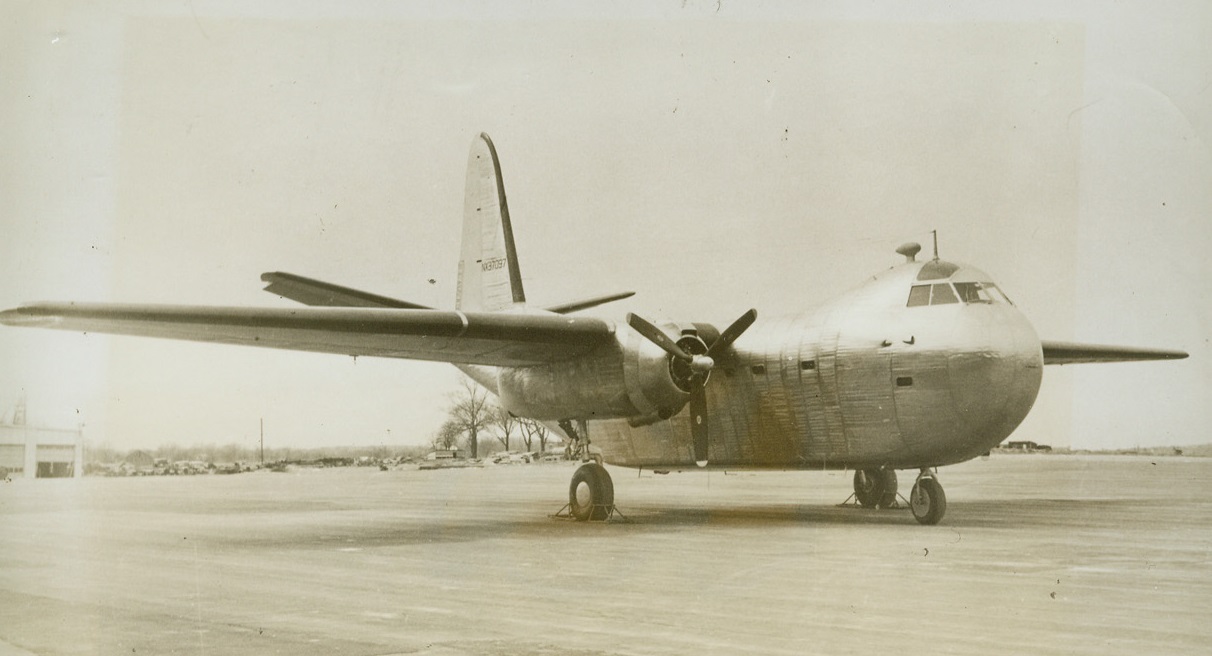
Secret Navy Cargo Plane Revealed, 5/6/1944. Philadelphia, Pa.—This is the new “Conestoga,” super cargo plane so named in tribute to the amazing vehicle which helped pioneer the settlement of colonial territories west of the Alleghenies. The plane, built by the Edward G. Budd Manufacturing Company under Navy contract, is of a brand new type which utilizes welded stainless steel instead of rivoted aluminum alloy sheets. Sixty-eight feet long, this two-engine transport has a wing spread of 100 feet, and is capable of transporting 10,400 pounds of cargo over a range of 650 miles, housing the load in a cargo compartment 25 feet long, eight feet wide, and eight feet high wholly unobstructed by girders or other structural members. Credit: ACME.;
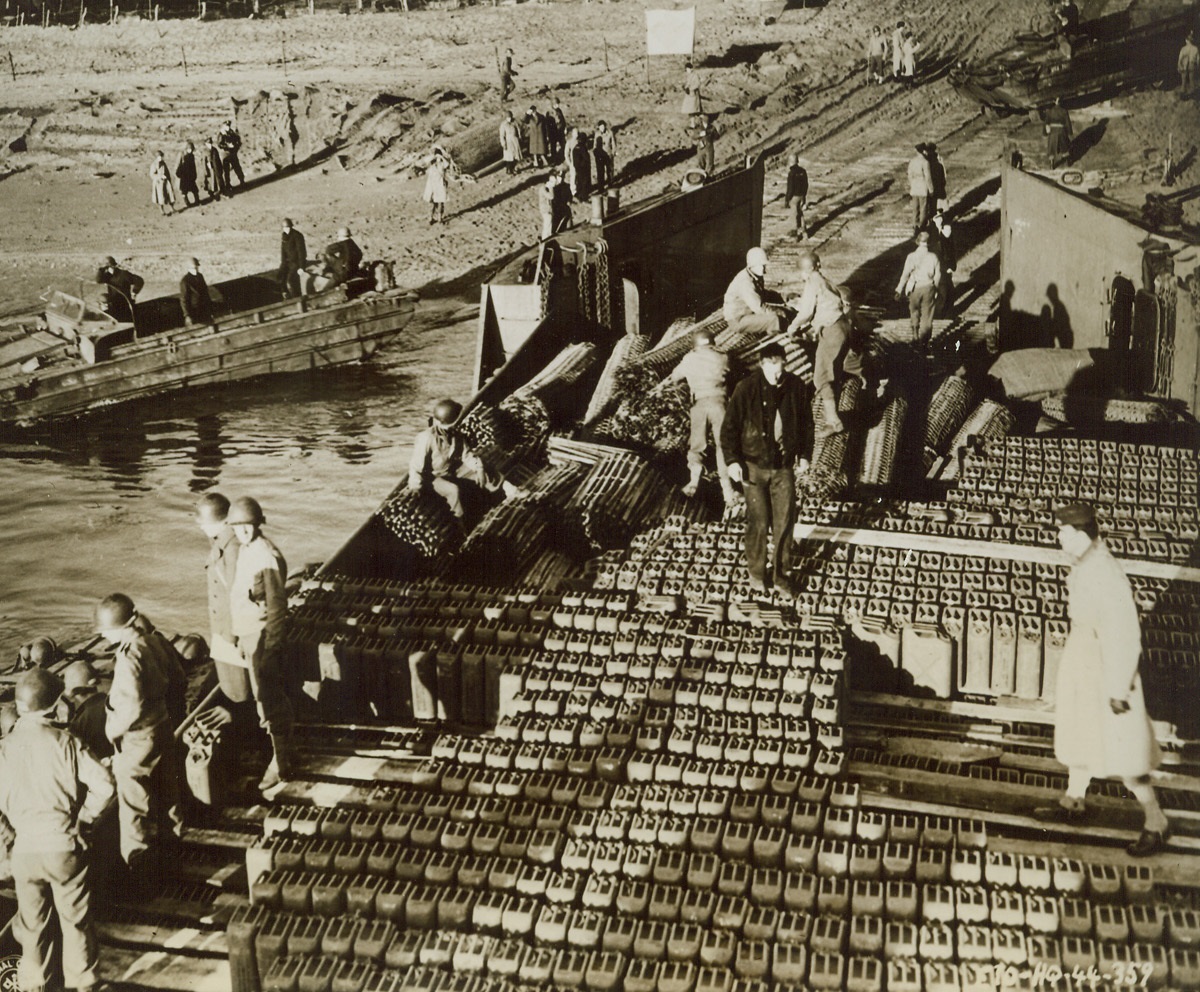
Specialists to Play Important Part in Invasion, 5/3/1944. On invasion maneuvers United States Army specialists use the versatile “duck” to haul gasoline cans from the mother barge to the shore. One of the most complex military organizations known to exist, the specialist branch includes medical technicians, telephone operators, ordnance men, and other workers covering all phases of army life and military operation. With this variety of skilled men in their organization, it is expected that the specialists will play a prominent part in the coming invasion of Europe. Credit: US Army photo from ACME;
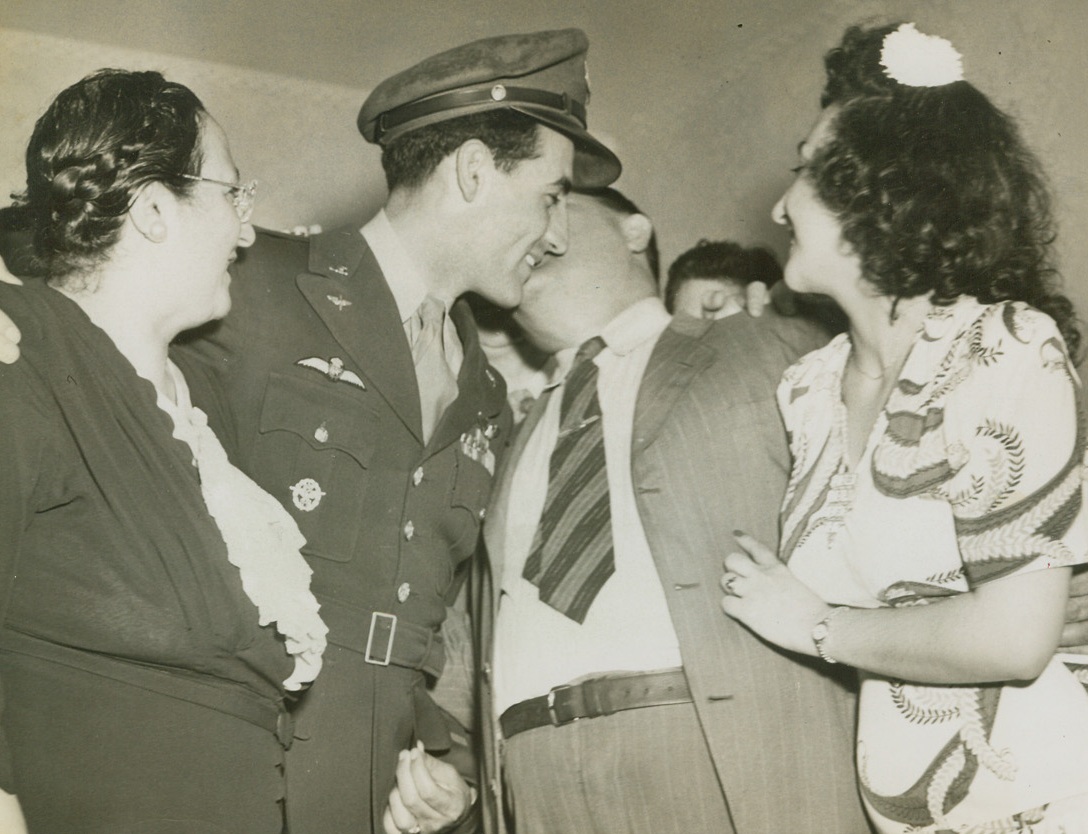
Put It There, Dad, 5/22/1944. Piqua, O. - Patsy Gentile, father of the famed American Ace Don Gentile who downed 23 Nazi planes in combat and shot seven on the ground, gave his son a warm welcome as he returned home on furlough. Mrs. Gentile and Don’s sister Edith made the reunion complete in Piqua, O. Credit: ACME;
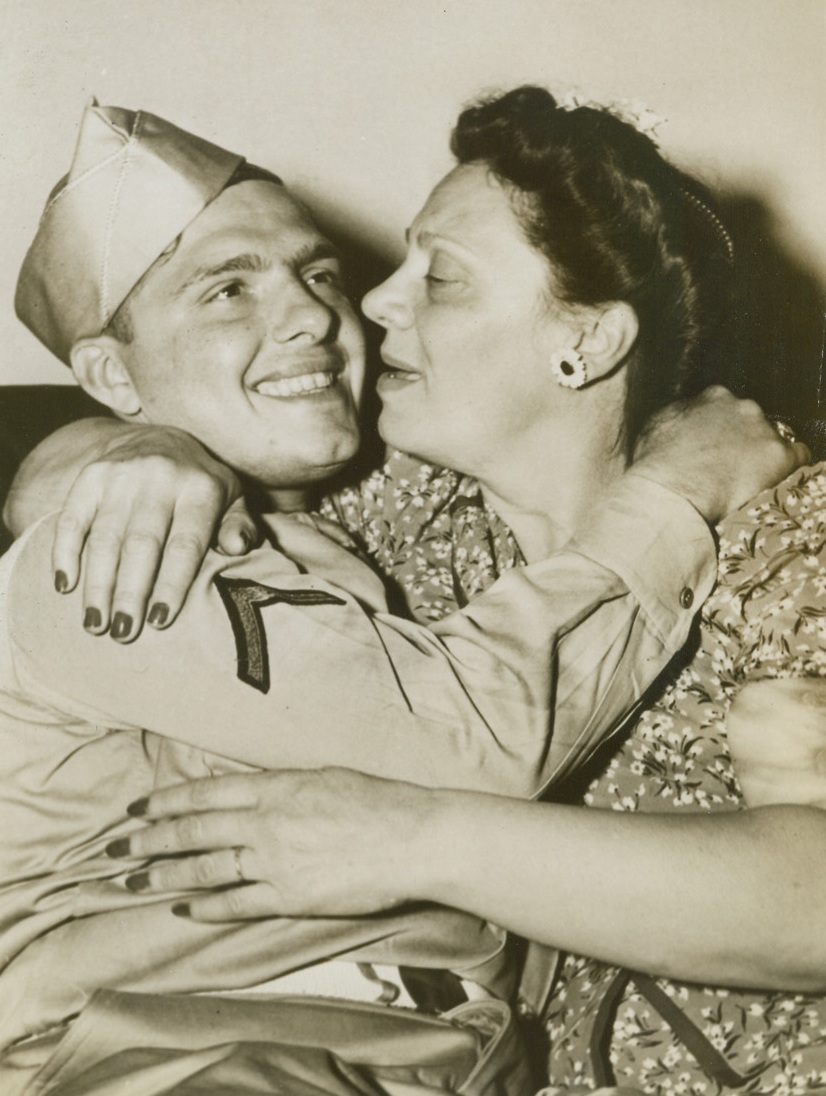
Joyous Reunion, 5/22/1944. Philadelphia, PA. - Mrs. Angelina De Lisio ardently embraces her son upon his return to his home in Philadelphia, Pa. He is Pfc. Edward De Lisio who fought in the North African Campaign and was listed as killed in action by the War Department for more than a month until the mistake was discovered. Credit: ACME;
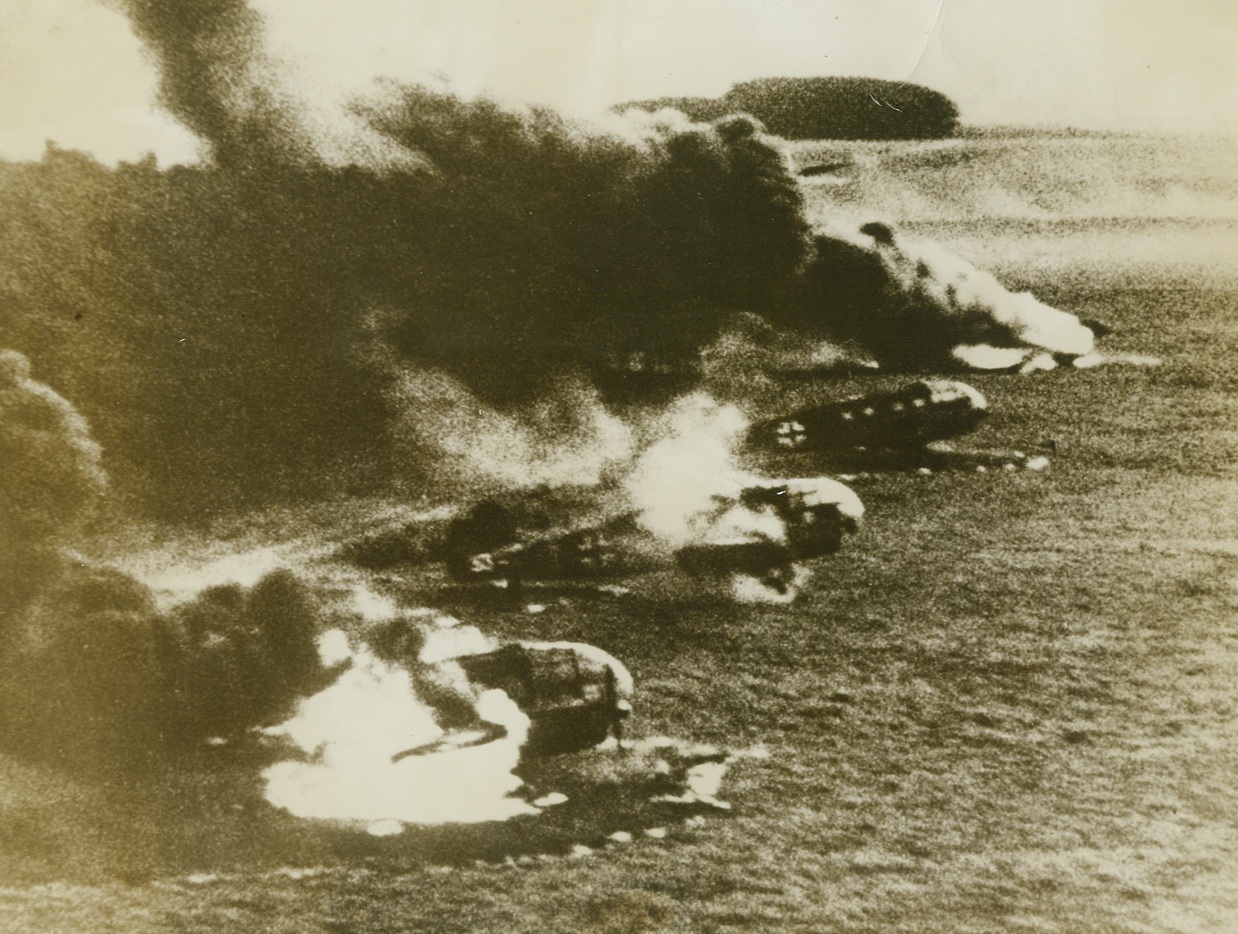
GROUNDED FOR GOOD, 5/23/1944. FRANCE – Burning furiously after an allied strafing attack, these German transports on an airdrome in occupied France are lost forever to the Luftwaffe. During recent allied air attacks, the Nazis have been keeping a large percentage of their planes on the ground – doubtlessly conserving them for the coming invasion. But our fighter planes zoom low, and with expert strafing, make short work of the German ships. Credit: Acme;
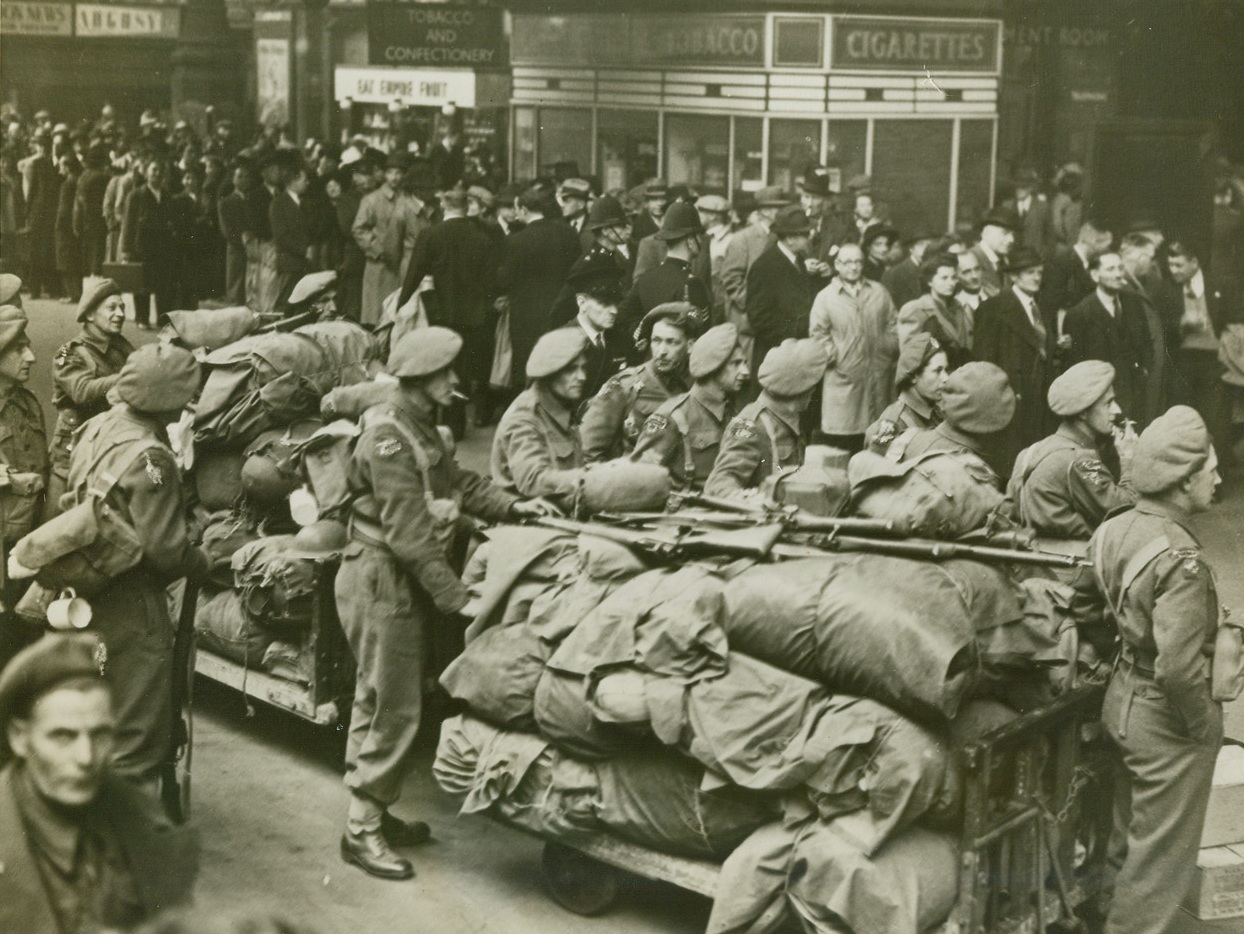
OFF TO THE RACES!, 5/23/1944. LONDON, ENG. – Soldiers on a troop movement move aside to make way for the long line of civilians who crowd the Liverpool St. station en route to the races at New market. War or no war, the English will never lose their inherent love of sports, and they flock to these classic races. Credit: Acme;
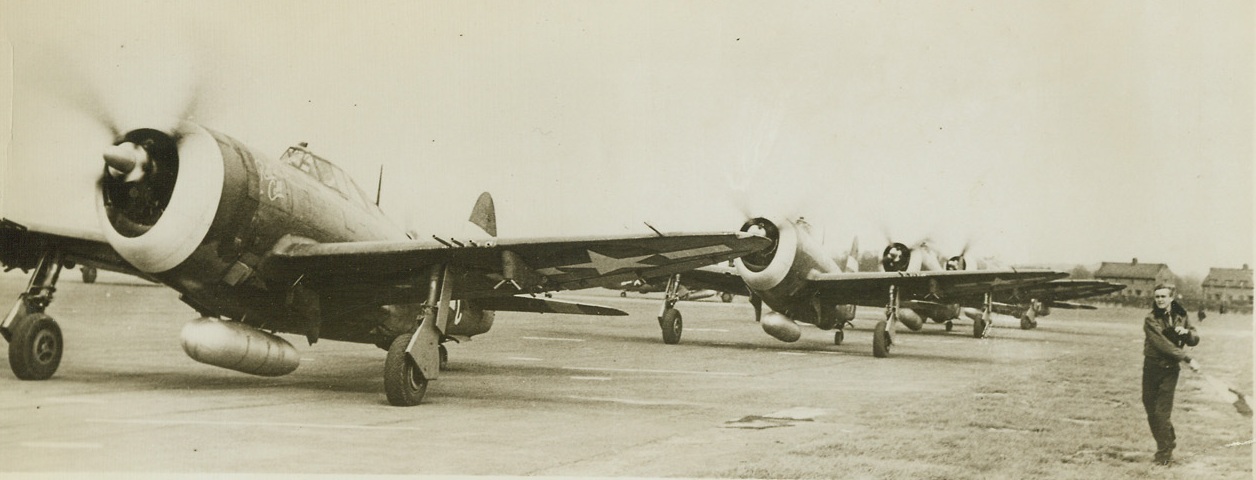
FLAGGING MEN OFF, 5/7/1944. SOMEWHERE IN ENGLAND – Lt. H.W. Collins, Army Air Forces pilot from Atlanta, GA., flags off a group of thunderbolt dive bombers as they set out on a mission over Louvain, Belgium. Pilots at the station take turns flagging the planes off as they roar out to smash airfields, cut communications and knock out Nazi batteries in preparation for the coming invasion of Western Europe.Credit: Acme;
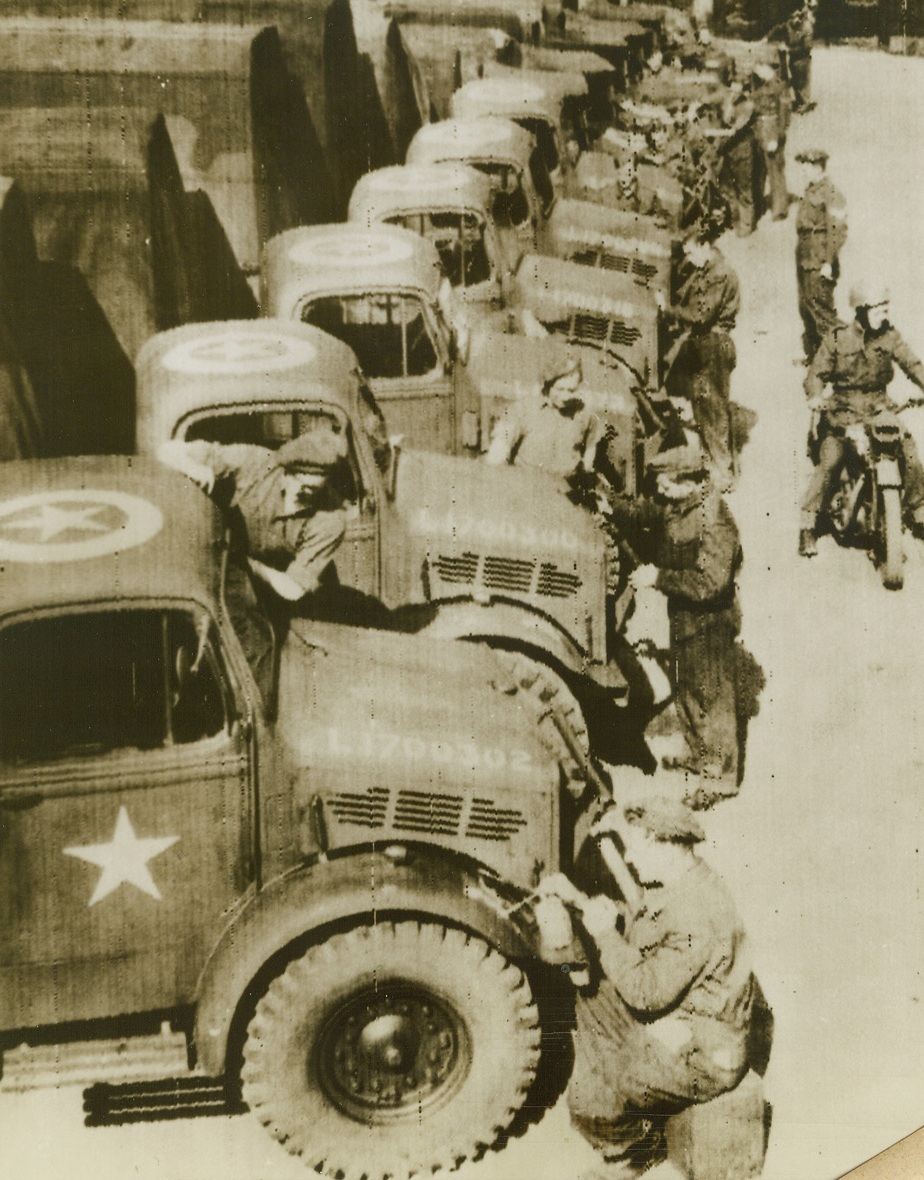
U.S. STAR MARKS ALLIED INVASION VEHICLES, 5/31/1944. ENGLAND – The five pointed white star which, until recently, marked trucks, tanks and other vehicles of the U.S. forces, will mark all vehicles of the Allied Expeditionary Force for the forthcoming invasion. An example ofh the complete integration of men and equipment under the command of Gen. Dwight D. Eisenhower, the “invasion star” here, (above), is shown being painted on British Army vehicles “somewhere in England.” This photo was radioed from London to New York tonight.Credit: Acme radio photo;
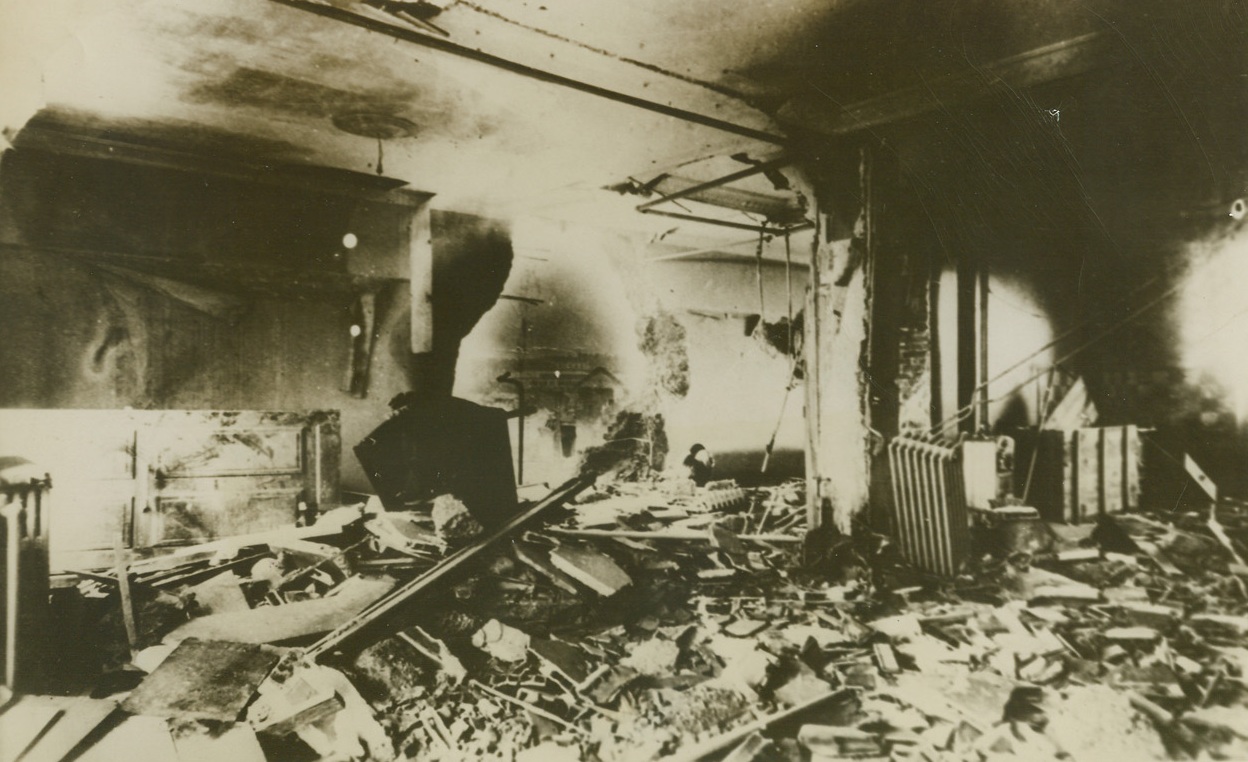
WORK OF FRENCH SABOTEURS, 5/18/1944. GRENOBLE, FRANCE—The handiwork of thorough French saboteurs, this German barracks at Grenoble is a shambles—its interior blown to bits by angry patriots after the Nazis refused to release hostages taken into custody after a previous act of sabotage. As a result of their effective resistance against the Germans, citizens of the town of Grenoble have been awarded the Croix de Guerre. Credit Line (ACME);
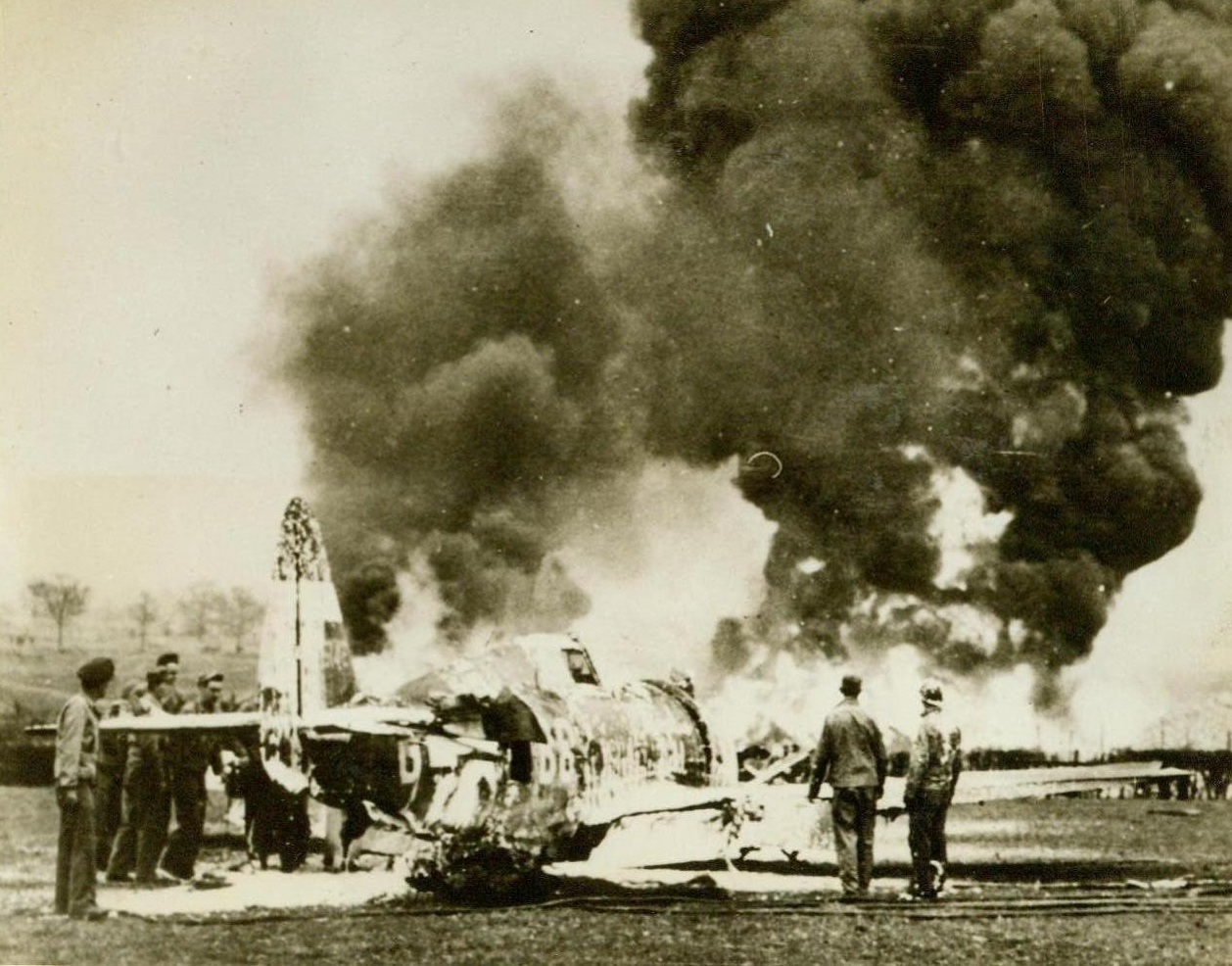
Grounded By An Oil Dump - 1, 5/19/1944. Britain - Smoke rises high in the sky from the sheets of flame enveloping this Thunderbolt Fighter Plane at a 9th Air Force Fighter Base. The plane, piloted by Capt. Thurman F. Morrison, of Memphis, Tenn., was taking off when it smashed into a 40,000-gallon oil dump and immediately burst into flames. Two alert members of an Ack-Ack Unit, Pvt. Harold Smith, Framingham, Mass., and Dominick J. Camonarano, Bronx, N.Y., perceived the plight of the trapped pilot, hacked the canopy from the cockpit, and rescued Capt. Morrison. Credit: USAAF photo from ACME;
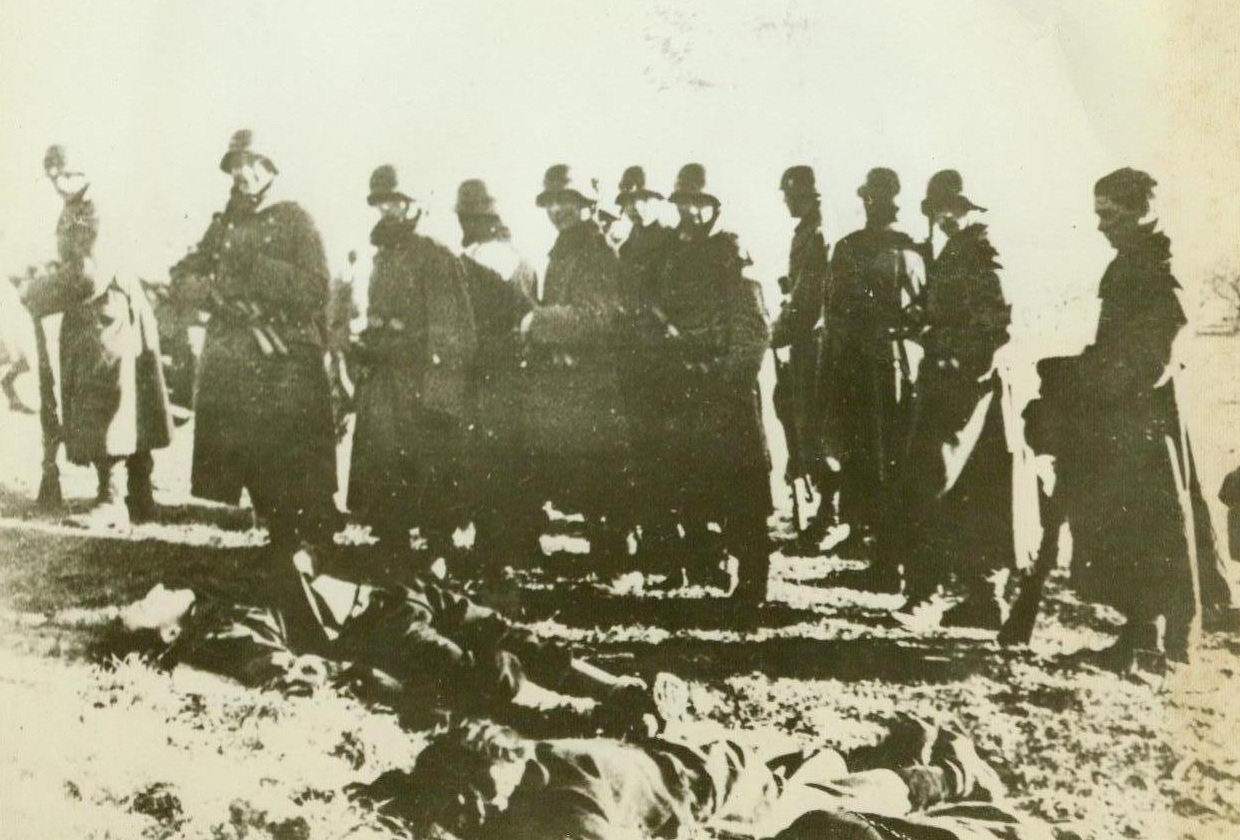
Murderers!, 5/18/1944. France - After executing a group of French patriots who were ordered to die because resistance in the area was becoming too much for the German High Command to handle, these German warriors take a last look at their victims before leaving the scene of mass murder. Only one (extreme right) of the group has the decency to bare his head in the presence of the dead, while the rest appear pleased with the job that will be avenged as efficiently as it was executed. Credit: ACME;
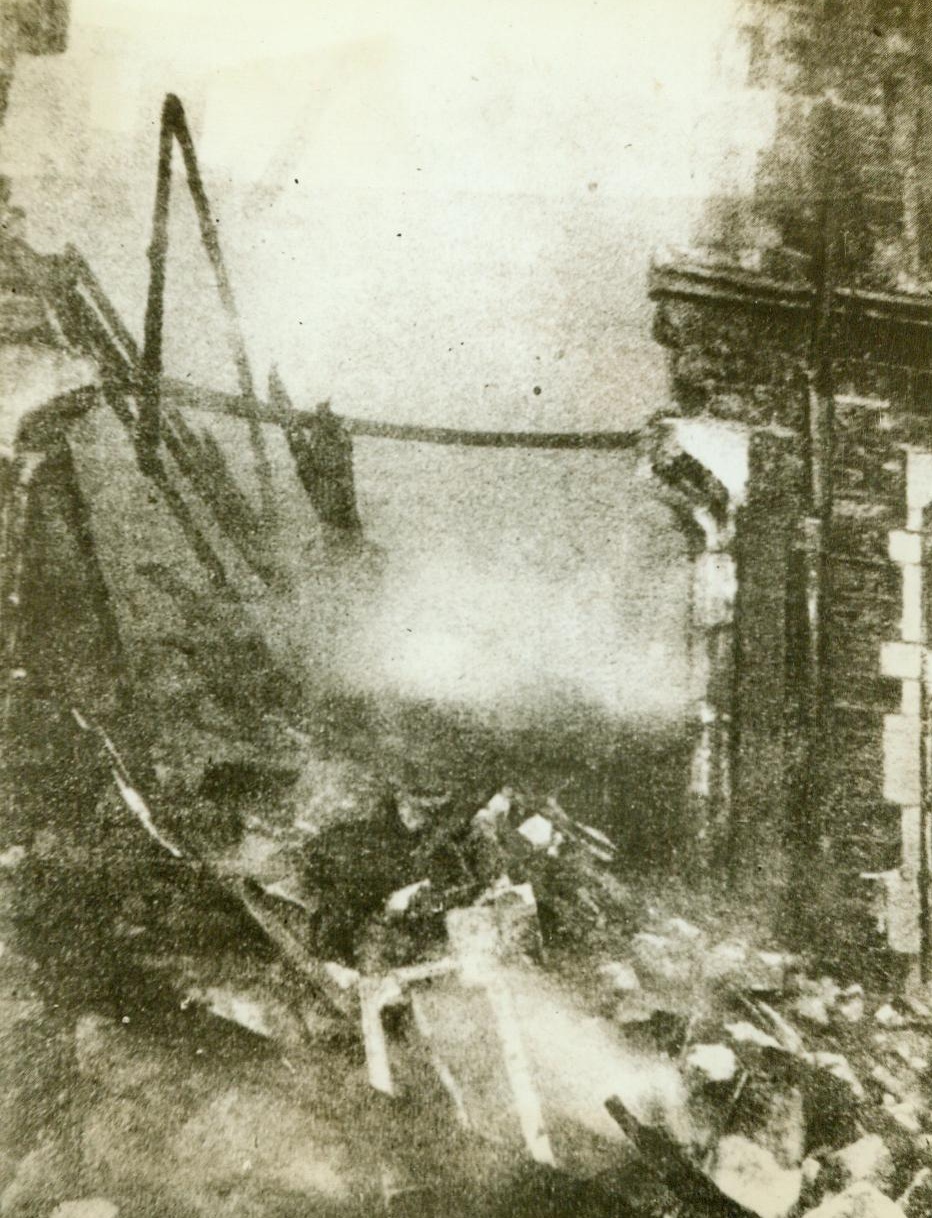
War Sends Its Little Gift Of Roses, 5/19/1944. France - Burning embers fall to the ground from this building on the Channel coast of France, and only small parts of the walls are left standing after the Allies flew over and brought gifts, in the form of blockbusters. The renewed intensity of Allied Air Raids is at last giving the enemy a taste of what their planes have been giving to England for the last two years. Credit: ACME;
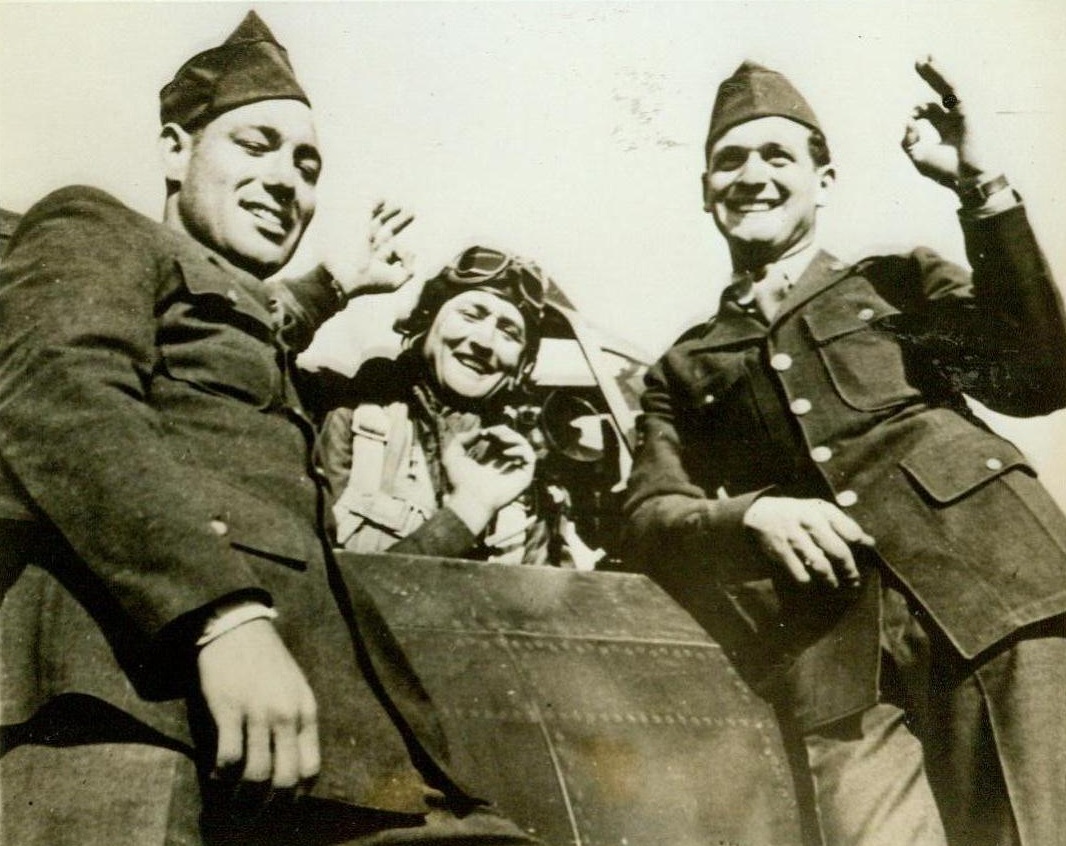
Grounded By An Oil Dump - 2, 5/19/1944. Britain - It was a narrow escape from death for Capt. Thurman F. Morrison, of Memphis, Tenn., when his Thunderbolt Plane failed to take to the air and crashed into a 40,000-gallon fuel dump at a 9th Air Force Fighter Base somewhere in Britain. Capt. Morrison was certain the burning plane would be his funeral pyre, but two members of an Ack-Ack Unit, Pvt. Harold D. Smith (left), of Framingham, Mass., and Cpl. Dominick J. Camonarano, (right) Bronx, N.Y., saw his plight, hacked open the canopy of the cockpit with shovels, and hauled him to safety. Credit: USAAF photo from ACME;
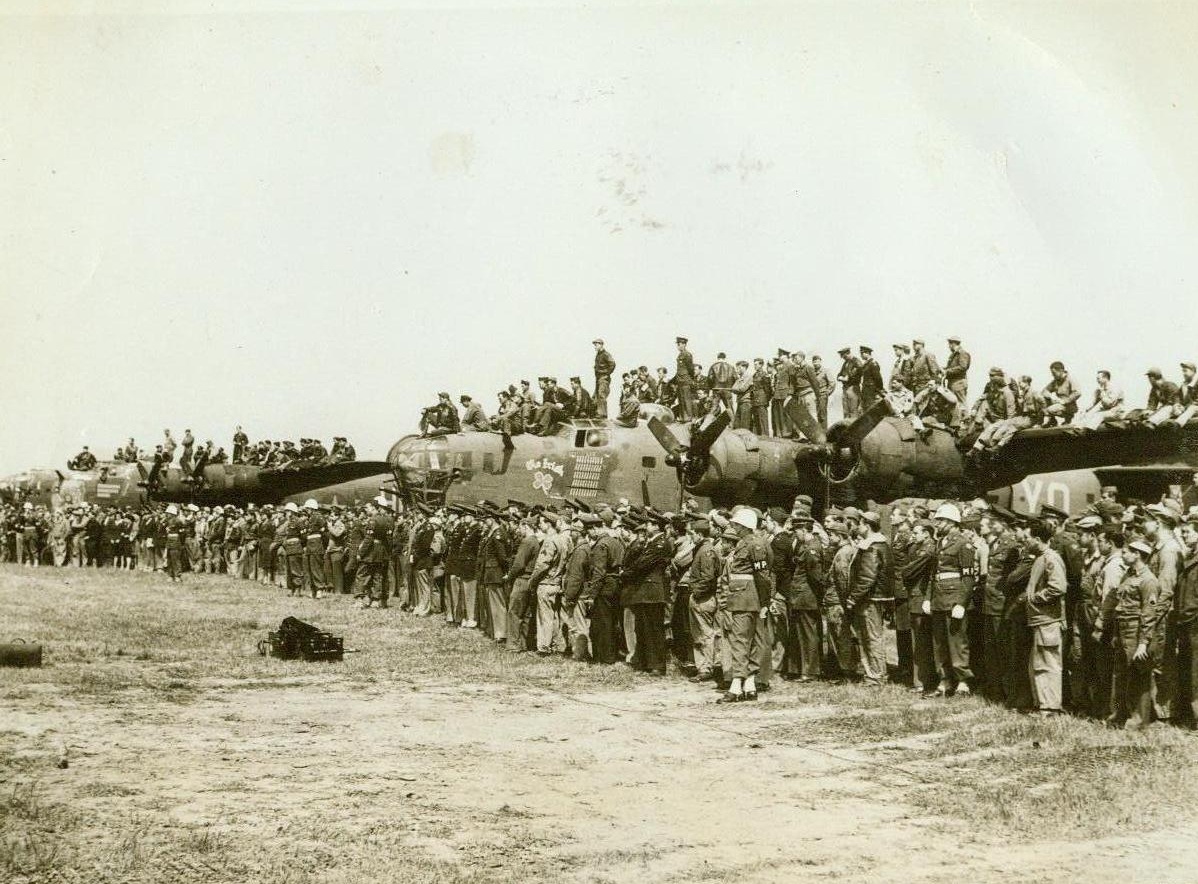
Honor Ploesti Raiders, 5/18/1944. Somewhere in England - The strong wings of Liberators that participated in the first low-level daylight raid on the oil fields of Ploesti make standing room for U.S.A.A.F. fighting men watching ceremonies in which Ploesti raiders were honored. Men who took part in the attack were awarded medals and War Department Citations when Lt. Gen. Carl Spaatz and Lt. Gen. Jimmy Doolittle visited the base of the Liberator Bombardment Group somewhere in England. Credit: ACME;
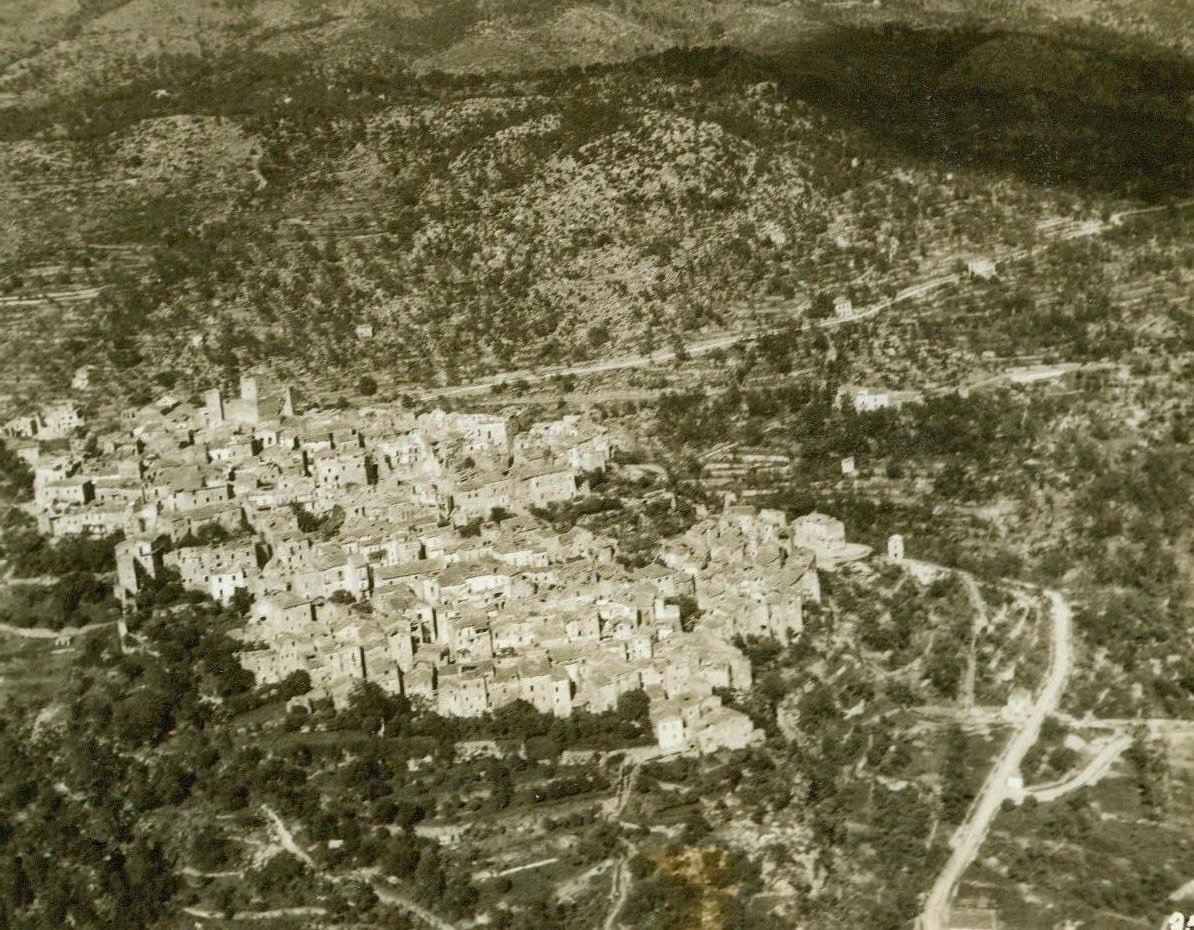
French Troops Take Town, 5/25/1944. Italy - Ausonia, ridged on all sides by treacherous mountains, was captured recently by French troops after bitter fighting in the area. With the opening of the new blow from the Anzio Beachhead, the Allies are now set for the final battle for Rome. Credit: ACME photo by Charles Seawood, War Pool Correspondent;
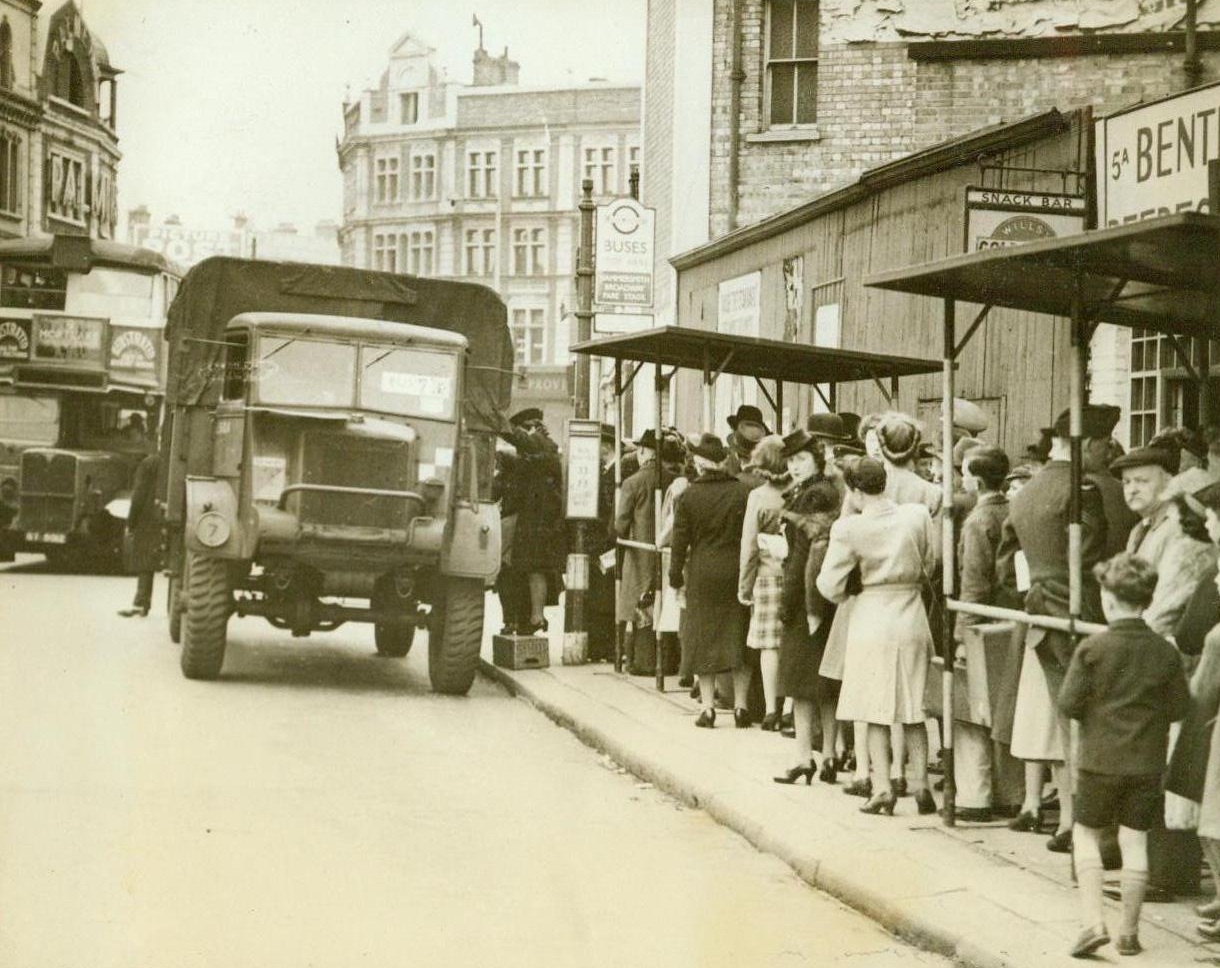
Army Trucks Step In, 5/3/1944. London -- Stranded when London bus drivers went on strike in objection to long working hours recently, these Britishers wait to climb into Royal Army trucks that took over bus routes while grievances were being discussed. Using a mineral water crate as a step, one woman climbs into the truck pinch-hitting for Bus 73. Credit: ACME;
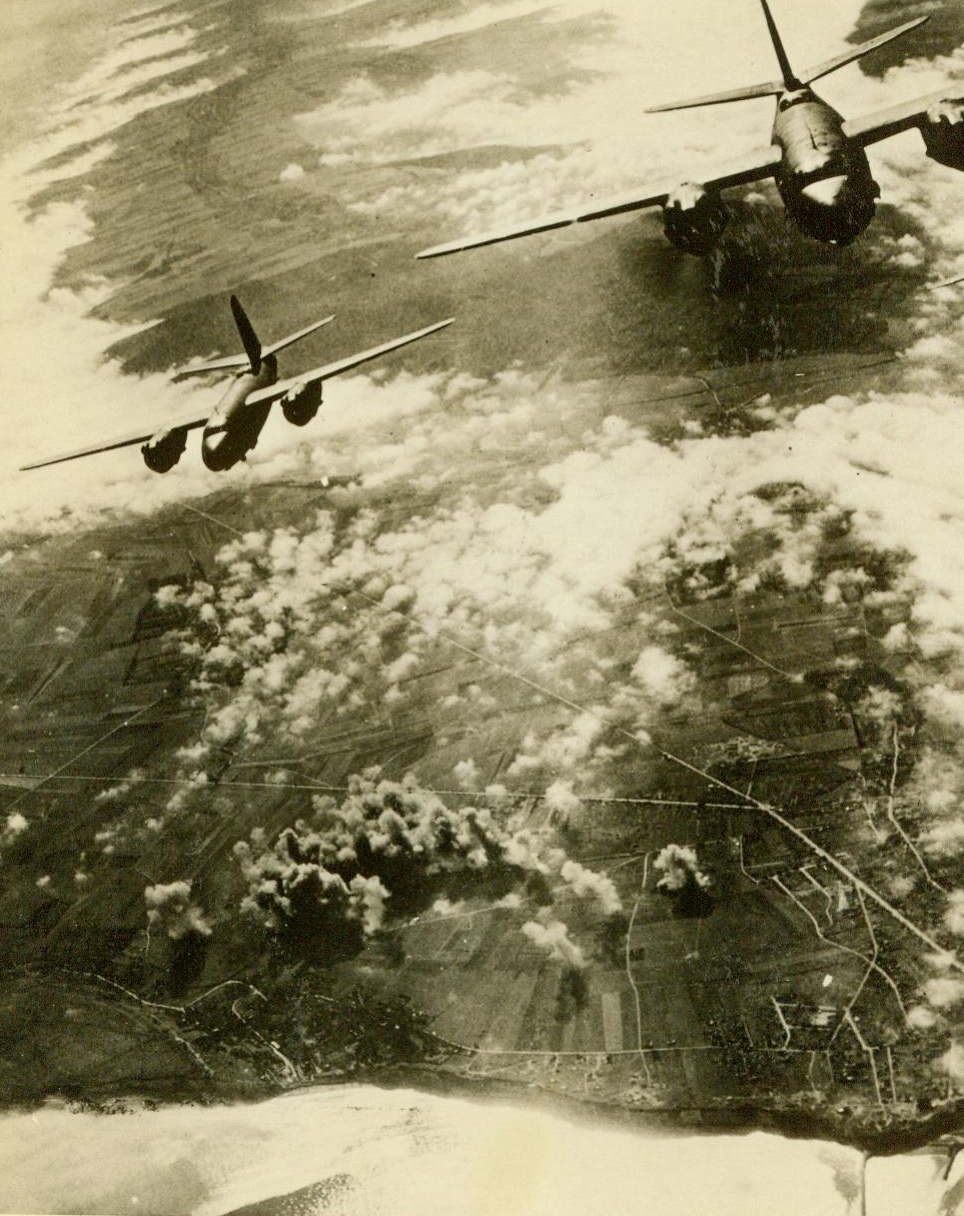
Mission Accomplished--Homeward Bound, 5/3/1944. Over France -- Dusty clouds far below tell the tale of a mission accomplished, and these two B-26 Marauders head for home with empty bomb racks. These Marauders have been carrying a great deal of the load of pre-invasion raids on occupied France and important industrial and communications centers in Germany. Some of these planes are based in England, and others in Sardinia and Italy, where French airmen constitute their crews. A noticeable weakness in enemy land defense has been accomplished through these tremendous Allied air attacks. Credit: Official USAAF photo from ACME;
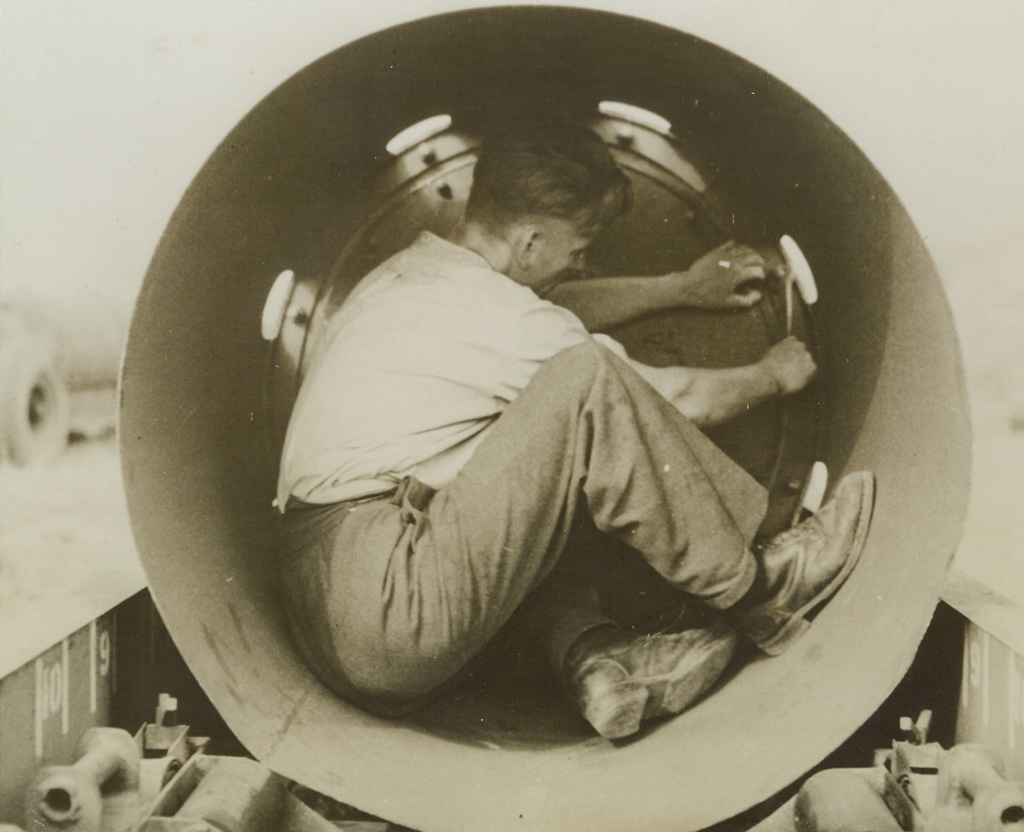
He’s Playing with Dynamite!, 5/8/1944.England – This armourer is working in close and dangerous quarters as he makes adjustments inside the fin of an 8,000-pound bomb. Night after night, these famous “blockbusters” of the RAF bomber command screech earthward from RAF bombers over enemy territory. German industrial and transportation centers have been almost impossibly crippled by these devastating raids. Daylight follow-ups by the AAF smash at vital enemy points. Credit: ACME;
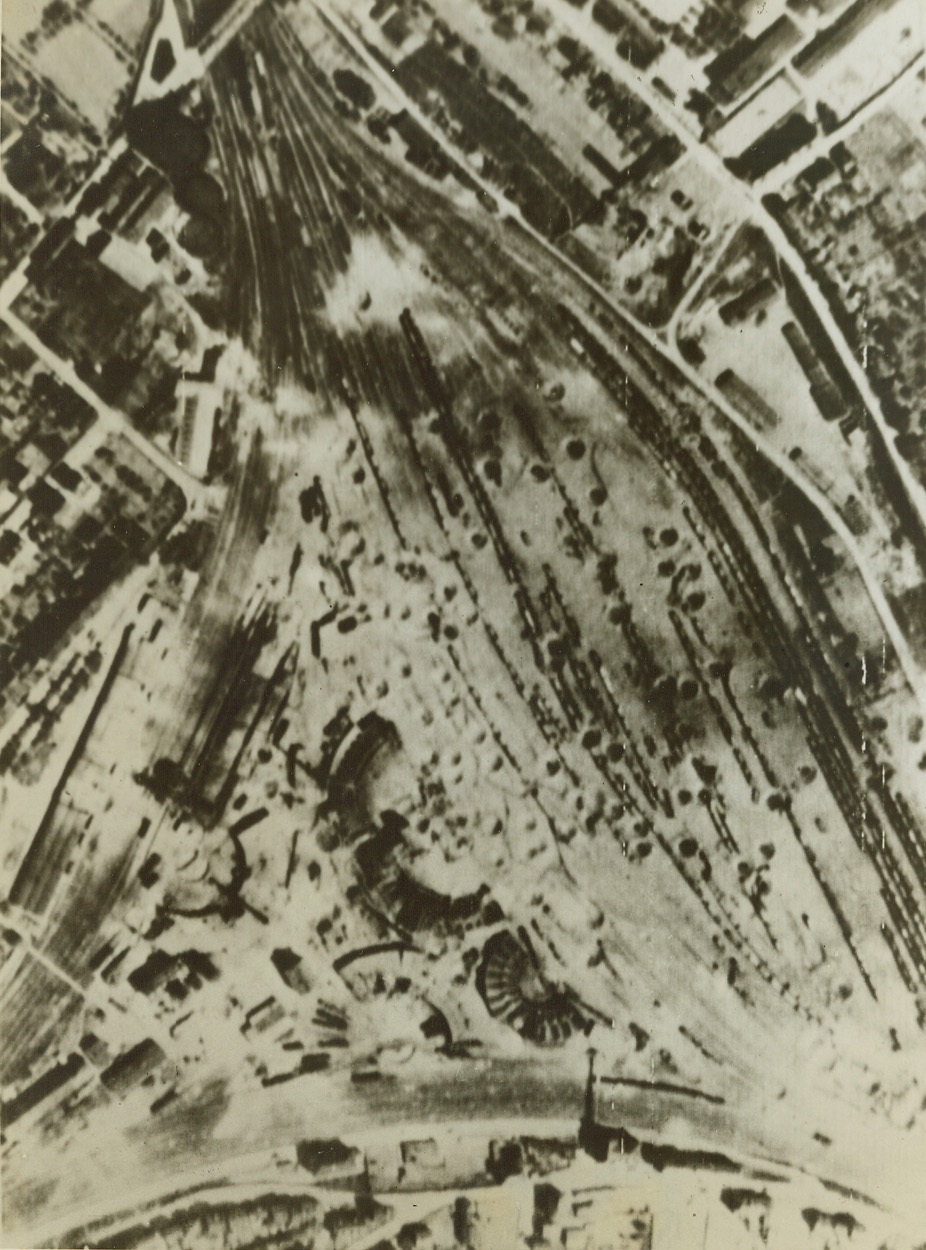
More USAAF Precision Bombing, 5/6/1944. Metz, France – These railroad yards at Metz are pitted with bomb craters following another raid by U.S. Flying Fortresses and Liberators on May 1. Faultless precision bombing resulted in direct hits on tracks, rolling stock and roundhouses at the yards—heavy blows to the already crippled German transportation facilities. Metz was just one of six Nazi rail yards hit by U.S. planes on the afternoon of May 1. Passed by censor. Credit: Signal Corps photo from ACME;
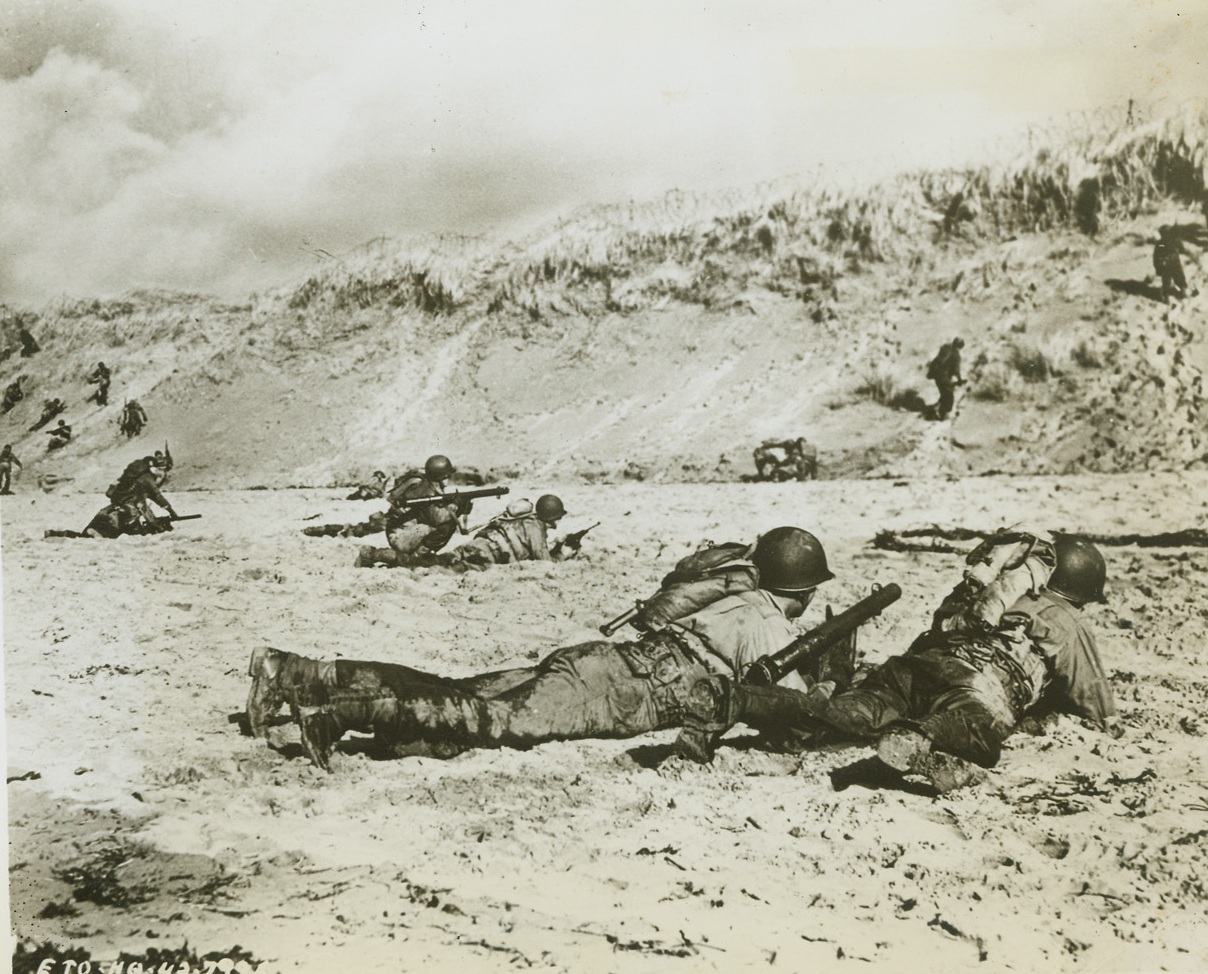
Up in Arms, 5/5/1944. England – “Hitting the deck” after landing on the beachhead, these American infantrymen train their MI Launcher Rockets, better known as “Bazookas,” on imaginary enemy beach defenses during realistic training for the coming Allied invasion of the continent. The Bazooka, which has a high shocking power, is primarily used as an anti-tank weapon because its powerful rocket shell is capable of piercing tank armor. The Yanks in this picture have just landed on the beach and still wear their US Navy life belts. Credit: Official US Army photo from ACME;
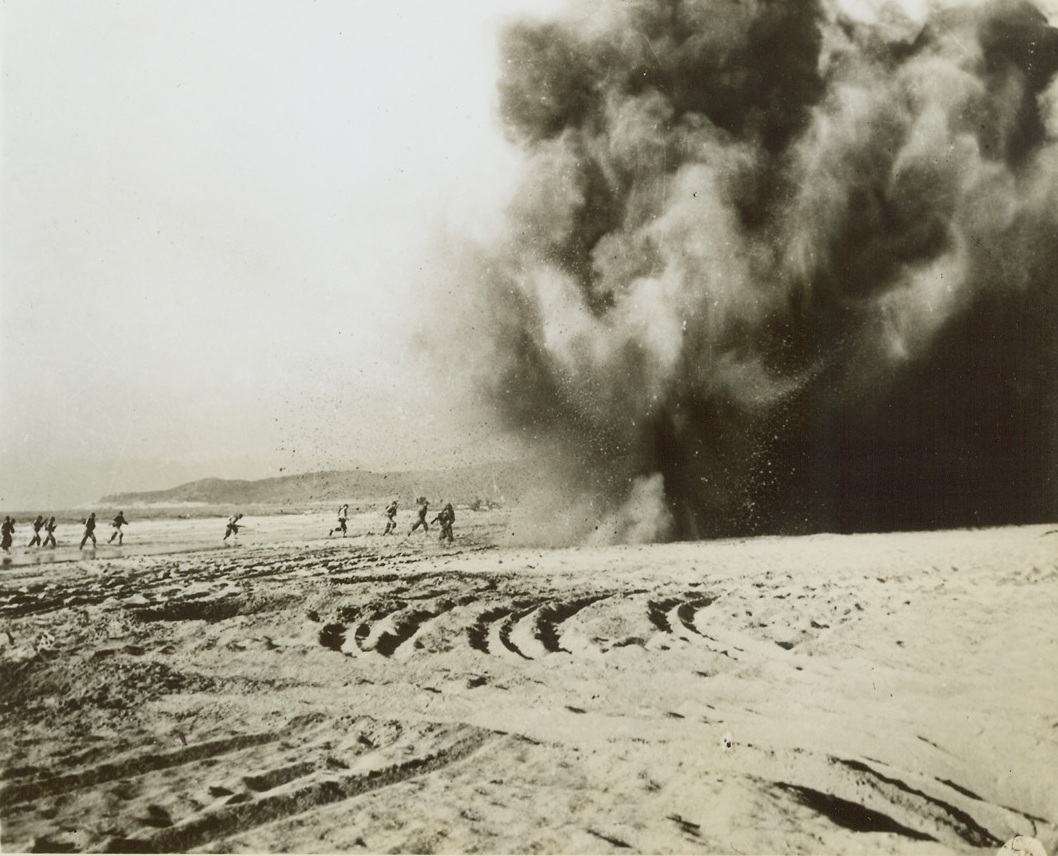
Practice Makes Perfect, 5/5/1944. England – Dodging shell bursts as they rush across the sandy beach, these American infantrymen go through some rugged training for the coming invasion of the continent. Working under realistic conditions, amphibious forces land on the beach and storm “enemy” beach defenses amid explosive charges which simulate enemy artillery bursts and bombing. Working on the theory that “practice makes perfect,” amphibious maneuvers of this type are being conducted throughout England. Credit: Official US Army photo from ACME;
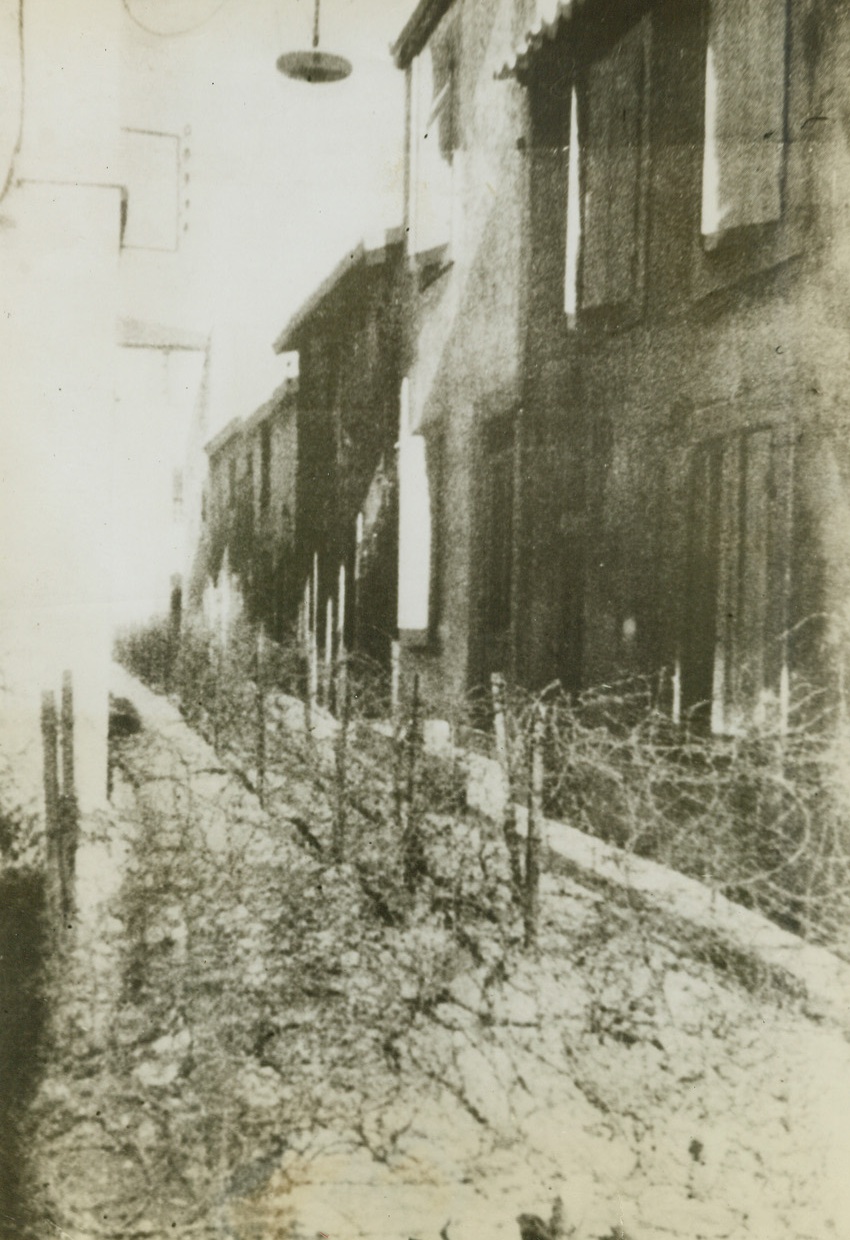
German Invasion Defense, 5/22/1944. France – Streets leading through a French fishing village from the beach are mined against tanks and filled with barbed wire obstacles to impede assault troops. This picture, received from London through a neutral source, shows one method the Nazis have adopted to attempt to obstruct the Allied forces making the sea-borne invasion of Europe. Credit: ACME;
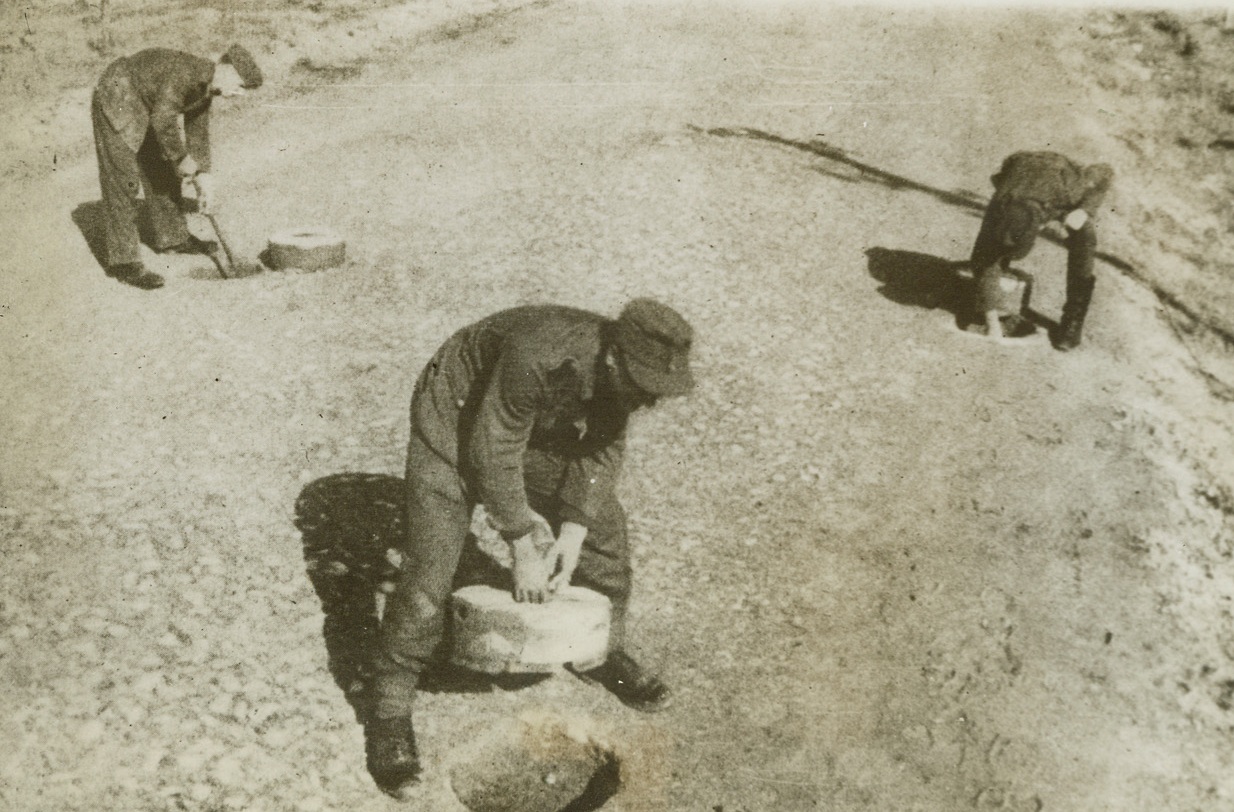
Nazis Plant Garden of Trouble, 5/22/1944. France – In their effort to impede the advance of Allied forces making the sea-borne assault on Europe, the Nazis have transformed the peaceful French coast into a complicated labyrinth of anti-invasion defenses. A beach road is shown being mined by German Sappers. Credit: ACME;
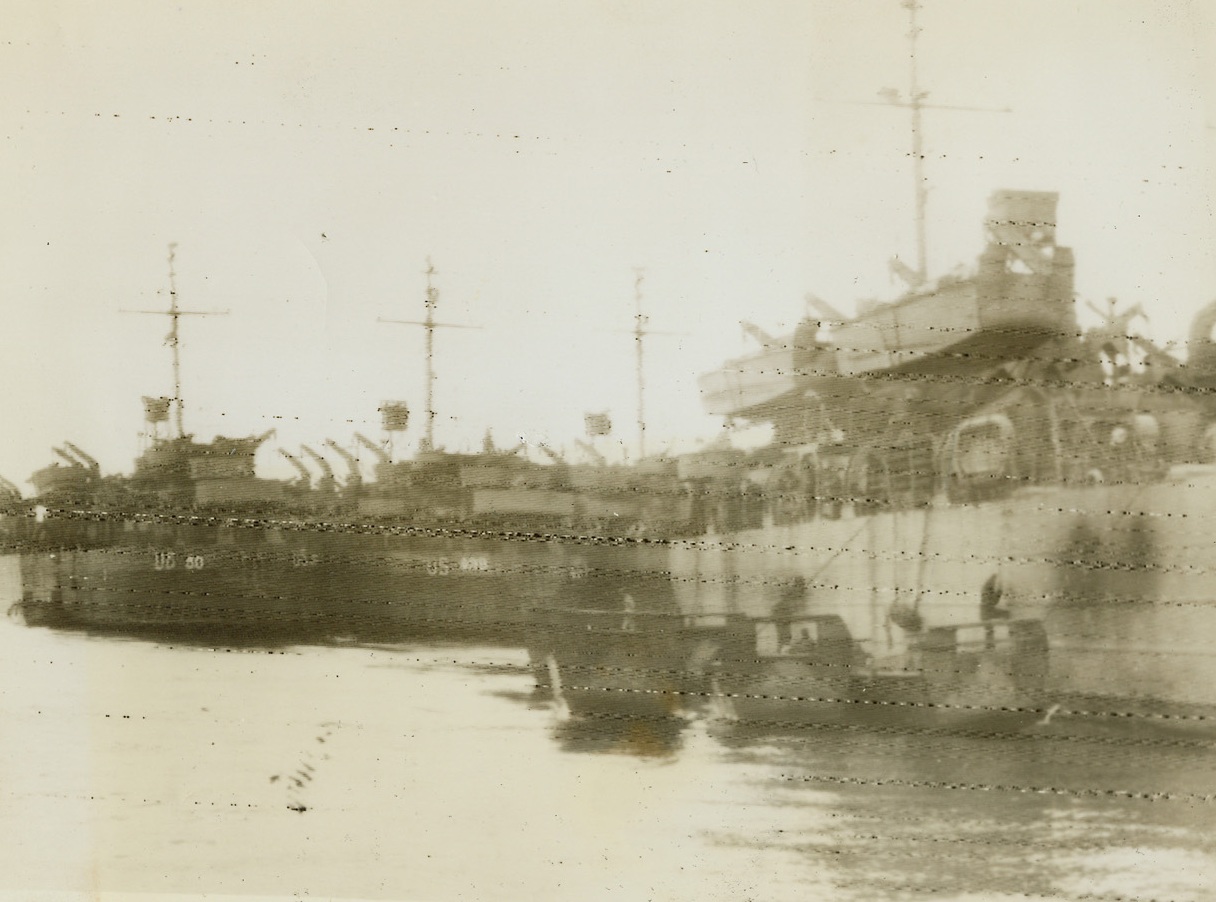
Invasion Ships Mass Off British Coast, 5/16/1944. England – This photo, radioed today from London, shows landing craft of all types massed off the British coast in readiness for the coming invasion. It was reported that the tremendous fleet consisted of large concentrations of transport ships every kind of landing vessel. It is said to be the largest number of ships afloat off the British coast since the Dunkerque evacuation. Credit: ACME Radiophoto;
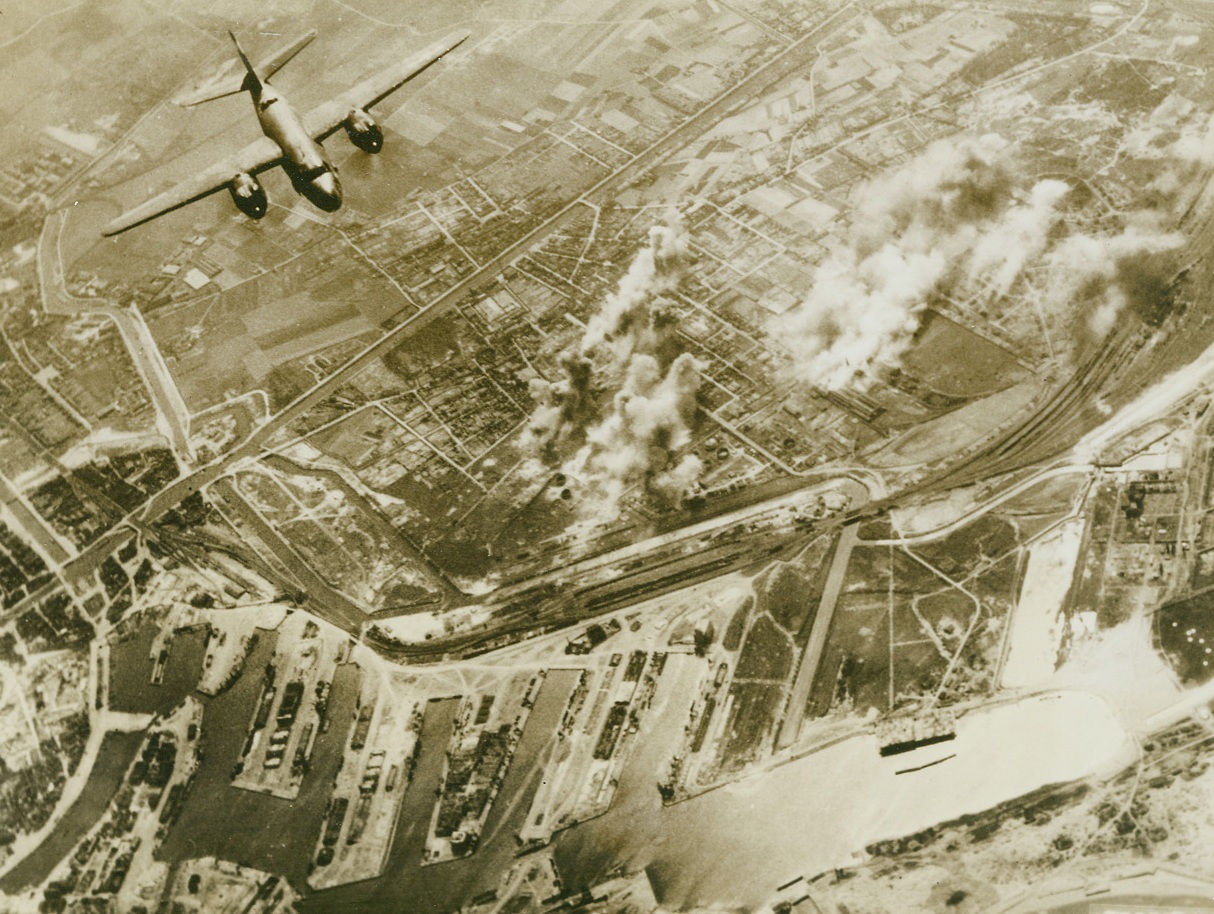
War Comes To Dunkirk Again, 5/16/1944. France – The bitter memory of Dunkirk is partially avenged as a 9th Air Force Marauder Bomber leaves a smoking target behind and heads for home after another sortie against Nazi military installations. The smoke from bomb bursts indicates hits on a railway and other objectives in Dunkirk. Credit: Official USAAF photo from ACME;
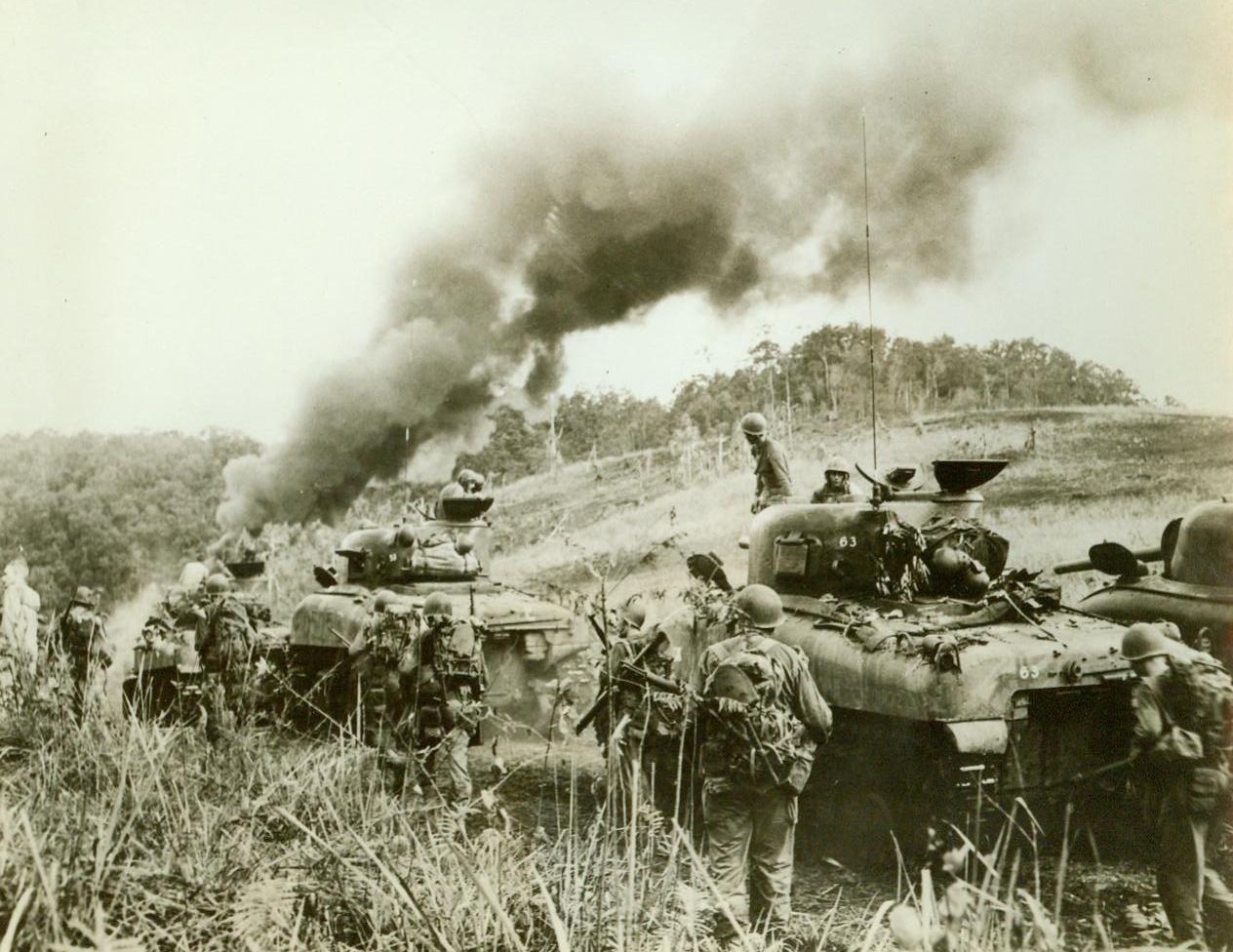
“Battle-Wagons” Carry Invading Allied Forces, 5/8/1944. Hollandia— Organizing these “General Sherman” tanks to set out in pursuit of Fleeing Japs, these Allied soldiers head in the direction of the heavy wooded areas around Hollandia. The invading forces struck a surprise blow at the Japs at Hollandia, and came out of the battle with one more important enemy airfield added to their roster of conquered enemy territory. These routine “mop-up” patrols are designed to crush and remaining Jap resistance. 5/8/44 (ACME);
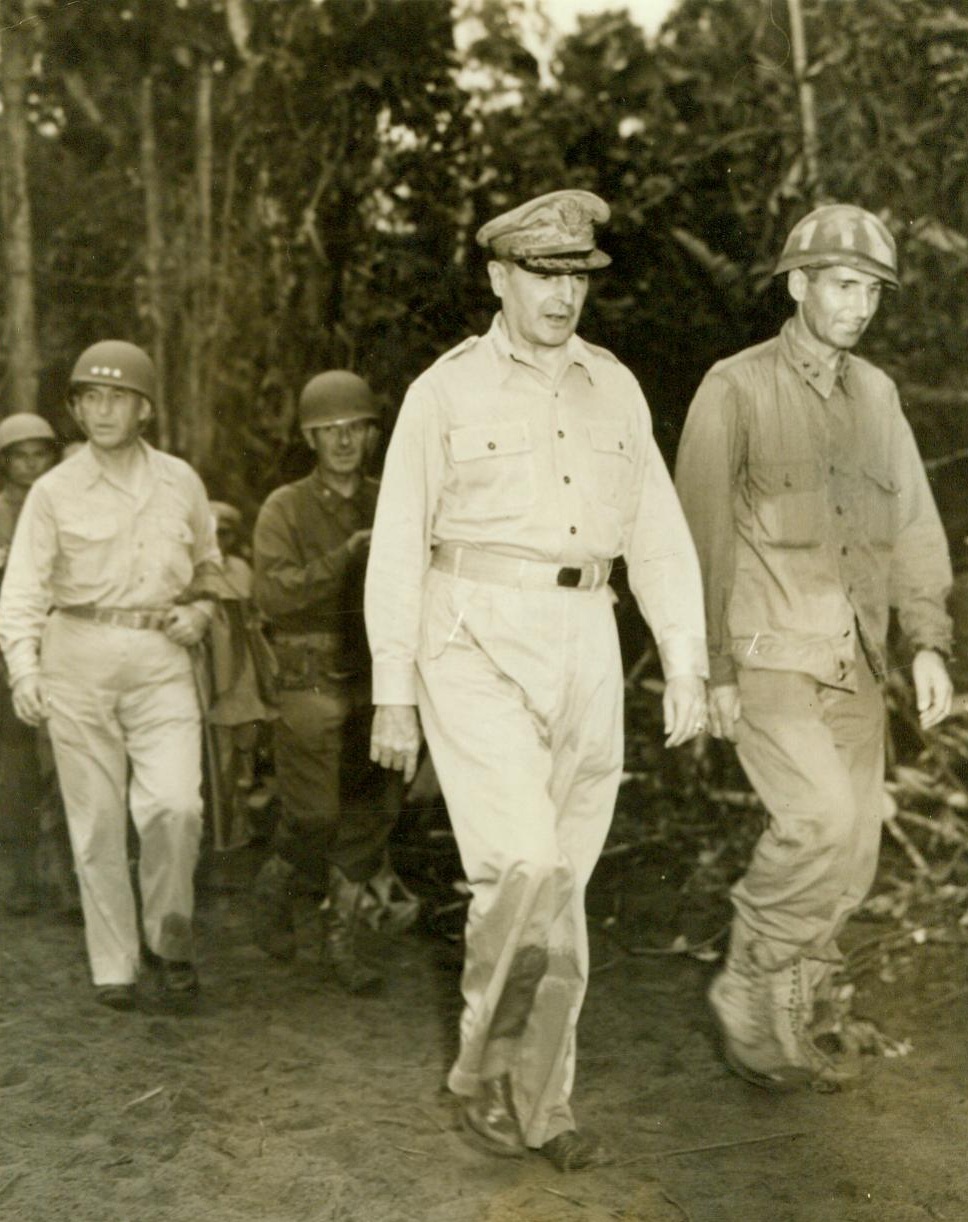
MacArthur Makes an Inspection, 5/8/1944. New Guinea—Gen. Douglas MacArthur (Center) makes a preliminary inspection of the newly captured bay area, in Hollandia. With the Allied Chief are Lt. Gen. Walter Kruger (Left) and Maj. Gen. Fred Irving (Right). Yank Soldiers eager to get a “look-see” at the land they invaded follow their General into the densely wooded area. Allied forces invading important Jap strongholds in Dutch New Guinea recently took the enemy by surprise and met very little resistance, and succeeded in capturing the important Japanese airfield at Hollandia, a strategic move in the battle for control of the Pacific. 5/8/44;
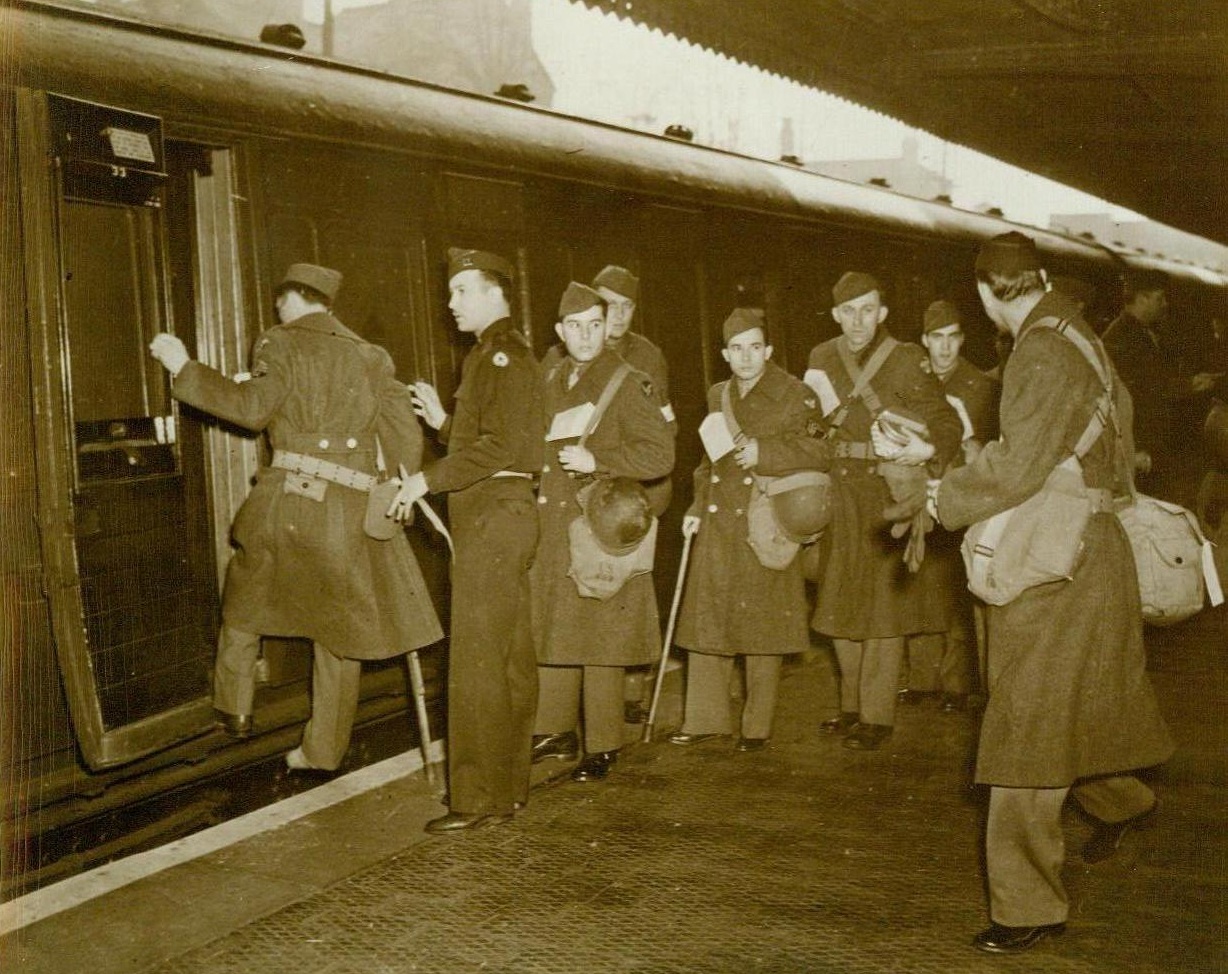
American Wounded Return Home, 5/8/1944. Washington, D.C.- American wounded soldiers board a hospital train in England on their way back ome. They are placed in ward cars according to their type of illness or injury. Many of them will get medical discharges from the Army, while others will be sent to hospitals for further treatment and then returned to active duty. Capt. Capt. V.J. Panvini, of Forest Hills. L.I.N.Y., is seen directing the patients onto the train 5/8/44 Acme;
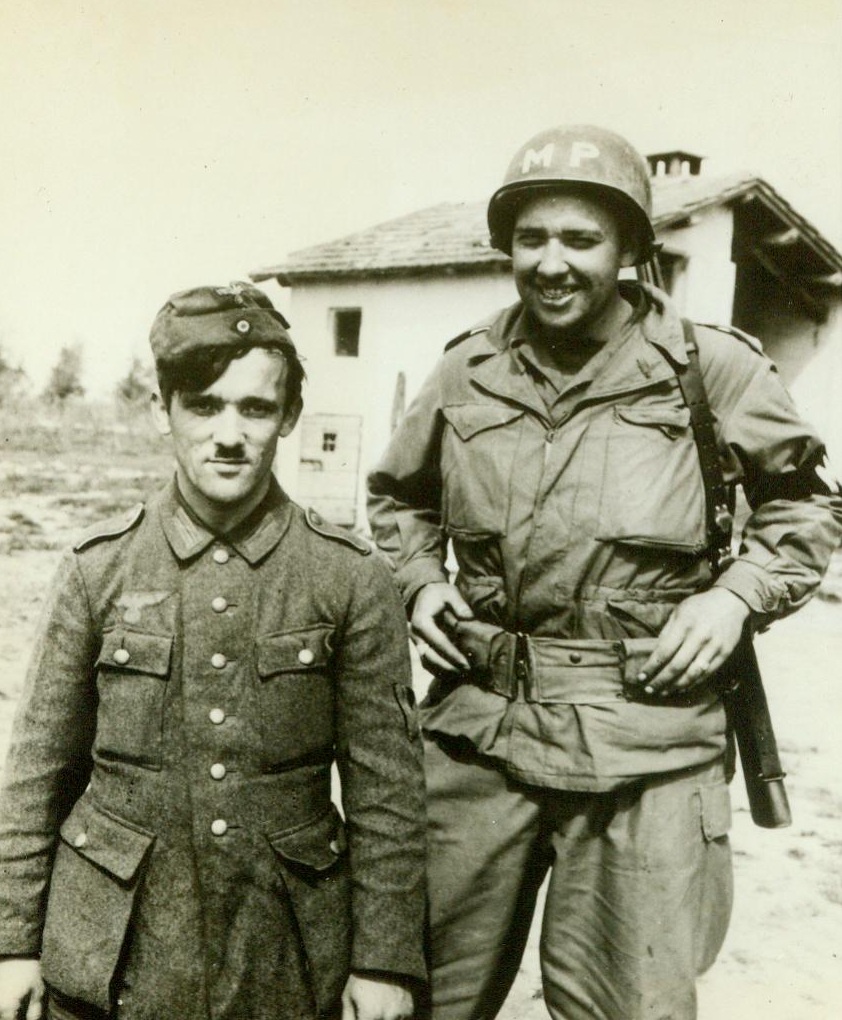
O-OO-OH, That Face!, 5/19/1944. Italy -- This Nazi prisoner, bearing a striking resemblance to Chaplin imitating Hitler poses for the cameraman with grinning M.P. William Spalding, of Dresden, N.Y. Had he not known that Der Fuehrer was safely hiding back in Der Fodderland, Spalding might have thought he had captured the Dictator himself. However, now that the Allies are on the warpath, it won't be long before this phoney picture will be duplicated "in the real" when our forces march into Berlin and out again mit Adolph 5/19/44 (ACME);
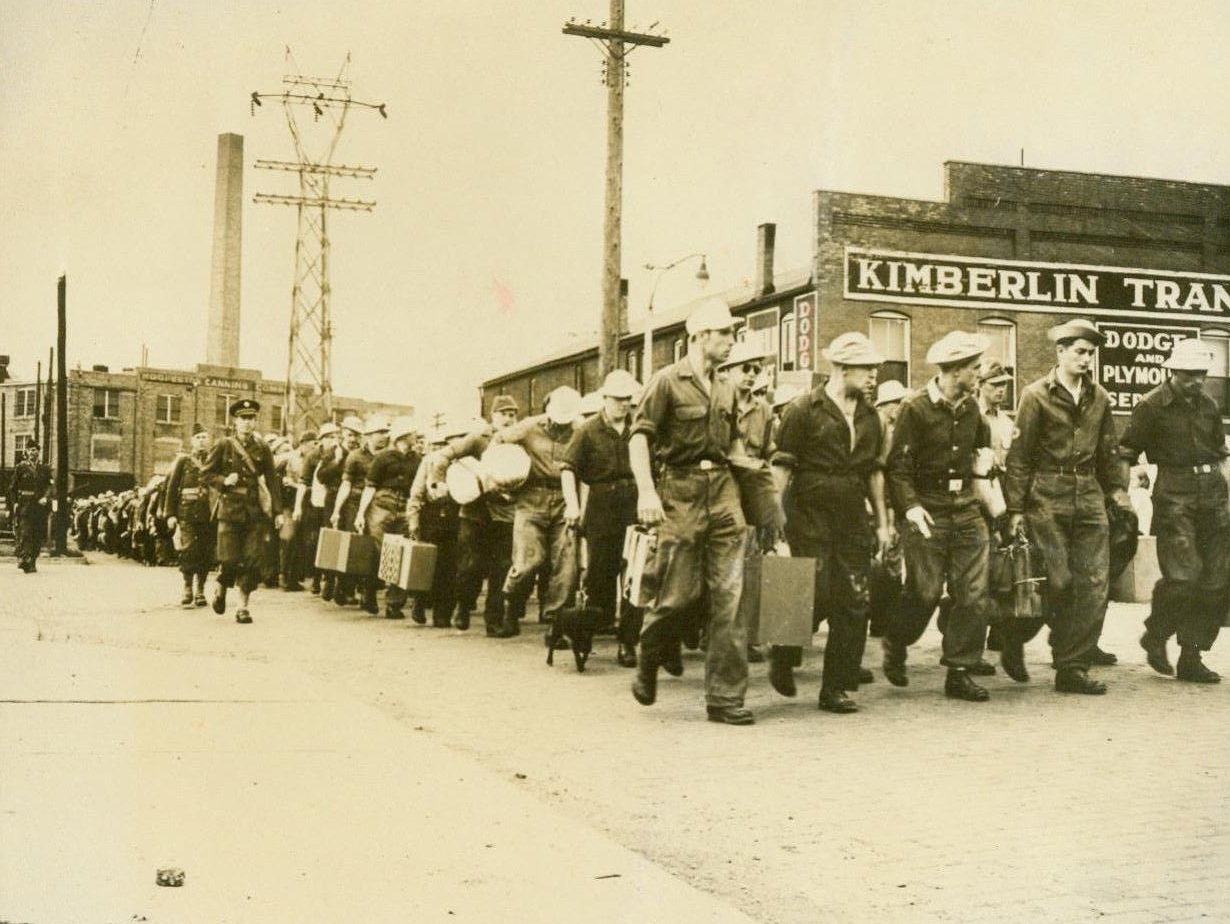
Midwest Sees Nazis March-As Prisoners, 5/26/1944. Hoopeston, Ill. - German war prisoners are marched under guard from the railroad depot in Hoopeston, Ill., to work in vegetable fields and canneries. They will also work in the vicinities of Gibson City, Rossville, and Millford, Ill. They are carefully segregated from civilian laborers. 5/26/44;
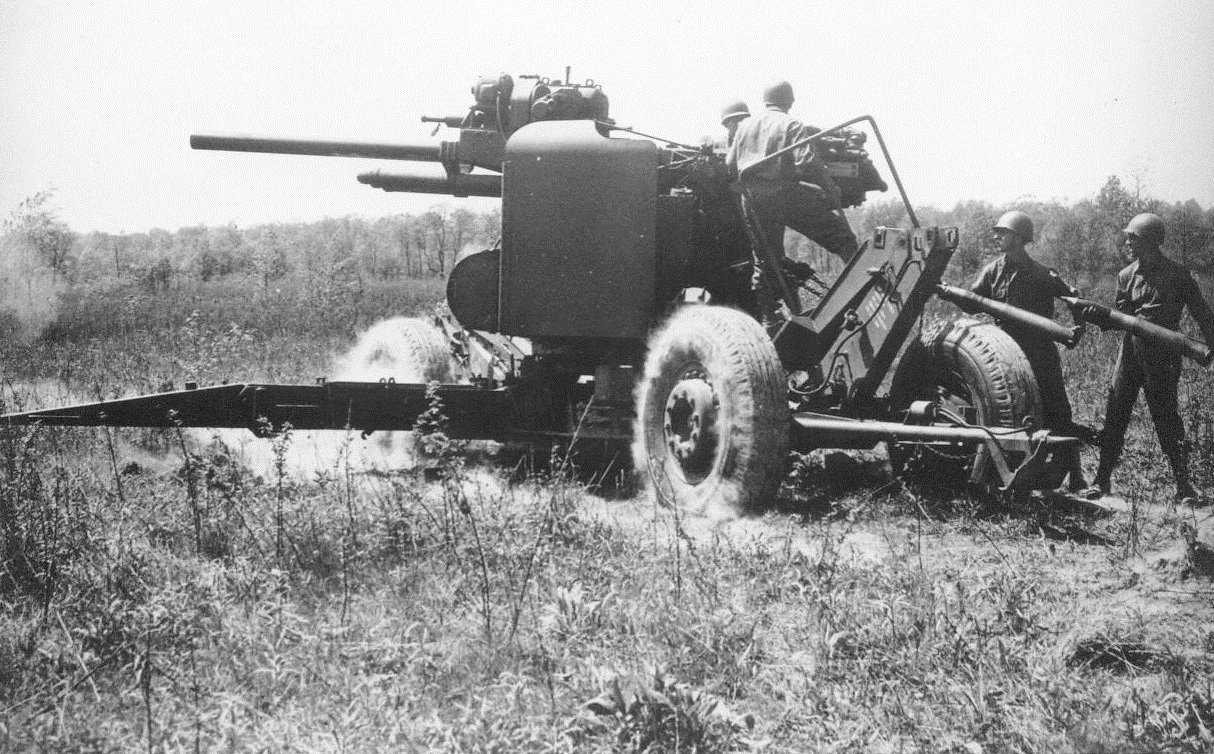
Versatile Artillery, 5/19/1944. The 90-MM. Anti-Aircraft Gun, developed by the Ordinance Department, has become one of the most versatile weapons in the service. Besides being used against aircraft, the weapon has been found to be extremely effective as an anti-tank gun. For this purpose it is fired from its mobile carriage. The gun will be on exhibit in Washington, D.C., during The Weapons of War Exhibit. 5/19/44 (ACME);
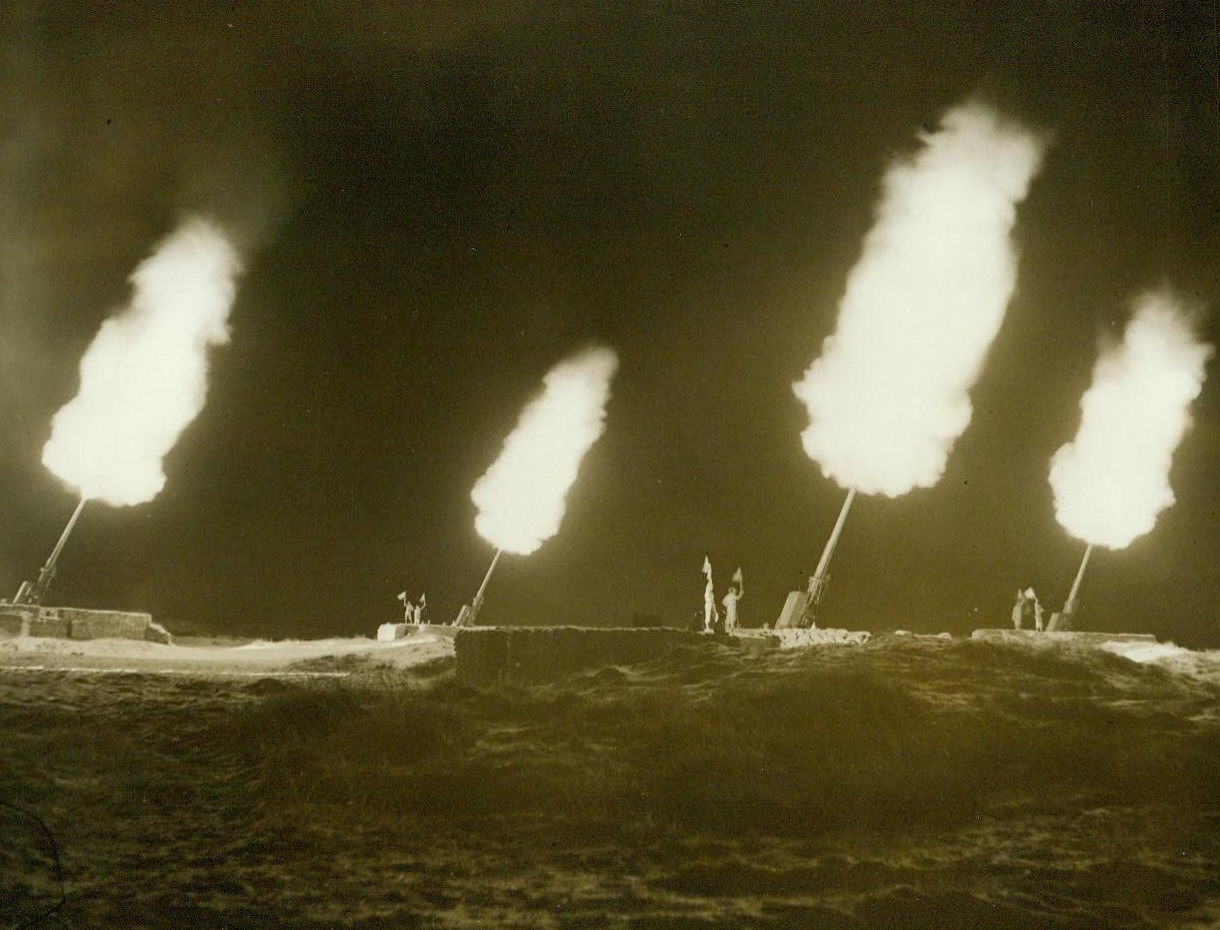
Martian Pattern Paints Luftwaffe Doom, 5/29/1944. Camp Davis, N.C. – A battery of 120MM. anti-aircraft guns, firing simultaneously during night practice at Camp Davis, N.C., create weird patters of light – Designs for the destruction of Hitler’s Luftwaffe. The gun has a vertical range higher than any other anti-aircraft gun known in use. It has been dubbed the “Stratosphere” gun as shells fired actually do go that high. 5/29/44 (ACME);
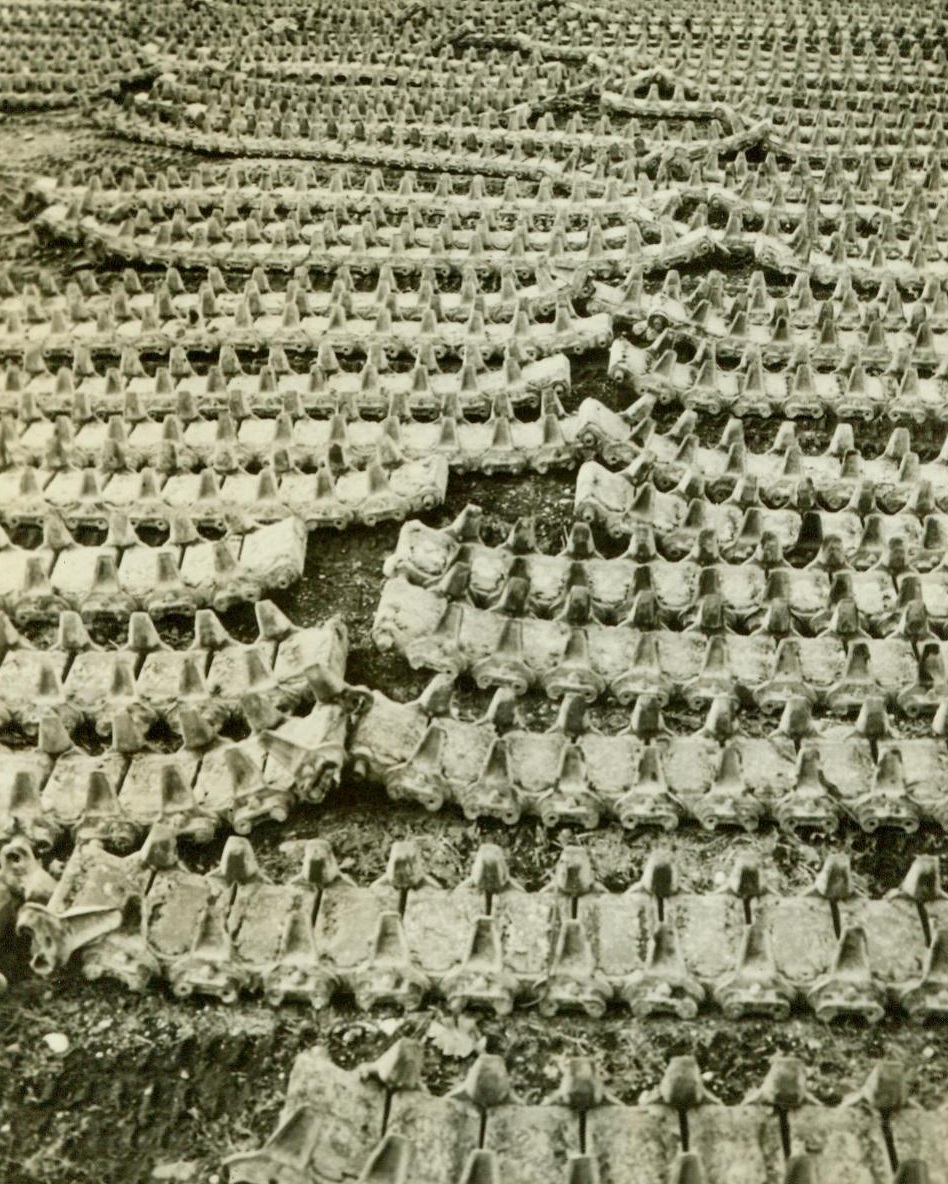
New "Life" For Damaged War Vehicles, 5/2/1944. Fort Lewis, Wash. – The casualties in vehicles and other equipment in this highly mechanized war, is high. But, shattered steel and machinery is not left on the battlefield to rust and much of it is rebuilt and put back into action – Very little is wasted. At the U.S. Army’s Mount Ranier Ordinance Depot, one of the many such depots in various parts of the country, combat, and service and transport vehicles are repaired, reclaimed, or salvaged. Here, the vehicles, collected in the far-flung battle areas of the World, roll in from ports of embarkation on flat cars. They are unloaded and classified and machines which can be repaired to a degree that will restore them from 95 to 100 per cent as efficient as when new, will be rebuilt and returned overseas. Those which can be repaired but not to as high a degree of efficiency, will be shipped out to training centers, and those beyond repair will be dismantled for salvageable parts. What is left over will be sold for junk and will find its way back into the war effort through scrap. This series of photos, made at the Mount Ranier Ordinance Depot, adjacent to Fort Lewis; shows how damaged vehicles are “given new life.” Stripped from tanks on the battlefield, these tank tracks will be reclaimed at the depot shops and then sent back into action. 5/2/44 (ACME);
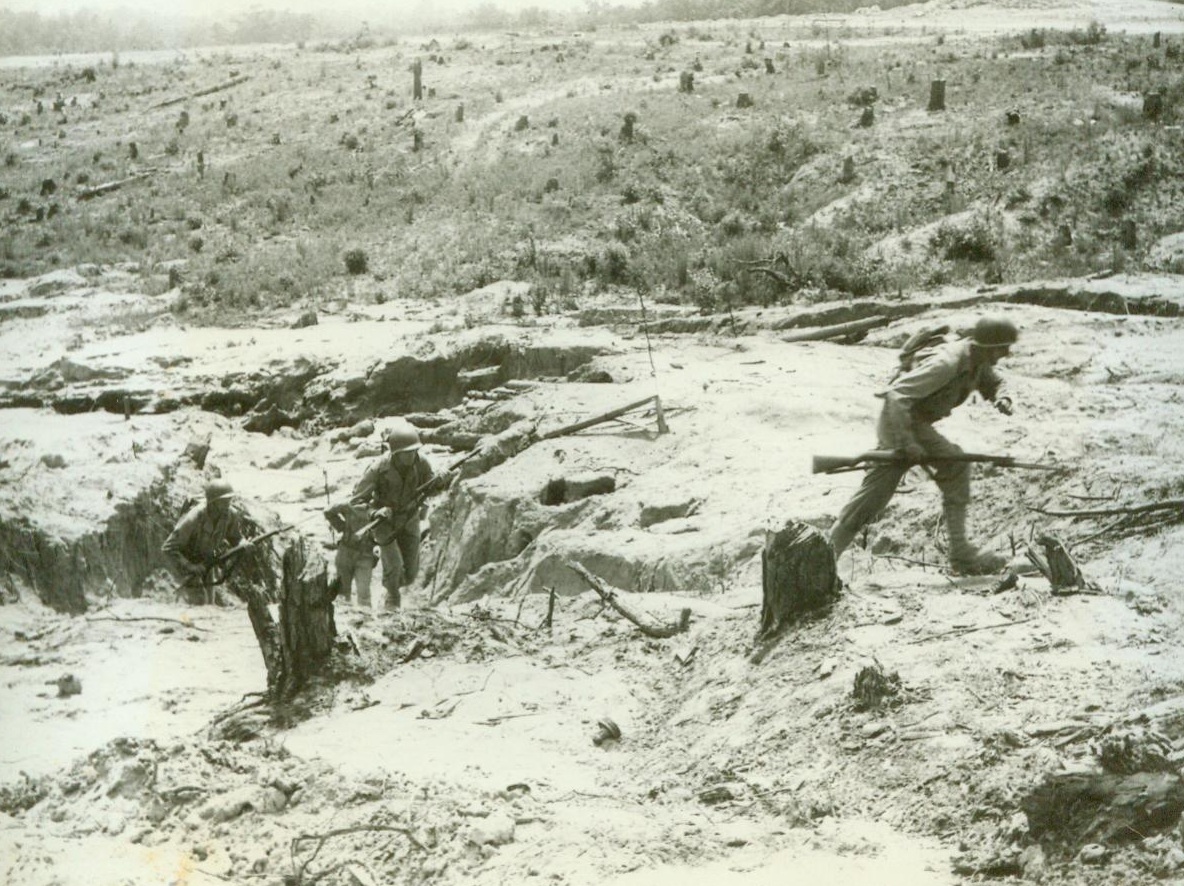
The Infantry Schools West Wall, 5/4/1944. Ft. Benning, Ga. – Newest assault course at Fort Benning is the infantry school’s authentic exterior replica of a section of Germany’s famed West Wall, a series of pillboxes and blockhouses, which extends along the coastline from France to Norway and which our invasion troops must reduce from beachheads before they can drive inland to strike at the heart of Nazidom. Constructed after study from Allied photographs, the course covers 1,000 square yards and is used by the infantry school in the training of officers and officer candidates. Infantry school demonstration troops, some of whom are shown in these photos, carry out “assaults” for the benefit of each new class. Live ammunition is used and every three weeks the concrete pillboxes and blockhouses must be largely rebuilt and barbed wire torn by bangalore torpedoes must be restrung by engineer troops assigned to the school. Photo No. 3: Infantrymen with fixed bayonets advance from ravine and shell holes to support soldier with flame-thrower and to aid in reduction of the pillbox. No make-believe, the box in this picture has a four-foot concrete wall. Note the rugged terrain, the trees reduced to stumps by artillery fire, the pitted earth. 6/4/44 (ACME);
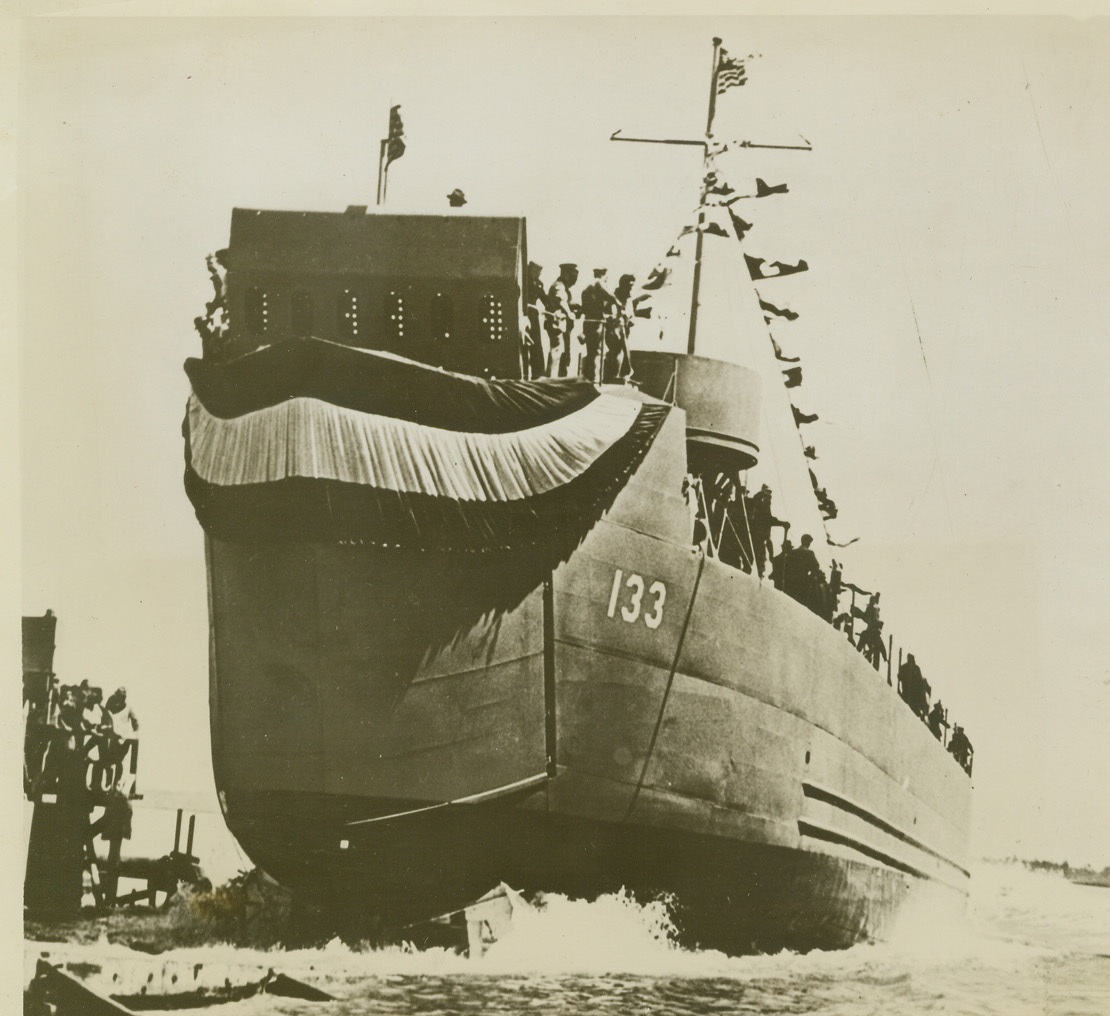
Newest Navy Craft, 5/8/1944. CHARLESTON, S.C. -- With bunting flying from its bow, one of the U.S. Navy's newest amphibious craft, the LSM (Landing Ship, Medium) is launched at Charleston, S.C. Smaller than the LST (Landing Ship, Tank) and larger than an LCT (Landing Craft, Tank) the LSM is an ocean-going vessel, with a bow that opens lowering a ramp down which men, machines and materials roll onto enemy beaches. Credit (Official Navy Photo from ACME);
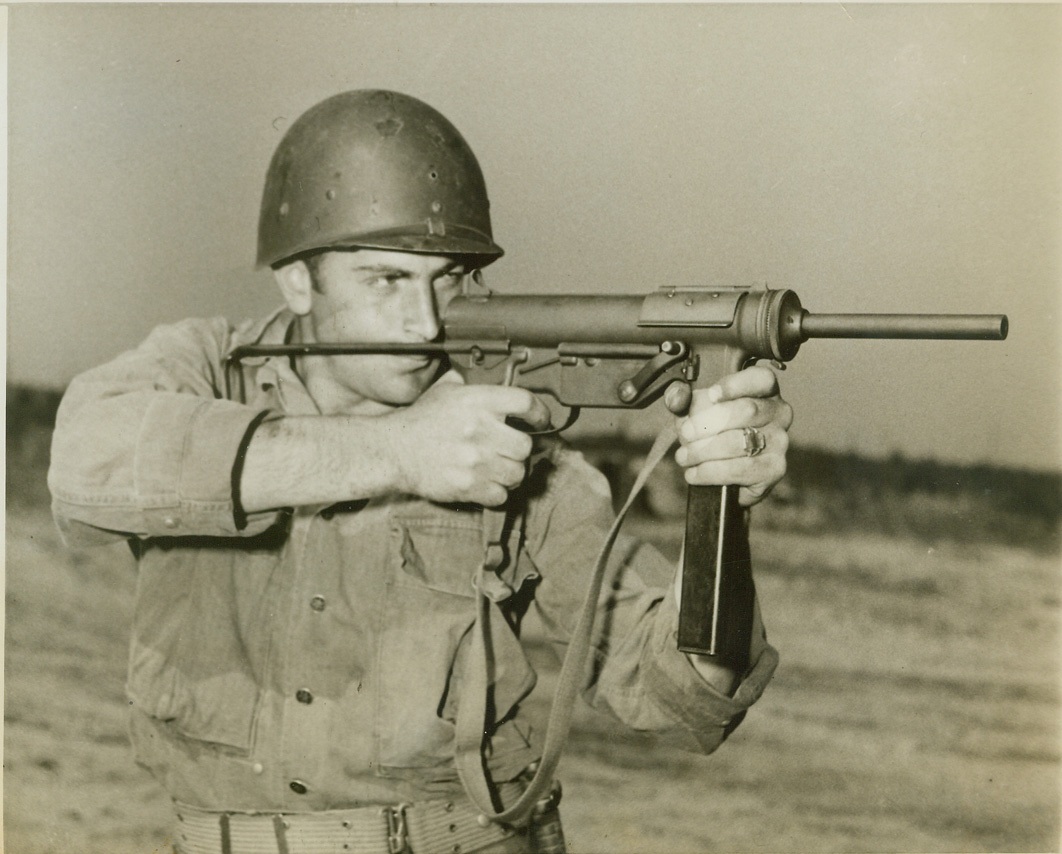
Lighter, Cheaper, and Just as Good, 5/6/1944. CAMP DAVIS, N.C. -- The deadly weapon being used by Pvt. Martin Schirald of Youngstown, Ohio, at Camp Davis is the Army's new .45 caliber sub machine gun -- the "M3". Five and one half pounds lighter than the widely used Thompson sub machine gun, the new weapon is much cheaper to manufacture and just as effective in battle. Credit: (ACME);
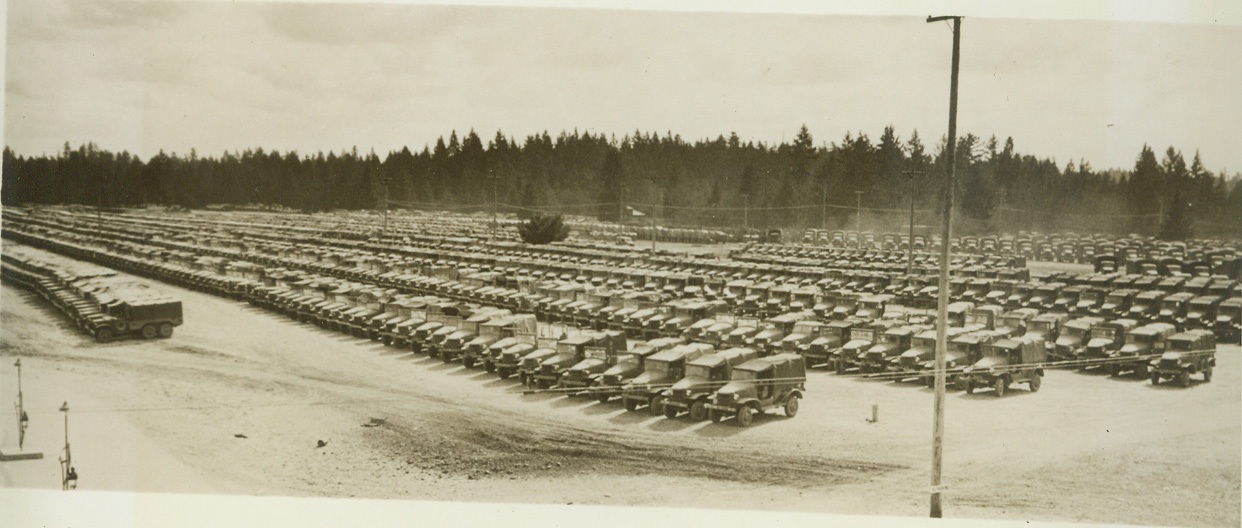
New “Life” for Damaged War Vehicles, 5/2/1944. FORT LEWIS, WASH. – The casualties in vehicles and other equipment in the highly mechanized war, is high. But, shattered steel and machinery is not left on the battlefield to rust and much of it is rebuilt and put back into action—very little is wasted. At the U.S. Army’s Mount Ranier Ordnance Depot, one of the many such Depots in various parts of the country, combat, and service and transport vehicles are repaired, reclaimed or salvaged. Here, the vehicles, collected in the far-flung battle areas of the world, roll in from ports of embarkation on flat cars. They are unloaded and classified and machines which can be repaired to a degree that will restore them to from 95 to 100 per cent as efficient as when new, will be rebuilt and returned overseas. Those which can be repaired but not to as high a degree of efficiency, will be shipped out to training centers, and those beyond repair will be dismantled for salvageable parts. What is left over will be sold for junk and will find its way back into the war effort through scrap. This series of photos, made at the Mount Ranier Ordnance Depot adjacent to Fort Lewis, shows how damaged vehicles are “given new life.” New York Bureau Thousands of reconditioned U.S. Army vehicles, from 95 to 100 per cent as sound as when they were new, are parked in a storage yard at the depot, waiting to be returned to action. Credit: (U.S. Signal Corps Photo from ACME);
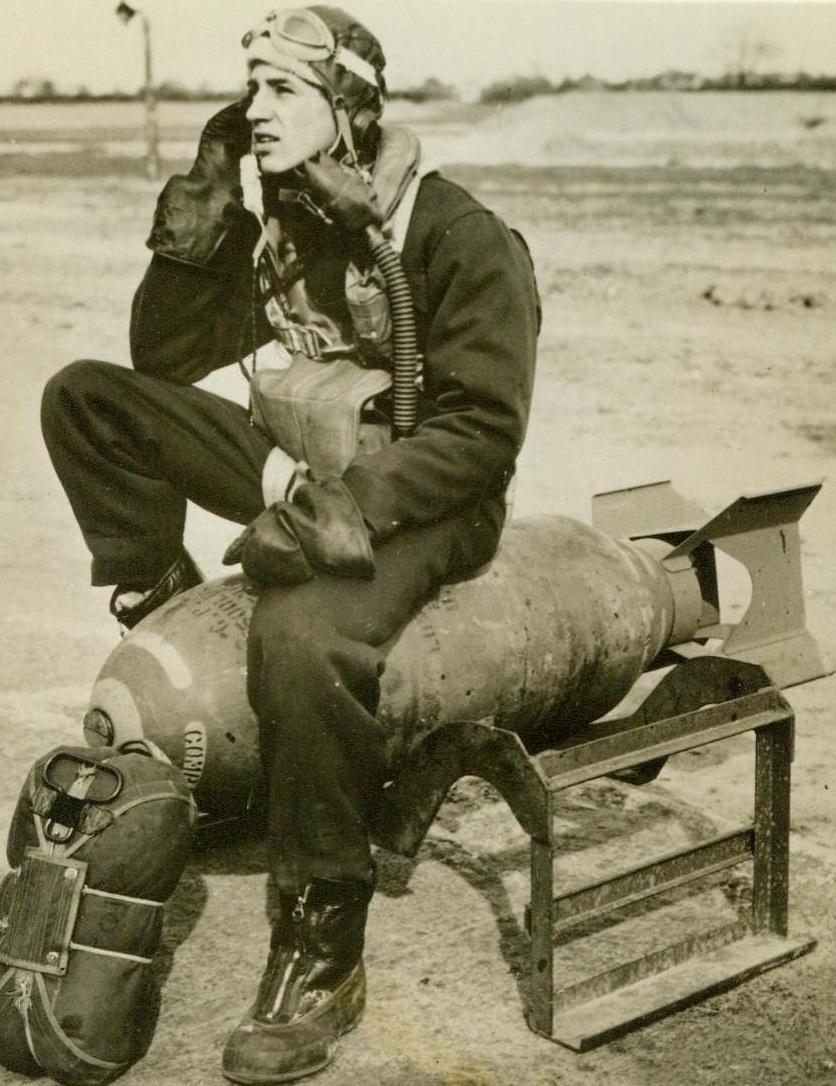
Veteran At Sixteen, 5/12/1944. England – Sgt. De Sales A. Glover, USAAF veteran of six missions over Europe and holder of the Air Medal, sits on a bomb and wonders what age has to do with being a fighting man. Glover, whose home is in Pittsburgh, Pa., is only sixteen years old. He has been grounded while the Army awaits official confirmation of his age before sending him home to civilian status. He enlisted in this man’s Army Oct. 14, 1942 when he was only 14 years old. The young Sgt. was a waist gunner in a Liberation Bomber. 5/12/44 (ACME);
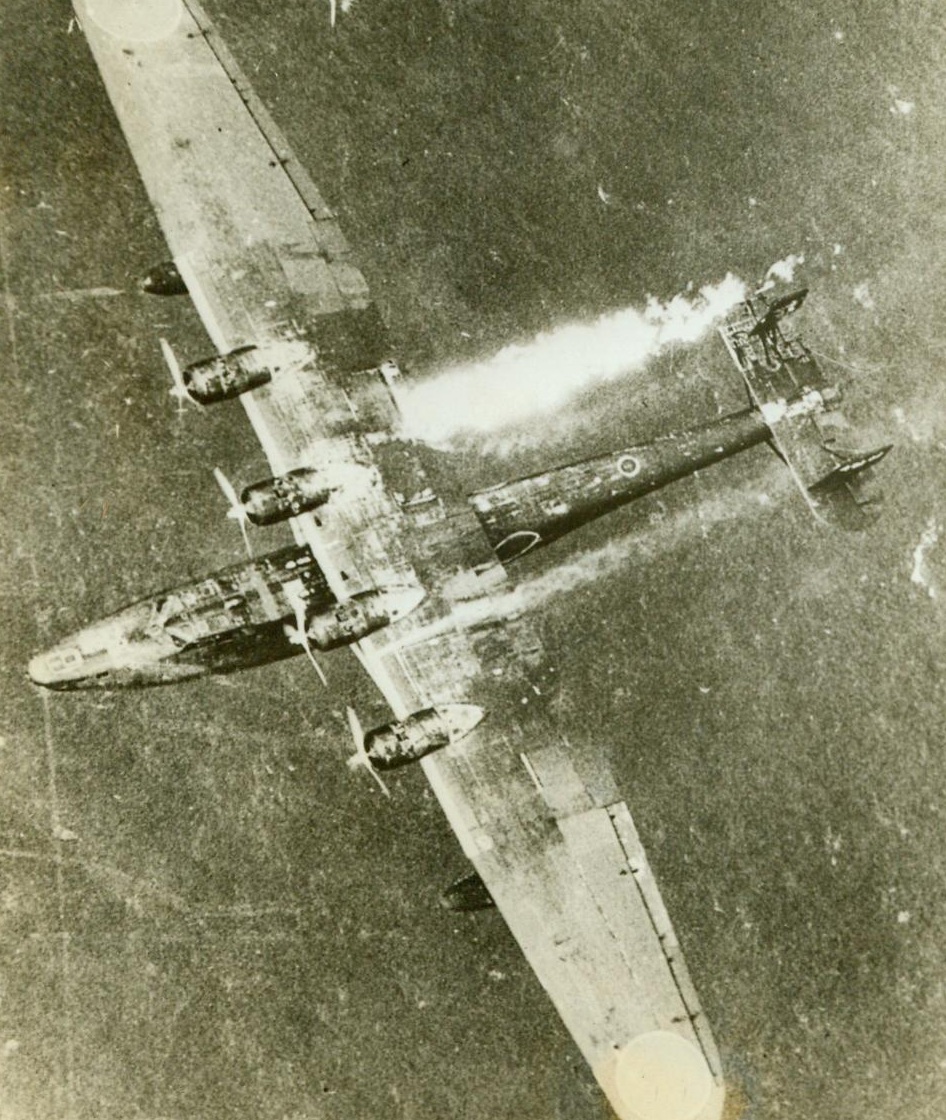
"Big Baby" Of Pacific Is Downed, 5/29/1944. Truk – With one fin and rudder shot away by US bullets and gas tank flaming, this Jap flying boat heads straightway for the water. The largest combat plane operating in the Pacific, it was finally tagged by a Navy PB4Y patrol bomber after a 19-minute hide-and-seek chase in the clouds near Truk. (Official US Navy Photo From ACME);
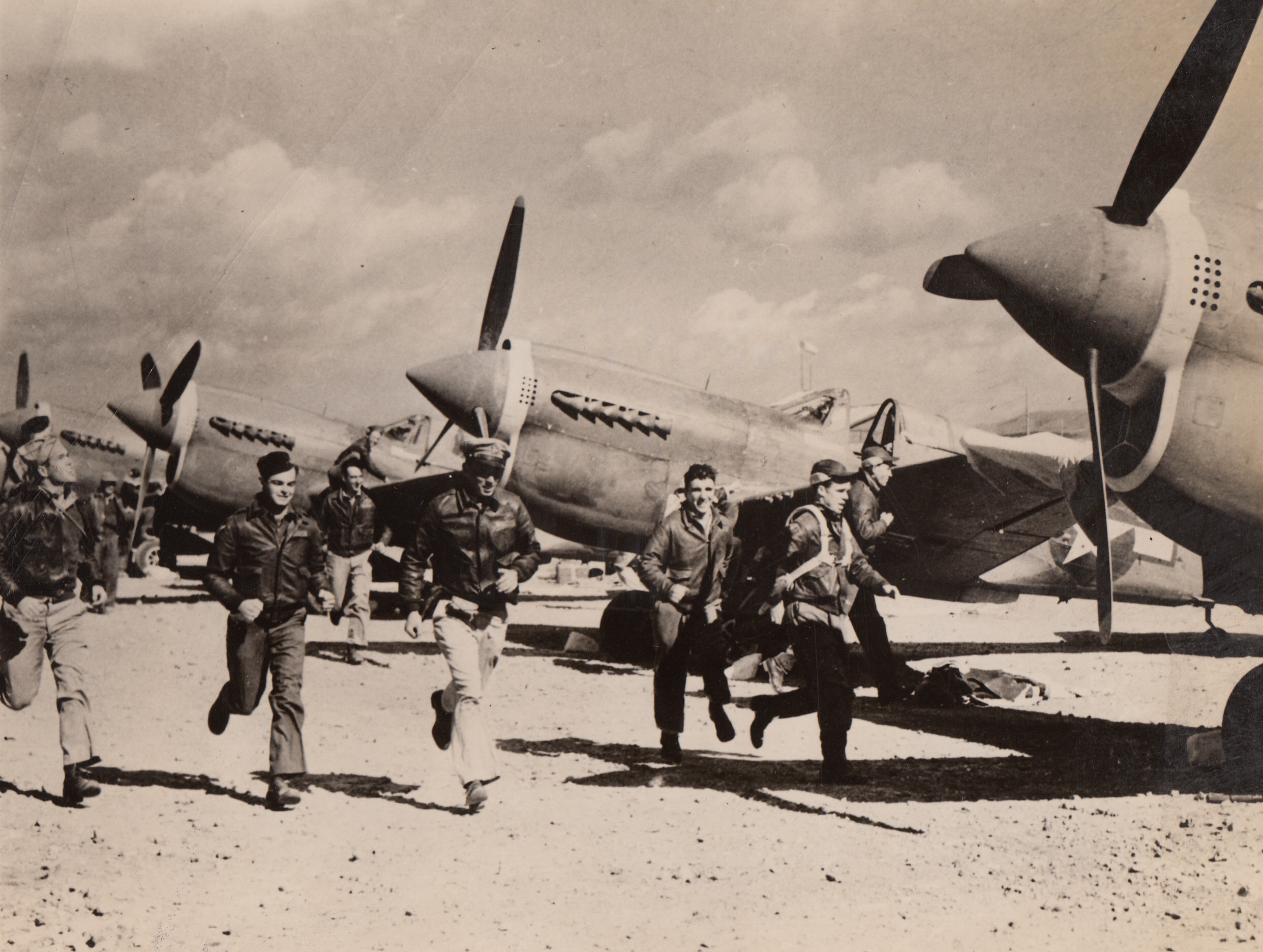
“Jing Bow! – Jing Bow!”, 5/9/1944. Somewhere in China – Here is a typical scene at a U.S. 14th Air Force base somewhere in China. As the cry “Jing Bow!” (Air raid in Chinese) echoes through the area. As soon as the signal is given “Flying Tiger” pilots hurry toward their planes, ready to go up after the enemy raiders. 5/9/44 Credit Line (Official U.S. Army Photo From ACME);
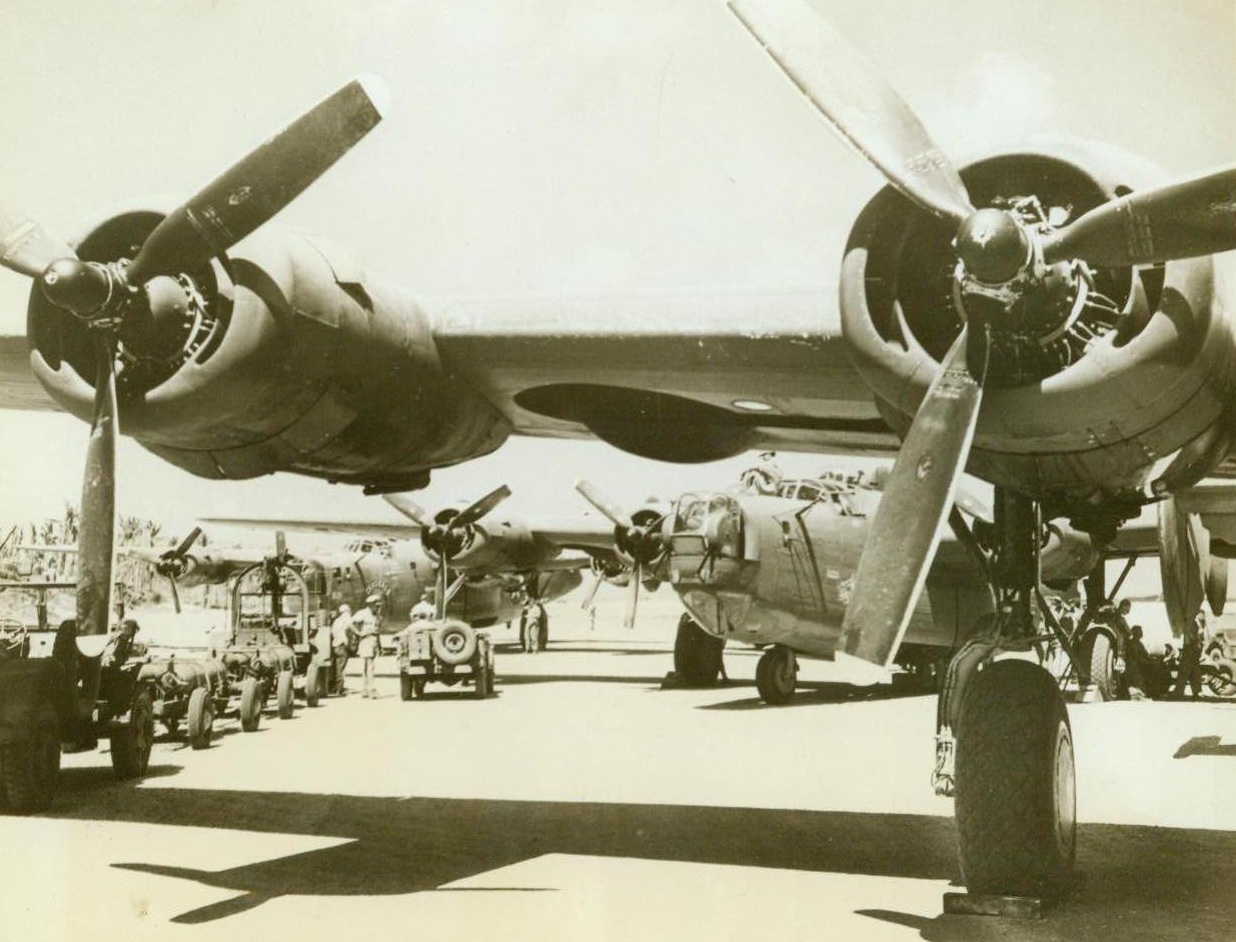
Set To Deliver Downpayment, 5/8/1944. AAF Base in the Marshalls – Bombs destined for delivery as part payment for the sneak bombings of Pearl Harbor and Manila, wait to be loaded in the bomb-bays of these planes by the 7th AAF ground crews at a Marshall Islands airstrip. Aircraft took part in the first joint Army-Navy heavy bomber strike at Guam, April 24. 5/8/44 (USAAF Photo From ACME);
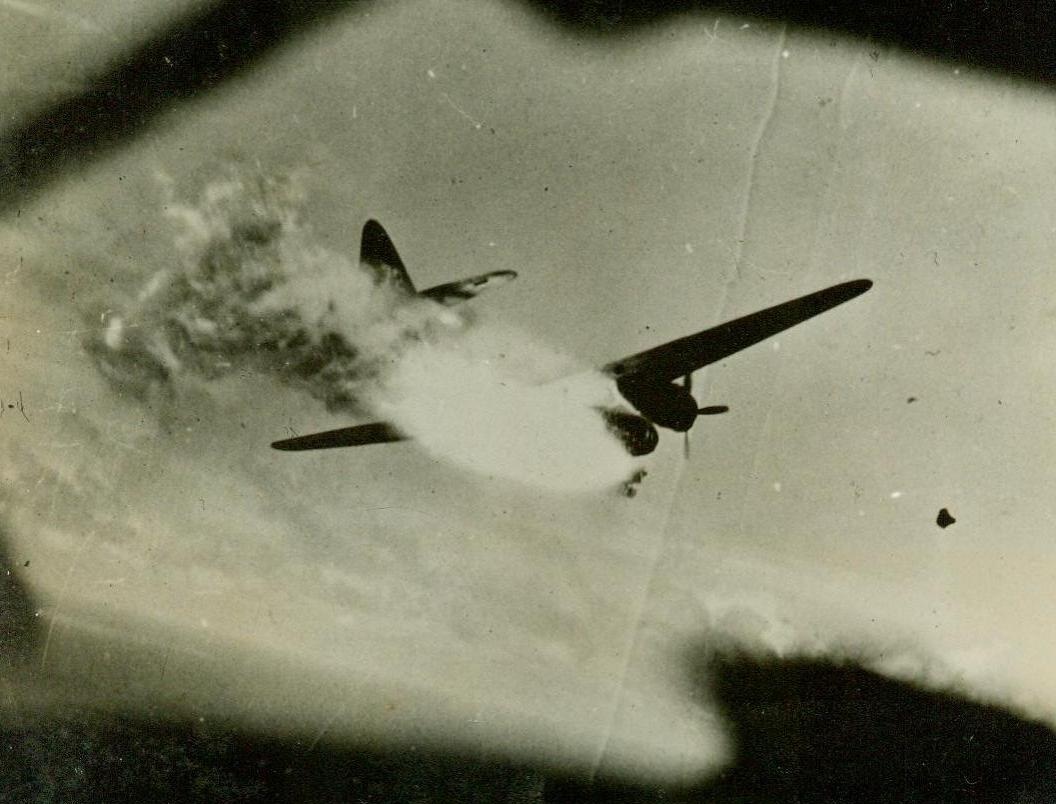
Death Dive For Jap Plane, 5/28/1944. Central Pacific – Flame streams backward from burning motors as this Jap bomber starts its death dive into the sea, the bomber was the victim of a surprise attack by a Nay Coronado Flying Boat of the Fleet Air Wing 5/28/44 (US Navy Photo From ACME);
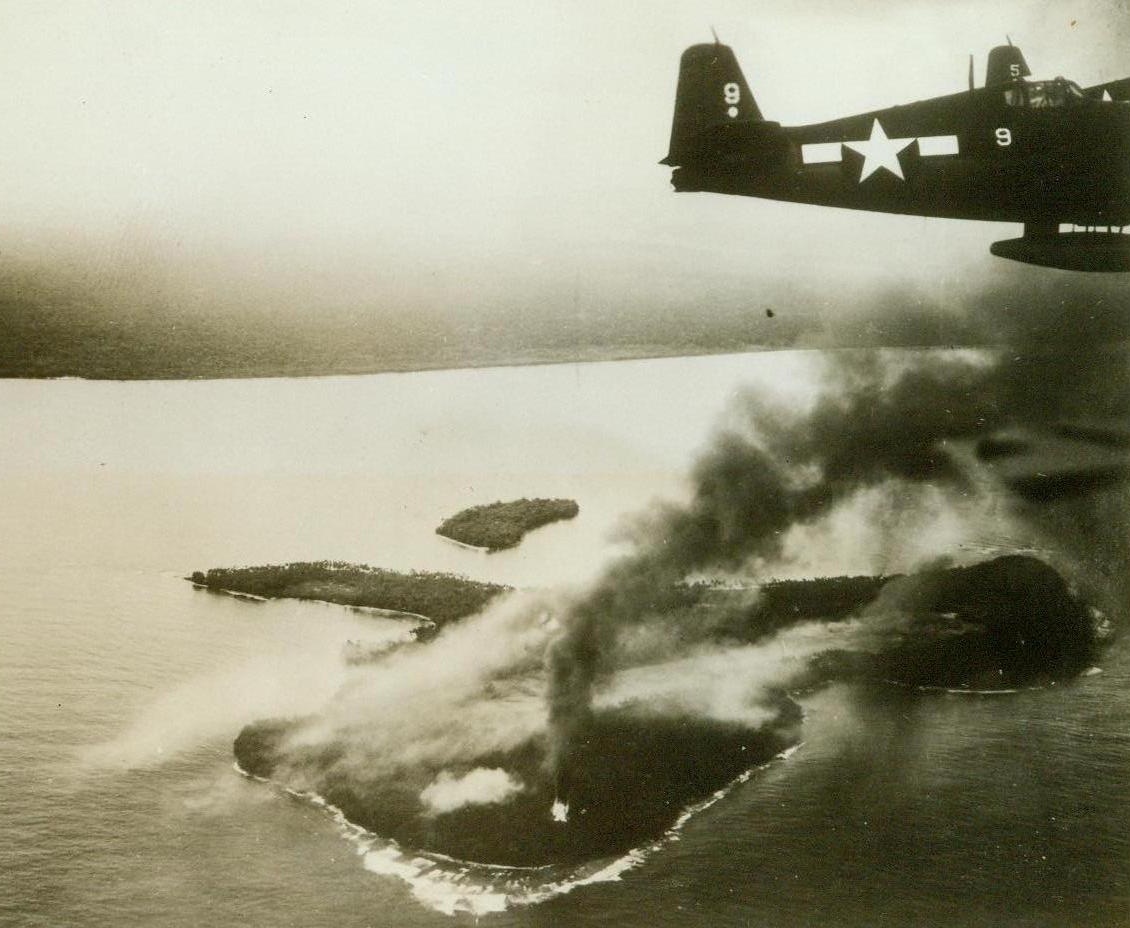
How To "Imobilize" Enemy Craft, 5/27/1944. New Guinea – Striking one day before the invasion of Hollandia, Navy Carrier-based planes from the giant task force which participated in the landings, blasted nearby Wakde Island. A Navy warplane is seen zooming far over burning Wakde after dropping its bombs. The Wakde Airfield was heavily hit; destroying many planes and “imobilizing” the field as a source of counterattack against the operation the following day. A month after the Hollandia victory, Wakde itself was taken. 5/27/44 (US Navy Photo From ACME);
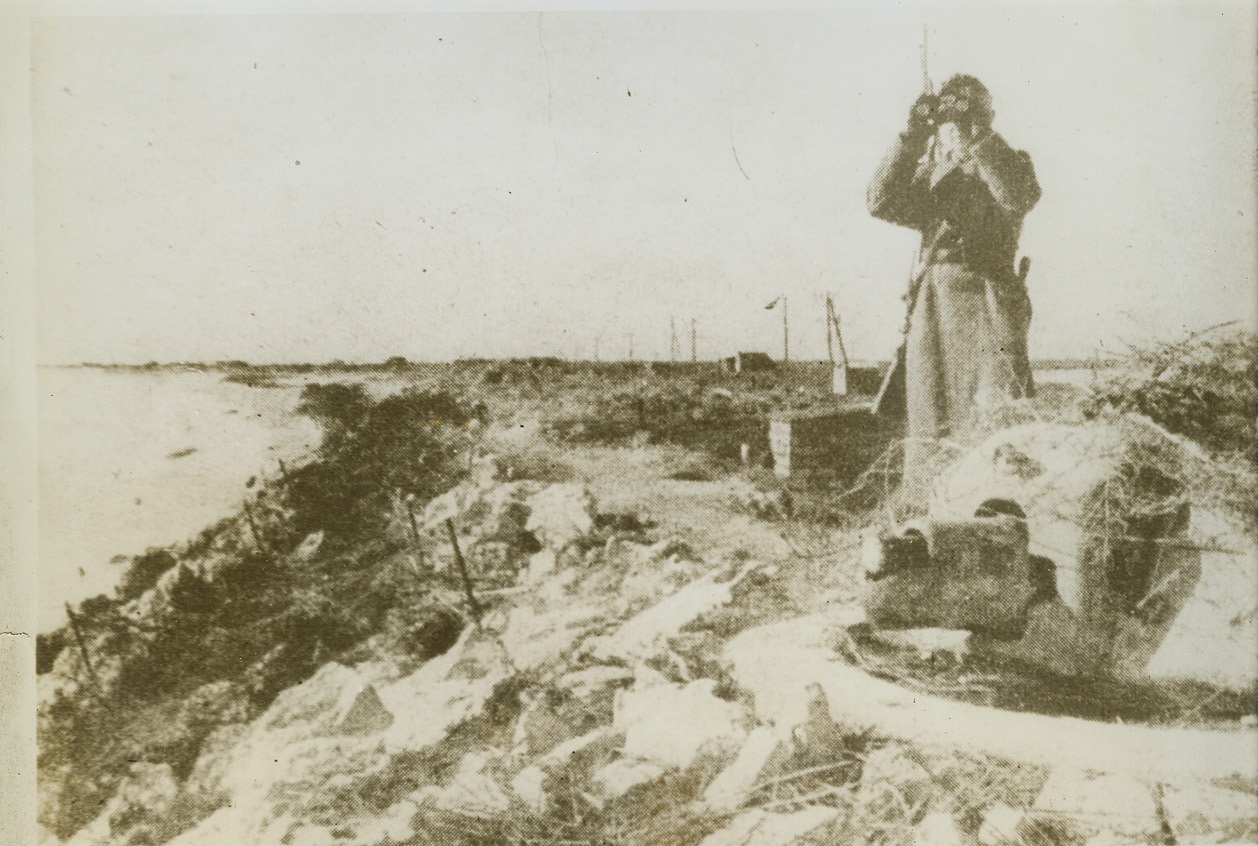
On the Look-Out for Invasion Forces, 5/22/1944. FRANCE-- A German sentry in a French fishing village looks out to sea--on the look-out for any sign of Allied invasion troops. Stretching along the coast are small concrete gun emplacements like the one in the foreground. Barbed wire entanglements line the beach. Nazis have been thorough in setting up invasion defenses to impede our forces when they make the seaborne assault against the Atlantic Wall. Credit: (ACME);
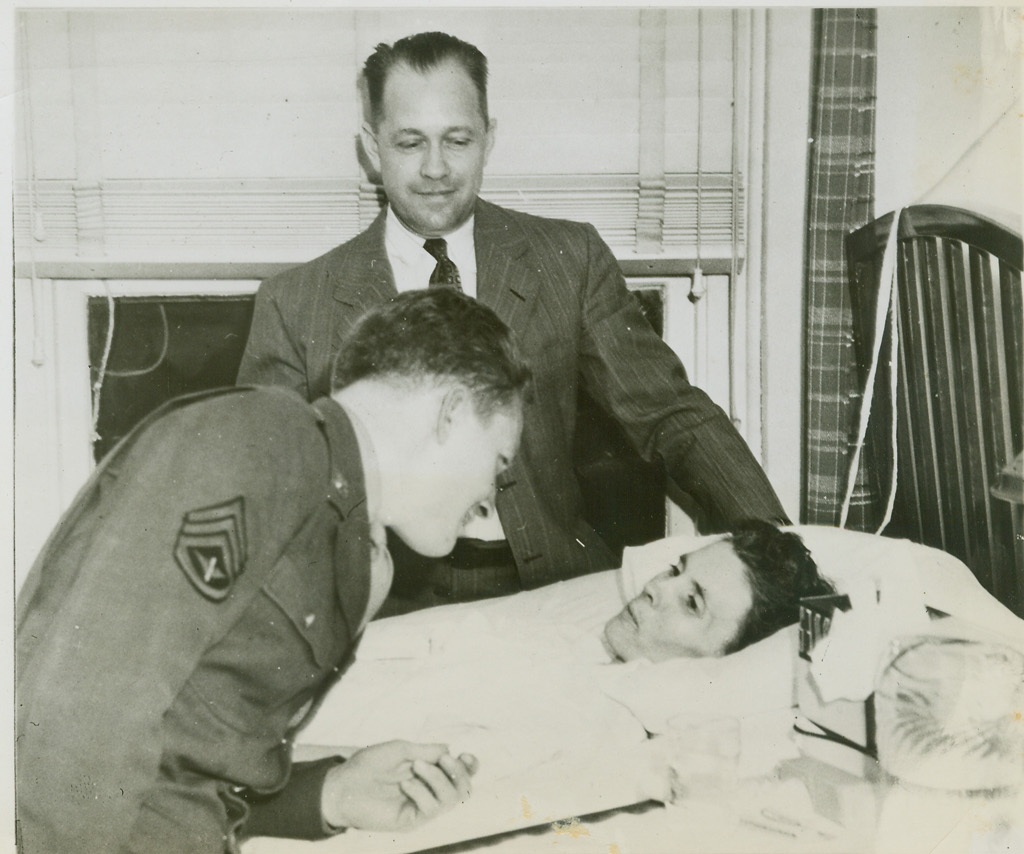
Gunner Flies Home to Mother, 5/6/1944. Poplar Bluff, MO.—Mrs. Mary Pauline Dodd, critically ill in a hospital in Poplar Bluff, MO., greets her son, Staff Sgt. Everett L. Dodd, a tail gunner in a flying fortress, who arrived at her bedside after a 20-hour Atlantic crossing from an American air base in England, where he was given permission to return to the United States because of his mother’s illness. Mr. Dodd, center, looks on as mother and son are reunited. Credit: ACME.;





 Trash & Recycling
Trash & Recycling
 Online Payments
Online Payments
 City Documents
City Documents
 Parks
Parks
 Traffic Court
Traffic Court
 CITY PARKS
CITY PARKS
 Outdoor Recreation
Outdoor Recreation
 Volunteer
Volunteer
 Home
Home TRANSLATE
TRANSLATE
